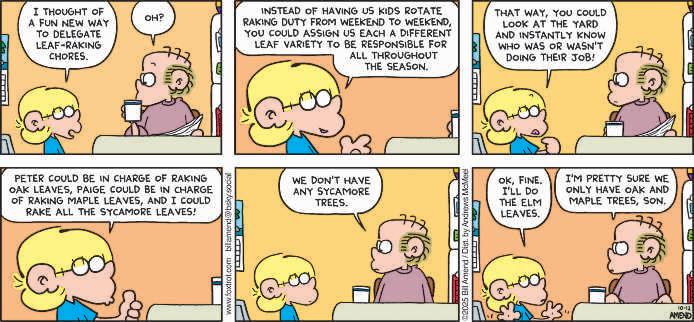










Ruling coulddramatically change‘tests’ used in redistricting

Concerns for theLSU offensedid not goaway afterSaturdaynight'sgame, but the Tigersadded to their wincolumn.The Tigers took down SouthCarolina20-10 in Tiger Stadium, improving to 5-1 despite turning the ball over three timesand failing to cash in on multiple opportunities created by their defense. LSU pressuredand harassed SouthCarolina quarterback and potential first-round pick LaNorris
Sellers from thefirst snap of the nightuntil thelast, held theGamecocks to 317 yardsand forced apair of turnovers ABOVE: LSU cornerback MansoorDelane, fromleft, celebrates with linebackers Harold Perkins Jr.and Whit Weeks after holding SouthCarolinaonthe lineinthe secondhalf


BY MARK BALLARD |Staff writer
WASHINGTON On Wednesday, the nation’sattention willbeonarguments before theU.S Supreme Court in acase that, on the surface, is aboutwhether Louisiana should have two majority-Black congressional districts, one or maybe none.
But manylegal observers say the court, with its 6-3conservative majority,could use Louisiana v. Callais to find the Voting Rights Act of 1965 unconstitutionalortodramatically changeits “tests” that judges havefor decades used to require states to draw congressional districts in which minority voters makeupa majority.Such achange could affect elections all over the country
Louisiana is arguing that Section 2ofthe Voting Rights Act and its tests forwhen majorityminority districts could be usedhas allowed states to draw mapswith race in mind, which contradicts the constitutional idea of equal treatment under the law
ä See CASE, page 9A
High temperatures are stretching into fall
BY SAM KARLIN |Staff writer
Louisiana summers are not only getting hotter.They’re also getting longer
HEAT
LOUISIANA’S QUIET DISASTER
Temperatures of 90 Fahrenheit are lasting as much as three weeks longer in cities across Louisiana, according to data from the nonprofit Climate Central. It’s the latest example of howLouisiana summers are growing increasingly hot anddangerous, posing deadly health risks and raising electric bills to unaffordable levels forAmerica’s poorest state.
Baton Rouge is seeing the most additional days with summer temperatures in the state, as
ä See HOTTER, page 8A

Biden receiving treatment for cancer
WASHINGTON Former President
Joe Biden is receiving radiation and hormone therapy as part of a new phase of treating the aggressive form of prostate cancer he was diagnosed with after leaving office, a spokesperson said Saturday “As part of a treatment plan for prostate cancer, President Biden is currently undergoing radiation therapy and hormone treatment,” said Biden aide Kelly Scully
The 82-year-old Democrat left office in January after he had dropped his bid for reelection six months earlier following a disastrous debate against Republican Donald Trump amid concerns about Biden’s age, health and mental fitness. Trump defeated Democrat Kamala Harris, who was Biden’s vice president.
In May, Biden’s postpresidential office announced that he had been diagnosed with prostate cancer and that it had spread to his bone. The discovery came after he reported urinary symptoms.
Prostate cancers are graded for aggressiveness using what is known as a Gleason score The scores range from 6 to 10, with 8, 9 and 10 prostate cancers behaving more aggressively Biden’s office said his score was 9, suggesting his cancer is among the most aggressive.
Last month, Biden had surgery to remove skin cancer lesions from his forehead.
Sudanese paramilitary attack kills at least 53
CAIRO A shelling and drone attack by the Sudanese paramilitary forces hit a shelter in a besieged city in the Darfur region, killing at least 53 people, a doctors’ group said Saturday
The onslaught was the latest in Sudan’s more than two-year war
The Sudan Doctors’ Network, a group of medical professionals tracking the war, says at least 14 children and 15 women were among the dead in the attack late Friday by the Rapid Support Forces on the city of el-Fasher
The attack also left 21 people wounded, including five children and seven women, the group said. Most of the wounded suffered serious injuries it said. The attack targeted al-Arqam Home, a shelter for displaced families in el-Fasher, the provincial capital of North Darfur, the group said. The shelter is located at the Omdurman Islamic University
“This massacre represents a continuation of the scorchedearth policy practiced by the Rapid Support Forces against civilians, in flagrant violation of all international norms and laws,” the medical group said.
The RSF did not immediately respond to a request for comment.
Floods, landslides kill at least 37 in Mexico
MEXICO CITY The death toll from landslides and floods set off by incessant rainfall in central and southeastern Mexico rose to 37 people on Saturday authorities said, a sharp increase as thousands of soldiers cleared blocked roads to rescue the missing nationwide.
Mexico’s National Coordination of Civil Protection reported that as of Saturday, the heavy rains had killed 22 people in the state of Hidalgo, north of Mexico City, and cut off power to 150 communities there. At least nine people were killed in the state of Puebla, east of Mexico City and over 16,000 homes damaged or destroyed.
There were also five deaths in the state of Veracruz, where the army and navy were helping rescue residents from 42 communities left isolated by landslides on roads and flooded streams.
Across the Gulf coast state’s 55 municipalities, another 16,000 homes were damaged. Earlier, in the central state of Querétaro, a child died being caught in a landslide.
Across the country, over 320,000 users were affected by power outages caused by the heavy rains, authorities said. Authorities have attributed the deadly downpours to Tropical Storm Priscilla, formerly a hurricane, and Tropical

Palestinians return to ruins; U.S. expects hostages freed Monday
BY ABDEL KAREEM HANA, SAM METZ, SARAH EL DEEB and SAM MEDNICK Associated Press
GAZA CITY, Gaza Strip The Gaza ceasefire held in its second day as tens of thousands of Palestinians returned to their neighborhoods Saturday and Israelis cheered Monday’s expected release of remaining hostages.
“Gaza is completely destroyed. I have no idea where we should live or where to go,” said Mahmoud al-Shandoghli in Gaza City as bulldozers clawed through the wreckage of two years of war A boy climbed debris to raise the Palestinian flag.
Israelis applauded President Donald Trump, and some booed Prime Minister Benjamin Netanyahu, as U.S. envoy Steve Witkoff and Trump’s son-in-law Jared Kushner addressed a weekly rally in Tel Aviv that many hoped would be the last.
To the hostages themselves, our brothers and sisters, you are coming home,” Witkoff told the crowd estimated in the hundreds of thousands. Kushner said they would celebrate on Monday, when Israel’s military has said the 48 hostages still in Gaza would be freed. The government believes around 20 remain alive Kushner also noted the “suffering” in Gaza.
Israelis hugged and took selfies. Many waved U.S. flags. “It’s a really happy time, but we know that there are going to be some incredibly difficult moments coming,” said one person in the crowd, Yaniv Peretz.
About 200 U.S. troops arrived in Israel to monitor the ceasefire with Hamas.
They will set up a center to facilitate the flow of humanitarian aid as well as logistical and security assistance.
“This great effort will be achieved with no U.S. boots on the ground in Gaza,” said Adm. Brad Cooper, head of the U.S military’s Central Command. Israel said Witkoff, Kushner and Cooper met with senior U.S. and Israeli military officials in Gaza on Saturday
A copy of the signed ceasefire says Hamas must share all information related to any bodies of hostages that are not released within the first 72 hours, and that Israel will provide information about the
Court: Guard
remains of deceased Palestinians from Gaza held in Israel.
The photo of the document was obtained by The Associated Press and its veracity was confirmed by two officials, including one whose country was a signatory Both requested anonymity due to the sensitivity of the talks The U.S. did not confirm whether it was authentic.
Hamas and Israel will share the information through a mechanism supported by mediators and the International Committee of the Red Cross It will also ensure all hostages are exhumed and released.
The agreement says mediators and the ICRC will facilitate the exchange of the hostages and prisoners without public ceremonies or media coverage.
Israel is to free some 250 Palestinians serving prison sentences, as well as around 1,700 people seized from Gaza the past two years and held without charge
The Israel Prison Service said prisoners have been transferred to deportation facilities at Ofer and Ktzi’ot prisons, “awaiting instructions from the political echelon.”
Aid groups urged Israel to reopen more crossings to allow aid into faminestricken Gaza. A U.N official, speaking on condition of anonymity to discuss details not yet public said Israel has approved expanded aid deliveries, starting Sunday
The World Food Program said it was ready to restore 145 food distribution points Before Israel sealed off Gaza in March, U.N. agencies provided food at 400 distribution points.
Though the timeline remains unclear, Palestinians will be able to access food at more locations than they could through the U.S.- and Israel-backed Gaza Humanitarian Foundation, which operated four locations after taking over distribution in May
Some 170,000 metric tons of food aid have been positioned in neighboring countries awaiting Israeli permission.
Questions remain about who will govern Gaza after Israeli troops gradually pull back and whether Hamas will disarm, as called for in the ceasefire agreement.
Netanyahu, who unilaterally ended the previous ceasefire in March, has suggested Israel could resume its offensive if Hamas fails to disarm. He has pledged that the next stage would bring Hamas’ disarmament
The scale of Gaza’s destruction will become clearer if the truce holds. And the death toll is expected to rise as more bodies are found.
troops sent to Ill. can stay, but
By The Associated Press
can’t
be deployed for now
CHICAGO National Guard troops sent to Illinois by President Donald Trump can stay in the state and under federal control, but can’t be deployed to protect federal property or go on patrol for now an appeals court ruled Saturday
The decision comes after federal Judge April Perry on Thursday ruled to temporarily block the National Guard deployment for at least two weeks, finding no substantial evidence that a “danger of rebellion” is brewing in Illinois during Trump’s immigration crackdown.
The appeals court on Saturday granted a pause in the case until it can hear further arguments. The on-again, off-again deployments stem from a political and legal battle over Trump’s push to send the Guard to several U.S. cities His administration claims crime is rampant in those cities, despite statistics not always supporting that.
If a president invokes the Insurrection Act, they can dispatch active duty military in states that fail to put down an insurrection or defy federal law However, Perry said she found no substantial evidence that a “danger of rebellion” is brewing in Illinois during Trump’s immi-

President tells Pentagon to use ‘all available funds’
BY DARLENE SUPERVILLE Associated Press
WASHINGTON President Donald Trump said Saturday that he has directed the Defense Department to use “all available funds” to ensure U.S. troops are paid Wednesday despite the government shutdown, a short-term fix that will not apply to the hundreds of thousands of federal workers who have been furloughed.
check on Wednesday after the government shut down on Oct. 1, the start of the federal budget cycle. The U.S. has about 1.3 million active-duty service members, and the prospect of troops going without pay has been a focal point when lawmakers on Capitol Hill have discussed the shutdown’s negative impact.
Trump did not say where he’s getting the money

Trump said in a social media post that he was acting because “our Brave Troops will miss the paychecks they are rightfully due on October 15th.”
The Republican president’s directive removes one of the pressure points that could have forced Congress into action, likely ensuring that the shutdown now in its 11th day and counting — extends into a third week and possibly beyond. But no similar action seems forthcoming for federal employees also working without pay while thousands are now being laid off during the lapse in government operations. The White House budget office started the layoffs on Friday Trump blamed Democrats and said he was exercising his authority as commander in chief to direct Defense Secretary Pete Hegseth “to use all available funds to get our Troops PAID on October 15th.” The Republican president added, “We have identified funds to do this, and Secretary Hegseth will use them to PAY OUR TROOPS.”
U.S service members were in danger of not receiving their next pay-
One pos si ble source would be the billions of dollars that were pumped into the Defense Department under Trump’s big tax and spending cut bill that he signed into law in July The Congressional Budget Office said such a move was possible. A spokesperson for the White House Office of Management and Budget said Pentagon research and development funds would be used to pay the salaries. Federal workers typically receive back pay after a shutdown ends, as now required by a law that Trump signed during his first term. He recently floated the idea of not making up the lost salaries. It was unclear if the president’s directive applies to the U.S. Coast Guard, which is a branch of the U.S. Armed Forces but is overseen by the Department of Homeland Security during peacetime. The nation’s third shutdown in 12 years has again raised anxiety levels among service members and their families as those in uniform are working without pay. While they would receive back pay once the impasse ends, many military families live paycheck to paycheck. During previous shutdowns, Congress passed legislation to ensure that troops kept earning their salaries, but discussion of taking a similar step by lawmakers appeared to have fizzled out.
gration crackdown.
She followed up Friday with an opinion that cites a mix of law and history, including the Federalist Papers, which were written in 1787-88 to support ratification of the U.S. Constitution.
“There has been no showing that the civil power has failed,” Perry said. “The agitators who have violated the law by attacking federal authorities have been arrested. The courts are open, and the marshals are ready to see that any sentences of imprisonment are carried out. Resort to the military to execute the laws is not called for.”



Star known for ‘Annie Hall,’ ‘The Godfather’ films and ‘Father of the Bride’
BY LINDSEY BAHR
AP film writer
Diane Keaton, the Oscarwinning star of “Annie Hall,” “The Godfather” films and “Father of the Bride,” whose quirky vibrant manner and depth made her one of the most singular actors of a generation, has died. She was 79.
People Magazine reported Saturday that she died in California with loved ones, citing a family spokesperson. No other details were immediately available, and representatives for Keaton did not immediately respond to inquiries from The Associated Press.
The unexpected news was met with shock around the world.
“She was hilarious, a complete original, and completely without guile, or any of the competitiveness one would have expected from such a star What you saw was who she was oh, la, lala!,” Bette Midler said in a post on Instagram. She and Keaton costarred in “The First Wives Club.” Keaton was the kind of actor who helped make films iconic and timeless, from her “La-dee-da la-dee-da” phrasing as Annie Hall, bedecked in that necktie, bowler hat, vest and khakis, to her heartbreaking turn as Kay Adams, the woman unfortunate enough to join the Corleone family Her star-making performances in the 1970s, many of which were in Woody Allen films, were not a flash in the pan either, and she would continue to charm new generations for decades thanks in part to a long-standing collaboration with filmmaker
Nancy Meyers She played a businessperson who unexpectedly inherits an infant in “Baby Boom,” the mother of the bride in the beloved remake of “Father of the Bride,” a newly single woman in “The First Wives Club,” and a divorced playwright who gets involved with Jack Nicholson’s music executive in “Something’s Gotta Give.”
Keaton won her first Oscar for “Annie Hall” and would go on to be nominated three more times, for “Reds,” “Marvin’s Room” and “Something’s Gotta Give.”
In her very Keaton way, upon accepting her Oscar in 1978 she laughed and said, “This is something.”
Keaton was born Diane Hall in January 1946 in Los Angeles, though her family was not part of the film industry she would find herself in. Her mother was a homemaker and photographer, and her father was in real estate and civil engineering.
Keaton was drawn to theater and singing while in school in Santa Ana, California, and she dropped out of college after a year to make a go of it in Manhattan. Actors’ Equity already had a Diane Hall in their ranks, and she took Keaton, her mother’s maiden name, as her own. She studied under Sanford Meisner in New York and has credited him with giving her the freedom to “chart the complex terrain of human behavior within the safety of his guidance. It made playing with fire fun.”
“More than anything, Sanford Meisner helped me learn to appreciate the darker side of behavior,” she wrote in her 2012 memoir, “Then Again.” “I always had a knack for sensing it but not yet the courage to delve into such dangerous, illuminating territory.”
She started on the stage as an understudy in the Broadway production for “Hair,” and in Allen’ s “Play It Again, Sam” in 1968, for which she
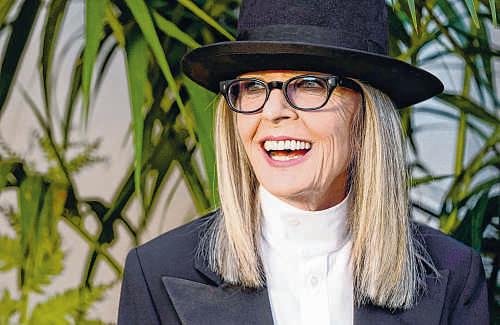
would receive a Tony nomination. And yet she remained deeply self-conscious about her appearance and battled bulimia in her 20s.
Keaton made her film debut in the 1970 romantic comedy “Lovers and Other Strangers,” but her big breakthrough would come a few years later when she was cast in Francis Ford Coppola’s “The Godfather,” which won best picture and become one of the most beloved films of all time And yet even she hesitated to return for the sequel, though after reading the script she decided otherwise. She summed up her role as Kay a “role she never related to” even though she savored memories of acting with Al Pacino. The 1970s were an incredibly fruitful time for Keaton thanks in part to her ongoing collaboration with Allen in both comedic and dramatic roles She appeared in “Sleeper,” “Love and Death,” “Interiors,” Manhattan,” “Manhattan Murder Mystery” and the film version of “Play it Again, Sam.” Allen and the late Marshall Brickman gave Keaton one
Devotedfamily man,visionary businessman,and communitybuilder
This articleisbrought to youbyKean’sFineDry Cleaning
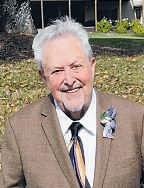
FrankHughKean ’s life wasdefinedby votion–tohisfamily, scommunity,and ecompany that bore sfamily’snamefor re than acentury.A ccessfulbusinessman, ankster, mentor,and iend, Kean’s legacy ntinuesfollowing his ssingonSept.12atthe eof87. Early Born in BatonRouge,Frank’s spirited and mischievousnaturerevealeditselfearly.At UniversityHighSchool,hebecameknownforhis pranks–onceliftingateacher’scarjustenough so itswheelsspunuselessly,and anothertime havinghisowncarmovedaroundtheschoollot fordaysbyfriendswhohadfoundhiskeys.These playfulanticsreflecteda spirit he neverlost. “Henever lost that grinningspirit,”said StephenRockenbaugh,whonowoperatesKean’s Fine DryCleaning. “I saw him alot in business settings,where he wasmoreserious,but you couldtellheknewhow to have fun. If yousaid somethingthatpiquedhisinterestorreminded himofsomething,youwouldgetaplayfulgrin.” BuildingaCareerand aLegacy AfterattendingtheMcCallieSchoolinChattanooga,Tenn.,FrankreturnedtoBatonRouge to attend LSU, whereheimmersedhimself in campuslifethroughthePershingRifles,Kappa Sigmafraternity, andstudent leadership.He served in theArmy, earned hislaw degree,and briefly practicedlaw beforedevotinghimself to thefamilydry cleaningbusiness. What beganin1900asa smallshopon GovernmentStreethadgrownintooneofBaton Rouge’smostrecognizedbusinesses. Under Frank’sleadership,the companyadapted and thrived, employinghundredsand generating tensofmillionsinannualrevenue.Heoftenjoked that as an attorney,hewentfrom“trying suits to cleaningthem,”but behindthe humorwas an incredible business acumen anda creative instinct for connecting with people “Hehad an incredible abilitytonavigate business dealings andfinance, buthewas also so creative andknewhow to reachpeopleand marketthe business,” Rockenbaughsaid. “It’s beyond rare nowtosee somebody whoisthat talented in so many differentareas.” ALeaderWho Valued People ForFrank,businesswasalwaysaboutpeople. Employees remember hischeerfulgreetings of “top of themorning to you” andhis insistence that qualityand care were at theheart of every service. He createdaworkplace wherepeople felt valued andproud of theirwork. Hismotto,highlightedbyhisdaughterEmily “Ifit’smeant to be,it’sup to me,” reflected his
commitment to responsibility andservice Customers, employees, andcolleaguesalike knew himassomeone wholistened, cared, and actedwithintegrity
Passingthe Torch
Ashenearedretirement,Frankthoughtabout lifebeyondbusiness.WithnomaleKeanrelative beforehim living past age70, he wanted to step awaywhilestillyoungenoughtoenjoyfamilyand communitylife.Throughaninvestmentgroup,he metGerard“Rock”Rockenbaugh,who became hissuccessorin2003. Thetransitionwas built on mentorship andtrust,asFrank guided Rock whileallowinghim andhis family to shapethe company’sfuture.

“Hewassoknowledgeableabouteveryaspect ofthebusiness–thetechnicalside,thecustomer serviceside, thebusinessside,”Rockenbaugh said.“It wasanhonor that he felt Icould carry onthevaluesofservice,convenience,andquality thathadmadeKean’saBatonRougeinstitution. ACommitmenttoCommunityandFamily Business wasonlypartofFrank’s story. In 1987,heco-foundedPat’sCoatsforKidswithhis sisterMabynandbrother-in-lawPatShingleton aprogramthathassinceprovidedthousandsof coatstolocal children.Healsodedicated time to mentoringyoung entrepreneursthrough the Baton RougeChamber of Commerce At home,Frank cherishedtimewithall his childrenandgrandchildren,whetheronhunting tripstoNorth Carolina,traveling,orgathering around Louisianameals.Hemaintainedhis curiositythroughouthis life,embracing new technology andfindingjoy in stayingengaged with theworldaroundhim
“Heabsolutelyhad afulland meaningful life afterheretired,”StephenRockenbaughreflected. “Heenjoyed everyday andmadesurepeople around him didthe same.”
ALifeWellLived FrankHughKeanIIIwillberememberednot onlyasaskilledbusinessman,butasamanwho livedwithjoy,curiosity,generosity, anddevotion.His legacy enduresinthe family he loved, thecommunity he supported, andthe values of serviceand qualitythatremainhis hallmark Frankwillbedeeplymissed.
of her most iconic roles in “Annie Hall,” the infectious woman from Chippewa Falls whom Allen’s Alvy Singer cannot get over The film is considered one of the great romantic comedies of all time, with Keaton’s eccentric, self-deprecating Annie at its heart
In The New York Times, critic Vincent Canby wrote, “As Annie Hall, Miss Keaton emerges as Woody Allen’s Liv Ullman His camera finds beauty and emotional resources that somehow escape the notice of other directors. Her Annie Hall is a marvelous nut.”
She acknowledged parallels between Annie Hall and real life, while also downplaying them.
“My last name is Hall Woody and I did share a significant romance, according to me, anyway,” she wrote. “I did want to be a singer I was insecure, and I did grope for words.”
Keaton and Allen were also in a romantic relationship, from about 1968, when she met him while auditioning for his play, until about 1974. Afterward they remained
collaborators and friends.
“He was so hip, with his thick glasses and cool suits,” Keaton wrote in her memoir
“But it was his manner that got me, his way of gesturing, his hands, his coughing and looking down in a self-deprecating way while he told jokes.”
She was also romantically linked to Pacino, who played her husband in “The Godfather,” and Warren Beatty who directed her and whom she co-starred with in “Reds.” She never married but did adopt two children when she was in her 50s: a daughter, Dexter, and a son, Duke.
“I figured the only way to realize my number-one dream of becoming an actual Broadway musical comedy star was to remain an adoring daughter Loving a man, a man, and becoming a wife, would have to be put aside,” she wrote in the memoir
“The names changed, from Dave to Woody, then Warren, and finally Al. Could I have made a lasting commitment to them? Hard to say Subconsciously I must have known it could never work, and because of this
they’d never get in the way of achieving my dreams.”
Not all of Keaton’s roles were home runs, like her foray into action in George Roy Hill’s John le Carré adaptation of “Little Drummer Girl.” But in 1987 she’d begin another long-standing collaboration with Nancy Meyers, which would result in four beloved films. Reviews for that first outing, “Baby Boom,” directed by Charles Shyer, might have been mixed at the time but Pauline Kael even described Keaton’s as a “glorious comedy performance that rides over many of the inanities.” Their next team-up would be in the remake of “Father of the Bride,” which Shyer directed and co-wrote with Meyers. She and Steve Martin played the flustered parents to the bride which would become a big hit and spawn a sequel. In 2003, Meyers would direct her in “Something’s Gotta Give,” a romantic comedy in which she begins a relationship with a playboy womanizer, played by Jack Nicholson, while also being pursued by a younger doctor, played by Keanu Reeves. Her character Erica Barry, with her beautiful Hamptons home and ivory outfits was a key inspiration for the recent coastal grandmother fashion trend. It earned her what would be her last Oscar nomination and, later, she’d call it her favorite film. She also directed occasionally with works including an episode of “Twin Peaks,” a Belinda Carlisle music video and the sister dramedy “Hanging Up,” which she co-wrote with Delia Ephron and starred in alongside Meg Ryan and Lisa Kudrow Keaton continued working steadily throughout the 2000s, with notable roles in “The Family Stone,” as a dying matriarch reluctant to give her ring to her son, in “Morning Glory,” as a morning news anchor, and the “Book Club” films.











BY ADRIAN SAINZ and TRAVIS LOLLER Associated Press
McEWEN, Tenn. — A blast in rural Tennessee that leveled an explosives plant and was felt for miles around killed 16 people and left no survivors, authorities said. The explosion left a smoldering wreck of twisted and charred metal and burnedout vehicles at the Accurate Energetic Systems plant, which supplies and researches explosives for the military
The cause of the blast is not known. Investigators are combing the incinerated property foot-by-foot searching for possible evidence
“There’s a gauntlet of emotions there,” Humphreys County Sheriff Chris Davis said during a news conference, pausing to clear his throat before he asked for prayers for the families of the victims in a shaky voice.
“We’ve recovered no survivors,” he added.
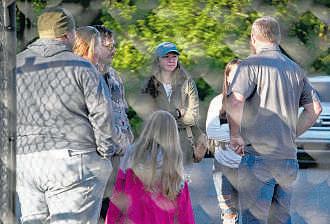
very emotional,” Farris said.
“They can hardly speak or anything, they are so emotional. I think as this goes on, it’s going to hit more people. The depth of this, the reality of it. That’s when they’re going to need people the most.”
Pamela Jane Brown was among those who came out to pray for friends missing in the blast and their families. She said an acquaintance of her family was driving by the plant when it exploded, and he was “hurt pretty good all cut up and bruised,” but is now recovering at home.
material that has been damaged and remains volatile.
An ambulance and a helicopter used for air evacuations were brought in, for the safety of first responders.
“It’s not like working an accident. It’s not like working a tornado. We’re dealing with explosions. And I would say at this time, we’re dealing with remains,” he said.
During a vigil at Hurricane Chapel in McEwen, senior pastor Tim Farris noted that many in attendance know each other the victims and their families.
“There’s a lot of people hurting. A lot of people who are crying a lot of tears,” he said. “We are sad that our community is going through this, but it’s a tremendous
opportunity for the church to minister to a lot of those people today.”
Farris said he spoke with some families of victims on Friday who were in shock and numb, and they did not show much emotion. That had changed by Saturday, he said.
“Speaking with some of the families today, they were
“I was heartbroken,” she said, after learning of the explosion on social media. Meeting others for prayer “was a coming together of the community – a good feeling.”
State officials brought in a “rapid DNA” team to help identify the remains of people recovered at the site.
Davis said about 300 responders are working in a “slow, methodical method” as they deal with explosive
Guy McCormick, a supervisory special agent with the U.S. Bureau of Alcohol, Tobacco, Firearms and Explosives, said explosive specialists and bomb technicians are trying to make the area safe for national ATF investigators. He said the nature of the scene can change because of the heat and pressure caused by the explosion.
Davis said it could be days, weeks or even months before foul play is ruled out.
The site is located in a heavily wooded area of middle Tennessee, between the economically vital Tennessee River to the west and the bustling metropolis of
Nashville to the east. Modest homes dot the wooded landscape, residences belonging to “good old country people,” as local man Terry Bagsby put it. Bagsby, 68, is retired but he helps out working the register at a gas station near the site. He said people in the close-knit community are “very, very sad.” He said he knows people who worked at the site.
“I don’t know how to explain it Just a lot of grief.”
Officials at an evening news conference said counselors would be available for grieving students on Monday Earlier Saturday afternoon at the church in McEwen, about 30 people gathered to pray for victims of the explosion and their families. Music played and mourners bowed their heads and closed their eyes. Some knelt at an altar, placing their hands on each others’ backs and shoulders. Some wept softly, among the whispered prayers.
BY KATIE ADKINS and JEFF MARTIN Associated Press
LELAND, Miss. — High school
homecoming celebrations in Mississippi ended in gunfire, with two separate shootings on opposite sides of the state Friday night that left at least eight people dead and many more injured, authorities said.
Six were killed in downtown Leland after a high school football homecoming game in the Mississippi Delta region on the state’s western edge, according to the county coroner On the east side of the state, a pregnant woman was among the dead, Mississippi Gov Tate Reeves said.
In Leland, four people were killed and two died later at a hospital, according to a statement from Washington County Coroner La’Quesha Watkins.
Some 20 people were injured in the gunfire after people gathered in the downtown area following the game, state Sen. Derrick Simmons said. Of those, four were in critical condition and were flown from a hospital in nearby Greenville to a larger medical center in the state capital, Jackson, Simmons told The Associated Press He was being updated on developments from law enforcement authorities in the Delta.
On Saturday, pieces of tattered, yellow crime scene tape were wrapped around a pole in the city’s tiny downtown area. The police tape could also be seen in front of a boarded-up storefront, tangled up at the base of a sign commemorating the late soul singer Tyrone Davis, who was born nearby No arrests have been announced, and Simmons said late Saturday morning that he had not heard any information about possible suspects.
Meanwhile, police in the small Mississippi town of Heidelberg in the eastern part of the state are investigating a shooting during that community’s homecoming weekend that left two people dead.
Both of them were killed on the school campus Friday night, Heidelberg Police Chief Cornell White said He declined to say whether the victims were students or provide other information about the crimes.
“Right now we’ve still got a subject at large, but I can’t give specifics,” White said Saturday morning.
An 18-year-old man was being sought for questioning in the Heidelberg shooting, the Jasper County Sheriff’s Office said in a statement. The sheriff asked that anyone with information contact the police chief or sheriff’s office.
The shooting in Heidelberg happened on the school campus where the Heidelberg Oilers were playing their homecoming football game Friday night. The town of about 640 residents is about 85 miles southeast of the state capital of Jackson.
It wasn’t clear exactly when the gunfire occurred or how close it was to the stadium.
White said he was at the scene Saturday investigating, and that more information might be released in coming days
The Mississippi Bureau of Investigation is helping local and federal law enforcement agencies in investigating, the governor said.
“Our state is praying for the victims and their families, as well as the entire Heidelberg and Leland communities,” Reeves said in a social media post. “Those responsible will be brought to justice.”
In Sharkey County, Mississippi also in the Missis-



BY JOEY CAPPELLETTI Associated Press
COLUMBUS, Ohio At a fivestar resort tucked in the mountains of Jackson Hole, Wyoming, the cryptocurrency industry was celebrating a historic start to the year on Capitol Hill. Its priorities were sailing through Congress with unusual speed and one senator did not hesitate to say why Sen. Tim Scott, chairman of the Senate Banking, Housing and Urban Affairs Committee, was asked during the August panel what had changed to clear the way for such progress.
“I got to tell you,” said Scott, R-S.C. “Thank you, to all of y’all, for getting rid of Sherrod Brown,” he said, referring to the Ohio Democrat who lost his Senate seat in 2024 to Republican Bernie Moreno.
Laughter and applause rippled through the room.
“Literally, the industry put Bernie Moreno in the Senate,” he added, according to a video from the Wyoming Blockchain Symposium.
In 2024, crypto interests poured more than $40 million into that race — more than four times their spending in any other Senate contest. Brown, who headed the committee when Democrats held the majority from 2021 to 2025, had long been one of Washington’s toughest critics of digital assets. That spending on behalf of Moreno, a businessman, sent a clear message: Challenge crypto, and the industry will come for you.
Brown, in a comeback bid, is seeking a fourth term next year, and Democrats are hopeful of their chances in an election without Republican President Donald Trump at the top of the ballot. But crypto has even more to spend this cycle and is enjoying a Congress that, without Brown, has turned sharply in its favor
“We saw what happened in the last administration,”
Brian Armstrong, CEO of Coinbase, the nation’s largest crypto exchange, told The Associated Press “We’re never gonna let that happen again.”
A pro-crypto Congress
In a striking reversal after the skepticism from Democratic President Joe Biden’s
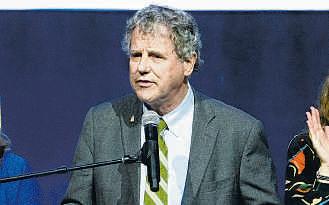
Then-U.S Sen. Sherrod Brown, D-Ohio, speaks on Nov. 5 in Columbus, Ohio. In 2024, crypto interests poured more than $40 million into the race to oust Brown, a critic of the digital assets. As Brown attempts a comeback next year, crypto interests have even more to spend to keep a crypto-friendly Congress.
administration, Congress this year has acted quickly to embrace the cryptocurrency industry after record spending in last year’s election.
Lawmakers have passed legislation establishing new regulations and consumer protections for stablecoins, a form of cryptocurrency typically tied to the U.S. dollar to limit volatility Now, an even bigger priority for the industry — a broader bill aimed at clarifying how digital assets are regulated is advancing through Congress.
From the White House, Trump has fully aligned himself with the industry, calling for the United States to become the “crypto capital of the world.” His family has also profited along the way, holding a significant stake in World Liberty Financial, a crypto venture that launched its own stablecoin earlier this year.
Supporters say the new policies will strengthen oversight and add consumer safeguards, helping to legitimize a sector long dogged by volatility and scandal — from the collapse of FTX to the conviction of its founder, Sam Bankman-Fried.
“Americans continue to lose money every day in crypto scams and frauds,” Brown said in a 2023 statement after Bankman-Fried’s conviction. “We need to crack down on abuses and can’t let the crypto industry write its own rulebook.”
As the Senate committee chairman, Brown was an outspoken critic of crypto and warned that digital assets opened the door to money laundering. He held several committee hearings over cryptocurrency issues, ranging from the negative impact on consumers to use
of the currencies to fund illicit activities.
During the 2024 campaign, Brown remained defiant despite tens of millions in industry spending against him. He lost to Moreno, who has ties to the crypto industry by just over 3.5 percentage points.
“Sherrod Brown’s race really indicated that it’s politically unpopular to be anticrypto,” Armstrong told the AP “There is no constituency for that.”
Crypto reshapes politics
In 2024, the crypto industry spent more than $130 million in congressional races, including $40 million in Ohio and $10 million each in Arizona and Michigan. The ads rarely mentioned cryptocurrency directly instead focusing on promoting favored candidates — most often successfully
“DC received a clear message that being anti-crypto is a good way to end your career,” Coinbase’s Armstrong wrote on social media after Brown’s loss.
Brown’s approach to crypto sounds different this time.
“Cryptocurrency is a part of America’s economy,” Brown said in a statement.
“My goal is to make sure that as more people use cryptocurrency, it expands opportunity and lifts up Ohioans and they are not put at risk.”
It is unclear whether Brown will be targeted again. Hundreds of millions are being stockpiled by pro-crypto political action committees, many of which maintain close ties with Trump and congressional conservatives.
Brown is set to face Republican Sen. Jon Husted, who was appointed to fill Vice President JD Vance’s seat.
By The Associated Press
ABIDJAN, Ivory Coast At least 237 people were arrested Saturday in Ivory Coast during a protest against what activists called the country’s authoritarian drift, according to a statement by the Minister of the Interior and Security on national television.
Protesters reported the use of tear gas and makeshift roadblocks near the planned start of the march.
Ivory Coast, a nation of 32 million and the largest economy in Francophone West Africa, is due to hold a presidential election in two weeks. Earlier this year, four main opposition figures, including former President Laurent Gbagbo and former Credit Suisse chief executive Tidjane Thiam, were barred from running by the electoral commission.
Ivory Coast’s President Alassane Ouattara, who has
been in power since 2010, announced his intention to run for a fourth term earlier this year, in a controversial move following a 2016 constitutional change that removed the presidential term limit.
The day before the protest, the prefect of Abidjan declared that all marches in the capital on Saturday were illegal because of the need to maintain order during the election period.

Husted has been a reliable crypto ally and backed the GENIUS Act, the legislation regulating stablecoins.
A majority of the crypto dollars spent against Brown last year came from Fairshake, a super PAC backed by Coinbase and others. The super PAC reported $141 million in cash on hand as of July, already surpassing what it spent during the 2024 cycle.
Coinbase and the PAC have emphasized that they back candidates from both parties, as long as they are pro-crypto. They have yet to say publicly whether they will spend similarly against Brown.
“Last year, voters sent a clear message that the Sherrod Brown and Elizabeth Warren agenda was deeply out of touch with Ohio values,” said Fairshake spokesperson Josh Vlasto. “We will continue to support pro-crypto candidates and oppose anti-crypto candidates — in Ohio and nationwide.” Warren is a Democratic senator from Massachusetts Fairshake is not alone.
Crypto entrepreneurs Tyler and Cameron Winklevoss have launched a $21 million group to back crypto-friendly Republicans. And another group, the Fellowship PAC, has pledged to spend $100 million in the next cycle.
A new crypto constituency Crypto advocates believe voter sentiment, not spending, is the source of their growing influence.
“There’s a large number of people who want to see crypto rules be passed in
America. And they’re users of crypto themselves,” Armstrong said.
A significant share of Americans see cryptocurrency investments as a financial hazard. Most U.S. adults, 55%, say they consider cryptocurrency a “very risky” investment, according to a Pew Research Center poll.
A relatively small group of U.S. adults say they currently own cryptocurrency but men under 50 are especially likely to invest in it. Roughly 1 in 4 men in that age group say they own cryptocurren-
cy according to Gallup polling from June. And they’re more open to buying in the future: only 44% say they’re “not interested in ever buying” digital assets, compared to far higher skepticism among older men or women of any age. That enthusiasm — combined with vast industry spending — has helped transform crypto from a niche technology into a potent political force, one now firmly embedded in the country’s financial and political mainstream.



When Dr.CarrieSteakleyfirstmet EpiscopalSchool of BatonRouge facultyin2016, it waswhile sheled a professional developmentsession.Dr. Steakley had spentmanyyearsatSt.Mary’sEpiscopalinMemphisin teachingandadministrativeroles,butherinteractions with theBaton Rougeteamstayedwithher long after thetraininghad ended.
“Iwasdeeplyimpressedbytheenvironmenthereand developedastrongadmirationfortheschool—particularlythefaculty,”shesaid.“Ifoundeveryonetobehighly professional andgenuinely committedtoadvancing educationthrough innovativeand forward-thinking pedagogies.Itwas trulyinspiring andleftalasting impression on me.”
WhenanopportunityarosetoleadEpiscopalSchool of BatonRouge,Dr. Steakley applied. Now, sheisin hersixth year as theheadofschooland said that the qualitiesthatfirstdrew hertoBaton Rougeremainat theheart of theschool’ssuccess.
“While theacademicrigor at Episcopalisoften highlighted—andrightlyso—whatweconsistentlyhear from parentsisthattheychooseour school because of thestrongsense of community,”she said.“It’s the wayour teachersinvestineachstudent,providing personalized supportand ensuring everychild feels seen,valued, andcared for. They challengestudents to reach theirfull potential, butjustasimportantly they walk alongsidethemevery step of theway,doing whatever it takestohelpthemsucceed.”
At Episcopal, over 60 percentofthe teachers hold advanced degrees.Those credentialsare impressive, butDr. Steakley notedthatthe school lookstohire andretainfaculty whoare notonlywell-trained, but readytoembracethephilosophyofcareandindividual attentionfor students that is akey to success.
“Wewantpeoplewho teachstudentshow to think, nottellthemwhattothink,”she said.“We want classroomenvironmentsthatfostercriticalthinking andencourage students to create,design, andengage respectfully. An Episcopalschoolisa welcomingand inclusiveenvironment for people of allbackgrounds We look for people whoembrace that philosophy.”
Students at Episcopalare notgiven letter grades on report cardsuntil sixthgrade.Instead,younger studentsfocusonmasteringconceptsandproject-based learninginthe QUESTCenter. On anygiven day, the LowerSchoolatEpiscopal canbefilled with children learningcodingbasics, reading andwriting,orexaminingflowersinthe Pre-Kgarden.
“It’sveryimportanttousthatstudentsdon’tinternalizenegativebeliefsabout theirabilities—particularly in subjects like math andwriting—based on early academicexperiencesorindividualgrades,”Dr.Steakley said.“Ourgoalistocultivateagenuineloveoflearning whilemaintainingopen,constructivecommunication withparentsabouteachchild’sstrengthsandareasfor growth.Everythingwedoisintentionalandgrounded in adeepunderstanding of what is developmentally appropriatefor children at each stage. ThatfocusturnstocollegepreparationintheUpper School.Episcopal offersnearlytwo dozenAdvanced Placementcourses,but Dr.Steakleyand herteam arecareful aboutbalance andlimit thenumberofAP

coursesthatastudent cantakeeachsemester. In fact they work with each studentone-on-onetodevelop an educationalplanthatisrigorousyet well-rounded “Wetakeintoaccount each child’sfuturegoals interests, talentsand wheretheyneedtostretch themselves,” shesaid. “Wedon’twanttosee students taking afullloadofAPcourses andnothingelse. We want them to be able to do Mock TrialorModel UN or choir. We want them to be in theatreperformances or playtennis–whateverconnectsthemtootherstudents andcreateswell-roundedexperiences that willmake them good citizens of theworld.”
StudentscanalsoparticipateinsomeofEpiscopal’s signatureofferings, such as theTHESISProgram with aheavy research componentand theESTAAR science-focusedprogramthatpairsEpiscopalstudents withLSUresearchers.Bothprogramsculminatewitha TedX-stylepresentationtotheupperschool.Inaddition, students participateinservice learningprojectsthat benefit thewider BatonRouge community.
Dr.Steakleyemphasized that acorepriorityat Episcopalismakingits high-quality educational offerings accessible to families of allbackgrounds.In the2025–26 school year,the school awardedover$3 millionintuition assistance
“Our goal is to enroll students from across thecity andfromawiderange of backgrounds,”Dr. Steakley said.“Forfamilieswho aredeeplycommitted to Episcopaland forstudentswho alignwithour mission, we areoften able to make enrollment financially possible throughtuition assistance andscholarships.”
Rather than largeopenhouses, EpiscopalSchool of BatonRougepersonalizestheapplicationprocesswith one-on-onetours.Familiesare paired with student ambassadorswhocananswerquestionsaboutcampus life,and administratorsdiscuss each child’sspecific interestsand goals.
“We’ve foundthatapersonalizedapproachtothe tour andadmissionsprocess is farmoremeaningful forfamilies,”Dr. Steakley said.“We take time to understand what drawsthemtoEpiscopal andfocus on theaspects of theschoolthatmattermosttothem. Eachtouristailoredtotheprospectivestudent’sgrade leveland thefamily’sspecific interests. It’s important to usethattimeintentionally andensureevery visitis as impactfuland informative as possible.”
LearnmoreaboutEpiscopalSchoolofBatonRougeor schedule atourtoday at www.episcopalbr.org









FRIDAY FR OCTOBER 17th SATURDAY OCTOBER 18th


thecity’ssummers have gotten 21 days longer between 1970 and 2024, according to the report. Lafayette is seeing 17 extra summer days andNew Orleans is experiencing 11 more days of hot temperatures each year
“Research showsand tells us if heat-trapping pollution keepsrising, summer temperatures will keep stretching laterand later,” said Shel Winkley, aweather and climate engagementspecialistatClimate Central and aformer meteorologist for the College Station,Texas, CBS affiliate. “And that heat matters …for kidsand outdoor workers when it comes to health risks. We have increased energy demand for air conditioning.”
The rising temperatures are largely the resultof decades of greenhouse gas emissions, which Louisiana’soil and petrochemical sectors have contributed an outsized share,according to climate scientists and reports by the state. Louisiana makes up about 1.4% of the U.S. population but around 4.1% of its greenhousegas emissions, according to the most recent state inventory.
That report, from2021, foundoverallgreenhouse gas emissions were slightly declining in Louisiana. The state developed aclimate action plan to reduce emissions under Gov.John Bel Edwards, thoughthe fate of the effort to reduce emissions has become less clear amid President Donald Trump’srollback of climate action and Gov.Jeff Landry’selection to the state’s highest office.
And, paradoxically,recent cuts in air pollution are likely making it even hotter
Particles that pollutersreleased, known as aerosols, masked some of theeffects of climate changefor years by reflecting sunlight. In other words, the releaseof these aerosols into the atmo-



sphere hascooled the planet over the past century,and recent regulations tamping down on them have reversed that trend In Louisiana, the consequences of risingheatare stark Residents, often elderly, aredying in theirhomes
without adequate air conditioning, outside mowing the lawn or underoverpasses in acity whereubiquitous concrete creates aheat island effect that makes New Orleans sweltering. Areport by theEnvironmental Protection Agency found heat waves are getting longer in

“Research shows and tells us if heat-trapping pollution keepsrising, summertemperatures will keep stretching laterand later.And that heat matters …for kids and outdoorworkers when it comestohealth risks. We have increased energy demand forair conditioning.”
SHELWINKLEy,a weatherand climateengagementspecialist at ClimateCentraland aformer meteorologist for theCollege Station,Texas, CBSaffiliate
tal health,climate and sustainabilityprogramatLSU Health SciencesCenter New Orleans. “It’s likely to continue to get worse.”
Emissionsbring heat
The primary cause of hotterand longersummers is greenhouse gas emissions, which have raised global temperatures by morethan 1degree Celsius, according to the most recent report of the Intergovernmental Panel on Climate Change. These gases trap heat in the atmosphere, warming the globe and causing more intense hurricanes,rainfall, drought, wildfires and more.
“Decreasing carbon emissions is paramount to minimizing the severity of global climate change, and its impact on Louisiana residents,” according to ahazard mitigation plan released last year by the Governor’s OfficeofHomelandSecurity and Emergency Preparedness.
over the past century,they produced acurious, unintendedconsequence
Pollutionparadox
Many of theparticles polluters released, aerosols, lingeredinthe atmosphere and reflected sunlightaway from the earth. In somecases, the aerosols absorbed it. This hada paradoxical effect on global temperatures. While the greenhouse gases caused temperatures to rise, the aerosols that came from them also masked that effect, agrowing body of researchsuggests. That made temperatures cooler,aphenomenonknown as “global dimming.”
Greeta Persad, assistant professor at the Department of Earth andPlanetary Sciences at the University of Texas, saidthe particles counteracted about onethird to one-half of allwarming fromgreenhouse gases during the industrial era. Without those pollutants, temperatures couldhave increased by up to 50%, Persad said.
In recent decades, improved air quality laws have led to adramatic decline in some of the pollutants that mask the effects of climate change.
It’s “very well established that we’re seeing warming because of this,” Persad said. Health experts widely agree that regulating air qualityand removing pollutants is wellworth the tradeoff, noting that improving air quality strengthens healthoutcomes andsaves lives for people near emitters.
New Orleans than any city in the nation. And the city’s tree canopyisstruggling to cool it down amid hurricanes, damaging construction and ambivalence among residents.
“Things aregetting worse,” said Barry Keim, director of the environmen-
The plannotes that temperature increases depend, in large part, on how much humans continue to release emissions. Under ahigh emissions scenario,“historically unprecedented warming” is projected for Louisiana by the end of the century,according to the report.
As refineries, coal plants anda host of otherindustrial processes caused an explosion of greenhouse gases
“Weknow these aerosol pollutants are detrimental to public health,” Persad said. “They cause millions of deaths each year.” Still, the dynamic is raising theprospect that climatechange will accelerate in the coming decades, even as governments around the worldworktoreduceemissions.
“That’sa huge lurking beast in how rapidly these climaterisks are goingto accelerate goingforward,” Persad said.




“Race-based redistricting under Section 2isprincipally unconstitutionalbecause it inherentlyrests on aracial stereotype:that all voters of aparticular racemust —by virtue of their membership in their racial class —think alike, share the same interests, and prefer the same political candidates,” the state attorney general argued in an Oct. 3brief.
But the law’s defenders say the state is trying to gut one of the most important civilrights laws protecting minority voters from disenfranchisement.
“The upshot of Louisiana’s burn-it-all-down approach is thatitwants relief from any congressional or judicial scrutiny of its voting laws,” wrote the Robinson litigants, acoalition of Black voters in their Oct. 3brief. “Let there be no mistake: That was the situation that prevailed in Louisiana and nationwide for the 100 years before the VRA.”
The Callais litigants, a group of “nonminority” voters who are challengingthe state’s current map, wrote in their Sept. 17 brief: “Thirty years of such whipsawing arguments and decisions have aggrieved voters, states, and the judicial system. As Louisiana’sexperience shows, the process is the punishment.”
The brief continued: “Racial gerrymandering, even for remedial purposes, may balkanize us into competing racial factions.”
Voting Rights Act’shistory
The Supreme Court’sruling on the case will be the culmination of along and winding legal battle.
Congress in 1868 passed the 14th Amendment that guarantees “due process” and “equal protection”of the laws for all U.S. citizens.
Ratified in 1870, the 15th Amendment guaranteesa citizen’sright to vote regardless of “race, color,or previous condition of servitude.” Without legal oversight, White majorities for acentury passed laws that kept African Americans from registering to vote.
The Voting Rights Act of 1965 was passed to forbid practices such as literacy tests and poll taxes that kept Black people off voter rolls. But some states continued to draw voting maps that isolatedBlack communities into districts with large White majorities, an effort to dilute their voting power
The 1982 renewal of the VRA added“tests” that judges could use to determine whether states hada history of discriminatory voting maps. For example: Didthe state haveahistory of racially polarized voting? Did the state have cohesive minority communities that could reasonably fit in asingle district?
In states where those tests identified discrimination, thelaw allowed minority voters to file lawsuits asking judges to order the creation of districts where minorities
made up themajorityofvoters. The last census count found that about athirdof the Louisiana’s residents are Black. Louisiana isa state where aWhite majority has never elected aBlack candidate.
Complicatedcourt battles
AGOP-majority Louisiana LegislatureinMarch 2022 approved election maps that ensuredfive White Republicans and one Black Democrat went to Congress, as had the mapapproved a decade ago.
“It was aclear dilution of Black voting power to crack Black voters from around thestate andpack them into onedistrict,” said Sarah Brannon, deputy director of the ACLU’sVoting Rights Project
Agroup ofBlackvoters led by Press Robinson, aformer East Baton RougeParish School Board member filed alegal challenge arguingthe Legislature should create asecond district with enough minority voters to give Blacksanopportunity to electone of theirown to Congress.
The Robinson litigants include an activist with Together Louisiana, aPublic Service Commission member,the Power Coalition for Equity and Justice and theNAACP Louisiana State Conference.
Seven federal district and appellate judges agreed and gave the Legislaturea deadlinetodraw new maps —or thecourts would.
Under that threat,Gov Jeff Landry and the Legislature wentback to the drawingboard.
Wanting to keep enough White voters in thedistricts that elected House Speaker Mike Johnson, R-Benton, andRep.Julia Letlow,RBaton Rouge and amember of theHouseAppropriations Committee, legislators approved the current map in January 2024, which redrew then-Rep. Garret Graves’ 6th Congressional District into one that linked
Black communities from Baton Rouge to Lafayette to Shreveport. Twoweekslater,adozen voters who described themselves as “nonblack”fileda lawsuit in Monroearguing that the Legislature’smap is racially gerrymandered. PhillipCallais,ofBrusly, is the first name on alist of a dozenlitigants whoinclude aconservative publisher and columnist, aTrump delegateatthe Republican Party National Convention, an AscensionParishGOP leader anda former congressional candidate from Lafayette Twoofthe three judges on afederal panelinApril 2024 ruled thatthe two Black majority districts amounted to aracial gerrymander that
“violatesthe Equal Protection Clause” in the 14th Amendment.The third judgesaid themapshad allowable political motivation. The Supreme Court stayedproceedings in May 2024, thereby allowing the election of Rep. Cleo Fields, D-Baton Rouge, in the disputed second majorityBlack district.
In March, the nine justices heardargumentsonhow to balanceSection2 of the Voting Rights Actand the Equal Protection clause, which forbids government taking actions based on race. Originally, Louisiana was defending the map.
But, ratherthan ruling on that question, the high court took the rare stepofaskingfor newarguments on
whetherthe Voting Rights Actviolated the14thor15th Amendments of the Constitution. Louisiana Attorney General Liz Murrill said thatopenedthe door for Louisiana to makeits originalargument, which is that judges shouldn’tbeable to order states to redistrict in thefirst place.
Thearguments
Submitted briefs indicate the points the three parties want to make before the court this week.
The Robinson litigants argue that Section 2’s“genius is its flexibility” in thatit does notdemandracial targets but allowsstates “leeway” to createcompliant districts using traditional redistricting criteria.
Louisiana counters that theVRA unjustly broadened theideaofintentional discrimination to include vote dilution, which it argues is not based on afinding that prejudicialtreatment occurred,suchasbeing denied the right to vote. And the Callais litigants contendthatthe “tests” associated with Section 2entrench race-based thinking “long after intentionaldiscrimination withers away.” After Wednesday’shearing, it is notclear how long the SupremeCourt will take to issue aruling. But it should render adecision before June.
Email MarkBallardat mballard@theadvocate. com
























BY MATT SEDENSKY
AP national writer
NEW YORK For months, bubbling trade tensions between China and the U.S. seemed to calm to a simmer, with words like “thaw” and “truce” swapped in for warnings of economic “war.” Now, hostilities appear to be returning to full boil.
A series of tit-for-tat moves this week by the two superpowers has thrust trade hostilities back in the global spotlight, roiling markets and raising alarms of what might come next.
“Let’s poke the bear again,” economist Aleksandar Tomic, an associate dean at Boston College, said of the renewed sparring. “Let’s stir the hornet’s nest.”
Tensions roil markets
Tensions between China and the U.S. transcend any presidency or political party But Donald Trump’s return to the White House has brought new levels of rancor A volley of tariffs were introduced, raised and reduced in the year’s first half, igniting retaliation from Chinese leader Xi Jinping. But more recently, several months of relative calm had prevailed.
That truce showed signs of fizzling this week, though, with China announcing strict new limits on exports of rare earth minerals crucial to high-tech products. Trump, in turn, threatened an additional 100% tax on Chinese imports by Nov. 1 and export controls on American software. Both sides also hit one another’s ships with new
port fees.
Whether public moves by Washington and Beijing are meant to advance private talks between the two sides is unknown. But they roiled stock markets, with Friday bringing the S&P 500 its worst day since April and a new dose of uncertainty about what is next
“Either this is it, the socalled tariff truce is over and both sides are going to rapidly escalate or these are negotiation talks ahead of the talks between Xi and Trump,” said Marc Chandler chief market strategist at Bannockburn Capital Markets in Cincinnati, Ohio. Jostling for advantage
With so much unknown about any possible behindthe-scenes negotiations between the two nations, it is hard to gauge who might have the upper hand
But China may sense an opening, with Trump challenged by a government shutdown and the impacts of the ongoing trade war
American soybean farmers who long relied on Chinese sales are now being passed over for exports from Brazil, Argentina and elsewhere. U.S investors have happily watched markets driven upward by excitement over artificial intelligence, but China dominates the world in the rare earth minerals that are key to technological hardware.
American consumers who have come to expect an endless supply of cheap goods that roll off Chinese conveyor belts are bracing for
higher prices.
“It becomes an issue of who can replace supply chains faster And, at least right now, I think China is winning that one,” Tomic said. “I don’t know what the cycle of a soybean is, but I bet you can grow a soybean faster than you can build a toy factory.”
Empty threats or strategy
Trump has suggested a deal is still possible.
He has frequently made threats that turn out to be empty, used as part of a negotiating strategy For now
Trump has not formally canceled a meeting planned with Xi later this month on the sidelines of the AsiaPacific Economic Cooperation summit, though he said nothing was certain.
“I don’t know that we’re going to have it,” he said in the Oval Office on Friday “I’m going to be there regardless, so I would assume we might have it.”
Chandler said it might appear to be a sudden, dramatic blowup between the U.S. and China, but it is really just more of the same from two parties embroiled in an acrimonious, long-running feud.
“It’s sort of like a divorce: The wife and the husband are accusing one another of things that, from the outside, look more complicated,” Chandler said. “This kind of story doesn’t have a good guy We want to have a good guy and a villain. But these are just two large countries both seeking national advantage.”
BY MICHAEL R. SISAK and LARRY NEUMEISTER
Associated Press
NEW YORK Lawyers for Lu-
igi Mangione asked a New York federal judge Saturday to dismiss some criminal charges, including the only count for which he could face the death penalty, from a federal indictment brought against him in the December assassination of UnitedHealthcare’s chief executive.
In papers filed in Manhattan federal court, the lawyers said prosecutors should also be prevented from using at trial his statements to law enforcement officers and his backpack where a gun and ammunition were found.
They said Mangione was not read his rights before he was questioned by law enforcement officers, who arrested him after Brian Thompson was fatally shot as he arrived at a Manhattan hotel for an investor conference. They added that officers did not obtain a warrant before searching Mangione’s backpack. Mangione, 27, has pleaded not guilty to state and federal charges in the fatal shooting of Brian Thompson on Dec. 4 as he arrived at a Manhat-
tan hotel for his company’s annual investor conference.
The killing set off a multistate search after the suspected shooter slipped away from the scene and rode a bike to Central Park, before taking a taxi to a bus depot that offers service to several nearby states.
Five days later, a tip from a McDonald’s about 233 miles away in Altoona, Pennsylvania, led police to arrest Mangione. He has been held without bail since then.
In their submission, defense lawyers provided a minute-by-minute description of how police officers apprehended a cooperative Mangione, including a photograph from a police bodyworn camera of the suspect initially sitting alone at a table with a white mask covering nearly all of his face.
They said Mangione was first approached by two “fully armed” police officers when one of them “told Mr Mangione that someone had called the police because they thought he was suspicious” after he’d been there about 40 minutes
When the officers asked to see his identification, Mangione turned over a New Jersey driver’s license with someone else’s name accord-
ing to the filing.
As Mangione prepared to eat his food, the officers asked him to stand up with his hands atop his head so they could frisk him, the lawyers wrote.
Soon afterward, one of the officers went outside to summon more officers, telling a colleague he was “100%” convinced that Mangione was the suspect they were looking for, the lawyers said. Within minutes, nearly a half dozen additional officer arrived.
Last month, lawyers for Mangione asked that his federal charges be dismissed and the death penalty be taken off the table as a result of public comments by U.S. Attorney General Pam Bondi. In April, Bondi directed prosecutors in New York to seek the death penalty, calling the killing of Thompson a “premeditated, coldblooded assassination that shocked America.”
Murder cases are usually tried in state courts, but prosecutors have also charged Mangione under a federal law on murders committed with firearms as part of other “crimes of violence.” It’s the only charge for which Mangione could face the death penalty, since it’s not used in New York state.









2025 SouthernUniversityFootballGameDay
Traffic,Parking,and StadiumRules
Southern UniversityAthletics urgesfanstoarriveearly before kick-off forall Southern Universityhomefootball gamesatA.W
MumfordStadium to help with theeaseoftrafficflow
Driverswho parkinthe paid/reserve lots must have their hang tags visible on thevehiclesorriskbeing towedand/orticketed Contraflowmay begin earlierthandesignated if need be Additional reserveparking will be available at theMLK Catholic Center.Call theSUticketoffice at 225-771-3171 fordetails Also,the areasonIsabelHersonDrive,nearthe Southern UniversityLaboratory School, will be available forparking Generalparking,which is $20, will only be madeavailable on Saturday
Designated limited mobility parking areaswillbeavailable on a first come basis. Shuttles will be available in certain areastobring fans to thestadium.Pleasesee theLimited Mobility/ReservedLot manifestfor acomplete list of lotsand availableshuttle locations SouthernUniversityFootballGameTrafficPlan ALLHANGTAGSMUSTBEHUNG FROM REARVIEWMIRROR BEFORE ENTERING CAMPUS ANDREMAINVISIBLYDISPLAYED AT ALLTIMES.VEHICLESPARKEDINRESERVEDPARKING LOTS WITHOUT DISPLAYING RESERVED HANG TAGS FORTHATLOT WILL BE TOWED. Thereare alimited number of game dayRV andtailgatingspotsavailable,call225-771-3171for more info Individualvehicleswillnot be allowedtoparkinRVlots. Allmotor homesand fifth wheelersmustparkinthe areasdesignated for motor homes. If youwillbetowingavehicle,you must purchasea parking permit forthe vehicleand park it in thedesignatedlot that correspondstothe permit
Traffic on Campus during Normal Traffic Flow
Traffic onto campus by wayof HardingBoulevard
•The rightlaneofHardingBoulevard is forDecal Reserved ParkingLotsA,B,C,D,G(Mini Dome andStadium Parking), Tailgate Dome
•The left laneofHarding Boulevardisfor DecalReservedParking Lots, E, V, Uand MLK
•Gameday busparking should enteronHardingand proceed to E.C. HarrisonDrive.Parking is $250 forall non-SU Alumni/ Booster Clubs.
•General parking should enter throughHardingBoulevard,Mills Avenue or Swan Avenue.Parking is $20per car.
Anydecal entering theMiniDomemay be allowedtopassthrough theMiniDomeparking area if it is notLot Dtoget their designated decalparking area. Traffic ontocampusbyway of Swan Avenue
will be able to gettoLotsA,B,C,D,F,G,H,and I.
Traffic ontocampusbyway of B. A. LittleDr. from MillsAvenuewill be able to gettoLotsA,B,C,D,F,G,H,and I.
Alltrafficthatisnot goingtoareservedlot must park in ageneral
parking area
Traffic onto HardingBoulevard
•BradfordHall ParkingLot
•Human ResourcesParking Lot
•Parking lot on theScott’s Bluff
•ArchivesParking Lot
•Museum ParkingLot
•Law Center ParkingLot
•MayberryDiningHall ParkingLot
•Army/NavyROTC ParkingLot
Traffic onto Swan Avenue
•The grassareaeastofIsabelHersonStreet
•The grassareanorth of theSouthernLaboratory practice field
•The grassareanorth of IsabelHersonStreet.
•TrafficontoB.A.LittleDr. from MillsAvenue.
•The grassareatothe southofMills Ave. andwestofB.A.Little Drive.
•The grassareatothe southofMills Ave. andeastofB.A.Little Drive.
HardingBlvd. Contra-flow Traffic
•All lanes will be inbound.
•Contra-flow traffic will startthree hoursprior to kickofforearlier if necessary.For example, fora6p.m.kickoff contra-flow traffic will startat3p.m
LimitedMobility
Bradford Hall andSUPoliceStation Parking
A.W. Mumford
StadiumPolicies
•NoAlcoholic beveragesfromoutside will be allowedinside A.W. MumfordStadium
•SouthernUniversityreservesthe righttorefusethe sale of alcoholic beverages
•FansCannotStore Prohibited Bags &ItemsNearStadium




Entrances
•All Unattended ItemswillbeRemoved &Discarded
•Full details listed at www.gojagsports.com
•All Persons&ItemsEntering areSubjecttoInspection
•NoRe-entry-AnyoneLeaving theStadium Must Havea New, Unused Ticket to Re-enter
•Tickets MayNot be Re-sold on Stadium Premises &Surrounding Grounds(IncludingParking Lots)
•All PersonsMustHaveaTicketfor Admission- Regardless of Age(children under 2years old do notneedaticket)
•Smoking &Use of AllTobacco Products(Cigarettes, E-Cigarettes,Cigars, Pipes,Smokeless Tobacco,Snuff,Chewing Tobacco,Vapes,etc.) is Prohibited Everywhere on Southern University’sCampus
•Inall sports, access to thecompetition area shallbelimited to participating student-athletes,coaches,officials, support personneland properlycredentialed individualsatall times.
•AtNotimebefore, during or after acontestshallspectators be permittedtoenter thefieldorplaying surface.
•Accesstothe field is reserved forparticipating student-athletes, coaches,officials, supportpersonneland properlycredentialed individuals.



BY MARIE FAZIO Staff writer
Long considered Louisiana’s
“best-kept secret,” the state’s community college system has seen apost-pandemic enrollment resurgence.
Nearly athird of Louisiana’s 280,000 college students last year attended one of the state’s 12 community and technical colleges, working toward atwo-year degree or atechnical certification that costs less and offers a faster path to ajob than afouryearcollege degree. And the number of community college graduateshas nearly tripled over thelast decade, reachingabout 38,000 graduates last year
The students, who tend tobe older and more racially diverse than traditional college students, can train for jobs in everything from welding to nursing and hospitality.They can also take adult education classes in English language, reading and other core subjects.
Often an overlooked facet of thehigher education ecosystem, community and technical colleges have gained traction in recent years as state education officials have emphasized career paths to high-demand, high-wage professions. Last year, enrollment across the Louisiana Community and Technical College System, which oversees the state’scommunity and technical colleges, exceeded pre-pandemic numbers. Chandler LeBoeuf, the system’s vice president of education, has worked at several of its campuses, including South Louisiana Community College, Delgado
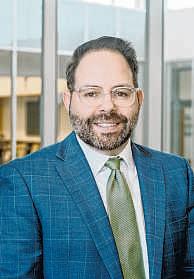
VICE PRESIDENT OF EDUCATION FORTHE LOUISIANA COMMUNITy ANDTECHNICAL COLLEGE SySTEM
development.We’re focused purely on getting individuals intogood jobs faster through thequalityoftraining that we do. Ourinstitutionsare aligned to theneeds of their local region and more so aligned to the overall state’sworkforce plan.
How has enrollment changed over the past five years?
Just like the nation we saw a dip in enrollment during thepandemic. Twoofour colleges had an additional dip because of hurricanes in 2020 and 2021. Buttoday we areup3.8% in enrollment from fall 2018 to fall 2025 and up 3.5% in credit hours.
Community College andFletcher Technical Community College.
He said the system’sschools have adapted to make it easier for students to access training in high-demand industries, like health care and IT
“Webelieve our mission is a part of the biggerpictureinLouisiana’s economy andworkforce development and we identify ourselves as akey player,” he said. “Westill have thebest kept secret and it shouldn’tbe.”
TheTimes-Picayune and the Advocatespoke with LeBoeuf about the system’srecent enrollment boom, uncertainty over federal funding and how the state’scommunitycollege systemfits into Louisiana’seconomy
This interview has been edited forclarity.
What role do community collegesplayin Louisiana?
We know that we are essential in the marketplace for workforce
We’re trying to make sure our programs meet demands that industry andlocal employers are hiring for and that programs are not only offered during the day,but alsoonweekends and evenings to meet studentswhere they are.
We’ve also been looking at ways in which we can make our schools more affordable for individuals.Wehave not increased tuition in about thelast 10 years. How areprograms changing to meet demand?
The Louisiana Workforce Investment Council identified five industry sectors as high wage, high demand: health care, construction, manufacturing, transportation and logistics and IT.Thosesectors are where alot of our institutions are expanding programs and course offerings. Local industries are also saying we need those programs For example, acollege might expand aCDL commercial truck
driving programfrom aday program to an evening programand weekend program because it’s important for ourinstitutions to meet individuals where they are. We also have CNA programs that are being delivered in rural communitiesatcommunity centers andthrough mobile training units. An individualmay live an hour to two hours away from the local community college and lack theresources to get there, but if we can bring thema CNA program that’seight weeks in their local community and get them trained and getthem employed at the local health care facility or nursing home, that’stransforming thecommunity Have anyfederal cuts impacted Louisiana’scommunity or technical colleges? Thereisa lotofuncertainty in higher educationacross the boardand we aremonitoring the potential impacts daily.Wehave funding this current fiscal year but areconcernedabout future funding for ouradult education programs. There are 24 centers across our state thatoffer programming for individuals who need help with math skills, Englishskills, English as asecond language or pathways toward earning ahigh school equivalency diploma.Those programs are funded largely through training funds that come from Department of Labor Thosedollars have been in question over the last six months. We did see atwo-month window where they were paused. The whole time we were still delivering on themissionand telling our
WE’RE ASKING EXPERTS ACROSS THESTATEHOW TO TACKLE THEBIGGEST CHALLENGES FACINGLOUISIANA SCHOOLS. HAVE AN IDEA?

24 centers, “Keep delivering and doing whatyou’redoing, we will use the state funds that we have to help cover.”
Those funds have been in question, andwe’reunsure if they’re going to remain in question in the future. But what we do knowis we will figure outhow to deliver thatpartofthe mission, no matterwhathappens. It maylook different in terms of howwe deliverit, but it’stoo important nottodeliveritfor the state of Louisiana
Is there anyremaining uncertaintywith cuts given thecurrentfederal landscape? We were tappedtoassist with rapid training andapprenticeships andcredentials for individuals to help with the broadband expansionacrossLouisiana. As theyweretrying to layfiberto getbroadband accesstocommunities thatdidn’thavethe accessorthe resources, they calleduponour localcommunity collegestotrain individuals in trenching andsplicing and laying fiberand otherthings.
We committed to train more than10,000 individuals and originally got$10 million fromthe federal government to do this work, but we exhausted that $10 million. We were slated to getan additional$40 million in funding but it hasbeen pausedatthe federal level.
Anything elseyou want readerstoknow?
We believe ourmission is apart of the biggerpicture in Louisiana’seconomy andworkforce development, andweidentify ourselves as akey player.Werebrandedourselves as the “home of workforceready” over the last year so people would know that oursystemand our12colleges is aplace where youcan come to feel at home andget prepared for opportunitiesinthe workforce.


























By The Associated Press
Power was restored to over 800,000 residents in Kyiv on Saturday,a day afterRussia launched major attacks on the Ukrainian power grid that caused blackouts across much of the country,and European leaders agreed to proceed towardusing hundreds of billions of frozen Russian assets to supportUkraine’s war effort.
Ukraine’slargest private energycompany,DTEK,said “the main work to restore the power supply”had been completed, but that some localized outages were stillaffecting the Ukrainian capital following Friday’s“massive” Russian attacks.
Russian drone and missile strikeswounded at least 20 people in Kyiv,damaged residential buildings and triggered blackouts across swaths of Ukraine early Friday

Prime Minister Yulia Svyrydenko described the attack as “one of the largest concentratedstrikes” against Ukraine’senergy infrastructure Russia’sDefense Ministry
on Friday said the strikes hadtargeted energy facilities supplying Ukraine’smilitary.Itdid not give details of those facilities, but said Russian forces usedKinzhalhypersonic missiles and strike
By The Associated Press
L’HAY-LES-ROSES,France
France’snewlyreappointed

drones against them.
Ukraine’sair force said Saturdaythatits airdefenses intercepted or jammed 54 of 78 Russiandroneslaunched against Ukraine overnight, while Russia’sdefense ministry said it had shot down 42 Ukrainian drones over Russianterritory. At least twopeople were killed andfivewoundedin airstrikes on Kostiantynivka, acity in Ukraine’sDonetsk regionSaturday,regional Gov.Vadim Filashkin said. Ukrainian President VolodymyrZelenskyy said Saturday that he had a“very positive andproductive” phone callwith President Donald Trump. In apost on X, Zelenskyy said he told Trump about RussianattacksonUkraine’s energy system, and that the twodiscussed opportunities to strengthen Ukraine’sair defense. “Thereneeds to be readiness on the Russian
side to engage in real diplomacy —this can be achieved through strength,” Zelenskyy wrote.
Ukraine’senergy sector has been akey battleground since Russia launched its allout invasion more than three years ago.
Each year,Russia has tried to cripple the Ukrainianpower grid before the bitter winter season,apparently hoping to erode public morale. Winter temperatures run from late October through March, with January andFebruary the coldest months.
Zelenskyy said in his nightly address FridaythatRussia was taking advantage of the world being “almost entirely focusedonthe prospect of establishing peace in the Middle East,” and called for strengthening Ukraine’sair defense systems andtighter sanctions on Russia.
“Russian assets must be
fully used to strengthenour defense and ensure recovery,” he saidinthe video, posted to X.
Meanwhile,British Prime Minister Keir Starmer French President Emmanuel Macron and German Chancellor Friedrich Merz said in ajoint statement on Friday they werereadytomovetoward using “in acoordinated way,the value of the immobilized Russian sovereign assets to support Ukraine’s armed forces and thus bring Russia to the negotiation table.”
The statement added they aimed to do this“in close cooperationwiththe United States.”
Ukraine’s budget and military needs for 2026 and 2027 areestimated to totalabout $153 billion. The European Unionhas alreadypoured in about$202billion since the warstarted in February 2022.














BY POET WOLFE Staff writer
Forthe pasteightyears,
chef Emeril Lagassehas brought ataste of New Orleans to the Florida Panhandle with his seafood restaurant, Emeril’sCoastal, known for specialties like barbecue shrimp and gumbo.
But on Oct. 26, the restaurant —Lagasse’sonly venture along the Florida Gulf Coast —will serve its final meals. The closuremarks the end of one of the region’s few spots for Creole cuisine, an establishment that drew both locals and New Orleanians vacationing at the beach.
“This community holds a special place in my heart. Coastal has been atrue labor of love, and it’sbeen an honor to share it with all of you,” Lagasse said in asocial media post, describing the closure as a“difficult decision.”
The announcement drew dozensofcomments bidding farewell to the restaurant, including one from the beloved vacation spot Scenic Highway 30A, which thanked the chef and his team, adding,“We havehad some wonderful meals and great family memories!”
Emeril’sCoastal —originally named Emeril’s Coastal Italian —opened in 2017 in Destin’sMiramar Beach, joining acluster of restaurants andshops in the Grand Boulevard town center Lagasse called Miramar Beach a“unique” and convenient location for his restaurant in his opening announcement.
“Part of the appealof

PROVIDED PHOTO By ANDREW COHOON
Emeril Lagasse, owner of Emeril’sCoastal in Destin, Fla., said his restaurant will close Oct. 26.
opening in MiramarBeach and at Grand Boulevardis the proximitytomyhome and theability formywhole family to be involved,”Lagasse said
When the restaurant opened, the kitchen was led by Shane Quinlan, aDestin native who served as chef de cuisine. Thebrunchand dinnermenuswere eclectic, offering arange of Italian, Creole and seafoodcentric fare: stuffed pasta shells, shrimp andandouille gumbo,yellowfin tuna poke bowls.
During therestaurant’s reopeningphasesafter the pandemic, Lagasse was a daily presence atEmeril’s Coastal,working closely alongsidehis sonE.J. Lagasse.
Thatexperience, he said in an interview,fueled him to reopen his Warehouse District restaurant Emeril’s with afresh culinary approach, including anew tastingmenu.
Email Poet Wolfe at poet. wolfe@theadvocate.com.
Fort Walton native reunites strangers with lost items
BY POET WOLFE Staff writer
When Joseph Miron dives intothe Gulf or combs its hot sands with ametal detector in searchofalost ring,hedoesn’task formoneyinreturn,even when the search stretches on for days.
Hisdays spent scanning thebeaches alongFlorida’s coast for strangers’ lostjewelry —an$800,000 watch, a gold chain, an engagement ring are rewardednot with payment, but with their reactions once he finds the missingpiece buriedinthe tide or beneathsand, after hope has faded to doubt Miron hasbeenchoked by tight hugs, invited to oyster barsand houses for home-cooked meals, and sometimes offered agenerous tip.
“There’ssomanydifferent reactions. I’m thinking of hundreds of people right now,” he saidrecently
His favorite recoveries, though, are the ones tiedtolove stories —when he returnsawedding ring to acouple married for decades, minutes after theythought they’d lost “a piece of them” forever,hesays. Or when he finds an engagement ring just days after ayoung couple gets engaged arecovery that often ends with the fiancee in tearsand the suitor exhaling asigh of relief.
People have long debated whether money buys happiness. For Miron, happinessisreturning something losttoits owner and watching their expression soften. That feeling, he says, is similar to winning the lottery Becoming aring finder
Before it was hislivelihood,metal detecting was ahobby for Miron, a Fort Walton nativeand veteran.
Mironbegan spending his freetime sweeping beacheswitha detector. Within afew months, strangerswere approaching him on thebeach,asking for help finding theirlostjewelry. It happened so often that eventually, in 2020, Miron decided to turn it into



abusiness, naming it Lost Rings of Destin, Fla.
That same year,MironjoinedThe Ring Finders—aninternational network of ring finders scattered across theglobe, includingthe United States, Europe and South America. He is oneof69inFlorida, and the only ring finder in Destin.
But Mironsays only 10% of his calls come from thatnetwork.
The rest are from his ownbusiness, built by word-of-mouth —approaching condo associations and lifeguards about hismission —and by posting his finds on social media nearlyev-
eryday
HisFacebook account is followed by 5,000 people. His posts often include astoriedcaption andphotos of himflashing aHawaiian shaka hand sign —thumb andpinky fingers extended—beside ahappy client proudly showing offtheir recovered jewelry
The account especially gained traction after Miron recovered an heirloom belonging to the Capone family at Blue Mountain Beach along Scenic Highway30A
In less than an hour,hefound the gold pendant engravedwith the imageofJesus wearing acrown of thorns.
HowMiron findsthe rings
ForMiron,a search cantakeanywhere from 30 seconds to three days. But it always starts with aphone call. “I’m pretty good at asking the right questions,” he says. “I think that’s something that’salso kind of helped me in doing whatIdo.
He asks the client what they were doing before theylost it. Usually,the answerinvolvessomething active throwing afootballorswimming in the surf —thatcauses the jewelry to slip away
With amilitary background in GPS and coordinates, Miron then asks if they can dropa pin where it happened.
About 40% of the time,hesays, the client can’tremember.When that happens, Miron studies photos or videos taken that day and searches those spots instead
Asuccessful recovery,hesays, “really boils down to them having their location services on theirphone,” even on crowded beaches like Crab Island.
Out of about500 calls, Mironsays he’s recovered 415 pieces.
He’s mailed more than100 of them —cleaned himself with an ultrasonic machineand polishers —tovacationerswho hadalreadylefttown.
He reminds clients each time that it isn’tabout themoney: “I tellthem that we do it for the reactions, the emotions, the people.” Email Poet Wolfe at poet.wolfe@ theadvocate.com.



















-Amy G.















WASHINGTON —Heading into its thirdweek, the federal governmentshutdownisfast turning into another test of U.S. House Speaker Mike Johnson’sleadership of Republicans
Saying their work was done, the Benton Republican sentthe House home in September and the chamber hasn’tconvened since. That left the majorityRepublican Senate to approve the House-passed resolution that would continue government operationsuntil Thanksgiving


Mark Ballard
Despite daily votes, the Senate can’tdrum up enough Democratic support to pass the continuing resolution that would reopen government. In the meantime, flights are being canceled and Wednesday’s paychecks for the troops may not be sent.
“I’m avery patient man,but Iamangry right now,” Johnson toldreporters.
Democrats want Republicans to negotiate on several issues, but primarily on an extension of the tax credits millions of lowerincome workers use to buy health careinsurance.Democratssay they don’ttrust Republicans to negotiate in goodfaith, absent their leverage to close agovernment in which the GOP holds all the levers of power Republicans counter that no negotiations are possible until the government reopens.
“If the Speakerdoesn’trelent and these credits expire,people go bankrupt, people will get sick, some will die. Inaction would be reprehensible, and the Speaker needs to realize that,” said MinorityLeader Chuck Schumer,of New York, and head of the Senate’sDemocratic members.
House Majority LeaderSteve
Trump nominees from Louisiana confirmed


Capitol Buzz STAFF REPORTS
The government may beshut down, but the U.S. Senate this week confirmed agroup of President Donald Trump’snominations for offices in his administration, including three from Louisiana. Among the 107 nominees confirmed en masse was James S Baehr,ofNew Orleans, to beGeneral Counsel at the DepartmentofVeterans Affairs and David A. LaCerte, of Baton Rouge, to be amember of the Federal Energy Regulatory Commission, which oversees wholesale power markets that utilities use as well as the transmission of electricity and natural gas.
Kurt L. Wall, of Livingston, was also confirmed U.S. Attorney for the Middle District of Louisiana basedinBaton Rouge.
The vote was 51 to 47. With the confirmation last month of New Orleans lawyer Peter Thomsonasthe Central Intelligence Agency’sinspector general, Tuesday’sactionbrings to four the number of Louisiana

Scalise, R-Jefferson, responded:
“Real lives of real people are being disrupted so that Chuck Schumercan show the far-left Marxists in hisparty that he’s having somekind of tantrum and fighting Donald Trump.”
Thestakesofthe fight
If Congress does not takeaction, the price of health insurance would double for many families, which could cause 3.8million households to drop their policies, accordingtothe Congressional Budget Office.
Health care insurance premiumsthat cost anaverage of $888 in 2025 will cost policyholders $1,904 in 2026, according to a KFF analysisreleased last week, unless Congress acts to extend
residents confirmed to postsin theTrump administration.
The U.S. Senate Judiciary Committeelastweek forwarded the nomination of Metairie lawyerDavidCourcelleasthe U.S Attorneyfor theEastern DistrictofLouisiana, basedinNew Orleans.His nomination now awaits aconfirmation vote by the full Senate.
The U.S.Senate Republican majority used the “nuclear option” to breaka partisan logjam in confirmingTrumpnominees.
TheDemocratic minority insisted on strictly following Senate rules, which slowed the process, as away to protest what they called extreme ideological positions taken by some of Trump’s nominees andfor Republicans refusal to allow Democratic input on other issues.
Changing theprocess, for the first time, allows the Senateto confirm groupsofnominees with asimple majority rather than by 60 votes.
Majority Leader John Thune, R-S.D., said hewould use thenew process on different groups of nominees assoon as practical to finish theconfirmation process andget thecandidates on the job.
Baehrisafounder of the Pelican Center for Justice, an arm of
credits for health care insurance on the Affordable Care Act marketplace.
Johnson argues there is time to address those concerns.
“That’s aDec. 31 issue.”
Republicans contend that extending theACA premium tax credits is acomplex task with a lot of moving parts that need to be addressed.
ButDemocrats point out that those bills are already in themail.
Enrollment begins on Nov.1
The amount of tax credits allotted to each ACA policyholder is set individually through acomplex formula that includes household incomeand policies chosen.
Very generally,households of four making more than $41,152 annually —those making less
thePelican Institute, aconservativeadvocacy group based in New Orleans. Alieutenant colonel in the Marine Corps Reserve, he deployed to theMiddle East in 2018. He also was aspecial assistant to Trumpduring thepresident’s first termonthe Domestic Policy Council. Baehralso worked in theU.S. Attorney’sNew Orleans office.
LikeLaCerte, Baehrwas involved in Project 2025, the920page conservative manifesto to change how thefederal governmentoperates.
Aformer Marine who was involved in theAfghanistan conflict, LaCerte joined thestate veterans’ departmentin2010 and was appointed secretary by Gov.Bobby Jindal in June 2014.
He worked at the Office of Personnel Management during the first Trump administration
He was acting managing director at theU.S. Chemical Safety and Hazard Investigation Board and joined Houston-based Baker &Botts law firm, providing regulatoryadvice to large corporations.
Most recently,LaCerte was the WhiteHouse liaison and senior advisor to the director for U.S. Office of Personnel Management,
would qualify forMedicaid —and up to $128,600 can receive some sort of offset formany policies.
Johnson has 40,773 constituents who have bought insurance through the ACA marketplace, according to KFF, anonpartisan thinktankfocusing on health care issues. That accounts forroughly 5% of his congressional district.
That’sasmallpercentage compared to the38% of the 767,466 people Johnson represents who are signedupfor Medicaid —one of the nation’slargest concentrationsofpeople on the state-federal insurance forlow-income and disabled Americans, according to KFF
Apart from the cost —about $350 billion over the next 10 years —conservatives argue that the
where he helped shepherd candidates through the nomination process andadvised on personnel policy for the agency that administers employment forthe 2million federal workers.
Haynie to receive award from Ogden Veteran BatonRouge lobbyist Randy Haynie will be honored at ablack-tie dinnerbythe Ogden Museum of Southern Art on Oct. 18.
He and multimedia artist Dawn DeDeaux are receiving the 2025 Opus Award for their“significant impact within the arts and culture of our region.”

The event will take place at the Patrick F. TaylorLibrary,which theOgden owns Haynie wasa founding member of the museum’sboard and helped secure about $7 million in state dollars 23 years ago to construct its building in New Orleans’Warehouse District. Haynie, who works with his son Ryan and his daughterDayna, has lobbiedthe governor and
subsidies drive up premium costs foreveryone, including those whobuy insurance through their employer
Additionally,the tax credits that were part of President Barack Obama’sAffordable Care Act were greatly expanded by President Joe Biden in his $1.9 trillion pandemic relief bill, which was passed with only Democratic votes in 2021.
Biden broadened the income eligibility ceiling on the theory that manywould be ousted from Medicaid rolls that had increased during the COVIDpandemic. Millions shifted from Medicaid to the ACA marketplace. Those tax credit subsidies were set to expire in 2023. The expiration date was then extended in 2022, when Democrats held majorities in both chambers, to the end of this year
However tangled the premium tax credit issue, someargue the looming price increases complicate Johnson’sposition of ending the shutdownbefore any meaningful discussions can begin on health care.
MAGAcheerleader Rep. Marjorie Taylor Greene, of Georgia, is but one Republican whosupports extending ACA subsidies before GOPleadership talks through the matter with Democrats.
“I’m going to go against everyone on this issue because when the tax credits expire this year my own adult children’s insurance premiumsfor 2026 are going to DOUBLE, along with all the wonderful families and hard-working people in my district,”she wrote last weekon X.
Even President Donald Trump hinted last week: “Weare speaking with the Democrats, and some very good things could happen with respect to health care.”
Email Mark Ballard at mballard@theadvocate.com.
Legislature since1980 for abevy of heavyweight clients, including the New Orleans Saints, NFL, CaesarsEntertainment, the city andparish of Lafayette and Altria,the tobacco company Haynie,70, is also being honored for his decades of work for the arts community He currently chairs the Louisiana Endowment forthe Humanitiesand is the past chair of the Hilliard Art Museum in Lafayette. He hasbeenhonored by the Louisiana Partnership for the Arts andthe Acadiana Center for the Arts.
Fordecades,Haynie hasbeen an avid collector of state flags (he hastwo of the four existing Louisiana flags with 18 stars), Louisiana currency(he hasmore than5,000 Louisiana-issued notes going back to 1812 when Louisianabecame astate) and watercolorsand paintings by Louisiana artists.
“I just believe in the culture of Louisiana,” Haynie said. “It’s who we areasa state. It’sthe food, culture,the art, the music —it’sthe quality of life that sets us apart. Otherstates spend millions of dollars trying to replicateorcreatewhatwehave. We alreadyhaveit. And it needs to be protected.”




























BY CEDAR ATTANASIO Associated Press
NEW YORK Ka’Von Wooden
loved trains. The 15-year-old had an encyclopedicknowledge of New York City’ssubway system and dreamedof becoming atrain operator
Instead, on aDecember morning in 2022, Ka’Von died after he climbed to the roof of amovingJtrain in Brooklyn and then fellonto the tracks as it headed onto the Williamsburg Bridge. He is one of more than a dozen New Yorkers, many young boys,who have been killed or badly injured after fallingoff speeding trains. Other risks include being crushed between the train and tunnel walls and being electrocuted by high-voltage subway tracks. “Subway surfing” dates back acentury but it has been fueled by social media.
Early Oct. 4, New York City police found two girls dead —ages 12 and 13 —inwhat apparently was asubway surfing game that turned fatal, authorities said. Metropolitan Transportation Authority President Demetrius Crichlow said in astatement that “getting on top of asubway car isn’t‘surfing’ —it’s suicide.”
Authoritieshavetried to address theproblem with public awareness campaigns —including anew one featuring Grammy Award-winning rapper Cardi B—and by deploying dronestocatch thrill-seekers in the act. But for some, amore fundamental question is not being addressed: Why are kids like Ka’Von able to climb on top of subway cars in the first place?
“When Ka’Von died literally two weeks later,another child died. And another one. That makesnosense,” his mother,Y’Vonda Maxwell, told The Associated Press, saying transit and law enforcement officials haven’t doneenough.“Why should my child have not been the end?”
Making trains harder to climb,and train surfers more easy to detect with cameras and sensors, could be part of the solution, some experts

say.The MTA, which operates the subway system, has said itisstudying theissue. But ithas yet to report any broad newrollout of technologyorphysicalbarriers that mightmakeitharder for people to getontop of trains
In June,Crichlowtolda news conference to introduce anew public awareness campaign that the MTAwas experimenting with pieces of circular rubber tubing designedtoprevent aperson frombeing abletoclimb between two cars to the top of atrain
It was being pilotedinbetween two cars to make sure it would fit into thetight spacing of the tunnels andthat it wouldn’t break down or harm serviceor riders, he said.
“Sofar theequipment seems to be holding up,” he said
Six people died surfing subwaytrains in the city last year, up from five in 2023
Tyesha Elcock, the MTA worker who operated the train Ka’Von rode the day he died, is among those who thinks more shouldbedone to prevent deaths
The first sign of trouble that day was when the train’s emergency brake kicked in, shesaid
El coc kd is co ver ed Ka’Von’sbody between the train’sseventhand eighth cars. Agroup of sad-faced teens on the train made it clear what had happened.
“Did y’all leave your friend back there?” sheaskedthem.
Elcock saidanother operator traveling in theopposite direction saw Ka’Von on the train’s roof and reported it over aradio. Because of patchy radio service, shesaid, she didn’tget the warning.
But she thinks an even simplersolution could have saved Ka’Von’s life:locking
the doors at theends of subway cars. Thatwould cut off access to thenarrow gaps between train cars where subway surfersuse handholds to hoist themselves onto the roof.
“Lock it when we’reinservice so people can’tclimbup and be on top of the train,” Elcock said.
The MTA’sleaders have saidthat they looking into possible ways to prevent subway surfing, including engineering solutions,but the agency declined to makeany of itssafetyexpertsavailable for an interview
In 2023, Richard Davey, then thehead of buses and subwaysfor theMTA,said officials were “weighing” the option of locking doors between cars —which is now done only on ahandful of 1980s-era trains. Buthesaid thatlocking doors“brings its own risk.” Some New Yorkers have complained that locking thepassageways between train carsmight prevent them from escaping to another partofthe train during an emergency
Under questioningfrom CityCouncil members and reporters last year,MTA officials ruledout some other physical interventions, including building more barrierstoprevent access to tracks, or putting covers over the gaps between train cars to prevent would-be surfers from climbing up.
“Listen, you have to be able to do work on top of atrain car,” MTACEO Janno Lieber said at anews conference, adding that youcan’t “cover it with barbed wire.”
TheMTA hasasked social media companies to take down videos glamorizing subway surfing, andreported in June that, in 2025, more than 1,800 videos hadbeen


taken down.
It’s also promoted public service announcements telling people to “Ride inside, stay alive,” in voices of localteens and, with thecity’s schools,released acomicbook themed campaignthis past summer designed to show the dangersofsubway surfing and impact on loved ones
More than 300,000 New York City school children usethe subway to get to and from school each day
The NYPD reported that arrestsofalleged subway surfers rose to 229 last year up from 135 the year before. Most were boys, with an average age of around 14, according to police. The youngestwas 9yearsold.
BranislavDimitrijevic, an engineering professor of the New Jersey Institute of Technology,saidretrofitting trains to prevent roof access would be expensive.
“There’s so many stories in transportation where things can be fixed, but they costa lot of money.And then you askthe public, ’Are youwilling to (pay) for us to fix this? Butyourtaxes would go up tremendously.’ And people say‘no,’”Dimitrijevic said.
Dimitrijevic suggested the MTAmight be able to install cameras and use artificial intelligencetodetect riderstrying to climb atrain. AndrewAlbert, anonvoting member of the MTAboard, said he has been asking the agency about the plausibility of physical sensors but hasn’t gotten aresponse.
TheNYPD has patrolled
popular subway surfing routes with field response teams anddrones, reporting in July that it had used them to make 200 rescues, mostly of teens. But themissions can’tbeeverywhere at once. They also say they make home visitstothe homes of subway surfers they’ve identified.
Trains in some othercities, suchasHongKong and Dubai,aren’teasily climbable. They have streamlined
bodies, lack handlesonthe outside anddon’t open between cars. Some rail systems have resorted to extremetactics to keep people from riding on topoftrains. In Indonesia, railway officialsonce installed hanging metal flails to try anddeter passengers from riding atop train cars to avoid overcrowding. They also tried spraying riders withred paint and hitting them with brooms.


“Our porchsitsare alifestyle forus. We spend alot of time that way—notjust in themorning with coffee but in theeveningwithwineand good music,”saidLisaLusco,longtimeresident of Prairieville ForLuscoandherhusband,thesoutherntradition ofporchsittingissomethingtheypickedupduring theiryearsoflivinginNewOrleans.Whileliving in theBig Easy,theyenjoyed thegoodmusic and lush greenery in theirneighborhood, andwhen they movedtoPrairieville,theysoughttorecreatethe same carefree atmosphere to enjoydaily “I find there’snothingmorerelaxingthan having ahoseinone hand andagoodglass of Cabernet in theother,withtunes playinginthe background as Iwater my garden.It’smylittle sliceofheaven,”saidLusco DespiteLusco’s laissez-faireapproachtothe process,herpeacefulgardenretreathasbeenhard wonoverthe years. Thewhirlwindofunusual weathereventsinthepastdecadehasrequiredthe coupletorestarttheirgardenonseveraloccasions. Thefloodin2016provedtobeamajorsetback. Thedeluge,whichreachedLusco’sporch,remained fordaysafter thestorm,destroyingthe majority ofherlandscaping.Theintenseheatanddrought of 2023 broughtwithitadifferent challenge. Lusco’splants—bestsuitedtothetypicalsteamy subtropicalclimateofsouthLouisiana—suffered greatly during thedry spell. Lastly,the major snow eventinJanuary of this year served as the “ice-ing”onthe cake.Several of herplantswere losttothehardfreeze,despitethecoveringsLusco appliedtofendoff thefrostbite. However,througheachsetback,Luscohasfound peaceinher gardeningjourney.It’sthe joythat keepsher coming back,nomatterthe challenge. “Nature’snotaperfectthing,andthat’sthebeauty of gardening,”saidLusco.“It’s my sanctuary. I’m outthereall thetime, barefoot,withthe clippers in hand andmusic on in thebackground. Iwalk throughthe grassand just live.” Wheredoyou find inspirationfor your garden?
I’mina couple of gardeninggroupsonsocial media. SometimesIsteal ideas, but I’malso very creative.
Forexample, we needed some more privacy on thesideofone of ourporches,and Ifound twogorgeouswrought-irongates on Facebook Marketplacethatcamefromanold home.My husbandsuspendedthem,andwehavetwoPeggy





Martin rosesclimbingupthem, creating avery NewOrleans-style privacy screen.I addedsome twinklelightstoit, andatnight Ireallyenjoy sittinginthatlittlecorner.
IalsogotoLouisiana Nursery, andtheyare always so helpful. I’ll bringina pictureofa little nookorcrannyandgivethemdetailsonhowmuch lightthe area gets,along with otherconditions. They’llwalkmethroughdifferentoptionsIcould try, andit’sgreat Howdoyou decide what to plant?
Iliketogowiththe flow. Iknowwhatgetssun andwhatdoesn’t,orwhatdrainswelland what doesn’t. Iknowthe basics on annualsand perennials—whatI’mgoingtoloseinafreezeandwhat will come up againinspring.
I’mnottoopickyoverall.Ihavefreshrosemary in my garden becauseIliketosnipitand use it in my cooking. Oneday Iwas snipping it and sawsomegreen onions sproutingup. Icouldn’t remember planting greenonions, so Iasked my husbandabout it.Hesaid, “Oh, they were going badinthe fridge,soI stucktheminthe ground.” That’s howweroll. What aresomeofthe plants in your garden? Ihavethingsthatcomeupinthe spring and then laterinthe season,sothere is no bare spot It’s takena whiletoget to that place. Rightnow I’mtakingout some things like thezinnias and impatiensthatfadeinthe winter
We have magnolias, banana shrubs,drift roses, variegated ginger andregular ginger.We have ashade garden underour oaktreewith a lotofcoleusplants. We also have hydrangeas irises,and lilies of theNile. Thereisa wealth of potted plants around thehouse andsome trellises, as well Wasthere anything that surprisedyou with how well it worked?
Tinkeringwithbulbs andseeinghow they spring up automaticallywas really refreshing for me.Ittakes some of theguesswork out, and when yousee them sprout,it’swonderful. You think, “Wow,springhas sprung!” It’s always an exciting surprise Anyadvice?
Don’toverthinkit.Ididthatinthebeginning,but then Ijust decidedtostart sticking things in the groundtoseewhatworks.Itcanbecostlybecause
BY PATRICK WHITTLE Associated Press
BOOTHBAY HARBOR, Maine Republican lawmakers are targeting one of the U.S.’s longest standing pieces of environmental legislation, credited with helping save rare whales from extinction.
Conservative leaders feel they now have the political will to remove key pieces of the Marine Mammal Protection Act, enacted in 1972 to protect whales, seals, polar bears and other sea animals. The law also places restrictions on commercial fishermen, shippers and other marine industries.
A GOP-led bill in the works has support from fishermen in Maine who say the law makes lobster fishing more difficult, lobbyists for big-money species such as tuna in Hawaii and crab in Alaska, and marine manufacturers who see the law as antiquated.
Conservation groups adamantly oppose the changes and say weakening the law will erase years of hard-won gains for jeopardized species such as the vanishing North Atlantic right whale, of which there are less than 400, and is vulnerable to entanglement in fishing gear
1970s law
“The Marine Mammal Protection Act is important because it’s one of our bedrock laws that help us to base conservation measures on the best available science,” said Kathleen Collins, senior marine campaign manager with International Fund for Animal Welfare.
“Species on the brink of extinction have been brought back.” It was enacted the year before the Endangered Species Act, at a time when the movement to save whales from extinction was growing. Scientist Roger Payne had discovered that whales could sing in the late 1960s, and their voices soon appeared on record albums and throughout popular culture.
The law protects all marine mammals, and prohibits capturing or killing them in U.S. waters or by U.S. citizens on the high seas. It al-

lowed for preventative measures to stop commercial fishing ships and other businesses from accidentally harming animals such as whales and seals. The animals can be harmed by entanglement in fishing gear collisions with ships and other hazards at sea.
The law also prevents the hunting of marine mammals, including polar bears, with exceptions for Indigenous groups. Some of those animals can be legally hunted in other countries.
Oil and gas operations
Republican Rep. Nick Begich, of Alaska, a state with a large fishing industry, submitted a bill draft this summer that would roll back aspects of the law The bill says the act has “unduly and unnecessarily constrained government, tribes and the regulated community” since its inception
The proposal states that it would make changes such as lowering population goals for marine mammals from maximum productivity” to the level needed to “support continued survival.” It would also ease rules on what constitutes harm to marine mammals
For example, the law currently prevents harassment of sea mammals such as whales, and defines




harassment as activities that have “the potential to injure a marine mammal.” The proposed changes would limit the definition to only activities that actually injure the animals. That change could have major implications for industries such as oil and gas exploration where rare whales live.
That poses an existential threat to the Rice’s whale, which numbers only in the dozens and lives in the Gulf of Mexico, conservationists said. And the proposal takes specific aim at the North Atlantic right whale protections with a clause that would delay rules designed to protect that declining whale population until 2035.
Begich and his staff did not return calls for comment on the bill, and his staff declined to provide an update about where it stands in Congress. Begich has said he wants “a bill that protects marine mammals and also works for the people who live and work alongside them, especially in Alaska.”
Fishing groups
A coalition of fishing groups from both coasts has come out in support of the proposed changes. Some of the same groups lauded a previous effort by the Trump administration to reduce regulatory
burdens on commercial fishing.
The groups said in a July letter to House members that they feel Begich’s changes reflect “a positive and necessary step” for American fisheries’ success.
Restrictions imposed on lobster fishermen of Maine are designed to protect the right whale, but they often provide little protection for the animals while limiting one of America’s signature fisheries, Virginia Olsen, political director of the Maine Lobstering Union, said.
The restrictions stipulate where lobstermen can fish and what kinds of gear they can use. The whales are vulnerable to lethal entanglement in heavy fishing rope.
Gathering more accurate data about right whales while revising the original law would help protect the animals, Olsen said.
“We do not want to see marine mammals harmed; we need a healthy, vibrant ocean and a plentiful marine habitat to continue Maine’s heritage fishery,” Olsen said.
Some members of other maritime industries have also called on Congress to update the law The National Marine Manufacturers Association said in a statement that the rules have not kept pace with advancements in the marine








industry making innovation in the business difficult.
Environmentalists fight back
Numerous environmental groups have vowed to fight to save the protection act. They characterized the proposed changes as part of the Trump administration’s assault on environmental protections.
The act was instrumental in protecting the humpback whale, one of the species most beloved by whale watchers, said Gib Brogan senior campaign director with Oceana. Along with other sea mammals, humpbacks would be in jeopardy without it, he said.
“The Marine Mammal Protection Act is flexible. It works. It’s effective. We don’t need to overhaul this law at this point,” Brogan said.
Seafood imports
The original law makes it illegal to import marine mammal products without a permit, and allows the U.S. to impose import prohibitions on seafood products from foreign fisheries that don’t meet U.S. standards.
The import embargoes are a major sticking point because they punish American businesses, said Gavin Gibbons, chief strategy officer of the National Fisheries Institute a Virginia-based seafood industry trade group. It’s critical to source seafood globally to be able to meet American demand for seafood, he said.
The National Fisheries Institute and a coalition of industry groups sued the federal government Thursday over what they described as unlawful implementation of the protection act. Gibbons said the groups don’t oppose the act, but want to see it responsibly implemented.
“Our fisheries are well regulated and appropriately fished to their maximum sustainable yield,” Gibbons said. “The men and women who work our waters are iconic and responsible. They can’t be expected to just fish more here to make up a deficit while jeopardizing the sustainability they’ve worked so hard to maintain.”
Some environmental groups said the Republican lawmakers’ proposed changes could weaken American seafood competitiveness by allowing imports from poorly regulated foreign fisheries.




BY MICHAEL R. SISAK Associated Press
NEW YORK
Twojurors who voted in June to convict Harvey Weinstein of sexual assault saidtheyregret the decision and only did so because others on the panel bullied them, the former movie mogul’slawyerssaid in anewly public court filing.
Weinstein’slawyers are seeking to overturn his conviction for first-degree criminal sex act, arguing in papers unsealed Thursday that the guilty verdict was marred by “threats, intimidation, andextraneous bias,” and that the judge failedtoproperly deal with it at the time.
In sworn affidavits included with the filing, two jurors said they felt overwhelmed and intimidated by jurors whowantedtoconvict Weinstein on the charge, which accused him of forcing oral sex on TV and film production assistant and producer Miriam Haley in 2006.
One juror said she was screamed at in the jury room and told, “we have to get rid of you.” The otherjuror said anyone who doubted Weinstein’sguilt was grilled by other jurors and that if he could have voted by secret ballot, “I would have returned anot guilty verdict on all three charges.”
“I regret the verdict,” that juror said. “Without the intimidation from other jurors, Ibelieve that the jury would have hung on the Miriam Haley charge.” Weinstein, 73, was acquitted on asecond criminal sex act charge involving adifferent woman, Polish psychotherapistand former model Kaja Sokola. The judgedeclared amistrial on the final charge, alleging Weinstein raped former actor Jessica Mann, after the jury forepersondeclinedto deliberate further.
It was the second time the Oscar-winning producer was tried on some of the

MONTERROSA
After the trial, two jurors disputedthe foreperson’s account. One said no one mistreated him. The other said deliberations were contentious, but respectful.
When jurors came forward with concerns, Farber was strict about respecting thesanctity of deliberations and cautioned themnot to discuss the content or tenor of jury room discussions, transcriptsshow.Intheiraffidavits, thetwo jurors said
they didn’t feel the judge was willing to listen to their concerns.
When jurors were asked if they agreed with the guilty verdict, one of the jurors noted in her affidavit that she paused “to try and indicate my discomfort in the verdict.” Afterward, when Farberspoke withjurors, she said she told him “the deliberationswereunprofessional.”
Weinsteindenies allthe
charges. Thefirst-degree criminal sex act conviction carriesthe potential for up to 25 years in prison, while the unresolved thirddegreerapecharge is punishablebyuptofouryears —less than he already has served.
He hasbeen behind bars since his initial conviction in 2020, and he later also was sentenced to prison in aseparate California case, which he is appealing.
charges. His 2020 conviction,a watershed moment for the #MeToo movement, wasoverturnedlastyear.
Now his defense team, led by attorney Arthur Aidala, is fighting to eliminate his retrial conviction and head offanotherretrial on the undecided count.
Judge Curtis Farbergave Manhattan prosecutors until Nov.10toconduct its own investigationand file awritten response before he rules on Dec. 22. That means adecision anda possibleretrial or sentencing won’tcome until after Manhattan District Attorney Alvin Bragg is up for reelection on Nov.4
In theaffidavits, which blackedout jurornames and identifying numbers, thetwo jurorssaidthey feared fortheir safety and the foreperson’ssafety. They said that when the foreperson asked for civility,another juror got in his face,pointedafinger and told him: “You don’t know me.I’llcatch you outside.”
Oneofthe jurors said deliberationswere poisoned by






abelief among some jurors that amember of thepanel had been paid off by Weinstein or hislawyers. That claim, which has not been supportedbyany evidence, shifted the jury of seven women andfive men “from an even 6-6spittoasudden unanimous verdict,” thejuror said.
Someofwhat was said in the affidavits echoed acrimony that spilled into public view during deliberations. As jurors weighed charges for five days, one jurorasked to be excused becausehefelt another was being treated unfairly
Later,the foreperson complained that other jurors werepushing people to change their minds and that ajuror yelled at him for sticking to his opinionand suggestedthe foreperson would “see me outside.”
After the jury returned a verdictontwo of the three charges, Farberaskedthe foreperson whether he was willing to deliberatefurther Theman saidno, triggering amistrial on the rape count.


Darrel Rivarde, Sergeant FirstClass (SFC), was firstinspiredbytheLouisianaArmyNationalGuard asachildduringtheaftermathofHurricaneKatrina in2005.Theguardsmen’ssacrificialresponsetothe communityduringthe relief effortleftanimpact that wouldset thestage forRivarde’s career years down theline.
“WhenI wasa child, Ididn’t really know the difference betweenthe military branches,” said Rivarde. “I just sawthe Army menand women runningaroundhelpingeverybody.AsIgotolder,and decidedwhatmycoursewas goingtobe, Idecided that wasthe role Iwantedtoplay. Iwantedtogive back to my community.”
handingout food,water,ice,and hygieneproducts to families.Itwas 100degrees outside, butitwas stillsorewarding.Thoughthesituationwasterrible seeing howappreciativethe residents of Louisiana wereduringthattimemeantalot.Someofthepeople we helped mayhavelosteverything, andwewere able to be asourceofhope. Whatchallengeshaveyoufacedinuniform, andhow do youovercomethem?
Thebiggest recurringchallenge is thedistance— pickingupandhavingtogototrainingsormissions. I’ma girl-dad,and Ilovemygirls.Wedoeverything together,sohavingtobeawayisthe greatest challenge. In my eyes,Ican push throughphysical or mental obstacles, butdistanceisthe hardest. I’ve learnedcommunication is key. When Ican’t be therephysically, communicatingand supporting them mentally andemotionallyisimportant.It goes alongway Whohasbeenyourbiggestinfluence—military or civilian—inyourlifeorcareer?
My biggestinfluenceismyfather. Ican probably countonmyhands theamountoftimes I’ve seen him miss work or miss an event, andIcan credit him with instilling that same driveinme. He laid thefoundationofwhatagoodfamilyman is.Half thebattleisjust showingupand watching him show up allthose yearsreallyset me up with asolid foundation

As aSergeantFirst Class, what leadership philosophy do youliveby?


Attheageof23,Rivardemadethedecisiontoenlist in theLouisiana Army National Guard. Nine years later,Rivardenowservesasarecruiter.InDecember 2024, Rivardegraduated with hisbachelor’sin social science from UpperIowaUniversity. This year,hecompleted OfficerCandidate School andis scheduledtoattendBasicOfficerLeadershipCourse in thespringof2026. Rivardewas recognized as “Drill Sergeant of theYear” at theLouisiana Army National Guard’s18thRecruitingand Retention Battalionawardsceremonyin2022. Presently, Rivardeisworking to become acommissioned officer, andthe next chapterofhis journeyinthe LouisianaArmyNationalGuard is on thehorizon “Transitioningintothe officersideofthingsis alittlelikestartingmycareeroverinsomeways. I’ll be starting at thebottomlevel of officerworld,” Rivardesaid. “But it’s abig thingfor me to be back leading soldiers andserving as arolemodel.I’m eagertosee whereittakes me.” Rivarde’sstory echoes asentiment that is fixed at thecoreofthe National Guard—“Alwaysready always there.”Fromthe moment he wasinspired as achild untilnow,showing up andbeing there forhis communityand hisfamilyhas been his ambition.Asa father of twodaughters,14-year-old Samantha and8-year-oldAnaya,Rivarde believes that consistencyinshowing up matters—whether it’s to hisdaughter’ssoftballgameorfor adisaster reliefeffort.Havingastrongsupportsystemhasalso beenintegralinmakingitpossibletobepreparedfor theunexpected. Rivarde’sfiancée,Ivania, is also in theLouisiana Army National Guard, andtogether theyshareaunifiedvisionofwhatitmeanstoensure they always have aplaninplace fortheir family
“You neverknowwhensomething is goingto happen,sothe role that theNationalGuard plays is second to none,” said Rivarde. “You neverknow whenanoticewillcome,andIhavetomakesuremy family is readysothatIcan go help other families Thereisalwaysanawareness that it maynot be today, but it couldbetomorrow.
Haveyouparticipatedinanystatemissions or disasterresponseefforts?Whatwas that experience like?
My most recent experience waswithIda,and it wasaprettysizablestorm.ItwasstillduringCOVID so we allhad to wear ourPPE.Iwas workingata food distributionsiteinCovington,and we were
Motivation fades. Discipline is what carries you. Iapply that in everyaspectofmylife. It’s hard parenting, beingaspouse, andbeing in thearmy, andmotivationcan slip away quickly. If youonly have motivation,itwillfailyou.For me it’s about discipline.Those days youdon’t want to go to the gym—it’sdisciplinethathelpsyoukeepyourroutine. Everybody isn’tmotivated allthe time,especially when it comestotedious tasks. Butwithdiscipline, whateverthemissionmaybe,we’llgetittakencareof. Ifyoucouldgiveonepieceofadvicetosomeone consideringjoiningtheNationalGuard,what woulditbe?
Iwould saytrust theprocess. Nothingworth having comeseasy. Surround yourself with good peopleandfindagoodmentor.Ihadsomeonetellme rightatthe startofmyjourney at OfficerCandidate School,“No onedoesitalone.” I’ma firmbelieverin that.Trust theprocess,don’t be afraid to accept the hard jobs, andknowthatyou’renot alone. Formoreinformation on theLouisiana National Guard, visit: https://geauxguard.la.gov/



























































































































BY MATT BRUCE Staff writer
The race for East Baton Rouge’s nextdistrict judge was won outright by Veronica “Vicky” Jones, while Callie Boudreaux triumphed in her battle for avacant seat on the Baton RougeCity Court bench, according to unofficialresults from Saturday’smunicipal primary
Gaps,confusion haveresulted, advocatessay
BY CLAIRE GRUNEWALD Staff writer
Changes in Louisiana’ssystemto help families and children under state supervision —including the closure of several centersand ending provider contracts —have left gaps in services and confusion on how to get them, some child welfare advocates say Former service providerssay that after centers closed in Septemberaspart of alarger transition, no immediate designated place in the Baton Rouge region had agreed to pick up the work after that closure As aresult, familieswere uncertain on where to get free services provided by the state, in some instances for several months asproviders stopped taking new referrals to prepare to close, they said “I had to tell everybody, ‘You have no services —you can call 211,’ ”said Bret Whitehead, who was associate directorofthe Baton Rouge region center,referring to astatewide number thatconnects callers to services in their community At issue are services used bythe state DepartmentofChildrenand Family Services and family court judges in reuniting parents with children who have been removed from their care —ortotry to keep the families together in the first place through education and connecting them with help in the community That work had been done through “family resource centers,” which provided parental education and other forms of support under contracts with the state. Theyalso provided guidance for families who raise relatives
“These services are very important for efforts to be reunified,” said Baton Rouge Juvenile Judge Gail Grover.“We need as many programs as possible to assist families.”
In May,DCFS informed regional family resource centers, which had been in place since the 1990s, that contracted serviceswould be transferred to adifferent type of facility called “MyCommunity Cares” centers, which were established in 2019.
DCFS Secretary RebeccaHarris and Deputy Assistant Secretary Christy Tate said shifting away from thefamilyresourcecenters is the first step to launch anew initiative. This new program is slatedto officially begin at thestartofthe new year and give My Community Cares centers responsibility
Jonesavoided arunoffelection in afield of four candidatesthat spent months lobbying forajudgeship in the 19th Judicial District Court.
She will finish outthe final 13 months of Wilson Fields’ term, which ends Dec. 31, 2026. Fields served as the 19th JDC’schief judgebeforeascending to theFirst Circuit Court of Appeal in February
Jonesviedagainst fellowcandidates Dele Adebamiji, Elzie Alford Jr.and Vernon Thomas.All four were listed as Democrats. She had 51% of the vote, with all169 precincts reported. Thomas trailed with18% of the vote,while Adebamijihad 16% and Alford15%.
Electionsofficials will promulgate, or certify,the official results of Saturday’sprimaryonorbefore Oct. 27, according to aSecretary of
State’sOffice spokesperson. Jones, 60, wasthe candidate thatboasted the longest tenure as an attorney with nearly 35 years of experience under her belt

She survived a residency challenge that threatened to puta premature end to her ambitions midway through the campaign. A BatonRouge judgerejecteda peti-
tion to have her removed from the ballot, alleging she was unqualified to run foroffice because she didn’t have standing as aresident and registered voter in the parish. Jones spent morethan20years as aBaton Rouge City Court prosecutor and handling civil cases for the city-parish attorney’soffice. Sherosetoa seniorcivil attorney forthe appelleesection of thecityparish’slegal team before retiring to devote herselftoher private Ba-


Organizers make contingency plans
BY HALEYMILLER Staff writer
While they wait for Gov. Jeff Landry potentially to call a legislative special session,organizers of the Louisiana Book Festivalare preparing to move programming out of the State Capitol. “Wedon’t want to get caught flat-footed,” saidKevin Calbert, afestival spokesperson. “So we’re makingalternate adjustments right now,but it’snot going to affect the festivalexperience.” Landry told lawmakers two
months agothat he planned to call aspecial session starting Oct.23sotheycould pass anew congressional map in the aftermathofa key Supreme Court hearing Wednesday.Justices will hear achallenge to Section2 of the 1965 Voting Rights Act, the law that was cited in orderingLouisiana to draw two majority-Black congressional districts That idea appears to have been dropped, with legislators instead focusing on moving back theelection schedulefor House andSenateraces during the special session.
Thisyear marks the 21st year for the Louisiana Book
BYDAVID J. MITCHELL Staff writer
At first,noone outsideofthe Quick WayGas Station in Roseland seemed to notice the fireball that began billowing in the distance from Smitty’sSupply Butasthe tower of fire rolled, shifted to black smoke andthen back to aroiling fire, adeparting pickup slowed to acrawl, newly obtained surveillance video shows. Onlookers later arrived outside of the station, an estimated 1,600feet northofSmitty’s, watching the first moments of what would be amultiday blaze in late August. The fire destroyed the longstanding lubricantsplantand sparked acontinuingenvironmental disaster,first by air and laterbywater with spilledoily runoff. That runoff mayhave finally reached Lake Pontchartrain miles to thesouth,withanoil sheen reported following heavy rain on Oct. 6, though authorities have not yet confirmed it. The surveillance video was released by State Policeinresponse to apublic records request. It is taken from theQuickWay station on U.S. 51 and reveals the first moments of the Smitty’sfire on Aug. 22. It is also forming akey piece
Groupofcreditors
is owed nearly $30M
BY STEPHANIE RIEGEL Staff writer
While support from survivors of clergy sexual abuse appeared to be coalescing around the settlement proposal in the long-running Archdiocese of New Orleans bankruptcy case, agroup of bondholders is now threatening to upend the plan.
Thebondholders areowed nearly $30million by the local church and have argued in court filings that thearchdiocese has negotiated with them in bad faith. They say the proposed settlement, which would pay them $3 million, or 10% of what they are due, is unfair
Last week, their attorneys questioned Archbishop Gregory Aymond and several of his topfinancialadvisers under oath,seeking to learnmore about the value of church assets. More depositions are scheduled in the coming days.
It’sunclear if the bondholders want to derail the settle-
Continued from page 1B
of information in acivil ac-
cusation that the company failed to notify akey Louisiana State Police hazard hotline within the required hour,according to aState Police report.
The state report also reveals that Smitty’sofficials told StatePoliceand U.S. Bureau of Alcohol, Tobacco, Firearms and Explosives investigators on Aug.26that the fire started in anaturalgas-fired boiler
The boiler heats thermal fluid used to heatlubricants in Smitty’sstorage tanks through aclosed-loop system, akin to the way aradiator and the fluid running through it cool acar engine.
“Mr.Tate said that there was aflame emitting from the heating portion of the boiler,and the sourcewas natural gas. Mr.Tate said one employee ran to the gas meter near the roadto shut it off,” the State Police report paraphrased Chad Tate, president of Smitty’s, as saying. “Other employees in the area were not ableto fight the fire, and it engulfed anearby storagetank.At this point, the fire quickly spread to other areas of the facility.”
Tate’saccount of wherethe fire began roughly matches what some employees told Tangipahoa 911 and The Advocate. In onerecorded call, an employee reported to 911 that the fire was coming from an area near Cell 1, which he describedasbeing near the blending area.
“Straight through the front gate,” the employee added for a911 dispatcher
‘Firequickly spread’
Among the many activities at Smitty’s,the company’s employees blended additives into motor oilstothe specifications of avariety of national brands and bottled the product for shipment Tate told investigators that thecompany that built the boiler Fulton Boiler
ment altogether,whichcould forceU.S.BankruptcyJudge Meredith Grabill to dismiss the case, or whether the latestmaneuvers arepartofthe continued negotiations in the yearslong bankruptcycase.
Either way,close watchers of the case say theobjections are complicatingmatters ahead of an expected confirmation hearing, scheduled for late November
“They have the abilityto stop the plan confirmation, which is asignificant bitof leverage,”said Marie T. Reilly,a law professor at Penn State Dickinson Law,who has tracked more than 40 church bankruptciesaroundthe U.S. “Could theybeposturing?
Yes. We will see.”
Attorneys for the bondholders declined to comment.
The archdiocese also declined to comment, but Aymond has recently said heis praying fora swiftresolution to the case.
“I remainvery hopefuland committed to bringing this bankruptcy to aconclusion that benefits thesurvivors of abuse,”hesaid lastmonth.
“I knowthere remainsmuch work to be done,and Icontinue to holdthiswork in prayer.”
Throughout muchofthe five-and-a-half-year-long bankruptcy case, most of the oppositiontothe archdiocese, itsproposals and court filings camefromattorneys representing more than 600 survivorswho have filed abuse claims.
Thatall changedinJuly, when the official court-appointedcommitteethatrepresents theinterestsofall abuse survivors announced it hadagreed to aproposed settlement with the archdiocese
The plan, since updated several times, would create atrust thatwould pay survivors $180 million overseveral years. It would be funded by the archdiocese, threeof its insurers and its affiliated parishes and charities.An estimated $50 million would be added to the settlement following the sale of Christopher Homes, the church’s low-incomesenior apartment complexes.
The plan would alsoestablish stricterprotocols and reportingmeasures designed to protect children from future abuse
In early September,avocal group of trial attorneys that represent as many as
one-third of the abuse survivors individually,dropped their opposition to the settlement.Their support all but ensures the necessary supermajorityofsurvivorswill vote to accept it
Anotherkey groupinthe case, the “commercial committee”that representsvendors and small businesses, also supports the plan.
Bondholders, meanwhile, havebeenincreasingly vocal in their opposition. They lent thechurch $40 million through amunicipal public bond offering in 2017,when Aymond was seeking to restructure church debt. The debt was not secured.
In bankruptcycases, secured creditorsare typically paid first, and often in full, while unsecured creditors are more at risk of only receiving aportion of what theyare owed.Underthe proposedsettlement,the bondholders are being offered 10 cents on the dollar.
In recent months, they have filed court documents accusing the archdioceseof securities fraud, negotiating in bad faith and treating themunfairly underthe plan, arguing that the church “is solvent and has the ability to
pay its proposed settlement with the survivors and allof its other creditors including the bondholders in full.”
The escalating argument couldlead to what is known in bankruptcy law as a“cramdown” scenario.Inorderfor abankruptcysettlementto be confirmedbythe court, at leasttwo-thirds of each group, or “class,”ofcreditors must approve it. Already,the abuse survivors andtrade creditorsappear likely to reach thatthreshold. The bondholders do not,which means the planproponents will ask the court to force the bondholders to accept it.
At the confirmationhearing, Grabill will have to determine whether the plan meets several criteria that would justifya“cramdown” over the bondholders’ objections, Reilly said. Those criteria include whether the plan has been proposed in good faith, satisfiesthe financial interests of the bondholders and is “fair and equitable.”
ThedepositionsofAymond andothers currentlyare intended to gather information in preparation for the hearing to help determine “whether theplandoesordoesnot satisfy the ‘cramdown’ confirma-

A fire rages Aug. 22 at the Smitty’sSupply Inc. oil and lubricants plant near Roseland.The complexisknown to store a varietyofhighly flammableproducts,according to state regulatorypapers. Survelliance footage fromanearbygas station reveals information in acivil accusation that the companyfailed to notify akey Louisiana State Policehazard hotline within therequired hour,according to aState Police report.
officials did not immediately respond to requestsfor comment Friday.Alawyer for BrandonServicesdeclined to commentFriday
Troopers concluded the fire began at aboiler fueled by natural gas andthat the fire continued even after employees cut thesupply of gas.
“The fire spread to nearby storage tanks. Any firefighting attempts by employees (were) not effective as the fire quicklyspread to other tanks around the facility,” the report states.
TheState Police report and collected private surveillance video stem from only oneofseveral investigations intothe fire, which wasn’tfully extinguished until Sept. 8.Otherinvestigations are being carried out by theLouisianaState FireMarshal’sOffice and theU.S. OccupationalSafety andHealth Administration. TheMarshal’sOffice was king Friday
responded with an automatic email, citing thefederal government shutdown. ATF officials didn’timmediately respondtoarequest for comment on Friday
The massive fire near Roseland burnedatleast twofire trucks and sent a large,black plume over a rural cornerofthe parish, dropping soot on residents and requiring a1-mile evacuation zone thatled to 42 people staying in aparish shelter.The EPAhas said soot was reported15miles away from Smitty’s, while oily material ran off into the Tangipahoa River
No one was injured in the fire, but the State Police report said seven were treated at anearby hospital for effects from theincident and later released.
Someresidents have criticized Smitty’sand state officials for what they have claimed was alack of preparation for the impacts of afire at Smitty’ nd sl
defended theeffortsand cleanup.
Millionsofgallons stored
The lubricants and plastic bottle plant hadmillions of gallons of motor oil, lube oil, mineral spirits, chain saw oil, gasoline, alkylate gas, glycol, urea, antifreeze, phosphoric acid and other chemicalsand hydrocarbons, according to acompany inventory EPAhas shared.
911recordingsseparately obtained by The Advocate show Smitty’s employees called TangipahoaParish’s emergency line in the fire’s first moments. But state right-to-know laws require facilities like Smitty’stonotify thehotline for State Police, whichoften leadsthe early responsetodangerous industrialfires andchemical releases.
Thesurveillance videoof thefireball emerging from Smitty’s demonstrates the fire started at 12:46
al failures to notifythe hotline can bring up to a$25,000 penalty, but troopersdidn’t reach that conclusion, citing Smitty’sunder adifferent part of thelaw and giving Smitty’sawarning letter Called for comment Friday,aSmitty’sspokesperson provided aletter that Tate sent to State Police.
DatedThursday, Tate’sletteracknowledgedSmitty’s didn’t call troopers within therequired hour“as the company attempted to control the incident on-site and ensure the safety of its employees.”
Tate noted local fire departments were called first and then all other responding agencies.
“Smitty’sSupply would like it notedthatour emergencyresponse planincludes notification of the Louisiana StatePolice immediately at the onset of an event,” Tate added.
Smitty’sofficials didn’t immediately dtothe
tion criteria,” Reilly said Amongthe specific issues bondholdersare focused on is how the plan proponents andtheir financial advisers arrived at the value of church real estate.
Thebondholders have said in recent court documents they are still struggling to “understandthe debtor and its affiliates’ complex financial web.”
The bondholdersare also challenging the way financial consultants determinedthe value of an abuse claim.
TheArchdiocese of New Orleansbankruptcy has been noteworthy amongthe dozens of church bankruptciesfor a number of reasons, including itscost,durationand anumberofcontentious side arguments. If Grabill confirms the plan over the objection of the bondholderslater this year, it will notch another first. Though there have been other proposed cramdowns where abuse survivors objected to the settlement, this would be the first time a“non-sexabuse unsecured creditor” objects, Reilly said Bondholders can appeal a cramdown to the U.S. District Court.
Continued from page1B
Festival, which regularly holds sessions and discussion panels inside state government buildings, including the State Capitol. Thefestival’slogo depictsthe Capitol surrounded by books Calbertsaid the Nov. 1 festival will still be held in Capitol Park and nearby government buildings,including the State Library of Louisiana. Additional tents will be set up to accommodate theloss of access to the Capitoliflegislatorsconvene in aspecial session. Festival organizers know as much as the public currently about a special session, Calbert said.
“Wejust need to have agame plan in case the Capitol building itself is not available,” he said. Morethan20,000 attendees are expected to attend the festival thisyear,Calbert said. Alongwith discussion panels and workshops featuring avariety of Southern authors, there will be vendors selling books
Email HaleyMiller at haley.miller@ theadvocate.com.
LOTTERY
FRIDAY, OCT.10, 2025
PICK 3: 7-7-0
PICK 4: 4-1-3-0
PICK 5: 3-7-6-7-5
MEGA MILLIONS: 3-18-23-32-56
MEGA BALL: 8
Unofficial notification, keep your tickets








ton Rouge law firm. Jones has spread amessage of restoring the public’s shattered trust in the judiciary.She hopes to spearhead an advisory council that allows judges to meet with communityleaders and other stakeholders in the parishquarterly to getfeedback on thepublic’sconcerns aboutthe district court.
In a2023 special election, Jones ran for 23rd JudicialDistrict Court judge as aRepublican.She wasdefeated by herDemocratic opponent, Keyojuan Gant Turner, in arunoff.
The 19th JDC is ageneral jurisdiction court, which means judges can also be tasked with handlingcivilcases and probate matters in addition to criminal dockets.
In the city court race, Boudreauxdefeated BrendenCraig with 64% of the vote, according to unofficial results. Boudreaux replaces Carson
Continued from page1B for more welfare services in hopes of expanding Louisiana’s accessibility to care and support.
“When you recognize that you can improve services and meetmore needs, there’snoreason to wait,” Tate said.
But some people involved in theprocess claim the transition was implemented too quickly.Former employees of some familyresource centers said there was confusion about how their clients would continueto receive local intensive services.
Some of the centers, such as Discovery in Baton Rouge and Renew in Covington, permanently closed their doors Sept. 30 due to the transition.
‘Slowdownalittlebit’
The Baton Rouge region —encompassing East and West Baton Rouge,Iberville, Point Coupee,East andWest Feliciana parishes —did not have adesignated My CommunityCares center on board to provide the contracted services beginning Oct. 1. Whitehead said he did not know where to directclients once the center stopped services.
When asked Thursday afternoonbyThe Advocate about the Baton Rouge region,Tate said that beginning that morning, the Start Corporation of Baton Rougeisthe designated new center and will soon signacontract.
Tate said My Community Cares centers in nearby regions had helped fill that need in the region.
“In the transition time, in case any of the centers were,maybe,minimizing theservices they were offering toward the end,and that could be for manyreasons, we sent out aresource sheet for parenting services,”she said.
The My Community Cares regional programs began at existing communityorganizations as apreventive measure to help reduce the number of children whoexperience abuseand neglect and to keep parents and children together
“The MCC model was really working well,” Tate said.“We had been looking at our family resource centers, and we really felt thatthey were wonderful providers, but we needed to move them more to preven-

Marcantel, who left earlier this year after being elected to the 19th JDC bench
TheCity Court hasfive judges.
Boudreauxand Craig ran in DivisionA,part of avoting subdistrict that primarily covers the southern and eastern portionsof thecity
Boudreaux’swin meansthe City Courtbench has all women judges
Boudreauxwillfinish the final five years of the term, whichends Dec. 31, 2030.
Boudreauxenvisioned acompassionate City Courtonthe campaign trail, trumpeting amessage of fairness, efficiency and integrity.ANapoleonville native who moved to Baton Rouge 25 years ago, Boudreaux touted herself as aconservativelitigator with18 years of experience. She worked as aspecial assistant prosecutor for the Attorney General’soffice and leaves behind alucrative practice as apartner at local law firm Watson,Blanche,Wilson& Posner
Email Matt Bruceatmatt bruce@theadvocate.com.
tion, to be more accessible to communities, to be more readily available.”
Tate said anew initiative, the Community Pathways Network,willadd about 13 services to each center That change was originally supposed to start by October but was recently pushedback to the new year
“Wewanted to move forwardwith it really quick, because we were excitedto expand services. And after discussionwithour providers,they said, kindly,‘slow down alittle bit,’”she said.
Shayna Landry, founder of TheFamily Village —a center in Livingston Parish that has operated under a My CommunityCares contract —isinthe process of hiringand expanding services to fully assume the responsibilities of the shuttered family resource centerfor the Covington region.
The Family Village has been providing therequired services it can right now to that region, suchascase management, but Landry has been working to double the size of her current staff to properly serve the entire area.
“Howcould my staff right now effectively serve someone in Bogalusa? I mean we could check the box, but to actually really serve those people,” she said about previously havingstaff more localizedto LivingstonParish Ashift in services
Sandy Britt, of Baker has helped raise five ofher grandchildren for thepast twodecades. By her own account,ithas been far from easy Afew years ago, shewas connected with the nowshutteredDiscovery familyresource center for BatonRouge
The 51-year-old grandmotherdescribed how her assigned “navigator”employeethere helpedher get school supplies,uniforms andgroceries for the children she was raising. She could call her at any point in the day to askfor assistance or just talk.
“It helped me. Iwas in a down place,” she said. Then, last summer,her agency workershowed up at Britt’sdoor with news: Thecentershe hadgrown to relyonwas closing
“She has cried with me. Shehas talked with me. She hassat with me,” Britt said, as sheteared up. Whitehead,who oversaw
Forcomplete results, go to geauxvote.com
D= Democrat
N=NoParty Affiliation
R=Republican ASCENSION PARISH
6of6precincts
PARISH COUNCIL, DISTRICT 11
Jennifer DeFrances, R. 82%
Corey Perrillioux, R. 18%
EAST BATONROUGE
PARISH
precincts
243 of 243
DISTRICT JUDGE, 19THJUDICIAL DISTRICT
COURT Dele Adebamiji, D. 16%
Elzie AlfordJr., D. 15%
“Vicky”Jones, D. 51%
Vernon Thomas,D 18%
CITY COURT JUDGE
Callie Boudreaux, R. 64%
Brenden Craig, R. 36%
DOWNTOWNDEVELOPMENT DISTRICT TAX
RENEWAL
To renew the 10-mill property tax, generating about $741,390 ayear, for fiveyears beginning in 2027 for planning, development, management, operation and improvement of the facilities and services of the district.
the navigator program to help relativesraise children, had30clientsonhis lastday of workand saidhe didn’thaveaspecific place to send them because at the time, there was no designatedprovider for the Baton Rouge region to start afterward. Instead, he said theypassedout flyerswith information about otherresources.
Kathy Coleman, founder of statewide Grandparents Raising Grandchildren of Louisiana organization, said the family resource centers had provided “leapsand bounds of help” to peoplewho alsouse her services.
“You should’ve had a plan,” she said about the transition in theBaton Rouge region.
Cecile Guin,formerdirector of the family resource centers Discovery and Renew,said they received about800 referrals ayear.Asthe Sept. 30 end date for the centers approached,theyhad to stop accepting clients,she said.
“A lotofthe courts and the workers are pretty dependent on us, nottomention the population,”Guin said.
Guin said they knew changeswerehappening at the state agency but were “surprised it changed directions that fast.
Harris, who was announced as DCFS secretaryinJuly,said broader changes in how thestate government administers programs haslet heragency focusonother projects such as updating and expanding services for families
“It gives us the spacefor speed and innovation that we havenot previously had,”she said.
Catering to regions’ needs
Outside of theBaton Rouge area, the transition has been smoother, accordingtoother family resource center directors.
At least fourfamily resource centers were housed in the same regional corporation as their correspondingCommunity Carescenter,easing the transition by retaining most of the same employees, according to officials at The Extra Mile in Lafayette andthe Educationaland Treatment Center in Lake Charles Sheila Liechtyoversees the Educational and TreatmentCenter and was asked to take referrals for online parenting classes for people in parishes that
YES. 78% NO 22%
CONCORD ESTATES CRIME PREVENTION
DISTRICT PARCEL FEE
To levy an annual parcel fee $69.50 for six years beginning in 2026 and generating an estimated at $20,433 ayearfor crime prevention and security in the district.
YES. 76% NO 24%
SOUTHERN HEIGHTSNEIGHBORHOOD CRIME PREVENTION AND IMPROVEMENT
DISTRICT PARCEL FEE
To renew for 10 years, beginning in 2026, the fee not to exceed $100 per year and to increase after at least fiveyearstonomorethan $150 per year, generating an estimated $51,800 ayear for crime prevention, security,beautification and improvements.
YES................................................ 80% NO 20%
IBERVILLE PARISH 11 of
currently might lack them.
Shewasn’t surprisedbythe request because“we really have to have something in the meantime while we get restructuring done.”
Liechtynoted that while thecenters ultimately have the same goals,they cater to eachoftheir regions
For example, the Baton Rouge-area center placed additional importanceon domestic violence classes, while New Orleans did so for infant health.
“They’re trying to get some resources to try to keep the gapfrom being so bad,” shesaid. “When one provider finishes or doesn’t renew,and they get another one, there’salways agap.”
Lake Charles is helping shrink any gap but hasn’t been able to provide all thesame resources,like the domestic violence program. They also wouldn’t necessarily be able to send employees acrossthe state for in-homevisits,she said. Email Claire Grunewald at claire.grunewald@ theadvocate.com.

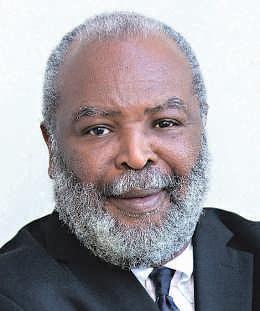














Bannerman, Bruce McLain

Bruce McLain Bannerman, 73, passedaway peacefully onOctober6 2025, surrounded by his loving family. Born and raised in BatonRouge, Bruce spent his life rooted in the community he cherished. Known for his kindness, gentle spirit, and deeplove for his family, Bruce touched countless lives through both his career and friendships. As a registered nurse, he cared deeply for his patients and colleagues, offering compassion and calm to all who knew him. Bruce found joy in life's simple pleasures —traveling, walking with his beloved dog Doodle, and spending time with family and friends. He loved antique cars and attending car shows, and some of his happiest memories were made on the water, waterskiing with his kids and their friends while they were growing up. Adevoted member of St. John's United Methodist Church Bruce shared his faith and gift of music through the church choir and bellringers. His voice and spirit will be deeply missed among his church family. He was preceded in death by his parents, Dr. Moss MortonBannerman and Melva Thompson Bannerman. Survived by his loving wife, Dana JohnsonBannerman;children, Blair Bannerman Anderson(Bill) of Baton Rouge and Christopher McLain Bannerman (Megan) of Northridge, California; sisters, Jeanne Bannerman Alexander of Birmingham, Alabama, and Carol Bannerman Juban of Baton Rouge; and brother, Moss Dempsey Bannerman of Covington, Louisiana. He is also survived by many nieces, nephews, greatnieces, and greatnephews. The absolute joys of his life were his grandchildren —Connor, McLain (Mack), Henry, and Cassidy —who brought him endless happiness and pride. They will miss their belovedPawPaw very much. Visitation will be at RabenhorstFuneral Home on Government Street on Sunday, October 19, from 3:00 to 6:00 p.m., and again from 10:00 to 11:00 a.m. on Monday, October 20, with services following immediately after. Burialwill take place at Greenoaks Memorial Park on Florida Boulevard following the service In lieu of flowers,please consider adonation to St. John's United Methodist Church in memory of Bruce.



CharlesRay “ChooChoo” Bennett passedawayon Friday, October10, 2025 at his home in St.Francisville. Hewas 84 yearsold anda lifelongresidentofSt. Francisville. He wasa grad‐uateofSt. Francisville High School andone of the seven Bennettchildrenout ofthe nine to attend Julius Freyhan School through the 4thgrade.Hewas owner andoperatorof Bennett’s SuperService Highway 61. He wasa long‐timededicated school bus driverBus #12for theWest Feliciana School Board. After retirement,hecontin‐ued to drivethe football and basketball teamsto awaygames formany years andthendonated his #12 Bustothe school dis‐trict.Hewas honoredin 2003 as theCivic Club's Outstanding Citizen. In his own quietway,hetouched manylives throughthe life lessons hisparents in‐stilled in alloftheir 9chil‐dren. He wasa member of Our Lady of Mt.Carmel Catholic Church in St.Fran‐cisville, where he served as analtar boyand laterin life, an usher. He wasa charter member of the West FelicianaHunting Cluband lovedtohunt and fish andalwaysneeded to benearthe Mississippi River.Visitingwillbeat Our Lady of Mt.Carmel Catholic Church in St.Fran‐cisvilleonWednesday,Oct 15, 2025 from 10am –12pm withfuneral Mass to follow at12pm andburialatMt. CarmelCemetery, St.Fran‐cisville. “ChooChoo” is sur‐vived by adaughter, Christi BennettSykes of St Francisville, agranddaugh‐ter,ErinSykes Hoffmann, and husband,Jake, of Slidell. Greatgrandchil‐dren, AllieChristine Hoff‐mannand Cooper Charles HoffmannofSlidell. Sis‐ters, DodieBennett Charlet ofZachary andHelen Ruthie”Bennett Davisand husband,James Randy Davis of St.Francisville. A dearfamilyfriendand travelcompanion,Ann Rosso of St.Francisville. Numerousniecesand nephews,great nieces and nephews andgrand nieces and nephews. He waspre‐ceded in deathbyhis par‐ents, CaptainPhilipMorris Bennett,Sr. and Helen Valin Bennett, hiswife, Johnnie LouWelch Bennett. His siblings,PhilipMorris Bennett,Jr.,James Wallace Bennett,MarthaBennett Senter, Irma Bennett Bryant, BettyRuthBennett Rinaudo andShirley Ben‐nettHicks.Pallbearers will beWaylanBennett, Dickie Sanchez,Rad Hicks, Don Charlet,Jr.,Bennett Jones and SamRosso.Honorary pallbearers will be Randy Davis,JakeHoffmann, Mike Bennett,BillBennett, Jay Bennett,Brent Charlet, Phil Rinaudo andDr. TimLind‐sey.In lieu of flowers, memorialdonations may bemadetoOur Lady of Mt CarmelBuildingFund or JuliusFreyhan Foundation Share sympathies,condo‐lencesand memories at www.CharletFuneralHome. com.



Jestina H. Bennie, alifelong resident of Baton Rouge, LA, passedaway peacefully on Wednesday, October8,2025, surrounded by her loving family,at theage of 84. She was a devoted wife, mother, sister, daughter,grandmother, and great-grandmother whose love and faith guided her family throughout her life.Jesse is survived by her husband of 62 years, Raymond;children, Diane Willis (Reginald) Joann Bennie-Perkins (Gerard), CamilleLitt(Jeff), Panky Bennie (Eulunda), Charon Davenport(Gregory), SuzannBennie, Regan Bennie, and Asha BennieAdams (Derrick); grandchildren, Allen, Aaron, Christine,Jay Michael,Ahmad,Aurrianne, Annice Theresa, Jessica,Jeffrey, Yasmin, Joshua, Johnathon, Christian, Chandler, Chaze, Sydney, Madison, Ryan, Genesis, Isaac, and Ruth; 19 greatgrandchildren; sister, Cynthia; and ahost of other loving family members. Jesse is preceded in death by her parents, Jerryand JohoraHosein; brother, SteveHosein;and grandsonReginald Willis, Jr Jesse will be remembered forher warmth,generosity, and strength of spirit She devoted her life to caring forothersand creating ahome filled with laughter, comfort, and love.Her kindness and wisdom will be deeply missed by all who had theblessingof knowing her. Visitation will be at Greenoaks Funeral Home,9595 Florida Blvd., Baton Rouge,LA, on Monday, October13, 2025, from 12:30pm until thetime of funeral service at 2pm.Interment willimmediately follow at Greenoaks Memorial Park. The family extends heartfeltgratitude to allfor their prayers, love,and support during this difficult time. Arrangementsare entrusted to Greenoaks Funeral Home. Family and friends are invitedtosignthe online guestbookatwww.greeno aksfunerals.com
Dyhrkopp,ErikFelix

ErikFelix Dyhrkoppdied at his home in Ann Arbor, Michigan after asudden illness on April 27, 2025. He was 60.
Erikwas born in New Orleans, Louisiana on April 23, 1965. He was a1983 graduateofJesuitHigh School and served on its NationalAdvisory Board and as part of itsNational Advisory Board Endowment Challenge. Erik majored in Philosophyat theUniversity of New Orleans, earning a Bachelor of Arts degree, with honors, in 1987. Erik then attendedthe Northwestern University PritzkerSchool of Law,
where he was awarded a Juris Doctor degree in 1990. Erikwas an ArticlesEditor forthe Northwestern University Law Review from1988-90. Erikalso represented Northwesternin 1988-89atthe Philip C. Jessup International Moot Court Competition, the world's largestinterschool mootcourtcompetition that has been held annually forthe past 65 years. He was admittedtothe state barofIllinois in 1990.
Erikserved as thelaw clerk forJudge Diarmuid O'Scannlainofthe United States NinthCircuitCourt of Appeals in Portland, Oregon from1993-94. He then clerked for Judge K. MichaelMoore of the United States District Court forthe Southern District of FloridainMiami, Florida from1994-95.
Later,Erikbecame an equitypartner at Bell,Boyd &Lloyd LLPinChicago, where he was amember of theAntitrust Department. Eriksuccessfully represented theCalifornia Dental Associationinthe United States Supreme Court, prevailing in the case California Dental Associationv.Federal TradeCommission, 526 U.S. 756 (1999). In addition to antitrust matters,Erikfocused his practice on distributionlaw and complex commercial litigation. Erik ultimately became Senior Vice President and General Counsel forthe Americas forRobert BoschLLC, a subsidiary of Robert Bosch GmbH. After alongand distinguishedlegal career, Erikretired in January 2025.
Erikloved Mardi Gras and became amember of theKrewe of Thoth in 2013.
Erikispreceded in death by his brother, Neil William Dyhrkopp. He is survived by his wife, Diane Ferguson; his mother, GayleDyhrkopp,and her companion, Harry Wood; his father, Felix Grover Dyhrkopp and hiswife, Pamela;his sons, Zachary (Phoebe); Lucas;his daughter, Alana; and many cousins,friends, and family members.
Erikwillbelaid to rest withhis brother, Neil Dyhrkoppand this grandparents, Doris Kaneland William Henry Gerbrecht, in aprivate ceremony at GreenwoodCemetery in NewOrleans.
In lieu of flowers,please considermaking adonation to theLouisianaOrgan Procurement Agency
Amemorial servicewith mass willbeheldon Saturday October 18th, 2025 from1:00 PM to 2:00 PM at JesuitHighSchool of NewOrleans Chapel, 4133 Banks Street,New Orleans, LA 70119.
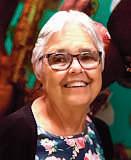
St Rose —Irene Mokrycki Estay passed away Saturday October 4th, 2025, surrounded by love.Known for her dedication to family,Irene leavesbehindher husband of 54 years Tommy, son Stephen (Shanna) daughter Sarah (Ashlynn) and twobeautiful grand-
daughters Alyssa &Chloe Sheisalso survivedbysisters Christina, Johanna, andStephanie.Proud of herPolish ancestry, Irene is proceededindeathby herparents Stefan and HelanaMokrycki. At Irene's request, therewill be no services. With holiday andfamilygatherings deeply important, she made it known she wanted us all to share alaugh and raise aglass in honor of herjourney home.A celebration of herlifewill be held at alater time
Gautreau, Paulette Mayers
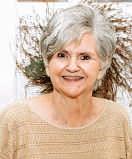
Paulette Mayers Gautreau,a lifelongresident of Gonzales, LA passedawaySaturday, October4,2025, at the age of 76. Born to Maurice Mayers Sr andEtta LambertMayersonFebruary 16, 1949, in Brignac,Louisiana. She is survived by hertwo daughters Maisie,(husband Jason Guidry) and Judy (husband Gary Christian Jr.), hergrandchildren, Hannah Guidry, Caleb Guidry, EmilyChristian (fiancé Bryant Kole Graham) Evan Christian,and great granddaughter ParkerKole Graham, brothers Perry andBeryl Mayers,and sisters Patricia Mayers,Fern Elisar, Sharon Deshautelles, and numerous nieces andnephews. Proceeded in death by herfather Maurice Mayers Sr andmother, Etta Lambert Mayers,sistersJudy Ann Mayers,Barbara Mayers Lambert, Kaye Mayers Lambert, andbrothers Manuel, Maurice Jr,and GabrielMayers. Herlife wascentered around her deep love forher family. Shecherishedher time with herfamily, especially hergrandchildren, and most of all hergreat grand baby, Parker. Shewas the first graduating class of East Ascension High School in 1967. Shewentto work straight after graduation for SouthCentral Bell TelephoneCompany. She also workedasa church religiouseducation secretaryatHoly Rosary Catholic Church.Thenlater in life shebecame aloving caretaker for many families,caringfor childrenin homes. She always held a strongfaithand love of the Lordand lovedserving people. Shewas the epitome of agoodGod-fearing woman. Sheraised wonderfulchildren andloved herLord. "Ifanyone asks howI want to be remembered, please say the following about me: Ilove God, my daughters, grandchildren, great granddaughter, family& friends. Ienjoyedlife, Iworked hard. Ihelped othersas much as Icould."
Hartman, Robert Keith

Robert KeithHartman 67, anative andlongtime residentofBaton Rouge
LA, and later residingin Banner Elk, NC, passed from this life to hiseternal home in Heaven,onAugust 31, 2025. Robert wasretired from theLouisiana State Civil Service Division.During his tenure,hecreated aprogram to assist disabled andhomeless veterans. He wasanAir ForceVeteran,honorablydischarged He later graduatedfrom Louisiana State University in Business Administration Knowntofamilyand friends as Robert,Robbie, and"Big Bob!". He had a laidbackgentlenature that could be seen and heardthrough hiseyesand laughter. Many said and commented, "Hewas one of thegoodguys!". Robert wasanadventuroustravelerand lived out hislifetime goals of skydiving, whitewater rafting andmost of all livinginthe mountainsofNorth Carolina with his devotedGerman Shepard companions. He wasanavidLSU Sports fan He is survived by: sister, Gwen Guillot, spouse, Shane Guillot;niece,Kristen Gonzalez, spouse, Luis Gonzalez, great nieces Avalyn &EmmarieGonzalez. Aunt,Patricia A. Parker,Uncle,GilbertS.Parker, Jr.; 4cousins &spouses, Paige &JohnDouglas Hall, Sr.; Glinda &Stephen Glascock; Pamela &Gregor Thuswaldner;Georgette& Robert Bynum Preceded in death by; grandparents, Sam T. Alello &Flavia Louise Aubin Alello;mother,Margaret Louise Alello Hartman;father,RobertFrancesHartman, Sr He will be laidtorest at RoselawnMemorialPark Cemetery in Baton Rouge Gravesideserviceswill be held on Thursday, October 16, 2025 at 10:00am. The familyrequestsattendees to honor Robert by wearingLSU casual attire at services. Special thanks goesout to hisextended familyof caregivers at Fresenius KidneyCareofBoone, NC for theirloving care In lieu of flowers, the familyrequestsdonations to the: NationalKidney Foundation (https://www.kidney.org) in hismemory
Heurtin Jr., Floyd Joseph Floyd J. HeurtinJr. passedaway peacefullyon October6,2025 surrounded by family. He was69years of age. Floyd wasbornon November 21, 1955 in Norco,Louisiana, andhas been alongtimeresident of Baton Rouge.Hehas hada long career as a boardcertifiedsocial worker. Floyd has been an active memberand lay reader of St Luke'sEpiscopal Church.Heloved sportsespecially golf and he nevertired of playing with hisbordercollie Luke. He is survived by his belovedwife of 40 years, Geri; daughter Geren,stepson Jackson,sistersPenny Heffner (John), andLisa Ramos, andbrothersSteve (Dorrit)and Mitch. He was preceded in death by his parents Kay andFloyd Heurtin, anda brotherTimmy. He leaves behind numerousnieces, nephews, cousinsand aunts anduncles. Thefamilyextendsa heartfelt thanks to The Clarity Hospice andthe Gentiva hospice agency for theircompassionate care andkindness. Also we thank all thedoctorsand nursesatThe Lady of the Lake Hospital as well Though no memorial service is planned at this time,Floyd will be truly missed and forever rememberedfor hiskind heartand strongfaith.
















Houston, Gwendolyn Patin


Gwendolyn Patin Houston, adedicated mother, grandmother, and community member, passed away peacefullyat95on September 14th. Born in Lafayette, Louisiana to Lydia and Oscar Patin, Sr. she graduated valedictorian from Paul Breaux High School at 16 and attended Rhodes College in New York City. Gwendolyn worked at Standard Insurance Company, later marrying Louis M. Houston and jointly running businesses for over 40 years. Known for her wit, intelligence, kindness, and dedication to education, Gwendolyn was deeply committed to her family and faith. She is survived by her children Dr. Louis M. Houston, Dominique Lueckenhoff, Gwen MichelleHouston, grandson George Maxwell Lueckenhoff, and several nieces and nephews.A Memorial Mass is scheduled for November 8, 2025; details are available on Kinchen Funeral Home's website. Donations may be made to Little Sisters of the Poor or theMother Teresa Missionary Sisters of Charity.
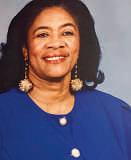
"I have fought the good fight, Ihave finished the race, Ihave keptthe faith."
-2Timothy 4:7 On Saturday morning, October 4, 2025, Almena Davis London Major peacefully transitioned to her eternal home in Heaven, surrounded by love andin perfect peace. Born on October 28, 1936, in Ethel, Louisiana, to the late Reason and Rowena Moore Davis, Almena was one of thirteen children raised in aloving Christian home.She ac-
cepted Christearly in life at Asphodel Baptist Church and later became adevoted memberofMountPilgrim Baptist Church, where she faithfully servedfor over 55 yearsinthe Sunday School and Drama Ministries.
Almena was aproud graduate of Southern University and A&M College, earning both Bachelor's and Master's Degreesin Education and Library Science.For more than34 years, she taughtinthe East Baton Rouge Parish School System, influencing generations of students with herfaith,wisdom, and compassion.
On December 27, 1981, she marriedthe love of her life, EdwardL.Major, whom she met at abowling alley.Together they shared nearly 45 years of love, laughter, and championship bowling, competing with the USBC and TNBA Bowling Associations.
Shewas precededin death by her husband, parents, and siblings.Cherishing her memoryare her childrenDexter, Ginger, Osha (Tunisia),and Asha (Mike);six grandchildren; and two great-granddaughters. Her legacy of love, faith, and service will continue to shine through allwho wereblessed to know her
Aviewing (wake) willbe held from 4:30 PM to 6:30 PM on 2025-10-14 at Mount Pilgrim BaptistChurch, 9700 Scenic Hwy. Afuneral service willbeheldfrom 10:00 AM to 12:00PMon 2025-10-15 at Mount Pilgrim BaptistChurchLife Center,9700ScenicHwy.

Deputy Charles Rileyof Iberville Parish Sheriff's Office,age 33, died in the line of duty on October 6, 2025 He was was born January 3, 1992,inBaton Rouge,LA. Charlieenjoyed theoutdoor adventure in the woodsand bayous surrounding his home in St Amant. His love for the outdoors put asmileonhis
face. Charliegrewupfish-
ing every lake and bayou he couldfind and hunted squirrelsout of every tree he walked under. He enjoyed playing baseballand buildingbonfiresonthe leveewith his family.Charliejoinedthe U.S. Navy as an airman aboardthe USS Dwight D. Eisenhower in Norfolk, VA, achieving the rank of Aviation Boatswain'sMate Third Class (SW). DeputyRiley served over sixyears with IbervilleParish Sheriff's Office,servingthe East Bank of IbervilleParish during that time as auniformed patrolman. He served his community with compassion. He received theOutstanding Bearing Award forprofessional appearance and attitudein 2020 and received aletter of commendationfor saving thelifeofa gunshot victimonJune 26, 2021, He was also therecipient of theTop Gun award in 2024 for his department.Deputy Rileyenjoyed bringing his smiletothe children and studentsaround East IbervilleParish schools. Deputy Riley's selflessness and love forthe people of thecommunity of East Ibervillewas best illustrated when he helpedayoung mother and childsafely escapea badsituation.
Charlie is survivedby his wife, Carlye, his daughters, theloves of his life Cassidy and Ella; goddaughter Emma Ory,parentsBilly DeanJr.,and Libby Riley, father-in-law SteveBezet,sister Rebecca Riley, brother Steven and Rachel Riley, brother Brian Riley, uncle Jeff and Denise Riley, Nancy and Stacy LeBourgeois, Beth and DeweyFrederic, Peter Riley, Liciaand David Chaney, nieces JenisonRiley, Addison Riley, and Alli Riley, and nephew Joby Mullins, and extended familyMike,Kristen, TaylorLatiolais, and Rachel Steadman, partner Jordan Ward along with dozens of loving cousins.Charles Riley is preceded in death by his paternal grandparents, Billy DeanSr.,and Barbara Riley, and hismaternal grandparents Arthur Josephand RubyOry;godfather Kevin Ory;uncle Christopher Drew RileySr.; and cousin Brandy Chaney. Amemorial service willbe held at thePrice LeBlanc PACE Center, 2824 St AnthonyAve,Gonzales, LA on October13, 2025, from 12 pm until 3pm. Honorary pallbearers willbeSteven Riley, Brian Riley, CPLJa-
cob Ory GPD, SMSgtClintonRileyUSAF, Nick Riley, Joby Mullins, Deputy JordanEricWard IPSO,and Deputy Michael "Parallelogram"Pellerin IPSO. In lieu of flowers,the family requests to considerdonating bloodtoOur Lady of theLake in Captain Brett StassiJr's name. Deputy Charles "Charlie"Riley's smileand attitudewillbe deeply missed,but his legacy of servicewillcontinue to inspire us all.To best serve Charlie as he's servedhis family,friends, and communityofEast Iberville, go out and meeta stranger, offer asmile, and lend ahand to anyone in need.

Schexnayder,Barbara Jean
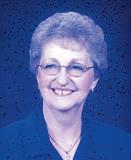
Barbara Jean Schexnayderpassed away on October7,2025 at theage of 86. She wasa nativeofDetroit, Michigan and acurrent resident of Baton Rouge, Louisiana. Barbara has now gone to join her late husband, Ronald Schexnayder, in their heavenly home. She leavesbehind to cherish her memory her children; JamesSchexnayder, TroySchexnayder (Mary) and Dawn Kershaw (Chris) and her grandchildren;Paige,Judeand Cole. She was born on April 26, 1939 to thelate William and Helen Mitchell.She is thesister of TaffyLakatos and thelate Helen Angel Barbara was aloving wife, mother, grandmother and friend to many. She was adevoutCatholicand had astrongfaith and love forGod.Inher down time, she enjoyed cross-stitching and playing on her iPad.But most of allshe lovedspending timewith family.She truly willbe missed by allwho knew and lovedher.
Family and friends are invitedtoattenda Mass of
Christian Burial on Tuesday, October14, 2025 at 11:00 AM at Most Blessed Sacrament Catholic Church,15615 Jefferson Hwy. Baton Rouge,LA 70817. The visitation will begin at 10:00 AM until the time of service.She willbe buriedatLouisiana National Cemetery,303 WMt Pleasant Zachary Rd Zachary, Louisiana 70791. Fond memoriesand words of condolence may be expressed at www.OursoFH.comfor the Schexnayder family.

Shread, Andrew David 'Andy'

Andrew"Andy" Shread, cherished father,son brother, nephew,and friend, passedawayon Wednesday, October 8, 2025, at the age of 43. The familyinvites all whoknew andloved Andy to join them in commemorating hislife. Avisitation willbe held at ResthavenFuneral Home, locatedat11817 Jefferson Hwy,Baton Rouge, on Tuesday, October 14, 2025, from 12:30 p.m. until theMemorialService at 2:30 p.m. To read the full obituary, or leave apersonal note to the family, please visit www.resthave nbatonrouge.com.




Van Netta, Jeanne Marilyn
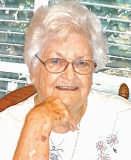
Jeanne Marilyn VanNetta, 94, passed away peacefully on October3,2025. A beloved wife,mother, grandmother,and matriarchofher family, Jeanne leaves behind herdevoted husband of 74 years, David H. VanNetta; hercherished children, DavidVan Netta(Alice), Michael Van Netta(Debbie), Donna Frederick (Neil), Cheri Fontenot (Jackie), andSandraSanders; grandchildren,AngelaZenk, Nicholas Frederick,Joshua Sanders, Allyson Frederick, Alexis Johnston,Lauren Lanza,and Cory Van Netta; 13 great-grandchildren; andher sister,Nancy Pronia. Shewill be remembered for hergenerosity, kindness, and selflessness. Her greatest joyinlifewas caringfor herfamilyand spending meaningfultime with eachand everyone of them.She will be deeply missed by all whoknew andloved her. Aprivatefamilygatheringwas held in herhonor To share memoriesor leave condolencesfor the family, please visit www.gr eenoaksfunerals.com.



Our state got some good news last week when officials announced that college football’sbiggest ticket would be returning tothe Caesars Superdome in 2028. The College Football Playoff title game is always ahuge event,bringing in fans from around the country,or, if acertain Louisiana team makes arun, fans from all around thestate.
College football expanded its playoffs to 12 teams last year,and it will be the first time theSuperdome hosts atitle game underthat format. The CFP National Championship game will be played on Jan. 24, 2028, as the capstone of the 2027 season.
It was another welcome shot in the arm for the Dome after anew lease for the Saintsfinally got signed. The state and the Saintsagreed to a10-year dealwill keep the team in New Orleans through 2035. Thehighly contentious negotiations to reach an agreement resulted in the Superdome missing aSeptember deadline for bids to host the 2031 Super Bowl. We are hopeful that those missteps can be smoothed over,however,and that the Dome will be under consideration.
The CFP title game and the Super Bowl, falling as they do in the midst of the Carnival season, always make it alot more crowded in New Orleans in January,but the hotels and restaurants don’tmind. And whenwesee ourstate featuredprominently on the national, or even global, stage, it makes it all worthwhile. There’snoquestion football is huge in our state, and these events cement New Orleans’ and the Superdome’splace in that sport’slore. It’sahistory that includes hosting five collegiate national champion games. The 2028 game will be only the second one in the Dome in the CFP era, the previous one being in 2020 when LSU defeated Clemson to claim the title.Then there’sthe Sugar Bowl, one of college football’s premier bowl games. It has been held in the Superdome since moving from Tulane Stadium in 1975. And with 2025’sSuper Bowl in the Superdome, New Orleans served as host of the big game for the 11th time. Miami is the only other city with an equal number of Super Bowls. It seems natural to us that organizers of some of thenation’smost popular sporting events want to come to New Orleans. We have an atmosphere like no other.But it really doesn’t happenwithout alot of behind-the-scenes work from the businesscommunity, civic organizations and state and city leaders. We are glad they continue to do what it takes towin these events. The Superdome has long been central toour image as astate, andweare glad to see that even as it turned 50 this year,it’sasbeloved as ever. We hope, in its golden anniversary year, the best is yet to come.
LETTERSTOTHE EDITOR ARE WELCOME.
GUIDELINES: Letters are published identifying name, occupation and/or title and the writer’scity of residence

TheAdvocate |The Times-Picayune require astreet address andphone number for verification purposes, but that information is not published. Letters are not to exceed 300 words. Letters to the Editor,The Advocate, P.O. Box 588, Baton Rouge, LA 70821-0588, or email letters@ theadvocate.com. TO SEND US A


It’snot often that Louisiana balks at an offer to sell its natural resources for cash.
That’swhy it’s apleasant surprise to see two statelegislators warn the Sabine River Authority that any attempt to sell water from the Toledo BendReservoir is anonstarter.It’seven better that the two legislators, Rep.Brett Geymann, R-LakeCharles, and Sen. Bob Hensgens, R-Abbeville, chair committees that would need to bless any such sale.


For thosewho have not spent time on the bucolic, 186,000-acre, 65-milelong reservoir located on Louisiana’s western border,let me explain. Toledo Bendwas created when the Sabine River was dammed in the1960s. It’s becomeextremely popular as arecreation and fishing spot for thousands from both Louisiana and Texas.
It’sgoverned jointly by Louisiana andTexas, through two different authorities, one on each side of the border.Water that flows through thedam on the reservoir’ssouthernend is used to generatehydroelectric power; each side has theauthority to sell some of thewater,though theproceeds must be split
Butfor several years,there have been discussions aboutselling aportion of Louisiana’sshare of the water to acompany called Aqueduct Partners,which would pipe it to water-starved cities in Texas. Proponents argue that this sale could be done with little to no impact on lake levels and generate far more revenue than hydroelectric generation. Butthe idea has drawnopposition from many locals, whoargue that such asale could cause water levels to drop and makethe reservoir less amenable to recreation.
Earlier this week, Geymann and Hensgens sent aletter to Louisiana’s Sabine River Authority,urging them to reject any proposed sale.
“Weurge you to abandon these plans and safeguard thelong-term interests of our people, economy and environment,” Geymannand Hensgens wrote. “Toledo Bendisvital to Louisiana residents, businesses and wildlife.”
They are right about that. But more important is something Hensgens told this newspaper’sDavid Mitchell.
“I just believe that in the next century,water is going to be the most important natural resource we’ve got, and it is Louisiana’swater.Itbelongs
to the state taxpayers, and Ijust don’t believe we should be selling it,” Hensgens said.
Hensgens is absolutely right about this. Water is an increasingly valuable natural resource. Fortunately forLouisiana, the state is blessed with plenty of it both on the surface and under it. But there is little statewide impetus to take an accounting of just how much, despite increasing demands from industry,agriculture and, potentially, moredata centers, which use alot of water In other words, Louisiana is obviously water rich, but we have no idea exactly how rich we are. And until we know how much we have, we shouldn’t be selling what we do have, no matter how tempting the dollar signs dangled by rich Texans. Thankfully,Geymann and Hensgens’ letter seemstoindicate, at least for now,that no such deal will go forward. It maybe, at somepoint in the future, that selling Toledo Bend water is an idea that makes sense from a financial and resource-management perspective.
But that timehas not yet come.
Email Faimon A. Roberts III at froberts@theadvocate.com.
Ourjobs as journalists are constantly evolving. What is the job of one person today was probably thejob of five people when Istarted my career decades ago.
Although you may look at your favoritewriter as aperson who gathers and reports news, that person is often writing headlines, copy editing, selecting photos, posting stories on theweb and circulating those stories online. While it’s true that many small newsroomshave been one-man or onewoman operations, it is truly amazing how much reporters and editorsat mostnews outlets must know about all aspects of news gathering. There are some benefits to this change. The more reporters and editorsknow how to do, themore they can makesure thewords and images associated withtheir stories are relevant and the more quickly they can get


stories online. Butthere are also somedownsides. With attention spreadtomanyother tasks, it can be easy to lose sight that readers care about thebasics most. We get plenty of outraged letterswhen readers spot typos in stories or obvious factual mistakes that they feel should have been caught by editors. Ihave to say Iunderstand.Nothing erodes trust in what you are reading more than catching aglaring error.“Did anyone read this?” readers sometimes ask. Andyes, while editors do read all copy before it is published, we do sometimes miss things in the rush of the day.Whenwesee mistakes, we vow to correct them as soon as possible, and we try to be as transparent as possible about that. Of course, there are someways to minimizethe chance of errors, including having moreeyeballs on astory
As an editor,when I’mracing through copy,I sometimes remind myself to slow down. Even the best stories can be undermined by sloppy editing. We hear you, dear readers, and we want to give you the best product possible.
Turning to our letters inbox, forthe weekofSept. 11-18, we received 65 letters. The killing of conservative activist Charlie Kirk and its aftermath was the topic that prompted the most letters, with eight people weighing in. These included letters about the suspension of comedian Jimmy Kimmel for his remarks about the events following the murder.Then twotopics got four letters each: the National Guard being deployed in U.S. cities and changes in access to the COVID vaccine.
Arnessa Garrett is Deputy Editor | OpinionPage Editor.Emailher at arnessa.garrett@theadvocate.com.


Gov.Jeff Landry’sadministration seems far more eager to cancel wetlands restoration projects than to say what shouldbe done instead. For the second time this year,the administration on Thursday canceled a Mississippi River diversion program, this time the Mid-Breton Sediment Diversion on the river’s east bank, across from Delacroix. In July,the state canceled the Mid-Barataria Sediment Diversion on the west bankofthe rivernear Myrtle Grove. The state already had spent some$619 million on MidBarataria and some $70 million on Mid-Breton. The former was slatedtocost atotal of $3 billion while GordonDove, chairman of the state’sCoastal Protection and Restoration Authority,said thelatter’scost had grownfrom an estimated $800 million to $1.8 billion. Both projects had attracted
spirited opposition from seafoodindustryinterests, while MidBarataria also found enemies amongthose worried about hundreds of dolphins the freshwater diversion was projectedtokill.


Before the Mid-Barataria project was nixed,I had written twice that it was awell-meaning but illadvised endeavor.Asa decadeslong advocate for coastal wetlandrestoration, though,Ithought it crucial to identify numerousother options for marsh replenishment to replacethe massiveMississippi River diversion. Among themany optionswere (and are) smaller diversion projects, backfilling of oil pipelinecanals, use of dredged material from the Mississippi River and elsewhere, and major efforts to seed new oyster reefs. So far,at least, that concern aboutalternate strategies for coastal salvation seems stunninglyunemphasized by Landry
and Dove. Andeven where Dove has madenoises in that direction, specificityhas been notably lacking. Almostall the administration’s verbiage has been about how thetwo diversion projects had becometoo expensive —but not about how expensive, in manifold other ways, it will be to keep lettingthe wetlands erode at afurious pace.
More than seven weeks have passed since thecancellation of Mid-Barataria was announced, and that decision had been in the works for monthsbefore that Those seven weeks alone, not to mention thelong run-up to the decision, should have been plenty long enough for officials tohave indicated progress toward alternative arrangements Likewise, Dovesaid publicly as early as May that the cancellation of Mid-Breton was likely.Why weren’tofficials ready,the very day they announced the project’s death, to say what elsethey hope
to do to preservethe state’scoastal heritage? Or,for that matter, how thefinances will work out, with tens of millions of dollars apparently downthe drain and with hundreds of millions potentially available —but also potentially forfeitable if the federal governmenttries to claw the funds back. Dove did say the state would seek toreprogram the money slated for Mid-Breton forarange of projects, including the use of dredged sediment in the Barataria Basin. Good. But what else? Where are the details? What are themetrics forsuccess? How will he guarantee accountability? Ihave no idea if the abandonmentofthe Mid-Breton project was the right call. Perhaps it was. Butitisfoolhardy to say,asDove did, that much smaller-scale, existing projects mean “you don’t have any need for” sediment flow of the sort Mid-Breton was intended to produce. The existing projects arecreating apittance of the marsh restoration needed
to counteract the 20 square miles, at the very least, that the state is losing each year.Louisiana’s citizens deserve plans much more comprehensive than the administration is offering.
Frankly,ifnoannouncements of farmore substance are soon forthcoming, the silence will be a major example of governmental malpractice. Toomuch work, for decades, has gone into attracting too much money,tohelp combat too big aneed, foritall to be frittered away
The administration should be giving asense of urgency here, not of torpor.Ofenergy,not of sloth. Of specificity,not vagueness. And of transparency,not obfuscation.
Unless something changes soon, the administration’sreputation forgood stewardship of Louisiana land and finances will disappear even faster than the wetlands.
Email Quin Hillyer at quin hillyer@theadvocate.com
It’snot astretchto say that Section 2ofthe Voting Rights Act —the part of the landmark 1965 civil rights legislation at the center of aLouisiana case that the U.S. Supreme Court will hear this week —gave us much of modern American politics. It created asystem in which minority voters could finallyelect representatives from districts drawntomake sure their voices werenot intentionally minimized. We’veseen the effect in Washington,where the CongressionalBlack Congressgrew to apowerful force, and also closertohome, where districts drawn under theVRA’s terms routinely elect politicians who represent the majority of their constituents’ political preferences. That’sthe visible part.


that overwhelmingly Democratic districts —think Troy Carter’s New Orleans-based 2nd Congressional District, which is majority Black frequently abut districts such as Steve Scalise’s suburban 1st, which is overwhelmingly largely Republican and White. Pols in both types of districts tend to have very easy reelections.
There’sahuge upside to better representation, butthe system has adownsidetoo, in that it relieves politiciansofhaving to listen to constituents who don’t share their views androbs voters of areal choice when it comes to philosophy.Ifyou’re seeking answers to whyour country’s politics have become so toxically polarized, this is definitely one place to look.
But the practice has also given us the homogenous districtsthat border these voting rightsdistricts,which too elect politicians who reflect an area’sdominant political opinion.
In acountry where racial voting and residential patternsoften track political party,thatmeans
Whichwould make for aperfectly good argument in favor of the plaintiff’s side in the Callais case, achallenge to Louisiana’s newlydrawn 6th District alleging that it resulted from arace-based gerrymanderthat violates the equal protection clause of the Constitution —ifnot for theobvious fact that reducing partisan-
ship is not remotely the point
Gaining still morepartisan advantage? Now that is.
The underlying truthisthat districting through thelegislative process is about the most political act there is, and is just about always about creating winners and losers.
In fact, it’simpossible to view thechallenge to Louisiana’scurrent map,which features two Black majority and Democratic districtsand four Whitemajority and Republican ones, as separate and apart from theRepublican drive to use whatever levers they can find to keep control of a narrowly divided Congress next year It’swhy Texas and other Republican states —atPresident Donald Trump’sovert urging —are takingthe rare tack of redrawing districtsmid-decade, to scratch and scrape for any possible district they can pick up. It’salso why California is trying to change its law so that Democrats there can counter the effort.
Andit’snot far-fetched to think thesympathetic SupremeCourt majority,which has in recent years weakened other partsof theVRA, might help out by using
theLouisiana case to minimize or eliminate the requirement that districtsbedrawnwith race at least somewhat in mind. Until the last election, the state had five majority White Republican districts to one majority Black Democratic one. By the numbers, that’san83%-17% advantage, despite the fact that thestate’spopulation is about a thirdBlack according to the last census, and that Democratic candidates for president —probably theeasiest measure of overall partisan leanings —typically get close to 40% of Louisiana’svotes.
The state Legislature’sRepublican majority has long resisted efforts to even things out, including amove to create amore closely split district in the state’snorthwest corner that either party might win When courts ordered asecond minority district to be drawn under theVRA, lawmakers carved out asafe space forHouse Speaker Mike Johnson and drew adistrict, eventually wonbyCleo Fields, that seemed designed to invite achallenge which, the high court is indicating, could lead to a broader diminishing of Section 2.
This is allincredibly compli-
cated and messy.There are no strict numerical standards for determining Voting Rights Act compliance, and there are conflicting rules on what factors can be considered. And admittedly,there’d be advantages to having morecompetitive districts —something Texas might wind up finding out if enough of the Democrats that lawmakers there split up among Republican districts wind up making them less reliably Republican. The best idea on the table is having districts in all states drawnbyindependent commissions —areform, ironically,that California adopted and is now attempting to reverse so as to not unilaterally disarm against states like Texas.
Ideally,these would offer true equal protection foreveryone, including those whose voices have historically been minimized and marginalized. Getting rid of this key part of the Voting Rights Act and giving the politicians carte blanche sure isn’tthe solution.
Email Stephanie Grace at sgrace@theadvocate.com.
Derrick Groves clearly likes taking risks.
And he’spretty good at it.
Groves was captured in arespectable, middle-class Black neighborhood in Atlanta on Wednesday after being on the run for five months.


Groves is abad man, according to his long rap sheet and law enforcement officials who had been chasing him. He was convicted of using an AK-47-style rifle to murder two men on Mardi Gras in 2018. He also was convicted of two counts of attempted second-degree murder and two counts of second-degree murder
The convicted killer was behind bars when he escaped —orwas “let go” to use Orleans Parish Sheriff Susan Hutson’s preferred phrase —onMay 16. “ToEasy LOL”was the now-infamous, misspelled New Orleans taunt the 10 Orleans Parish jail inmateslefton acell wall before leaving the jail.” Groves was found in aone-story home with abasement near Campbellton Road and Honeysuckle Lane. There were othersinthe home, according to DistrictAttorney Jason Williams,who made the comments Thursday during an interview on WBOK’s“Good Morning Show,” which Ihost.
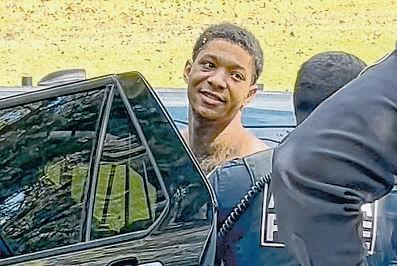
He saidneighbors saw someone wholookedlike Groves peeking outofthe windows from time to time during whatmight have been astay of severalweeks to a month there.The AtlantaPolice Departmentworked with the U.S. Marshals Serviceand otherstodeploytear gas canistersand aK-9 officertohelpand found Groves in acrawl space. He’ll be heading to Louisiana State Penitentiary at Angola where the other nine escapeesare being held. Apparently,Groves likes the goodlife. The house where he was found is located in SWATS, the SouthwestAtlanta area —roughly
including neighborhoods like Ben Hill, Adamsville, Cascade, Oakland City,Campbellton Road and Greenbriar.MyHotlanta peeps in the know call that area the SWATS, as in ‘Southwest Atlanta TooStrong.” Locals, especially my younger GenX friends, started calling the area SWATSand the term took off when OutKastand Goodie Mob startedusing it just as folks weremaking Atlanta hip by calling the cityThe ATL. Campbellton, which is on the edge of the SWATS, has seen better days, but the nabe is hanging on. SWATSisn’tone neighborhood. It’s agroup of neighborhoods
and an ATLculture. Think the French Quarter,but Black. Think Treme whenitwas Black. It’s part city,part suburb because the SWATSincludes College Park, which sits in Clayton and Fulton counties and East Point, which is in Fulton County The SWATSissignificant in Atlanta culture, history and politics. Every Atlanta mayor since Mayor Maynard Jackson has lived in the SWATS. Others who have lived there include baseball great Hank Aaron; U.S. Rep. John Lewis, he of “good trouble;” and the Rev.Joe Lowery, co-founder of the SouthernChristian Leadership Conference withMartin Luther King Jr Atlanta Mayor Andre Dickens lives in the SWATS. Former Atlanta Mayor Keisha Lance Bottoms grew up there. Former United States Ambassador and Atlanta Mayor Andrew Young, aNew Orleans native, lives there. If you’re on the lam, why choose Atlanta rather than Des Moines, Hilton Head or Long Island? Or Cleveland? If Atlanta, why choose themostprominent Black neighborhood? “Trying to hide in Atlanta was apoor choice for Groves,” said Jim Joyner, U.S. Marshals Southeast Regional Fugitive Task Force Commander We know whenGroves and the othersleft the city jail. We don’t know where Groves went from there —orhow long he’sbeen
hanging out in Atlanta. Dayby day and week by week, his colleague escapees were recaptured, but Groves became atemporary criminal legend.
Five months is far from life with law enforcement wondering where youare, but Groves built a bad boy fan club that was rooting for him while he was gone and even after his capture.
“You had agood run Derrick,” one person posted. “It was agood run my boy!” another posted. “Homie gone be rich in jail. Lifetime movie gone be fire,” wrote another Really? We should want bad guys off the street. I’m not sure I’d head to aprominent neighborhood like the SWATS if Ididn’twant law enforcement to find me.Seems“to easy” to me Idon’tknow muchabout how the film industry operates, but I’m sure there are movie people buzzing about ascript about aman on the lam who blew akiss to onlookers upon his capture. If that movie is made, Iwonder whetherhe’ll get to watch it and Iwonder whetherhe’ll cash in while living along life behind bars.
Five months? “Toeasy.” Not strong. Bad boy off the streets. Good. Email Will Sutton at wsutton@ theadvocate.com.










































































20

10

LSUoutlastsSouth Carolina with familiar flawed offense, stoutdefense
BY KOKI RILEY Staff writer
Brian Kelly’smessage tohis team at halftime was simple: Eliminate the catastrophic mistakes.
“If we play cleaner,we’re in great shape,” the LSU coach told the LSU radio network.
After fumbling theball at the goal line, throwing an interception and scoring just three points offoftwo South Carolina turnovers in the first half, LSU wasn’tquite done squandering opportunities or makingmassive
mistakes Saturday night against the Gamecocks.
Butthankstoanother superb defensive performance,another interception from fifth-yearsenior quarterback Garrett Nussmeierinthe third quarter wasn’tenough to cost LSU awin.
TheTigerstook down South Carolina20-10 in TigerStadium on Saturday,improving to 5-1 despite turning the ball over three times and failing to cash in on opportunities created by their defense.
Tigers overcome asteroid of theirown making,but better is required
How best to describe LSU’s 20-10 victory over South Carolina on apicture-perfect Saturday night in Tiger Stadium?
Remember in the movie “Armageddon,” when it looks like the planet-killer asteroid is going to smack Earth right upside theequator,but at the last minuteBruce Willis manages to detonatethe nuke to splititintwo?
Scott Rabalais


It was like that. LSUcoach Brian Kelly,happy as he should be for aSoutheastern
Conference victory but not predisposed to going off on any questions about the offense, described someofhis team’s play as “catastrophic” at times.
“Wewon the game,” Kelly said after picking up his 200th career FBS victory.“That’sa good thing. We had mistakes that could have been catastrophic, but we found away to winthe game.”
BY MATTHEW PARAS Staff writer
Back in April, Brandon Staley had completed alate-night workout at theNew Orleans Saints’ facility when,ratherthanshoweror go home, the defensive coordinator studied more prospects for the NFL draft. Still sweaty and gross—or“fresh,”ashe called it —Staley went down alistofsafe-
ä Patriots at Saints NOON SUNDAy,CBS
ties and studiedthem one by one. He started with their tackling tape,movedtotheir playsonthe ball, shiftedtohow they performed in theslot and finished by watching entire games. Staley was there for hours. Months later, he stillvividly recalls this night because it wasthe first time he
watched Jonas Sanker
“Histacklingtapewas as good as any safety in thedraft,” Staley said. Sanker’s tackling wasn’talways noticed Longbefore he wasdrafted by theSaints in the third round, he wasused to being ignored. Growing up in Charlottesville, Virginia, Sankerplayed eight-man football at TheCovenantSchool —and because of it, colleges were slow to pay attention.
Perhaps college coacheswere quicktodismiss the level of competition, as each week Covenant would steamroll its opponent. Perhaps they scoffedateight-man football, where three fewer players on each side of theballcreates loadsofspace anda trackmeet pace. Perhapstheywere too busyattending normal high school games.
ä See SAINTS, page 7C


















BY DAVE SKRETTA AP sportswriter
COLUMBIA,Mo.— Ty Simpson threw for 200 yards and three touchdowns, including the clincher on fourth down to Daniel Hill with 3:16 to go, and eighth-ranked Alabama held off No. 14 Missouri 2724 on Saturday to give the Crimson Tide their fifth consecutive win.
Jam Miller added 85 yards rushing before leaving with a concussion in the fourth quarter, and Kevin Riley and Isaiah Horton also had TD catches for Alabama (5-1, 3-0 SEC), which has won seven straight over Missouri dating to Sept. 8, 1975.
“Nobody flinched,” Simpson said afterward, scanning over the final box score. “We’re going to keep punching.”
Beau Pribula kept punching for the Tigers (5-1, 1-1), too, hitting Donovan Olugbode for a touchdown with 1:39 left. And after the Crimson Tide pounced on the onside kick, Missouri forced a quick punt to get the ball back with 1:17 still on the clock.
Pribula connected with Olugbode again on fourth down to get close to midfield, but he followed with two incompletions. Then on third down, Pribula overshot his target and was picked off by Alabama defensive back Dijon Lee to put the game away. The loss ended the Tigers’ 15game home winning streak, the second-longest nationally.
“We had an opportunity,” Mis-

souri coach Eli Drinkwitz said. “Proud of the way our defense fought. Proud of the way our offense fought. Ultimately we just had too many critical mistakes in critical situations.”
Pribula finished with 167 yards passing with two touchdowns and two interceptions, and he also was the Tigers’ most effective runner with 61 yards and another score.
The nation’s leading rusher, Ah-
mad Hardy, was held to just 52 yards.
“We did the job. Got the job done,” Alabama coach Kalen DeBoer said. “Each side of the ball, we covered for each other.”
Missouri got off to a good start, seemingly stunning Alabama on its opening drive It took just six plays to march 78 yards, and Pribula threw a nifty lob to tight end Brett Norfleet down the side-
line for a 26-yard touchdown and a 7-0 lead. Yet the Crimson Tide not only regained their composure, they regained control.
Simpson was nearly perfect on an answering TD drive. And after Missouri went three-and-out, the junior QB drove the Crimson Tide downfield again, zipping a pass to Horton on third-and-long for a 16yard touchdown pass that made it 14-7.
After each team added a field goal before halftime, Missouri took advantage of Simpson’s fumble — his only big mistake on the first play of the second half. Pribula juked his way into the end zone three plays later to tie the game 17-all.
Yet the Tigers were never able to regain the lead.
Conor Talty added a go-ahead field goal later in the third quarter for Alabama, and the Crimson Tide stopped Missouri on fourth down midway through the fourth quarter, shoving Jamal Roberts out of bounds just shy of the marker; replays appeared to show the running back reaching the ball far enough for a first down, but the spot was upheld by the officials.
Alabama took over and, after Simpson converted on fourthand-8 with a throw to freshman Lotzeir Brooks, the SEC’s top passer found Hill in the end zone on fourth-and-goal from the Missouri 2 with just over three minutes remaining to put it out of reach.
By The Associated Press
EUGENE, Ore. Fernando Mendo-
za threw for 215 yards and a key fourth-quarter touchdown and No. 7 Indiana remained undefeated with a 30-20 victory over No. 3 Oregon on Saturday Roman Hemby added a pair of scoring runs for the Hoosiers (60, 3-0 Big Ten), who frustrated the Ducks (5-1, 2-1) with stout defensive play
“Our defense was tremendous in the second half, our kicking game was really good all day and the offense made plays when they had to,” Indiana coach Curt Cignetti said. “Mendoza extended plays, made plays with his legs. And the play to Sarratt, obviously, was huge, huge.” Dante Moore threw for 186 yards and a touchdown for Oregon. He had two interceptions and was sacked six times. Both sides were coming off weeks off. In their last game, the Ducks beat Penn State 30-24 in double-overtime on the road in the annual White Out game. The Hoosiers beat Iowa 20-15 on the road
The loss was a learning opportunity, said Oregon coach Dan Lanning.
“We didn’t have a fastball today,” Lanning said. “Everybody wants to look at players and say, ‘Oh this is the reason.’ That was a team effort, right? And that was a team loss, right? And their team played better than us. It wasn’t Dante. It was the whole group, the coaching staff, the players.”
No. 1 OHIO STATE 34, No. 17 ILLINOIS
16: In Champaign, Illinois, Julian Sayin passed for two touchdowns, C.J. Donaldson ran for two more scores, and the Ohio State defense forced three turnovers that resulted in 21 points as the Buckeyes defeated Illinois.
Sayin completed 19 of 27 passes for 166 yards in leading Ohio State (6-0, 3-0 Big Ten). Donaldson rushed for 44 yards. Jeremiah Smith had five catches for 42 yards and a TD. No. 4 OLE MISS 24, WASHINGTON STATE 21: In Oxford, Mississippi, Trinidad Chambliss threw for two

touchdowns and ran for another score to lead Ole Miss over Washington State.
Ole Miss (6-0) trailed 14-10 late in the third period before Chambliss scored on a 17-yard touchdown scramble Chambliss threw a 35-yard touchdown pass to Cayden Lee to build a 24-14 lead with 6:51 remaining.
PITTSBURGH 34, No. 25 FLORIDA STATE 31: In Tallahassee, Florida, Mason Heintschel threw for 321 yards and connected with Desmond Reid on a pair of touchdown passes as Pittsburgh defeated Florida State.
A true freshman, Heintschel completed 21 of 29 passes and tossed a pair of second-quarter interceptions. But he has surpassed 300 passing yards in both of his starts, building off a rout of Boston College last week with a road upset of the Seminoles.
No. 13 GEORGIA TECH 35,VIRGINIA TECH
20: In Atlanta, Malachi Hosley ran for 129 yards and a touchdown, Haynes King had two scoring runs and Georgia Tech used a strong start to beat short-handed Virginia Tech Georgia Tech (6-0, 3-0 Atlantic Coast Conference) has won its first six games for the first time since 2011. The Yellow Jackets scored the game’s first 18 points.
DAME 36, N.C. STATE 7:
No 13 NOTRE
In South Bend, Indiana, C.J. Carr passed for 342 yards and two touchdowns, and Notre Dame pulled away from N.C. State in the
second half for a victory Carr connected on 19 of 31 passes, including TD tosses of 18 yards to K.K. Smith and 12 yards to Will Pauling in the third quarter
TEXAS 23, No. 6 OKLAHOMA 6: In Dallas, Ryan Niblett returned a punt 75 yards for a decisive touchdown in the fourth quarter and Texas got a much-needed win over Oklahoma in their annual Red River Rivalry game. Arch Manning completed 21 of 27 passes for 166 yards and the go-ahead touchdown on the opening drive of the second half for the Longhorns (4-2, 1-1 Southeastern Conference), who were coming off a loss at Florida that knocked the preseason No. 1 team out of the AP Top 25. COLORADO 24,No.22 IOWA STATE 17: In Boulder Colorado, Kaidon Salter tossed two touchdown passes and Colorado’s defense came up big in the fourth quarter with an interception and a fourth-down stop to help the Buffaloes beat Iowa State. Salter threw for 255 yards, including a 70-yard TD strike to Omarion Miller, as the Buffaloes (34, 1-3 Big 12) snapped a two-game skid. Salter took a knee to close out the game and threw the ball high into the air The students rushed the field despite warnings from the public address announcer No. 12 TENNESSEE 34, ARKANSAS 31: In Knoxville, Tennessee, DeSean Bishop rushed for a career-high 146 yards and a touchdown to
Tiger Woods undergoes his seventh back surgery
Tiger Woods has gone through a seventh back surgery, this time to replace a disk in his lower back that had caused pain and mobility issues.
Woods said in a social media post he had the surgery in New York and said it was the right decision for his his health.
He did not mention how long it would keep him out of golf, though it was unclear whether he was going to try to play in his Hero World Challenge in the Bahamas or the PNC Championship with his son, Charlie. Both tournaments are in December He hasn’t played since a playoff loss in the PNC Championship last year
Vacherot beats Djokovic to set up all-cousins final SHANGHAI Two cousins will meet in the final of the Shanghai Masters after qualifier Valentin Vacherot stunned a hobbled Novak Djokovic and relative Arthur Rinderknech fought back to beat Daniil Medvedev on Saturday The 204th-ranked Vacherot earned the biggest win of his career by downing Djokovic 6-3, 6-4 to become the lowest-ranked finalist in ATP Masters 1000 history, the ATP said. A couple of hours after beating Djokovic, Vacherot walked back onto the court and hugged Rinderknech to help celebrate his cousin’s 4-6, 6-2, 6-4 comeback win over Medvedev and relish the rare moment. Sunday’s final will be the first time the cousins have played each other on the ATP circuit. Vacherot was an alternate in qualifying but is having a career week.
Gauff knocks off Paolini, to face Pegula in final Coco Gauff overcame seven double faults to beat Jasmine Paolini and will meet compatriot Jessica Pegula in the Wuhan Open final after the 31-year-old American ended top-ranked Aryna Sabalenka’s winning streak at the tournament. Gauff defeated Paolini 6-4, 6-3 on Saturday after both top-10 players struggled with their serves.
The third-ranked Gauff fought back from three breaks in the second set, which included her run of five consecutive double faults, and won the final four games to advance to the final.
“I did what I needed to do to get through,” Gauff said.
lead Tennessee to a victory over Arkansas in the Razorbacks’ first game since coach Sam Pittman was fired.
The Volunteers (5-1, 2-1 Southeastern Conference) got 221 yards passing and a touchdown from Joey Aguilar Peyton Lewis rushed for two touchdowns.
No.5 TEXAS A&M 34, FLORIDA 17: In College Station, Texas, Marcel Reed threw for 234 yards and a touchdown and ran for another score as Texas A&M continued its perfect start with a victory over Florida.
It’s the first 6-0 start for the Aggies since 2016 and they improved to 3-0 in Southeastern Conference play
USC 31, No. 15 MICHIGAN 13: In Los Angeles, Freshman walk-on King Miller rushed for 158 yards and a touchdown, and Jayden Maiava passed for 265 yards and two scores in Southern California’s emphatic victory over Michigan. Makai Lemon made a spectacular 12-yard TD catch right before halftime for the Trojans (5-1, 3-1 Big Ten), who rebounded sharply from their heartbreaking, last-gasp loss at Illinois two weeks ago.
No. 9 TEXAS TECH 42, KANSAS 17: In Lubbock, Texas, Cameron Dickey ran for 263 yards and two long touchdowns, Will Hammond scored twice after replacing injured quarterback Behren Morton and Texas Tech beat Kansas. Dickey sprinted 71 yards on the first offensive play for the Red Raiders and added a 55-yard TD run early in the fourth quarter
No 10 GEORGIA 20,AUBURN 10: In Auburn, Alabama, Linebacker CJ Allen forced a fumble at the goal line in a momentum-turning play and Georgia rallied to beat Auburn and win the Deep South’s Oldest Rivalry for the ninth consecutive year Allen finished with 10 tackles, including a sack, and a pass breakup. But his most significant play came late in the second quarter and with Auburn (3-3, 0-3 Southeastern Conference) on the verge of pulling ahead 17-0.
The 21-year-old Gauff, who changed her serving coach in August, leads the women’s circuit this season with 378 double faults, over 120 more than the next player
MLB disciplines Padres players for ump dispute
San Diego Padres infielder Jose Iglesias was suspended Friday for one game and fined for unprofessional conduct toward the umpires during the final game of the club’s Wild Card Series against the Chicago Cubs, MLB announced.
Infielder Xander Bogaerts was also fined an undisclosed amount for his conduct during the interaction that followed the final out at Wrigley Field on Oct. 2 when the Padres were eliminated from the postseason by Chicago.
The Padres had a pointed shouting match with the umpiring crew as it left the field after the Cubs’ 3-1 victory Home plate umpire D.J. Reyburn called a third strike on Bogaerts for the first out in the ninth inning on a pitch that appeared to be below the zone. An infuriated Bogaerts argued with Reyburn.
Lafayette area boy golfer qualifies for Masters trip
A young golfer from the Lafayette area is going to the home of the Masters tournament in Augusta, Georgia, for a special event. Greer Rowell of Broussard was one of 80 regional winners to qualify for the 2026 Drive, Chip and Putt competition. The event will be held April 5 at Augusta National Golf Club, the day before the start of Masters week. Rory McIlroy is the reigning champion after completing the career Grand Slam this year Rowell qualified in the boys 7-9 age group, the youngest allowed to compete He won his age group Oct. 5 at a regional at PGA Frisco outside Dallas.
Forty girls and 40 boys ages 7-15 will take part in the event which began in 2013.
WEEK 7 FOOTBALL SCHEDULE

BY JACKSON REYES Staff writer
After an undefeated start, Catholic suffered its first loss on the road to West Monroe two weeks ago.
The Bears returned home after the narrow 27-24 loss and looked to bounce back against MadisonRidgeland Academy, the topranked school in Mississippi. But Catholic fell 27-26, dropping to 3-2.
The Bears entered their Week 6 matchup against Liberty on Thursday with a new motto: “Set the tone.”
Junior running back Justin Batiste said the team felt complacent in its past two games and knew it had to reset.
“This whole week, everyone we got right,” Batiste said. “We had a talk with ourselves, know the goals we want. Everyone on the same page.”
The preparation paid off with a
38-16 win over the Patriots, moving the team to 4-2 and 1-0 in District 4-5A. Batiste returned the opening kickoff for an 85-yard touchdown, and the Bears never looked back.
Going forward, the team looks to keep that same intensity from their Week 6 win.
“We’re going to keep improving because we’re not perfect yet,” Batiste said. “We’re going to keep going.”
Junior running back Jayden Miles echoed the sentiments. He said coach Hudson Fuller instilled an “allin” mentality that the team wants to carry throughout the rest of the year “We all want to be all in,” Miles said. “Having a killer instinct every week.”
Fuller was proud of how his team responded to adversity over the past two weeks. On defense, the team allowed just 4.6 yards per carry
“I feel like our guys showed up to play,” Fuller said. “They played
physical, they tackled well and they ran to the ball well.”
The team was happy with the bounce-back win, but it’s right back to the film room for the Bears, looking to improve upon their 22-point win over the Patriots.
Slaughter defense’s streak ends
The East Feliciana Tigers headed into their Week 6 matchup against the Knights facing a defense that hadn’t allowed a single point through five games. East Feliciana was held scoreless in the first quarter, but the Tigers offense was confident it would be the first team to break Slaughter Charter’s shutout streak. Midway through the second, the Tigers began to drive. Two runs, one for 17 yards and another for 19 yards, helped East Feliciana reach midfield. Four plays later, the Tigers faced fourth and long at the Knights 35.
Junior QB Marcus Cannon dropped
Catholic boys, Parkview Baptist girls take second
BY JACKSON REYES Staff writer
In the two weeks leading up to the Catholic Invitational, the St. Joseph’s cross country team learned the ins and outs of the course for its first 5K of the season
The preparation paid off with a first-place finish in the girls 5000m team standings, with six of the girls running a time of sub-20 minutes. The Redstickers had a team score of 54 in the 50th annual Pete Boudreaux ‘59 Catholic High Invitational on Saturday
The layout at Highland Road Community Park changed for the first mile, but the rest of the course matched the same route the team ran in previous meets.
“Once they crossed the bridge,” St. Joseph’s coach Mark LaHaye said, “the rest was cake, because there’s no change in the course.”
There was also a marker at the 3-mile mark showing times that gave LaHaye’s team an added boost.
“They were all excited because they got all PRs at the 3-mile mark,” he said.
Redstickers freshman Hannah Schneider led her team with a time of 18:43.80 for a seventhplace finish. Junior Hope Lemoine finished ninth in 19:03.24.
“They exceeded what I had expected from them,” LaHaye said. “It was really good.”
Pete Boudreaux ’59 Catholic High Invitational
Boys
Team
scores: 1. Brother Martin, 60 2. Catholic High, 94. 3. Jesuit, 100. 4 Parkway, 150. 5. Episcopal, 202. 6. Central Lafourche, 209. 7. Dutchtown, 228. 8. E.D. White, 272. 9. Mandeville, 329. 10. Lafayette, 334. Individuals: 1. Brennan Robin, Parkway 15:09.10. 2. Tyler Blissett, Highland Baptist, 15:20.62. 3. Carson Mills, Brother Martin, 15:37.99. 4. Shrey Shah, Dutchtown, 15:44.47. 5. Augustin Juneau, Catholic High, 15:51.02. 6. William Lionnet, Brother Martin, 15:52.46. 7. Benjamin Ruliffson, Parkway, 15:52.68. 8. Caleb Carmouche, Brother Martin, 15:58.04. 9. Brayden Berglund, Mandeville, 15:58.75.
Girls Team scores: 1. St. Joseph’s, 54. 2. Parkview Baptist, 109. 3. Mount Carmel, 153. 4. St. Thomas More, 176. 5. Academy of Sacred Heart, 195. 6. Ocean Springs 213. 7. E.D. White, 223. 8. Baton Rouge High, 250. 9. Teurlings Catholic, 283. 10. Byrd, 323. Individuals: 1. Lucy Cramer, Parkview Baptist, 18:01.01. 2. Grace Keene, Northshore, 18:02.76. 3. Emma Aldana Huelga, Willow School, 18:07.99. 4. Molly Cramer, Parkview Baptist, 18:28.79. 5. Varenka Zhuk, Country Day, 18:37.04. 6. Neva Lambert, Episcopal, 18:38.08. 7. Hannah Schneider, St. Joseph’s, 18:43.80. 8. Georgia Theriot, Parkview Baptist, 18:57.55. 9. Hope Lemoine, St. Joseph’s, 19:03.24. 10. Leah Varisco, Academy of Sacred Heart, 19:14.77.
Parkview Baptist’s Cramer wins Eagles junior Lucy Cramer took home first place in the individual standings. She ran a time of 18:01.01, a personal record. She finished just ahead of Northshore’s Grace Keene, who had a time of 18:02.76.
In Cramer’s last meet, she said she came out a bit too quick and felt the repercussions throughout the middle and end of the race. She came into Saturday’s meet with the goal to start smooth and then build into the race.
She noted how there were a few girls out there pushing her to give her all in the last two miles, including Keene, The
Willow School’s Emma Aldana Huelga and her sister, Molly Cramer
“I just used them right behind me to work my way up,” Cramer said. “That last mile, just tried to break away from them and hold the lead till the end.”
On the final stretch, she could hear their footsteps behind her as they closed in on the finish line, and she knew she had to go.
“I was tired from running the race, but I knew my strength doesn’t come from me, but it comes from God,” she said. “I just dug deep. I used my mind and my heart, and then I just pushed with that strength that God has given me.”
Parkway’s Robin takes boys 5K Parkway sophomore Brennan Robin had no other choice but to win. That’s what he told himself before his race confident he’d come out on top.
“I can’t waste the four-hour trip just to come and lose a race,” Robin said. “I was ready for it.”
He not only finished first but had a new PR with a time of 15:09.10. His goal was to get out to a hot start and see what the competition looked like throughout the rest of the race.
He held the lead initially but was passed on the third mile before he finished off the comeback. The second mile challenged him, but he knew he had to keep going.
“I was really talking myself out of it because there’s some good hills on the second mile,” he said. “Then I saw him, and I was like, ‘I can’t lose this race.’ I just had to dig deep at the end.” Brother Martin won the boys team title with a score of 60.
back and spotted Ryan Moore streaking down the right sideline. He heaved it to the junior receiver, and Moore brought it down at the 5 for a 30-yard gain.
Cannon closed out the drive three plays later on a tush-push touchdown. For the first time this season, points popped up underneath the “visitors” side of the scoreboard.
The Tigers used an onside kick to score another touchdown and held on for a 16-10 win to move to 5-1 and 3-0 in District 8-2A. Slaughter Charter fell to 5-1, 2-1.
“We knew we were going to score,” Cannon said, who had two rushing touchdowns. “We just had to come out and execute.” East Feliciana sealed the win after sophomore linebacker Matthew King sacked quarterback Carson Baxter on fourth down with 28 seconds left.
“To see them get humbled a little bit,” King said. “It’s good to see that. Everybody’s got somebody better than them.”
Swimming CCSL Cluster Meet Girls Team scores: 1. St. Joseph’s, 626.5. 2. Baton Rouge High, 334. 3. Denham Springs, 238. 4. Zachary, 223. 5. U-High, 104.5. 6. Live Oak, 28. 7. Plaquemine, 23. 8, Central, 9. 200 Medley Relay: 1. St. Joseph’s Academy, 2:01.39.
3. Cate Clapinski, St. Joseph’s, 2:07.77. 200 IM: 1. Keira Carmichael, Baton Rouge High, 2:17.92. 2.
Lemoine, St. Joseph’s, 2:24.46. 3. Isabella Vargas, St. Joseph’s, 2:25.25. 50 Freestyle: 1. Riley Roedel, St. Joseph’s, 25.64. 2. Molly Mayo, St. Joseph’s, 25.77. 3. Molly Watson, St. Joseph’s, 25.97. 100 Butterfly: 1. Leyla Shaidaee, Denham Springs, 1:03.60. 2. Olivia Serrano, St. Joseph’s, 1:03.75. 3. Molly Watson, St. Joseph’s, 1:04.60. 100 Freestyle: 1. Keira Carmichael, Baton Rouge High, 55.87. 2. Emilie Farah, St. Joseph’s, 1:00.29. 3. Stella Lanasa, St. Joseph’s, 1:00.42. 500 Freestyle: 1. Mary Claire Roberts, St. Joseph’s, 5:29.55. 2. Caroline Babin, St. Joseph’s, 5:39.88. 3. Isabella Vargas, St. Joseph’s, 5:39.95. 200 Freestyle Relay: 1. St. Joseph’s Academy Swimming ‘A,’ 1:49.24. 2. St. Joseph’s Academy Swimming ‘B’ 1:54.00. 3. Baton Rouge High, 1:56.29. 100 Backstroke: 1. Sydney Kline, St. Joseph’s, 1:05.52. 2. Berkley May, Denham Springs, 1:06.16. 3. Ava Schoen,


Seahawks travel to Jaguars
Chiefs, Lions clash at night
The Detroit Lions are going for their fifth straight win when they visit the Kansas City Chiefs on Sunday night. Kansas City is coming off a last-minute loss to the Jaguars in Jacksonville on Monday night. The Lions and Chiefs have played infrequently over the years with Kansas City holding a 9-6 all-time advantage but Detroit won the last meeting in 2023 The Lions are led by running backs Jahmyr Gibbs and David Montgomery, while the Kansas City pass offense has started to hit its stride recently. Patrick Mahomes threw for 318 yards in the loss to the Jaguars.
2 1 3
The Seattle Seahawks will try to start 4-2 for the second time in three years when they play at Jacksonville The Jaguars are looking to get to 5-1 for the first time since 1999 and the fourth time in franchise history Seattle is traveling to the East Coast for a noon Central start but the Seahawks are 21-6 in such games over the last decade Seahawks veteran wideout Cooper Kupp was targeted a seasonhigh nine times Sunday and caught his second-most passes of the season. Jacksonville RB Travis Etienne has rushed for 443 yards this season, good for fourth in the NFL.
Winless Jets to tackle Broncos
The Denver Broncos face the New york Jets in London on Sunday. The Broncos have a 3-2 record while the Jets are still seeking their first win at 0-5 Denver edge rusher Nik Bonitto is a player to watch tied for the NFL lead with seven sacks this season Jets rookie tight end Mason Taylor a former LSU player is emerging as a key player in their passing game It’s New york’s fourth 0-5 start and first since starting 0-13 in 2020 under Adam Gase A loss would give the Jets their third 0-6 start, joining the 2020 and 1996 squads. before being traded to Houston in April 2024.
Rams avoid Ravens QB Jackson The Rams are 1-4 against the Ravens in Baltimore Their lone win was 2019 on a last-minute touchdown pass from Matthew Stafford to Odell Beckham Jr on Jan 2, 2022. Lamar Jackson did not play in that game for the Ravens and he won’t this week, either Jackson missed last weekend’s game with a hamstring injury and did not practice this week Since rushing for 169 yards in the season opener, Derrick Henry hasn’t surpassed 50 in any game since The Ravens have run up against some tough defenses, and Jackson’s absence last week didn’t help
Cowboys own Panthers in Carolina For the third straight year, the Dallas Cowboys will travel to play the Carolina Panthers That has not historically been a good thing for the host Panthers. The Cowboys have won 12 of 15 regular-season matchups including the last two The Cowboys are 7-1 against Carolina on the road in the regular season There have been more Cowboys fans in the stands than Panthers fans in the last two meetings Carolina fans will be quick to point out that it’s a different story in the postseason The Panthers are 2-0 against Dallas at home with wins in the 1996 and 2003 seasons. 5 4
BY ROB MAADDI AP pro football writer
TAMPA, Fla. — The San Francisco 49ers and Tampa Bay Buccaneers are winning despite a slew of injuries to key players It sets up well for both teams down the road.
First, they face off Sunday in Tampa Bay A pair of 4-1 teams leading their divisions meet in one of just two matchups in Week 6 featuring winning teams. Playoff preview? Maybe. Getting healthy and staying in first place is the immediate priority
“If you can stack wins early and get your star players back later, that helps you solidify the second half of the season, get on the same page and hopefully get on a roll,” Bucs coach Todd Bowles said.
“With guys getting experience and playing early and us winning in the process — it can’t do (anything) but help us.” The 49ers are expected to start Mac Jones for the fourth time with Brock Purdy ruled out because of a toe injury Jones is 3-0 and playing more like the guy New England expected when he was drafted in the first round in 2021. Jones has shown he possibly could be the next Baker Mayfield or Sam Darnold — former firstround picks who bounced around the league before becoming franchise quarterbacks on other teams
“I love finding ways to win games that you can easily lose,” Niners coach Kyle Shanahan said. “I don’t really look into the road or away or when you do it. It really doesn’t matter I’ve been 5-0 and not made
the playoffs I’ve been 0-4 and have made the playoffs. So, you don’t look into really any of that stuff. It just all matters what your record is when you add up to 17, not the order of how you do it.”
Mayfield is thriving in Tampa Bay and playing at an MVP level. The Buccaneers have won four games on scores in the final minute with Mayfield leading the way
“I love what he’s doing right now I love the way he’s playing. I love the space he’s in, mentally and physically getting it done,” Bucs coach Todd Bowles said of Mayfield. “The mastery of the offense in his second year has really done a lot. Them understanding and communicating what he likes and doesn’t like, and him throwing to the open guys and making everybody better has really helped. I’m very proud of that.”

Falcons WR Mooney ruled out for Monday
Wide receiver Darnell
Mooney has been ruled out for the Atlanta Falcons’ home game against Buffalo on Monday night because of a hamstring injury
Mooney a former Tulane standout, suffered the injury in Atlanta’s 34-27 win over Washington on Sept. 27, and a bye week did not provide enough recovery time for the deep threat to return. His hamstring injury will open an opportunity for Casey Washington, KhaDarel Hodge and others to join Drake London and Ray-Ray McCloud as the primary targets at wide receiver
Bills rule out three players vs. Falcons
Safety Damar Hamlin and rookie defensive tackle T.J. Sanders won’t play against Atlanta, Buffalo Bills coach Sean McDermott said Saturday, adding that both will be placed on injured reserve. McDermott also ruled out starting linebacker Matt Milano from playing against the Falcons on Monday night. Hamlin suffered a pectoral injury in practice this week. Sanders will have surgery to repair a knee injury that led to the second-round draft pick not playing in a 2320 loss to New England last weekend.
QB Sanders elevated to backup for Browns Shedeur Sanders has waited patiently for his chance to play for Cleveland. He’s real close. Sanders will back up Dillon Gabriel on Sunday in Pittsburgh, meaning the Browns — who haven’t won a regular-season game on their rival’s home field since 2003 — will face the Steelers with two rookie quarterbacks.
Sanders has been Cleveland’s No. 3 emergency quarterback — and inactive on game days — for his first five games as the Browns slowly developed him. Now he’s No. 2 after the Browns traded Joe Flacco this week.
Cowboys receiver Lamb, four others out Sunday The Dallas Cowboys have ruled out wide receiver CeeDee Lamb for a third consecutive game as he continues to work back from
(concussion). Running back Miles Sanders also will be going on the seasonending injured reserve list, according to team executive vice president Stephen Jones. Sanders had been dealing with knee and ankle injuries.
BY LUKE OLSON Associated Press
SEATTLE Jorge Polancohit a game-ending single in the 15th inning, and the Seattle Mariners advanced to the American League Championship Series by outlasting the Detroit Tigers for a3-2 victory Friday night in the longest winnertake-all postseasongameinbaseball history With one out and the bases loaded, Polanco drove inJ.P Crawford with aliner to right on afull-countchangeupfrom Tommy Kahnle. Crawford held his arms in the air as he touched home plate while the Mariners poured out of the dugout to celebrate in front of afrenzied crowd of 47,025. Crawford hit aleadoffsingle, Randy Arozarena was hitbya pitch and Julio Rodríguez wasintentionally walked before Polanco’sbig swing on the 472nd pitch of an epic Game 5that clocked in at 4hours, 58 minutes. It was the third one-rungame all with a3-2 score— in atightly contested AL Division Series.

ASSOCIATED PRESS PHOTO By LINDSEy WASSON
JorgePolanco reactsafter hitting the game-winning single forSeattle in the 15thinning in Game 5ofthe American League Division Series against the Detroit Tigers on FridayinSeattle.
“I know we played along game, but this team nevergave up,” Po-
lanco said. “I know there is alot of emotion, but we are always trying to keep it simple. I’mjust trying to go out there and play and trying to get thewin.”
The Mariners left 12 runners on base and still managed to advance to theALCS forthe first time since 2001.Next up is amatchup with the AL East champion Blue Jays, beginning on Sundaynight at Toronto.
“Just an incredible ballgame from top to bottom,” Mariners manager Dan Wilson said.
Luis Castillo pitched 11/3 innings for the win in his first major league relief appearance. LoganGilbert, another member of the Seattle rotation, worked two scoreless innings in his first reliefoutingsincehis college days at Stetson in 2017.
“It was sucha tough night,” Seattle catcher Cal Raleigh said. “Everyone put their other stuff aside anddid everything for the team, including Logan and Luis.”
Detroitwasted astellar performance by Tarik Skubal, who
Umpires_Home, Chris Conroy;First, Ryan Blakney; Second, Edwin Moscoso; Third, MikeEstabrook; Right, Lance Barksdale; Left, Will Little. T_2:36. A_42,743 (41,700)
Golf
Baycurrent Classic Saturday At Yokohama CountryClub Kanagawa,Japan Purse: $8 million Yardage: 7,315; Par: 71 ThirdRound Max Greyserman
67-63-71—201 -12 Xander Schauffele 71-63-67—201 -12 Byeong Hun An 69-69-66—204 -9 Nicolas Echavarria
MinWoo Lee73-65-67—205
Sahith Theegala 68-67-70—205
Beau Hossler69-68-69—206
Alex Smalley69-65-72—206 -7 MattWallace 74-66-66—206 -7 RenYonezawa73-68-65—206
-6
Rasmus Hojgaard72-68-68—208 -5
Sungjae Im 71-70-67—208 -5
Takumi Kanaya 68-70-70—208 -5 Mac Meissner73-68-67—208 -5
Matsuyama
McGreevy
Hojgaard68-70-72—210
2 2 10 01 4 Castillo W,1-0 1 3 00 00 1
Kirbypitched to 1batter in the 6th, Brash pitched to 2batters in the 8th, Gilbert pitched to 2batters in the 12th. HBP_Kirby(Keith), Vest (Arozarena), K.Montero(Robles), Kahnle(Arozarena).
Umpires_Home, Alan Porter; First,Nate Tomlinson;Second, Alex Tosi; Third,Jeremie Rehak; Right, ChrisGuccione; Left, John Tumpane. T_4:58. A_47,025 (47,929). Milwaukee3,Chicago Cubs1
Chicago Milwaukee ab rh bi ab rh bi
Busch 1b 30 10 Chourio lf 30 00
Hoerner2b3 01 0Turang 2b 41 11
Tucker dh 40 00 Contreras c4 11 1
Suzuki rf 41 11 Yelich dh 40 00
Happ lf 40 00 Vaughn 1b 41 11
Kelly c4 010 Frelick rf 30 10
Crw-Armstrng cf 30 00Durbin 3b 20 20
Swanson ss 30 00 Perkins cf 20 00
Shaw3b2 00 0Ortizss3 000
Ballesterosph1 00 0 Castro3b0 000 Totals311 41 Totals 29 36 3 Chicago 010 000 000 —1
Milwaukee100 100 10x —3
E_Swanson (2), Crow-Armstrong (1)
DP_Chicago 2, Milwaukee 0. LOB_Chicago 5, Milwaukee 6. HR_Suzuki (2), Contreras (2), Vaughn (2), Turang (1).SB_Durbin (1) Frelick (1). IP HR ER BB SO
Chicago
Pomeranz 11 11 01
ReaL,0-1 22/3 41 11 2
Palencia 11/3 00 01 0
Thielbar 2/3 00 01 1
Kittredge 11/3 11 11 0 Keller 10 00 00
Milwaukee
Megill 10 00 01
Misiorowski W,2-0 43 11 03
Ashby H,1 1/3 10 00 1
PatrickH,1 12/3 00 00 3
Uribe S,1-1 20 00 10
HBP_Ashby (Hoerner).
Ryder68-71-71—210
Scott
KevinYu69-68-73—210
Kota Kaneko71-69-71—211 -2
Collin Morikawa71-68-72—211 -2
Sam Stevens 73-69-69—211 -2
Chris Gotterup 74-66-72—212 -1 William Mouw 68-69-75—212 -1 Matti Schmid 75-69-68—212
Bud Cauley 67-73-73—213
Emiliano Grillo 74-68-71—213
Max Homa 73-67-73—213
Wyndham Clark 73-70-71—214 +1
75-65-74—214 +1
Matthew McCarty
Keita Nakajima 73-67-74—214 +1
Kaito Onishi 70-72-72—214 +1
73-70-71—214 +1
Andrew Putnam
Isaiah Salinda 73-71-70—214 +1
PatrickFishburn 70-70-75—215 +2
Billy Horschel 77-66-72—215 +2
MarkHubbard73-68-74—215 +2
Kurt Kitayama 70-73-72—215 +2
Karl Vilips 73-70-72—215 +2 Eric Cole 73-73-70—216 +3
JoelDahmen 71-72-73—216 +3
Mikumu Horikawa73-69-74—216 +3
Taiga Semikawa71-68-77—216 +3
Austin Eckroat 73-70-74—217 +4
Michael Kim 72-70-75—217 +4
DavidLipsky73-72-72—217 +4
Taylor Moore75-68-74—217 +4
Vince Whaley
Joe Highsmith
Takanori Konishi
Tatsunori Shogenji
TomKim
Taiga Kobayashi
PatrickRodgers
RikiKawamoto
72-69-76—217 +4
76-70-72—218 +5
72-71-75—218 +5
76-71-71—218 +5
75-72-72—219 +6
72-73-74—219 +6
77-70-72—219 +6
76-69-75—220 +7
Satoshi Kodaira73-72-75—220 +7
Gary Woodland
RyoHisatsune
77-73-71—221 +8
78-71-73—222 +9
RyoIshikawa74-73-75—222 +9
73-77-74—224 +11
Naoto Nakanishi
Sami Valimaki72-76-76—224 +11
80-69-75—224 +11
DannyWalker
DavisRiley75-79-71—225 +12
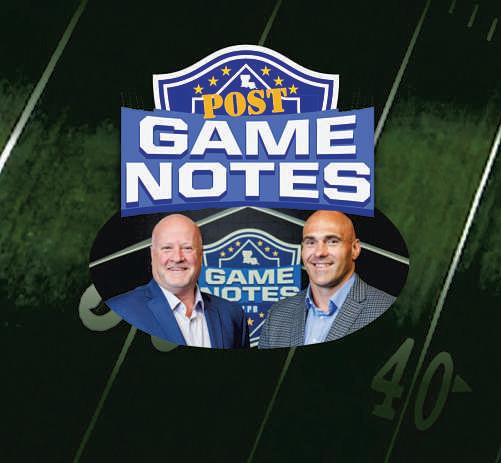


struck out 13 while pitching six innings of one-run ball. The Tigers went 1for 9with runners in scoring positionand left 10 on base.
“Wehad an incredible game today that, unfortunately, somebody hadtolose, andthatsomebody was us, and it hurts,” Detroit manager A.J. Hinch said.
Kerry Carpenter put Detroit in front whenhehit atwo-run homer off Gabe Speier in the sixth inning. Carpenter had four hitsand walked twice, becoming the first player to reach five times and hit ahome run in awinnertake-all postseason gamesince BabeRuthin1926, according to STATS.
The Marinerstied it at 2-2 on LeoRivas’ pinch-hit single off Tyler Holton in theseventh. Rivas celebrated his 28th birthday with his first postseason hit.
“He was up to the task tonight,” Wilson said. “Itwas ahuge hit.”
The Mariners hada runner on second with no outs in the 10th, 12th and 13th inning and came up empty each time.
College football
Friday’s games EAST Army24, Charlotte 7 CCSU 24, Robert Morris 12 Clemson 41, Boston College 10 Dartmouth 17, Yale 16 Delaware St. 70, S. Connecticut23 Duquesne 52, St. Francis (Pa.) 7 Lafayette 62, Bucknell 24 Lehigh 31, Columbia 7 Maine 20, Merrimack13 Marshall 48, Old Dominion 24 Mercer 38, Princeton14 Mercyhurst 19, Wagner7 Monmouth (NJ) 42, Towson 31 Morgan St. 44, Va.Lynchburg6 Navy 32, Temple 31 Nebraska34, Maryland 31 New Haven69, W. Connecticut0 Northwestern 22, Penn St. 21 Rhode Island 38, NewHampshire27 Richmond 24, Colgate 19 Sacred Heart 32, Howard 14 SOUTH Abilene Christian 30, West Georgia13 Alabama A&M 45, MVSU 25 Alcorn St. 42, Lincoln (CA) Oaklanders 0 Appalachian St.41, GeorgiaSt. 20 Bethune-Cookman45, Southern U. 14 Campbell 38, Hampton 21 Cent. Arkansas 49, North Alabama 21 Coastal Carolina23, Louisiana-Monroe 8 E. Kentucky 34, Austin Peay 20 ETSU 45, VMI10 FAU53, UAB33 Georgia Tech 35, VirginiaTech 20 IllinoisSt. 46, Murray St. 32 Jackson St. 38, Alabama St. 34 James Madison24, Louisiana-Lafayette 14 LSU 20, SouthCarolina10 Mississippi 24, Washington St. 21 NC Central 45, Florida A&M 7 Pittsburgh 34, Florida St. 31 SC State 22, NC A&T 16 St. Thomas (Minn.) 57, Davidson13 Stetson 21, Morehead St. 14 Tennessee 34, Arkansas 31 Tennessee Tech 27, Charleston Southern 13 TexasSouthern 21, GramblingSt. 20 The Citadel 38, Valdosta St. 14 UT Martin32, W. Illinois31 Villanova 29, Elon21 W. Carolina 52, Furman 7 Wofford31, NorfolkSt. 14 MIDWEST Alabama 27, Missouri 24 Bowling Green 28, Toledo 23 Cincinnati 20, UCF 11 Dayton 41, Valparaiso 10 E. Michigan 16, N. Illinois10 Gardner-Webb 21, E. Illinois10 Iowa 37, Wisconsin 0 Kansas St. 41,
14. (12) Ryan Blaney, Ford,182.482. 15. (1)RossChastain, Chevrolet, 182.469. 16. (60) Ryan Preece, Ford,182.272. 17. (99) Daniel Suárez, Chevrolet, 182.156. 18. (71) Michael McDowell, Chevrolet 182.143. 19. (43) Erik Jones, Toyota, 181.947. 20. (16) AJ Allmendinger, Chevrolet, 181.879. 21. (41) Cole Custer, Ford,181.861. 22. (77) Carson Hocevar, Chevrolet, 181.800. 23. (38) Zane Smith, Ford,181.696. 24. (47) Ricky StenhouseJr, Chevrolet,181.421. 25. (3)AustinDillon, Chevrolet, 181.336. 26. (42) John H. Nemechek,Toyota, 180.953. 27. (7)JustinHaley,Chevrolet,180.929. 28. (4)Noah Gragson, Ford,180.832. 29. (21) Josh Berry,Ford, 180.548. 30. (34) Todd Gilliland, Ford,179.868. 31. (2)AustinCindric, Ford,179.468. 32. (8)Kyle Busch,Chevrolet, 179.462.






games andhas allowed just one sack in 199pass-rush snaps, according to Pro Football Focus.
Banks is coming off his best game of the season. Going against elite Giants edge rushers Abdul Carter and Brian Burns, he allowed zero sacks and just onepressure in 32 pass-rush snaps.It wasthe kind of performance the Saints were hoping they’d get from Banks when they selected him withthe No. 9overall pick in the 2025 draft
“He’sjust steady,” Saintscoach Kellen Moore said. “He’squiet,and he does his work. He’svery detailed in what he does.
Ijust thought he had sometremendous sets in pass-rush situations in this past game. It was just really clean.” For what it’sworth, Banks’ block-
of thetop edgerushers in the league, including Carter, Burns, Nick Bosa and Joey Bosa. For the most part, he’sbeen left on an island to block them.Banks hashad one-on-one blocking assignments 72%ofthe time, more than any tackle in theleague so far,according to PFF
“He has some things you can’tcoach, and he plays to his strengths really well,” veteran guard CesarRuizsaid of the 6-foot-5, 315-pound Banks. “I just love watching him excel right now.”
Banks said he is looking forward to seeing fellowrookie left tackle Campbell this weekendwhenthe Saints entertain the Patriots. Campbell, the former LSU All-American,and Banks traveled similar paths to the NFL.Both were rankedamong the top tackle prospects
tackle
sive) to see as arookie. He and Taliese Fuaga are very impressive as ayoung tackle tandem.”
Some fans criticized the Saints for taking Banks so highly in the draft. Despite winning the Outland and Lombardi trophies as the top offensive lineman in college football, he lacked name recognition for many casual fans. After seeing the Saints select offensive or defensive linemeninRounds

Continued from page1C
But those who bothered to look could have discoveredaplayer who sent opponents flying off the ground with violent hits, and aplayer who handled avarietyofroles and had thecapacity to thrive in each of them
They could have discovered Jonas Sanker. No one on the Saints unexpectedly hasbeen asked to handle more thanthe 22-year-old rookie.When starter Julian Blackmonwent down with aseason-ending shoulder injuryafter Week 1, New Orleans turned to thehard-hitting Sanker.And ahead of Sunday’sgame against the New England Patriots, no one —at least on thedefense —has exceeded expectations more than Sanker
The Saints aren’tjust askingSanker to make the kind of thudding blowsthatwowedStaley all those months ago. They’ve tasked the Virginia producttobethe lastlineofdefense,a ball-hawking, back-endsafetywho canread and react to what opposingoffensesare doing. He has become so important to the defense that coaches no longer use Sanker on special teams —anaspect of Sanker’scollege tape that Staley also found “unbelievable.”
His ascension is areminder that good players can come from anywhere, Staley said.Even if theyhavetoplayeight-manfootball first
“Probably in the recruiting process, (eightman football) might hurt you,” Saints defensive pass-game coordinator Terry Josephsaid, “but in the long run, it probably helpsyou out.” Areasontostay
When he coached Sanker at Covenant, Seth Wilson insistsopposing coacheswould go to the referees at halftime of lopsided games and threaten to have their teams walk out if Covenant didn’tsit Sanker and his brother Nic for the rest of the game. Wilsonsaid he offeredacompromise.
“I’m like, ‘All right, I’m going to take them off offense,but I’m goingtoput them on defense, and you guys are notgoingtoget anotheryard for the rest of the game,’ ”Wilson said.
In high school,Sanker primarily played quarterback and linebacker.Hewas agifted athlete, someone who could jump over an oncoming tackler or sprint downhill to crushanoncoming ball carrier.Sanker’srecruiting finally pickedupafter his junior season, whichproved to be fortunatesince the pandemiccanceled his senior season. He enjoyed astandoutjunior campaign that included one of his hits landing on USA Today’s top high schoolplays of the week On that play,Sanker’ssudden impactlifted his opponent off of his feet and flat onto his back “I enjoytackling,” Sankersaid. “I enjoy those big moments. That’sjust how I’ve always been.” Joseph has atheory.Withthe extra spacingeight-man football provides,Sanker gota chance to hone his tackling by having the runway to hit ahigher rate of speed. It also helped himbecome comfortable covering in the open field —eventhoughSankerdidn’tplay safety then. Sanker did not intentionally play eight-man football. Covenant was forced to downsize itsprogramduringSanker’ssophomore and junior years because the school didn’thave enough students willing to field awhole football team. The switch was “the only way to save the sportatour school,” Wilson said. At times, Wilson wondered whetherSanker would have beenbetter off transferring to a Washington, D.C., powerhouse such as Gonzaga. He even broached thetopic with Sanker’s father His father,George, wasthe headmaster at Covenant. As one of seven children, Jonas didn’twant to leave his other siblings.
It was apreview of what was to come. When he finallyreceivedinterestfromcolleges, Sanker initially committed to BostonCollege. He flipped hisrecruitment to Virginia after his father was diagnosed withearly-onset Alzheimer’s.
Sanker didn’t— more like wouldn’t—leave home. Not when his youngersiblingsand mother needed him.
“Jonaswas here, andhewas just like, ‘I will be thatguy,’ ”Wilsonsaid. “‘Iwillbethat person with car rides in themorning to school. I will helpget them to practice. I’ll help do all that. Iwill come help take care of dad.’”
Wasthat alot to place on akid’sshoulders?
“Yeah, buthewas built for it,”Wilson said “The whole family is.” ‘The Messiah’
Curome Cox liked to tease Sankerwhen he coached him at Virginia.
Thesafety often would shower hiscoaches with feedback and ask for certain changes. So Cox, thedefensivebacks coachand defensive pass-game coordinator,coined anickname for Sanker.
“Weused to joke around and call him ‘The Messiah,’ just because in Jonas’ mind —rightfully so —hewas thechosenone to come and save UVAfootball,” Cox said.
There was a“glow” that Sanker had in meetings, andCox said he alwaystoldSankerhe needed to takethat energy onto the field and dominate.
The message took hold in Sanker’sfinalseason. In an upset over No. 23 Pittsburgh, Sanker wrecked thegame with an interception and fieldgoalblockoff theedge. He routinely pinnedPittsburgh in challenging field position as agunner in punt coverage.
“Thatwas thegrowth and thejokeofThe Messiah really coming to fruition,” Cox said.
At Virginia, theCavaliers expanded Sanker’s game. As well as he tackled in high school, the Virginia coaches refined his technique further in hopes of keeping apattern of shoulder injuries from bothering him.
Forme, it’s like, I’m able to have alittle bit of success,but at thesame time, I’m also able to see, ‘Wow,I have so muchmore to grow.’ Ihaveso manythings that Iwant to work on and continue to getbetter at.”
JONAS SANKER, Saints safety
They also made him asafety —BostonCollege recruited Sanker as alinebacker,and the 22-year-old said he hadother offers to play quarterback, running back and cornerback.
“I don’tthink Iwould have been an NFLplayer” if not for the position change, Sanker said. “Safetyisthe right fit for me.”
It’salso the right fit for the Saints. Through thefirst month of theseason, Sanker hashad severalbig moments.Against theBuffalo Bills,hecame flying in to pick off MVPquarterback Josh Allen. Aweek later against the New York Giants, Sanker recovered afumble that Demario Davis forced.
The rookie also is making less noticeable plays. The Giants, for instance, testedSanker with adeep shot nearthe sideline, but he held hisown in coveragebynoticing the waythe receiver was looking for the ball.
Even on that sequence, Sanker sees ways to improve.Ifhehadn’tbeen stuck as close to the wideout, he said, he could have had achance to intercept the pass.
“For me, it’slike, I’m able to have alittle bit of success, butatthe same time, I’m also able to see, ‘Wow,Ihave so much moretogrow,’ ” Sanker said. “I have so manythings thatI want to work on and continue to get better at “Itisencouraging to see theceiling Ihave but I’m really ready togrow and get better.”
His coaches would agree withthat assessment.IfBlackmon wasa “10out of 10” as a running mate across from starter Justin Reid, Joseph estimates Sanker is an “8.5” when it comes to complementingthe veteran. The coaching staff loved the way Reid could wreak havoc in the boxwhile trusting Blackmon to playdeep.
Butthe Saintsare encouraged by theprogress Sanker already has made.
“For us, it was ano-brainer when he was still on the board at our pick,”Joseph said.
Email Matthew Paras at matt.paras@theadvocate.com


JEFF DUNCAN
SAINTS 24,PATRIOTS23: TheSaints catchthe Patriots at theright time —in thewakeofanemotional Sunday night upsetovera division rival. Nowthe Patriots travel to play an unheralded andunfamiliar opponent.The Saints won’tget five takeawaysinthisone,but they won’tneedthem.
LUKE JOHNSON
PATRIOTS 26,SAINTS20: Thereare some compellingreasons to pick the Saints forthe second straightweek, butultimatelythisone feelslikeit will come down to quarterbackplay. NewEngland QB DrakeMayeisone of theNFL’s bright youngstars,and that should be thedifferenceinthis game
PATRIOTS 28,SAINTS21: ThePatriots have said allthe rightthingsabout taking theSaintsseriously this week, andIdon’t expect them to have a letdownevenafter theirhugewin over theBuffalo Bills. ButI likethe Saints to hang around in this onebeforeDrake Maye proves to be toomuch.
PATRIOTS 20,SAINTS17: I’ve changedmymineonthisone since theseasonbegan.There is achance thePatriotswill
Staff report
LSU’s win over South Carolina doubled as Brian Kelly’s 200th career victory as an FBS coach.
Now, including Kelly, only 20 FBS coaches have led their teams to that many wins. Just two of those coaches are active: Kelly and longtime Iowa coach Kirk Ferentz, who guided the Hawkeyes to victory No 208 of his 27-year tenure on Saturday night against Wisconsin.
Kelly’s FBS win total does include the 21 victories the NCAA vacated over academic violations found at Notre Dame in 2012 and 2013. It does not include, however the wins that Kelly picked up during his tenure at Division II Grand Valley State. From 1991-2003, he led that program to a 118-35-2 record and a pair of national titles.
Overall, Kelly is now 200-74 across his FBS coaching career

Continued from page 1C
“Tonight, we found a way to win even though we had some mistakes out there that could, at some time, be catastrophic, and we have to eliminate them,” Kelly said after the game. “But the bottom line is, I love the way the kids competed today.”
LSU pressured and harassed South Carolina quarterback and potential first-round pick LaNorris
Sellers from the first snap of the night until the last, held the Gamecocks to 317 yards and forced a pair of turnovers.
The defense also earned a crucial turnover on downs with 5:43 left in the fourth quarter when senior cornerback Mansoor Delane forced an incompletion on fourth down, handing the ball back to the Tigers with a seven-point lead
The unit’s performance was a continuation of what’s been an exceptional first half of the season. Its offense, however, improved in a few key areas but still struggled to take advantage of the elite play it was getting from the defense.
LSU ran for a season-high 166 yards. Nussmeier appeared healthier and drove the ball with more force downfield. Sophomore Trey’Dez Green had a career-best night with eight catches for 119 yards and a touchdown.
From a down-to-down perspective, it was arguably the Tigers’ best performance on offense yet
“It’s a better sign. There’s no doubt,” Kelly said. “Again, I think if we were much more efficient in the red zone, certainly if we took care of the football, there were some things that we just have to clean up that are very fixable. And if we fix those things, this offense can play to the level of its defense.”
Those big mistakes still prevented the Tigers from earning a more convincing victory, and no error
He won 19 games in three seasons at Central Michigan, 34 in three full years at Cincinnati, 113 in 12 seasons with the Fighting Irish and 34 in three-plus years at LSU.
The Tigers have so far won at least nine games in each season of Kelly’s tenure, including all three bowl games they’ve played in. But they’ve yet to reach the College Football Playoff. Win No. 200 for Kelly preserved LSU’s chances of achieving that goal this year
Another empty opening
LSU continued an unfortunate trend of starting slow
The Tigers went three-andout on their opening possession against South Carolina, meaning they’ve come up empty the first time they’ve had the ball in all six games this season.
In fact, the problem is actually getting worse. This was the fourth straight game LSU opened with a three-and-out, and they’ve totaled just 20 yards on 12 plays on the opening possession in those games.
The Tigers’ best opening salvo came against Clemson, when they drove 36 yards (24 on Caden Durham’s first-play run) and reached the opposing 39-yard line before punting.
They achieved one first down against Louisiana Tech the next week, but Garrett Nussmeier threw an interception on the following play
cost them more than Nussmeier’s second interception of the night.
LSU had marched to the South Carolina 10 with 1:33 left in the third quarter The Tigers led 1710 after their previous drive, and sophomore running back Ju’Juan Johnson’s 56-yard carry had placed the offense in prime position to take a two-score lead.
But for the second time Saturday LSU turned the ball over inside South Carolina’s 10. Nussmeier, on a run-pass option, kept the ball and attempted a pass to Green that was intercepted by safety Peyton Williams at the goal line.
“It’s an RPO,” Kelly said, “and he’s responsible for the safety who picked it off.”
But the second half for the LSU offense still was better than the first. The Tigers gained 229 second-half yards and salted the game away with a 10-play, 64-yard drive that resulted in a 22-yard field goal from fifth-year senior Damian Ramos.
Nussmeier completed three throws that went for at least 11 yards on the drive, including a 24-yard reception to Green that placed LSU at the South Carolina 1. Green’s big night came despite him saying after the game that his right knee, which he injured in Week 2 against Louisiana Tech, is only 80% healthy.
“I came into the game and was kind of hesitant about my knee and stuff,” Green said. “But once I got that first catch, I was a go then.”
The Tigers had a chance to put the game even further out of reach, but Nussmeier fumbled the ball on a second-down quarterback sneak at the 3-yard line and sophomore running back Caden Durham lost 2 yards on the next play to force the field goal that stretched the lead to 10.
LSU had the ball at the goal line three times on Saturday but came away with just three points.
“Those things are catastrophic, so we’ve got to clean those up,”

Opening drives against Florida, Southeastern and Ole Miss were all three-and-outs.
The last time the Tigers actually scored on their opening possession was in the Texas Bowl against Baylor to end last season. Nussmeier completed a 10yard touchdown pass to Trey’Dez Green to cap a 12-play, 68-yard TD drive right after the opening kickoff.
Anderson update
LSU leading receiver Aaron Anderson announced before the game on Instagram that he wouldn’t play against the Gamecocks.
“Thank you everyone who told me good luck today,” Anderson posted, “but (I) will not be playing today.”
Anderson was listed as questionable on Friday’s availability report. Kelly has said that the redshirt junior, who exited LSU’s Sept. 27 loss to Ole Miss with an elbow strain, is also battling toe and knee injuries. On Thursday,
Kelly said Anderson was “day to day.” Anderson, who has 23 catches for 305 yards this season, was in uniform for pregame warmups but was in street clothes for kickoff.
Butler leaves game
Defensive end Jimari Butler left the game in the first half with what the LSU radio broadcast called an ankle injury and did not return.
The Tigers are already without Gabriel Reliford at the position after he tore his rotator cuff Sept. 20 against Southeastern.
Another defensive end, Patrick Payton, also briefly entered the injury tent in the first half, but he returned to the game.
Moreau honored
For three standout seasons, he donned the purple and gold.
For half a century afterward, he was among those telling LSU fans what happened every Saturday night on the Tiger Stadium turf.

Kelly said. “If we clean those up, we’re moving in the right direction.”
LSU constructed a crucial touchdown drive on its opening possession of the third quarter. After South Carolina tied the score at 10-10 with a 47-yard field goal to open the second half, LSU drove into South Carolina territory on the ensuing drive on the back of two completions to Green.
Nussmeier then connected with redshirt sophomore wideout Kyle Parker streaking across the middle of the field for a 43-yard score. The touchdown handed the Tigers a 17-10 advantage with 6:38 left in the third quarter It was another high point in an
uneven performance for Nussmeier, who finished completing 20 of 33 passes for 254 yards and two touchdowns.
“He’s healthy now and feeling good,” Kelly said. “He’s got a little bit of an ankle (issue). We’ll see how that goes. But I think the better days are ahead for him.”
LSU took the first lead of the night thanks to its defense South Carolina fumbled its first snap from scrimmage, and fifth-year senior edge rusher Patrick Payton recovered the loose ball at the Gamecocks’ 17-yard line.
The Tigers went three-and-out after the turnover, but Ramos hit a 28-yard field goal to hand them a 3-0 lead.
This week, Doug Moreau took to the field again as LSU honored its former All-American and longtime broadcaster during the first quarter Saturday Athletic director Scott Woodward and other LSU officials presented Moreau with a framed replica of his No. 80 jersey with his wife, Elaine, and other family members standing alongside him. Moreau played tight end and kicker from 1962-65, then spent 52 years as part of the LSU football radio and TV broadcasts, a run that ended last season. After his LSU playing career, Moreau played for the Miami Dolphins from 1966-69 and was a Baton Rouge judge and district attorney from 1978-2009 But he is best known as an analyst for the LSU radio network and TigerVision, the school’s former in-house pay-per-view network. Jacob Hester replaced Moreau as radio color analyst last season on a temporary basis and full-time starting this season.
Despite the early advantage, LSU gained just 12 yards on its opening two drives. Slow starts on offense have been the norm for the Tigers this year as they’ve yet to score on an opening drive.
LSU eventually picked up its initial first down on its next drive, marching 71 yards to the South Carolina (3-3) goal line before Johnson fumbled the ball away on the 13th play of the drive at the 1.
The turnover proved to be an extremely costly one. Three plays later, South Carolina capitalized with a 72-yard touchdown run from running back Matt Fuller to take a 7-3 lead.
It was LSU’s only major defensive error in the first half, and the longest play from scrimmage LSU has surrendered since Sellers’ 75yard touchdown run against the Tigers last season.
“We’ve got to do some things better on defense as well,” Kelly said. “Some coverage things, some (run) fits.”
After the touchdown, the LSU defense allowed just 60 yards for the rest of the first half. The Tigers were particularly effective in their pursuit of Sellers, consistently pressuring the quarterback despite sacking him just twice in the opening half.
“Overall, I think our defense did a great job of just pursuing relentlessly,” senior edge rusher Jack Pyburn said. “Guys were flying around all over the place, and we had a lot of snaps on defense overall.”
Their effort allowed the LSU offense to potentially grow its 10-7 lead. But after taking the lead back on a 6-yard touchdown pass from Nussmeier to Green, LSU gained just 110 yards for the rest of the half, and Nussmeier threw an interception in South Carolina territory toward the end of the half.
LSU heads to Nashville, Tennessee, next Saturday to take on Vanderbilt. The game will be played at 11 a.m. on ABC.
NUSSMEIERUNDER THEMICROSCOPE
1
After throwing multiple wounded ducksatOle Miss and reportedly not throwing the ballduring open-date practices, all eyes were on LSU quarterback Garrett Nussmeier to see howhelooked Saturday night against SouthCarolina. Despite limpingoff the field with acouple of hard hits on his ankle,hedid not appeartobelaboring on most of his throws. But he did kill twoLSU driveswith interceptions, one at the Gamecocks’ 1,that kept South Carolina in contention.
SCRUTINY FORTHE RUNNINGGAME
The other bigquestion entering the game:WouldLSU be committed to running the ball and howeffective would theTigers be? It wasclearfrom the start LSU putanemphasisonrunning more. Nussmeier had 21 passattempts at halftimeand LSU had 18 running plays Ju’Juan Johnson’sfumble at the South Carolina goal line for atouchback wasa glaring error, butthe Tigers didmanagea season-high 166 yards rushingon30attempts.Nussmeier took aknee twice at the endofthe game.
ANDTHE DEFENSE?
3
The Tigers were mostly in bend-but-don’t-break modeexcept for ahugebust in the first quarter, when South Carolina running back Matt Fuller brokecontain on a72-yard touchdown run. But the Tigers also kept Gamecocks quarterback LaNorris Sellers under constant pressure, forced him into twoturnovers, two intentional grounding penalties and held the rope until the LSU offense could getits act together witha big Nussmeierto-Kyle Parker touchdown pass in the third quarter
Tigers QB looksmore likeold self in victory
BY REEDDARCEY Staff writer
Garrett Nussmeier took his fair share of punishingshots. There were times when the South Carolina defensive front collapsed his pocket and drovehim into theturf, testing thestructural integrity of asore torso behind so many of the LSU offense’sproblems.
But each time, Nussmeier picked himself up. He wore the effectsofthose hits on Saturday,but only momentarily.They didn’tlinger into subsequent drives of a 20-10 win over the Gamecocks.
Instead, other factors derailed the LSU offense instead of amysterious injury to itsquarterback. Nussmeier looked sharp enough to give the Tigers two touchdown drives, which were all they needed to win
“He was alot moreaggressive,”coach Brian Kelly said. “I thought he hadthat kind of demeanor that you’re looking for in your quarterback.
“Wewant to clean up some things, obviously —the mishandled snaps, and we can’tturn the ball over down there (red zone). But look, he’s competing his tail off for us, and we’renot perfect. We’re aworkinprogress. We’ll have to be better next week.”
The last timeLSU tookthe field, Nussmeier delivered ashaky performance in acostly losstoOle Miss Kelly said then thathis quarterback was healthy.But it wasclear something was bothering the second-year starter,and the likely culprit was the abdominal strain that hefirst suffered during preseason camp.
Nussmeier wasn’tstepping into his throws, and hewasn’tlooking downfield. The few times he did aim deep, his passes wobbled offhis hand,then fluttered incomplete.
Continued from page1C
It was adifficult showingto wrap your mind around for LSU. Every good thing the Tigers needed to do had its own grotesquelooking, fit-for-the-Halloweenseason counterpoint.
Could Garrett Nussmeier,last seen lunging and struggling to make deep passes two weeksago in aloss at Ole Miss,look healthier throwing the ball?According to Kelly,Nuss basicallyspent the week after the Ole Miss loss boxed up like an Amazon package on the Kelly family’sfront porch, not throwing the ball other than in some virtual reality-type lab inside the LSU football palace. Nussmeier did look better physically,nodoubt. He didn’t labor with acore injury nor struggle to deliver the ball, as he completed 20 of 33 for 254 yards andtwo touchdowns. And yet,Nussmeier threw two egregious interceptions (are there anyotherkind?), with bad footwork leading him to airmail apick in the first half andabad decision resulting in an interception at the South Carolina 1inthe second half. The other big question: Could,



During LSU’sopen date, Nussmeier didn’tthrow footballs —and it looks like that extra rest served him well. Against theGamecocks, thefifth-year senior made afew key mistakes, but he still operated more like he did in theTigers’ convincingwin over Southeastern Louisianathanhedid in their frustrating loss to theRebels.
Kelly said Saturday that he suspected
Nussmeier would look healthieragainst South Carolina. In practice, he said, LSU keepsdata on his throwsusing GPS tracking devices.
“His numbers were up,” Kelly said, “sowefelt really good about that.”
Nussmeier threw multiple touchdown passes on Saturday,doing so against an FBS opponent for thefirst timethis season. He finished with20completions
on 33 attempts for254 yards, twotouchdowns and two interceptions.
ButNussmeier toooften gotinhis own way. He madebad decisions and missed open receivers. His first interception should’ve been acompletion for afirst down, but he sailed apass high over Kyle Parker’shead and into the waiting armsofaSouth Carolina defender instead.Nussmeier’ssecondinterception should’ve been arun up the middle, but he decided instead to pull the ball away from Caden Durham and try to squeeze apass between two defenders. Nussmeier made up for those mistakes.
Mostofhis passes were on time and on target— like the onethathefired to Parker over the middle for ago-ahead, third-quarter touchdown catch and run of 43 yards.
To complete his first touchdown toss, Nussmeier fit aperfectlythrown pass into the hands of tight endTrey’Dez Green. Later in the half,hestepped into abeautiful downfieldthrowtoward an open Chris Hilton, who dropped awouldbe completion of morethan 40 yards. Nussmeier even used his legs. In the third quarter,heweaved through the South Carolina defense to pick up 21 yards on ascramble.
In Week 5, it didn’tlook like Nussmeier was healthy enough to make those kinds of plays. Now he is —a positive development for an offense that’strying to leave its earlyseason struggles behind and string together wins overdifficultSEC opponents. Next week, theTigers will hit the road to face Vanderbilt,a team that defeated South Carolina 31-7 in Week 3.
There’sstill room forthe LSU offense —and especially Nussmeier —toimprove. But at least he’shealthy,for now Even after he took afew big hits.
“He’sgoing to get better,” Kelly said. “He’shealthy nowand feeling good. He’s got alittle bit of an ankle (injury) now. We’llsee howthatgoes, butI thinkthe better days are ahead forhim.”
and would,LSU commit to running theball? Check marks all around.The Tigers had anearly 50-50 run-pass balance that included 30 runsfor aseason-high 166 yards, averaging asolid 5.5 yardsper carry.And yet,LSU had afumbleintothe endzone for a touchback from the1byJu’Juan Johnson andhad to settle for a Damian Ramos field goal after reaching the Gamecocks’ 1when theTigers gotpushed back to the 5after three plays.
“I was pleased with somethings we hadn’tbeen doing,” Kelly said. “Weran theball, which we hadn’tbeen doing. But you can’t getdown to the 1three times and come away with three points.”
Despite piling up 420 yards to 317 for SouthCarolina, LSU amazingly still hasn’tcracked the 20-pointbarrier against aPower Four conferenceopponent.LSU had 17atClemson, 20 against Florida including apick-six, 19 at Ole Miss and now 20 vs. South Carolina. That’sthe first time that’shappened since LSU failed to break20against their first eight power-conference foes back in 1993.

Pigs eventuallyflew for the Tigers that season when that woefulLSU team stunned reigning national champion Alabama in Tuscaloosa. Butfor these Tigers, now 5-1 and 2-1 in the Southeastern Conference, that’swhere they need thecomparisons to 1993 to end posthaste. Even theLSU defense had its own “catastrophic” play.After Johnson’sfumble intothe end zone, SouthCarolina running back MattFuller broke out on a 72-yard touchdown run, theonly
time theGamecocks would reach theend zoneall night. The Gamecocks had plenty of their own issues. Quarterback LaNorris Sellers, upon whom virtually allofSouth Carolina’s hopes for an upset rested, fumbled on his team’s first offensive snap at the 17 to set up an LSU field goal, though the Tigers could only manage to get to the South


Carolina 10. Sellers also threw an interception and washarassed by LSU’s gritty bend-but-rarelybreak defense into twogrounding penalties. Sellers was just 15 of 27 for124 yards and wasonly able to target his top receiver,Nyck Harbor,three times. He finished with just tworeceptions for36yards, certainly atestament to defensive coordinator Blake Baker’smuch improved unit. In the end, it wasawin forLSU In asport that is looking moreand morelike the NFLall of the time, that counts foralot. Certainly South Carolina, which dropped to ascarcely believable 2-21-1 all-time against LSU, would love to be going homewith an “ugly” upset victory But forthe way Nussmeier looked physically,for the waythe Tigers ran the ball and played defense, acatastrophe-filled gamelike this isn’tgoing to be good enough going forward. LSU had to have this win, because it goes on the road to face aranked Vanderbilt team forthe first time since 1947. Then the Tigers come hometoclose out October against aTexas A&M team currently ranked No. 5nationally Bruce Willis might not be there to push the button and save LSU next time.


Coach Terrence Graves made another change at quarterback. He reinserted Cam’Ron McCoy after Ashton Strother commanded the offense the previous game. While the move was likely decided over two weeks worth of practices, the Jaguars should’ve given Strother another chance because he’s proven to be a more reliable passer McCoy struggled following a promising start highlighted by a 66yard touchdown toss Several three-and-outs later, Strother entered at the end of the third quarter and quickly moved the Jaguars to a touchdown.
PENALTY PROBLEMS PERSIST
2
Southern’s goal was to clean up its execution on both sides of the ball after having too many penalties against Jackson State and for much of the season.After working on these self-inflicted errors during the open date and the days leading up the game, the Jaguars continued to make costly mistakes against Bethune-Cookman. Plenty of players were vulnerable to undisciplined play, including veterans.The Jaguars had eight penalties for 45 yards in the first half alone and finished with nine penalties for 65 yards in the game.
FRAGILE DEFENSE
3
The strong defense that carried Southern to the SWAC championship game last year has been nowhere close to that level.The unit can’t get three-and-outs and even struggles getting off the field on third-and-longs.The Jaguars knew they were facing a team with a talented quarterback (Cam’Ron Ransom) and a speedy wide receiver (Maleek Huggins) who leads the SWAC in yards receiving Despite ample time to prepare after the open date, the defense wasn’t up to the task of stopping the run or the pass while allowing 498 total yards

Backup Strother leads TD in 4th period, but was too little, too late
BY TOYLOY BROWN III
Staff writer
DAYTONA BEACH, Fla. With 1:44 remaining in the third quarter on Saturday afternoon, Southern had seen enough from quarterback Cam’Ron McCoy
The Jackson State transfer was replaced by Ashton Strother who was the starter in Southern’s most recent game against Jackson State. Strother, a transfer from Cuhoma Community College, promptly threw an accurate 14-yard pass to tight end Dupree Fuller A few plays later the junior found backup tight end Jermain Minor for 20 yards to reach the BethuneCookman 34-yard line.
The methodical 80-yard drive filled with some tight-window passes concluded with a 15-yard touchdown pass to to wide receiver Malachi Jackson in the back of the end zone. That was the final touchdown in the Jaguars’ 45-14 loss to Bethune-Cookman on Saturday at Daytona Stadium.
The success Strother had was reminiscent of how he played against FBS Fresno State when he was inserted into that game and helped the Jaguars score their only TD in a 56-7 loss. That begs the question of why Strother, who finished 9-of-13 passing for 101 yards on Saturday, didn’t start the game.
Coach Terrence Graves said the decision to give McCoy his fourth start of the season was made by co-offensive coordinator and play-caller Fred McNair and the offensive staff.
BY TOYLOY BROWN III
Staff writer
DAYTONA BEACH, Fla.
— While coach Terrence
Graves is not one to put added pressure on his team, one of Southern’s veteran players was willing to call Saturday afternoon’s contest against Bethune-Cookman a “must-win game.” Southern entered the game with its worst record in 25 years and faced the possibility of starting SWAC play 0-2 The reigning SWAC West champions seemingly had all the motivation to begin a turnaround.
Instead, they struggled mightily in a 45-14 loss at Daytona Stadium, losing to the Wildcats for the first time in program history after having won the previous seven
“We started off great and then, you know, went back to the self-inflicting penalties and got behind the chains,” Graves said. “Then we were doing some three-and-outs offensively and then they started struggling defensively.”
BCU (3-4, 2-1 SWAC) had a 41:41-18:19 edge in time of possession. The Wildcats also had 32 first downs to 12 for Southern (1-5, 0-2)
“We were on the field so much (on defense), we started making mistakes,” Graves said of his team, which gave up 498 total yards. “So when it started snowballing, it was just one of those times.” Graves said the team was confident in its preparation for the game.
“Those guys were ready to go,” Graves said. “We had great practices. These guys knew what was going on.
“At some point, you just got to go out there and execute and make the plays that you’re supposed to make You know guys wide open and drop balls, that’s just pressing, trying to make plays. And I thought that we still fought, you know, we continue to fight.” Graves started Cam’Ron McCoy at quarterback. McCoy who had started three of the team’s first four games, was replaced by Ashton Strother in Southern’s previous game, a 3813 loss to Jackson State before the open date.
The insertion of McCoy appeared to be the right move initially After a false start on the first offensive play, the Jaguars struck quickly. McCoy delivered an on-time pass to Darren Morris on a slant route The junior ran away from the lone trailing defensive back and took the ball 66 yards to the end zone for his second touchdown catch of the season.
Bethune-Cookman then scored on back-toback touchdowns led by quarterback Cam’Ron Ransom, who finished 27 of 36 passing for 254 yards and two TDs.
Ransom completed 21 of 27 passes for 165 yards in the first half and BCU had 119 yards on the ground.

Southern’s defense helped out the home team with a myriad of post-snap and pre-snap penalties.
Defensive back Elijah West, who finished with 12 tackles (eight solo), said the team’s biggest issue was its messy play.
“We got to be more disciplined as a team
That’s it,” West said.
Southern also had no answer for Wildcats wide receiver Maleek Huggins. The 5-foot-11, 180-pound senior got open consistently finishing with eight catches for 92 yards. Huggins got shaken up briefly in the second quarter after being tackled at the 1-yard line while trying to stretch out to the pylon.
He was helped off the field and later returned in the third quarter.
Meanwhile, Southern’s offense never found a rhythm as the McCoy-led offense only mustered two first downs in the first half BethuneCookman had 19 at the same time as it led 21-7 at halftime. Running back Trey Holly was used sparingly in the first half, getting four carries. Backup running back Mike Franklin didn’t play because of an injury, Graves said.
Holly finished with 14 carries for 71 yards.
Southern put Strother in the game with 1:44 left in the third quarter Similar to his first extended stretch of play at Fresno State, the junior injected life into the offense
On his first drive, he capped an 80-yard drive with a 15-yard touchdown pass to Malachi Jackson. Strother completed 9 of 13 passes for 101 yards and a TD.
“Coach McNair and those guys, they made the decision of who (they) want to start,” Graves said. “They felt like because of his skill set, he gave us the best chance for what they’re trying to do because those (Bethune-Cookman) guys are undersized and they’re fast on defense.
“So we wanted to match with what they were trying to do schematically and trying to take advantage of some things we saw in the passing game. And so that’s what we were trying to do. You know, you try to take advantage of the things that you see, and, you know, it’s only a weakness unless they can exploit it.”
The game plan was largely unsuccessful. Southern picked up only two first downs in the first half, and the only successful offensive moment it had until Strother played was an early 71-yard TD pass to Darren Morris who gained the vast majority of those yards after the catch. McCoy finished 5-of-13 passing for 101 yards.
The choice not to use Strother for most of the game had a major impact on the result. When he did get on the field, it was too late as Southern trailed 38-14 after his touchdown pass with 13:39 remaining.
Morris, who finished with three catches for 87 yards and a touchdown, gave Strother praise for doing his best in the situation he was placed in.
“It’s great having a confident quarterback back there and he’s doing everything, even though they put him in late,” Morris said. “He did everything that he could do to get us back in that game.”
Lagniappe
The last time Southern opened with a 1-5 record was in 1971. Southern’s unbeaten streak against BCU was snapped at seven games. When Southern and Bethune-Cookman met last year in Baton Rouge, Southern won 25-23 in five overtimes. Saturday’s game

The Louisiana Wildlifeand Fisheries Foundation is auctioning ablack bear hunt during December’sseason to raise moneyfor its projects supporting Department of Wildlife and Fisheries projects. The auction will continue through Thursday.
BY JOE MACALUSO
Contributing writer
Building on its fundraising efforts during Thursday’s “A Wild Night,” the Louisiana Wildlife and Fisheries Foundation is in the middle of an auction for achance to take ablack bear during the upcomingseason in December
The auction began Thursdayand willend at noon Thursday,Oct. 16. According to the LDWFF,proceeds from the auction will“directly support black bear researchand help LAWFF fund critical studies and conservation efforts of the Department of Wildlife and Fisheries.”
The foundation is billing thethree-day guided hunton oneofour state’s“premier hunting destinations” Palmetto Lodge —inBlack Bear Management Area4
The hunt was donated by a landowner who was drawn out in this year’sblack bear hunt lottery
The foundation also is hoping to raise funds for its projects with araffle of a Chevrolet Silverado.
Tickets are $20 and available on org/la-conservationraffle.
For more on the blackbear auction and the raffle, go to the foundation’swebsite: lawff.org.
S.T.A.R. setting
From 5:30 p.m.-9:30 p.m. Thursday at Live Oak at Cedar Lodge (6300 Jefferson Hwy.) in BatonRouge, the
winners of CCA Louisiana’s summerlong statewidetournamentand anglers’ rodeo will receive theircoveted prizesofrigged-outboats andbig-money tacklepackages for catching thetop fish in several categories.
It’salso the Baton Rouge chapter’sannualbanquet.
Redsnapper
This week might be your last chance to take red snapper after the latest (Sept.28) LA Creelestimateput the private recreationaltake at 852,823 pounds. That’s 95.3% of Louisiana’s894,955-pound annual allocation
Word from Wildlife and Fisheries fishery managers is aclosure is imminent when less than 5% of theannual allocation remains.
The weekending Sept. 28 showed theestimated one-week takewas 13,532 pounds
If the first week in October’sestimate reaches that number,it’slikely the season will close next week
It’s aboutline
Andrew Ragas spent lots of time writing this month on astory titled “When And Where To FishBraid, Mono &Fluorocarbon.”
It’sagood read from Courtland (available on cortlandline.com)and touches on most allaspects of howto choose the proper line for specific types of fishing.
Ragas touchedonmostall aspectsofline choice,especiallyconcentrating on how
important it is to knowwhich line to use, line strengthand where to use specific line.
“Andthe more you know aboutwhat line accomplishes, themoreprepared you’ll be to make educated decisions and addressing fishing conditions,” Ragas wrote.
Swampclosure
Recent heavy rains and strongeast winds sentwater high enough to close the Maurepas Swamp Wildlife Management Areatodeer hunters.Wildlifeand Fisheries staffwill monitor water levels andannouncea reopening of thedeerseason when thewater falls below 1.75 feet on the WMA’s flood gauge.
More on venison
Interesting, too, wasan email from Penn State’s extensionservice offering a“Venison 101: Processing and Preparation” course.
It’s alearn-as-you-go online course with a$29 fee that expands on last Sunday’sAdvocate Outdoors story about careneeded to take adeer from the field to your table.
It takes 31/2 hoursand “coverswildgamefood safety, butchering and preservation methods such as drying, freezing and canning. Experts will demonstrate how to make jerky and three venison entree recipes.”
The PennState extension’swebsiteisextension. psu.edu/venison-101-onlinecourses.
Topanglers wonboats, outboards, trailers &tackle packages. All entries in kayak,ladies-only,flyfishing &calcasieu calcuttaare speckled trout.

Speckled trout: East, Andrew Haase, 6.48 pounds; Southeast, Travis Dardenne, 6.32; Southwest, Michael Godley,6.45; West, MichaelFesco, 7.9. Cobia: Coleman Fox, 65.5. Redsnapper: Phi-Thai Nguyen, 28.36 Mangrove snapper: Ty James, 12.02. Sheepshead: East, Lindsey Stevens, 9.4; West, Kael Mayo,5.72. Yellowfin tuna: Brady Brown, 83.79.
Bank fishing: JustinFesco, 5.43. Calcasieu calcutta: Ross Byrley.5.44. Fly fishing: East, John Neyhard, 3.06; West,Brandon LeBoeuf, 2.15. Kayak: East, DannyCompagno, 5.22; Southeast, Emile Doumit, 2.74; Southwest,Zack Luke,5.75; West Douglas Menefee, 4.1. Ladies only: East, FayPersac, 4.99; West,Morgan Kaczynski, 5.5.
MONDAY
RED STICK FLYFISHERS
MEETING: 7p.m., Regional Branch Library,9200 Bluebonnet Blvd.,Baton Rouge. Open to the public. Email Brian Roberts: roberts. brian84@gmail.com Website: rsff.org
TUESDAY
LA. OYSTER TASK FORCE
MEETING: 10 a.m.,Lakefront Airport, 6001 Stars &Stripes Check outthe Outdoors calendar for fishing meetings and hunting schedules, New Orleans. LegislativeCommittee meeting, 9a.m same venue.
WEDNESDAY
FLIES &FLIGHTS: 7p.m Rally
Cap Brewing, 11212 Pennywood Ave.,Baton Rouge. Fly tying. Open to public. Spare tools, materials for novices. Email Chris Williams: thefatfingeredflytyer@gmail.com
THURSDAY
S.T.A.R./CCABATON ROUGE
BANQUET: 5:30 p.m.,Live Oak at Cedar Lodge, 6300 Jefferson Hwy Baton Rouge. Prizes from summer-long fishing event, raffles, silent/ liveauctions. Call Nolan Reynerson (225) 952-9200. Email: SAM@ccalouisiana.com
ACADIANA FLYRODDERS
PROGRAM: 6p.m Pack & Paddle, 601 E. Pinhook,Lafayette. Open to public. Email
DarinLee: cbrsandcdc@ gmail.com. Website: acadianaflyrodders.org
HUNTINGSEASONS
DEER/ARCHERY: Through Oct 15, State Deer Areas 5, 6&9, bucks only; Oct.16-Feb. 15, either-sex takeallowed..
DEER/YOUTH-ONLY & HONORABLYDISCHARGED
VETERANS: Through Oct.17, State Deer Area 2.
DEER/PRIMITIVE FIREARMS: Through Oct.17, State Deer Areas 3, 7, 8&10.
DEER/PRIMITIVE FIREARMS: Oct. 18-24, State Deer Areas 2.
DOVES: South Zone,Oct. 18Nov. 30; NorthZone,through Nov. 16;
DEER/MODERN FIREARMS: Oct. 18-Nov.30, State Deer Areas 3, 7, 8&10.
DEER/YOUTH-ONLY & HONORABLYDISCHARGED
VETERANS: Oct. 25-31, State Deer Areas 1, 4, 5, 6&9
DEER/ARCHERY: Through Jan. 15, State Deer Areas 3, 7, 8& 10. Either-sex takeallowed.
DEER/ARCHERY: Through Jan. 31, State Deer Areas 1, 2&4
Either-sex takeallowed.
RABBITS &SQUIRRELS: Through Feb. 28, statewide, private landsonly AROUND THECORNER OCT.21—LAFAYETTE KAYAK FISHINGCLUBMEETING: 6p.m., Pack &Paddle, 601 E.
Pinhook, Lafayette. Call (337) 232-5854. Website: lafayettekayakfishing.com
FISHING/SHRIMPING
SHRIMP: Fall inshore&outside watersopen statewide. OPEN RECREATIONAL SEA-




















































































Trustisn’t given.It’searned. Just like athletes on the field, our doctors earn it every day throughcommitment, precision and passion.Whether you’repushing limits or recovering from them, you cantrustthe team that understands both.
From championship athletes to everyday champions, OurLady of the LakeHealth is wheretrusted carebegins.

Shannon Alwood,MD EmergencyMedicine n d D e
End













THE ADVOCATE.COM | Sunday, OctOber12, 2025 1dn

BY MADDIE SCOTT Staff writer
tour home in Covington, my Cubanmother taught me to chew with my mouthclosed.
Andthatwas the extent of my table manners.
My mom cooked every night, mostly American or Cuban food, and we only went to restaurants for special occasions.
Now don’tget me wrong —I’m no heathen atthe dinnertable, but I didn’tknow until recently that placing anapkin on yourlap is the first thing to do once sitting forameal.
In my new role as afood writer Irecognized that my etiquette knowledge neededa refresh April Palombo Setliffisthe pinnacle of grace. She startedRed Stick Refinement in2018 in BatonRouge, abusiness teaching lads and lassies like me the ins and outs of etiquette. She started the venture inspired by her interest in entertaining.

BY ROBIN MILLER Staff writer
At its essence, having good etiquette is theabilitytoadapt to social situations, she said, while also being aconfidence builder for those who practice it.
“Ifyou treatother people with kindness, you’ll makethe right eti-
“I started thinking,” Setliff said, “‘How do Iteach the next generation to be good hosts and hostesses?’ So Red Stick Refinement stems from that. How to throw a good party is the bottom line and makepeople feel comfortable and makea memorable experience.”
quette decision,”she said. Setliff welcomed me to her home recently for aprivatelesson on table etiquette.
Utensils,napkins and flashbacks
First,Ilearned how to set the tableusing hergrandmother’s silver,
ä See ETIQUETTE, page 4D
“I’m trying to do my littlebit to preserve those littledetails of lifetomake someoneelse’s daybetter.” APRIL PALOMBO SETLIFF,Red StickRefinement founder

At the beginning of Taylor
Swift’ssecond track on her celebrated new album, “The Life of aShowgirl,” she asks, “ElizabethTaylor Do you think it’sforever?” Swift parallels her life with that of the legendaryactress —another Taylor —comparing their timelinesofwhirl-
wind fame and stormy lovelives. But does that superstardom last forever? ElizabethTaylortrends According to Google Trends, “WhoisElizabeth Taylor?” searches wereup 9,000%, as Swifties rush to discover thework of the actress, whose glowseems to have fadedamong the young.
Now,that doesn’tmean themasses have forgotten Taylor.It’sjust that most Swifties don’twatch Turner Classic Movies. So, naturally,they wouldn’t know that Taylor was aregular visitor to New Orleans long before Swift’s“Eras Tour” conquered the Superdomefor three nights last October Still, Dee Jeffers has some
questions. She’sdefinitely not aSwiftie, but she keeps up withthe news, and she’s noticed how Swift put the other Taylor back intothe spotlight
“It mademestartthinking about Elizabeth Taylor’smovies,” the Baton Rouge resident said. “I know she made somemovies that were set in
ä See CURIOUS, page 4D
Besides winning twoGrammys, Terrance Simien has also played zydeco music in 45 countries, performed at President Bill Clinton’sinaugural ball and shared the stage and studio with Paul Simon, Robert Palmer,Los Lobos, Stevie Wonder and other stars. His music was featured in the Disney animated classic “The Princess and the Frog,” along with its new spinoffride at Disney World, “Tiana’sBayou Adventure.”


Not bad foraCreole country boy from Mallet, acommunity in rural St. Landry Parish.
One of Simien’sfondest memories came during his first European tour in 1988, while opening showsfor Fats Domino and Sarah Vaughn. He sensed an unusual smell in the hallway of his fancy hotel in Bern, Switzerland.
“When Iwalked downthe hall, it wasFats Domino cooking red beans and rice in his room,” Simien said recently on my “Zydeco Stomp” radio show.“He called me ‘ecrevisse,’ crawfish in French.
“He said, ‘Taste that. What you think it needs?’ It’s perfect,” Simien said. “He said, ‘I’m going to fix you alittle plate, but don’ttell nobody.I don’thave enough foreverybody.’ That will always be the best red beans and rice I’ve had in my life.” Simien and his band, Zydeco Experience, will serve up arare homeperformance Saturday at Rock ‘n’ Bowlin downtownLafayette. Simien’s first show in Lafayette in six years comes as thousands are in townfor the 51st annual Festivals Acadiens et Créoles. Memories started early for Simien who, at the age of 19, was recording with Paul Simon.Two years later,aperformance in the landmark movie “The Big Easy” followed.
His national splash opened cultural doors. Simien, along with the Sam Brothers Five, fellow St. Landry Parish natives, were the only teenagers playing zydeco.
“Everybody else was20 years older than us,” said Simien, whoturned 60 on Sept. 3. “What happened is what you wanted to happen. Now, there are moreyoung people playing the music than us old dudes.
“I’m so proud to see that happen, to know that the music is going to live on. And they keep coming.”
Throughout his 45 years of touring, Simien has also been an advocate forLouisiana music, tourism and his native Creole culture. He and his wife/manager Cynthia lobbied the Recording Academyfor seven years to establish aBest Zydeco or Cajun Music Album category from 2008 to 2011. “Creole forKidz and the History of Zydeco,” Simien’sinteractive, education program
ä See SIMIEN, page 4D


Apromotional photo of Elizabeth Taylor from the 1957 film ‘Raintree County,’ which was shot nearbyinMississippi.The filmingwas supposed to continue in St. Francisville afterward but was canceled.
IMAGE
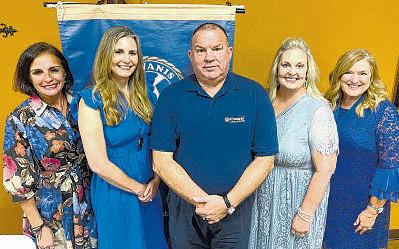
Kiwanis Club of Ascension
Members of the Kiwanis Club of Ascension installed Kristin Rosendale as 2025-26 president on Oct 1. Gathered are, from left, Rosendale, president-elect Tiffany LaPorte, treasurer Patrick Carpenter secretary Boni Pater and director Donna Leggett.
Grants awarded to 8 Livingston teachers
Eight Livingston Parish teachers have been awarded 2025 Deborah Rochelle Teacher Grants to fund instructional, research-based projects that provide direct instruction to local students.
The grant program, which was initiated in 1991, is managed by the Kelly Gene Cook Sr Charitable Foundation to benefit qualified teachers and professional staff in East Baton Rouge, Livingston and St Tammany parishes The grant program is named after Rochelle, who is responsible for the grant’s origination and organization. The grants are valued at up to $5,000 each, and they are awarded directly to the recipients.
The eight recipients and their projects include:
n Anthony Elliot, French Settlement Elementary, $4,824 to fund NextLevel STEM curriculum
n Crystal Gurley Denham Springs High, $4,955 to fund kits for kids
n Alicia Jackson, Seventh Ward Elementary, $4,835 to fund computers for intervention
n Nikki Lavergne Live Oak Junior High, $3,204 to fund responsibility and agricultural literacy
n Laura Litolff, Albany Lower Elementary, $5,000 to fund “Let’s Play Together”
n Heather Smith, Walker Elementary, $4,284 to fund Tables that Teach
n Carol Tate Springfield High School, $1,131 to fund food science books
n Jaime Winter, Seventh Ward Elementary, $4,823 to fund “Let’s Get Techy with Kindergarten” Ascension Kiwanis Club installs officers
Kristin Rosendale was officially in-
stalled as 2025-26 president of the Kiwanis Club of Ascension at its sixth annual installation banquet on Oct. 1 at Kamal’s Kafe in Gonzales.
Joining Rosendale on the board are Tiffany LaPorte, president-elect; Boni Pater, secretary; Patrick Carpenter, treasurer; and Donna Leggett, board of directors.
Division 8E past Lt. Gov Leggett installed the officers and retired outgoing secretary, Judy Stracener and president, Bridgette Hardy Leggett presented Hardy with the Kiwanis President Circle of Honor Award. Pater was awarded “Rookie of the Year” and Carpenter was recognized as “Kiwanian of the Year.”
Thomas Mackey served as master of ceremonies. Carpenter offered the invocation and Douglas Stracener led the Pledge of Allegiance. LaPorte led members in the Kiwanis Defining Statement.
Foundation honors
Henry Turner Jr.
Baton Rouge musician, listening room owner and festival organizer
Henry Turner Jr is the inaugural Sgt. 2Step Award winner Turner was presented with the honor at the A Taste of the Deep South Festival, which he founded, in Baton Rouge in September
The award recognizes Turner Jr.’s “unwavering dedication to music, philanthropy and community service.” His life’s work has long embodied compassion, generosity and unity — values that stand at the core of the Sgt. 2Step Foundation’s mission.
The Sgt. 2Step Foundation was created not only to honor the legacy of Sgt. Adam “2Step” La Porte, but also to seek out and recognize individuals and humanitarians
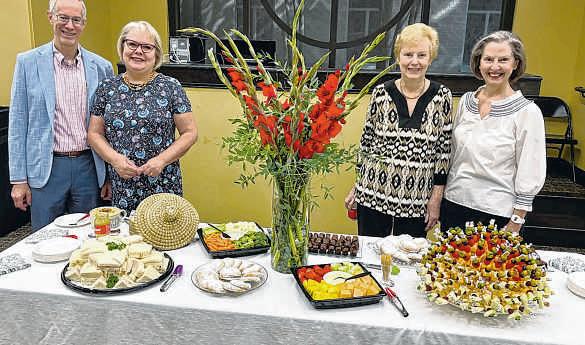
The Music Club of Baton Rouge
Members of the Music Club of Baton Rouge
who rise above themselves in giving back to their communities

The Foundation uplifts those who lead with service, strengthen unity, and inspire others by their example. La Porte, a much-honored Army officer, died in a motorcycle accident at 23 while stationed at Fort Stewart, Georgia. Among his awards were the Army Good Conduct Medal, two Army Achievement Medals, the Army Commendation Medal, the National Defense Service Medal, the Iraqi Campaign Medal, the Global War on Terrorism Service Medal, the Army Service Ribbon, the Army Overseas Service Ribbon and the Non-Commissioned Officer Professional Development Ribbon.
Submissions should be sent by noon Monday to run in the upcoming Sunday column. If submitting digitally, we prefer JPG files 300KB or larger We prefer emailed Community column submissions to features@ theadvocate.com.We also accept submissions by mail at P.O. Box 588, Baton Rouge LA 70821.A phone number must be included.

The Karnival Krewe de Louisiane announced its 16 debutantes for 2026 at coronation ceremonies Thursday at the Renaissance Baton Rouge Hotel.
The girls will be presented at the krewe’s 39th annual ball on Jan. 30 at the Raising Cane’s River Center
The debutantes are:
n Anna-Marie Elise Bargas, a senior at St. Joseph’s Academy and the daughter of Valerie and Trey Bargas.
n Lillian “Lilly” Rose Blanchard, a senior at St. Joseph’s Academy and the daughter of Justin and Christina Blanchard.
n Virginia “Jenna” Caroline Braud, a senior at St Joseph’s Academy whose parents are Sydney and Shaun Braud.
n Isabelle Katerina Breard, a senior at University Laboratory School








of Roselyn and Michael Schoen Jr
n Allie Marie Teekel, a senior at University Laboratory School and the daughter of Mandy and Josh Teekel.


whose parents are Mischa and Michael Breard
n Elizabeth Lynne Bourg, a senior at St. Joseph’s Academy and the daughter of Angele and Michael Bourg.
n Addison Leigh Comeaux, a senior at St. Joseph’s Academy and the


daughter of Dr Bradley Comeaux and Dr Paige Sigsworth Comeaux.
n Caroline Grace Hultberg, a senior at St. Joseph’s Academy whose parents are Jordy and Shannon Hultberg.
n Sydney Frances Kline, a senior at St. Joseph’s Acad-




emy and the daughter of Emily and Chip Kline.
n Bella Renee Rice, a senior at St. Joseph’s Academy and the daughter of Ragen and Michael Rice.
n Mary-Avery Lane Rodrigue, a senior at Baton Rouge Magnet High School whose parents are Ashley and Andre Rodrigue.
n Sarah Anne Schmeeckle, a senior at St. Joseph’s Academy and the daughter of Dr Kellie Dunbar Schmeeckle and Seth Andrew Schmeeckle.
n Ava Grace Schoen, a senior at St. Joseph’s Academy and the daughter
n Jane Marjory Templet, a senior at St. Joseph’s Academy whose parents are Kaye and Marty Templet.
n Avery Grace Watson, a senior at St. Joseph’s Academy whose parents are Julie and Tyler Watson.
n Ainsley Maria Wimberley, a senior at St. Joseph’s Academy and the daughter of Damon and Angelique Wimberley
Each year, the krewe raises funds for local cancer care. Each debutante also has her own donation page to raise funds at https:// members.karnivalkrewe. com/2025-2026-debutantes/.
FYI BR staff reports
nam Experience: 50th Anniversary of the End of the War” exhibit which includes 21 paintings, drawings and watercolors from seven Navy combat
give their visual sense of the Vietnam War: the colors, landscape, people, tragedies and combat actions. Navy combat artists still deploy to Navy ships all across the globe to gather visual information and inspiration for creating fine art for the Naval History and Heritage Command and the Navy Art Collection. The exhibit will run 10 a.m. to 4 p.m. Tuesday through Friday and 9 a.m to 3 p.m Saturdays until Dec. 20. Southern to hold concert with Delfeayo Marsalis Southern University will host
a free jazz concert from noon to 2:30 p.m. Oct. 13 at Debose Hall, 8222 Elton C. Harrison St., Baton Rouge. The event will feature a dynamic performance by the Southern University Jazz Ensemble, led by acclaimed saxophonist and educator Roderick Paulin, followed by a headline performance from the Uptown Jazz Orchestra, under the direction of world-renowned trombonist Delfeayo Marsalis. In addition to showcasing professional artistry, the concert highlights Southern University’s commitment to student mentorship and experiential learning. Several students will share the
stage with the Uptown Jazz Orchestra, gaining invaluable exposure to the professional world of jazz performance. The concert is free and open to the public, offering the Baton Rouge community an opportunity to experience world-class jazz while supporting young talent. Ogden Park Prowl returns on Oct. 18
To celebrate Ogden Park’s 100th birthday, the neighborhood is hosting an arts and music festival, the Ogden Park Prowl, from 1 p.m. to 5 p.m. Oct. 18 in Baton Rouge’s Mid City neighborhood.
Enjoy local artists, makers, live music, storytellers, food and drinks. For more information on location and artists, visit opprowl.org/ about.
Head to the Pink Elephant trunk sale
Head to The Pink Elephant from 10 a.m. to 5 p.m. Oct. 18 at 2648 Government St., Baton Rouge, for antique shopping and 20 extra vendors of vintage, makers and goods.
Email Joy Holden at joy holden@theadvocate.com.
Hike,swim, camp near statepark’s ancientmounds
BY CATHERINE S. COMEAUX
Contributing writer
Catherine S. Comeaux
and her family spent three summers exploring state, national and provincial parks —from Louisiana to Alaska then Nova Scotia and along the Mississippi River in between. This year, she turns her attention to our Louisiana state parksto discover the natural beauty of the South less than a day’sdrive from home.
Despite alifetime of road tripping, nearby north Louisiana has been unexplored territory for me. That detail changed witha visit to Poverty Point Reservoir State Park and the nearby Poverty Point World Heritage Site in Richland Parish, where my family and Iencountered bald eagles and hidden volcanoes as we enjoyed the state park and learned about one of the most significant archaeological sites in the world.
The 2,700-acre Poverty Point Reservoir,built in 2001, is encircled by state park boat launches, picnic areas and cabins alongside ascattering of residential development and agolf course. The park’scampsite and hiking trails offer a more natural feel, tucked away in awooded area near Bayou Maçon.
An early evening hike exploring the woods led us through frog-infested territory (a sure sign of snakes) and alongside the Marsden Mounds—five earthen mounds built thousands of yearsago and so worndown they could be mistaken for golf course hills if it

weren’tfor theeducational signage.
Archaeologists tell us that this area has beenintermittently inhabited for 3,000 years, with itscurrent inhabitants being nomadic RV andtentcampers.
Jumpingover asnake, making our waythrough the campground,a tent with an exhaust ventcaught our eye. Jim from Florida explained that it was part of theair conditioning system that cooled his bell tent(powered by thesite’s electrical hookup )Having camped all over theUnited States, he wasonhis sixth trip to Poverty Point Reservoir,whichheconsiders one of thebest stateparks for campingbecause of its shaded tent sites, wellmaintained tent pads, clean bath houses (withlaundry facilities) and anice buffer zone between tentsand RVs. The campground was well occupied in July,but thereservoir itself seemed abandoned —perhaps owing to the heat. Thesmall sandy beach on the north
By ChristopherElliott

end was apopular spot for swimming, but therest of the public shoreline, secured by rocks, is forbidden to foot traffic. In theearly evenings, acouple of party barges
ventured out,and boaters pulled kids on tubes. Few people were fishing —word among anglers is that the bass are biting in thefall and springtime, but all we caught off our cabin’sporch
was ahotdog-sized catfish. In addition to fishing, we did alittle birding. Over morning coffee, we saw abald eagle and watched swallows catching their breakfast. In the woods, we spotted abright yellow Baltimore Oriole, not surprising since the park is within the Mississippi Flyway —amajor route for migrating birds which followsthe Mississippi River watershed.
For thousands of years, people have also used this watershed route —aphenomenon we learned more about on our visit to the Poverty Point World Heritage Site about 15 miles north of the park.
Abird’s-eye view of Poverty Point showswhat looks like arainbow of earthen ridges (slightly obscured by tree growth) coming off of Bayou Maçon’swestern bank.
To better appreciate what, from the ground, looks like lumpy farmland, visitors will want to stop at the museum to see stylized images of how the earthworks would have looked in the era when they werebuilt around 1700 B.C.
The museum houses artifacts, like the bird-shaped pendants distinctive of this site, madeofvarious materials indicating it was once the hub of an expansive trade network. Educational displays and ashort film tell the story of the unique people who moved tremendous quantities of earth to create ridges and mounds, including the largest ancient earthworks in the Western Hemisphere. Known as the Bird Mound, it is the only mound that visitors are allowed to climb.
The guided tram tour offered abreezy shaded view of the site in mid-July
The interpretive ranger
enthusiastically answered questions and told stories based on over acentury of archaeological findings. He challenged us to renamethe site since “Poverty Point” was unthinkingly borrowed from arelatively short-lived plantation, so named because of the difficulty of farming in the area. But the ancient inhabitants weren’tfarmers; they were hunter-gatherers whotypically don’tsettle downin one place.
Aquestion archaeologists continue to grapple is, “Why did they settle here?” Until recently,the answer wassimply its location within the Mississippi watershed with its river connectivity.Newly acquired data using electrical resistivity tomography suggests another reason —mud volcanoes which would have been unique in the area, attracting attention with their gaseous, bubbly and potentially fiery spewing. Didthe inhabitants somehow harness the energy of these geological features, or did they hold supernatural significance?
This short visit to nearby north Louisiana was relaxing and also surprised me with the world-famous wonders that lay less than a day’sdrive from home.
Know before yougo
n The state park is in black bear territory,sobe prepared to stow your food if tent camping.
n Groceries are available in Delhi.
n Allow twohours to a half day forexploring the Poverty Point World Heritage Site.
n Tram tours of Poverty Point World Heritage Site are offered at 10 a.m., 11:30 a.m., 1p.m. and 3p.m. Wednesdays through Sundays in March through October,weather permitting.

Christopher Elliott

Ibooked a flight from BuenosAires to Puerto Iguazú,Argentina for my family.I bought the tickets on Flybondi, an Argentinelow-fare airline, through FlightHub.Despite carefully entering our flight details, the airlinesaid our passportnumbers were random characters.We had to buy newtickets for $1,114 on Flybondi.
FlightHub blamed the airline, but Flybondi confirmed FlightHub entered fake passportdata. FlightHub has refusedto give us arefund, claiming the tickets are nonrefundable. How can Iget FlightHub to takeresponsibility for thiscostly error? Emily Day, Brookline, Massachusetts
FlightHub should have ensured its system accuratelytransmit-
ted your passport information to Flybondi. Under U.S. Department of Transportation guidelines, ticket agents must provide complete and correct booking details. FlightHub’sfailure to do so —and itsuse of placeholder passport numbers —breached that responsibility
Could you have avoided this?
Possibly.Ifyou had checked your Flybondireservations online, you might have seen thegibberish passport information sooner.You tried to do that, butthe airline advised youtocheck in at thegate. Keeping athorough paper trail, as youdid,was critical. You reached outtoFlightHub’scustomer service viachat and spoke to arepresentativeonce you were in Puerto Iguazú. He opened a case and eventually acknowl-
edged that this was not your fault andagreed to resolve theproblem foryour return flight.
Youemailed FlightHubphotos of your passports. Unfortunately, FlightHub couldn’tmodify your flight records in time for your return flight,but you were able to resolve thediscrepancy directly with Flybondi for your return flight —so, no need to buy asecond ticket to get back to Buenos Aires
Even after FlightHubadmitted that it screwed up, it still wouldn’t refund your tickets, arguing that they were nonrefundable. Of course, they were nonrefundable —but you couldn’tuse them because of FlightHub’sbooking error
All it would have taken to get youarefund was for someone

at FlightHub to review your paper trail. If Ihad to guess, I’d say FlightHub is processing its customer service cases using artificial intelligence. But there’sno question aboutit, this was obviously aFlightHub mistake.
Youmight have been able to bypass this nonsense. By escalating your case to FlightHub’sexecutivesusingthe executive contacts on my consumeradvocacy site, Elliott.org, youmight have gotten a quick resolution. Yousay you tried to do that, but no one responded. Icontacted FlightHub on your behalf.
“Upon reviewing the situation,weidentified that the issue stemmed from atechnical error on our end,” arepresentative told me. “The customer contacted us theday before their return flight
to request acorrection to their passport information. We promptly submitted the request to the airline, but the airline was able to assist the customer directly before they responded to us. FlightHub issued afull refund of your original flights plus a$100 voucher as agoodwill gesture, which you accepted. If there’salesson here, it’s never to assume your third-party booking site got it right. Always check your flight directly with the airline, and well in advance of your flight.
Christopher Elliott is the founder of Elliott Advocacy,anonprofit organization that helps consumers solve their problems. Email him at chris@elliott.org or get help by contacting him on his site.

Louisiana, but did she ever film any here?”
Didshe film in Louisiana?
Well, no. But she came close. Taylor,along with fellow Hollywood legends Montgomery Clift and Eva MarieSaint, came to Natchez, Mississippi,for the1956 filming of “Raintree County.”
Natchez is directly across the Mississippi River from Vidalia, 60 miles north of St. Francisville on U.S. 61. Louisiana newspapers, including The Advocate’s afternoon sister paper,The State-Times, and The Times-Picayune sent photographers and reporters to the filming, most of which took place at Windsor Ruins, which stand along Mississippi Hwy.522, the same road that leads to Alcorn StateUniversity Alcorn figures into this story because the ornate cast-iron stairs fronting the ruins, on which Taylor,Clift and Saint were both filmed and photographed, now lead to the front doorsofAlcorn’sOaklandMemorial Chapel.
Back in 1956, they still stood at what would have been the entrance to Windsor Plantation.
As for Windsor,its 12 Corinthian columns still stand. From 1861 to 1890, the mansion’s three stories once overlooked the Mississippi River from a distance. It was destroyed by fire after aparty guest tossed a lit cigar in the trash on Feb. 17, 1890. The ruins are now maintained as ahistoric site by the Mississippi State Department of Archives and History.The site was also used in the 1996 film “Ghosts ofMississippi.”
Back to “Raintree County,” Edward Dmytryk directed the MGM Civil Warepic love triangle among John Wickliff Shawnessy, playedbyClift; his hometown sweetheart, Nell, played by Saint;and the irresistible New Orleans Southern belle, Susanna Drake, played by Taylor
The story begins in Shawnessy’shome of Raintree County in Indiana, and it’swhere he returnswith apregnant Susanna at the outbreak of the Civil War.
The cast and crewstayed at the Natchez Eola Hotel during filming, and according to reporter-photographer Charles East’sAug. 1, 1956, feature in The State-Times, filming was supposed to move to Rosedown Plantation in St. Francisville afterward but was canceled ElizabethTaylorinNew Orleans
But that doesn’tmean Taylor never spent time in Louisiana. She was afrequent visitor to New Orleans, often stayingat the Audubon Cottages at 509 Dauphine St. in the French
Continued from page1D
has been presented to more than 250,000 K-12 students across the globe.
Simien still averages 50,000 miles on the road each year.He has no plans to park his touring van yet. “I love my job to whereit doesn’teven seem like ajob,”he said. “After all these years, I’m
Quarter
“She stayed here 27 times,” said Shawn Gray,the boutique hotel’smanager.“She always stayed in cottage No. 3.”
Audubon Cottages, built in the late 18th century,once were home to ornithologist, naturalist andpainter JohnJames Audubon and now operate as an intimate cottage-style hotel retreat in the French Quarter
“All cottages havetheir own privatecourtyards,” Gray said. “And Ithinkthat’sprobably one of thebig hits for stars, because they don’thave to interact with anybody. Once you walkintothe alleyway,you can gointo your cottage, andyou can close the entrance door to your cottage andclose the entrance door to your courtyard.”
Gray said actress Kathy Bates recently stayed at Audubon Cottages.
The hotel hasn’t marked cottage No. 3with abrass plaque or any other kind of commemoration of Taylor’sstay,but itswebsite doesnoteher preference for the cottage.
Taylor’sname remains big at Audubon Cottages, just as it is in Hollywood history
ForSwifties still searching
“Who is Elizabeth Taylor?” on Google, she was born on Feb. 27, 1932, to socially prominent American parents in London, England. Herfirst starring role was at age12in“National Velvet,” opposite a24-year-old Mickey Rooney
She wouldmove on to adulthoodtostar in such iconic films as “Giant,” oppositeJames Dean in 1956; TennesseeWilliams’ “Cat on aHot TinRoof,”opposite Paul Newmanin1958; “Butterfield 8” in 1960 opposite her fourth husband,Eddie Fisher; the epic “Cleopatra,” opposite herfifthhusband,Richard Burton, in 1963; Edward Albee’s “Who’sAfraid of Virginia Woolf,” again co-starring with Burton in 1966; and “The Sandpiper,” again oppositeBurton in 1967.
Andasmentioned in the lyrics of Swift’s song, Taylor did, indeed, have violet eyes Laterinlife, shemaintained a friendship with the King of Pop Michael Jackson, andshe cofounded the AmericanFoundation for AIDS Research in 1985 and theElizabeth Taylor AIDS Foundation in 1991.
Outsideofher movies and philanthropy,she was constantly pursued by thepaparazzi through hereight marriages, which included twicetoBurton. She diedin2011 at age79. And now,thanks to Swift,her name —and herlegend— are trending onceagain.
Do you have aquestionabout something inLouisiana that’s got you curious?Emailyour question to curiouslouisiana@ theadvocate.com.Include your name, phone number and the city where you live.
in condition.AslongasIhave my health andGod is pointing me in that direction, Ihope Ican play music until Ican’tdonothingelse.”
Herman Fuselier is executive director of the St. Landry Parish Tourist Commission. A longtime journalist covering Louisiana musicand culture, he lives in Opelousas.His “Zydeco Stomp” show airs at noon Saturdays on KRVS 88.7 FM.




Continuedfrom page1D
which included soup, salad, dinner anddessert utensils, plus abutter knife. IaskedSetliff to quiz me a couple of times as Ipointedtoeach utensil and named itsfunction. I’m an enthusiastic student, andshe let me knowthat she appreciated my cheering when Igot answers right. Setting the table took about 20 minutes. As Iplaced theitems, Setliff explainedcertaindetails, like howthe teeth on forks are calledtinesand howthey’re longer on adinner fork than asalad fork. Whenitwas time to sit down, I entered from the chair’sright side per Setliff’s instruction.
“What’s thevery first thingwe do when we sit down at the table?”
Setliff asked.
Ilearned theanswertothatquestionwhen Igrabbed lunch with my editor Jan Risher for the first time in August.I told herI didn’tknow muchabout table etiquette and genuinely asked for pointers. She told me about the napkin tip and had theidea for this article.
Flash forwardtosittinginSetliff’s dining room. Ifelta burstofexcitement because Iknew an answer.I blurtedout, my excitement making me forget propergrammar,“It’s napkin, right?” Close enough.
Setliff said Iwas correct, and, once again, Icheered.
She gave me more details about exactly howtofoldthe napkin in half andplace it longways across my lap, up to my bellybutton,using the inside corners of thenapkin to dab my mouth throughout themeal.
Lunchtime
Onceseated, Ifolded the napkin as instructed, feeling like I wasgetting strapped into aroller coaster.Itwas time to eat.
I’m asoup enthusiast. It’smyfavoritekind of food to cook and eat.
Yet, Ilearned I’vebeenbreaking just about every single soupetiquette rule there is.
There’sa correct utensiltoeat soup with,a more rounded, short and stout-looking spoon. Setliff and Ispent severalminuteslearning how to properly hold theutensil.
Once Igrasped thespoon correctly,Ithought we were ready to rock and roll witheating, but Iwas wrong. More was to be learned. Themotion of dipping aspoon into thesoup bowl is done aparticular way —scooping the soup

as they were in years past. For example, many people keep their family’schina boxedinthe attic and don’tuse it, Setliffsaid. Growing up, Setliff didn’tpractice muchtable etiquette in her house, and her mother still jokes about which utensil to use. Her grandmother’shouse wasadifferent story,where there’d be all sorts of pretty things to setthe table with, Setliffsaid. That’swhere she developedanadmiration forthe practice.
“I use this silver every day,” Setliff said about her grandmother’ssilver.“That’swhat we use. I’m not the norm anymore.”
away from yourself and then bringing the spoon to the mouth.
Wheneating bread, the correct way is to tear off asmall piece, butter it with the correct knife and then eat it. (I’m notsure howI’ll implementthis rule at Texas Roadhouse, a place where survival instincts say to shove as much bread and whipped butter into themouth as possible.)
When eatingthe main course, Setliff told me to grip the fork like apencil and switch hands between cutting food and putting food in my mouth —according to American style. She alsoexplainedthe continental style of using utensils, and I practiced both on asliceoflasagna.
She advisedI placethe fork and knife down after every four bites to sip water or dab my mouth. She also told me how to properlyhold teacups versus coffee cups. Pinkies down, she said.
And when themeal is over,the napkin is placed loosely to the left of the plate.
Adying art
Mid lasagna,Ihad aburning question.
“Where areyou with elbows on thetable?” Iasked.
It depends, shesaid. She personally chooses to never rest on the table.
“I don’tthinkelbowsare ever an option at the table,” she said. “It may be forearms depending on who you ask and what country you’re in.”
“I always encourage people just to go with the flowofthe vibe, whatever the circumstances,” she said. “Sure, if you’re at The Chimes,I think it’sfine. But if you’re at Ruth’sChris, maybe not.”
Setliff’sapproachtoetiquette is more casual than regimented That’sthe buy-in, she said. It has to be wanted by people to do it.
Today, etiquette is all about convenience —and many etiquette traditions aren’tpracticed as much
Many people usepaper plates which there isn’tanything wrong with, she said, andit’smore work to clean normal plates.Thankyou notes are another example of something notpracticed as much, especially since people can send aquick thank-you text. Lots of young people don’tknow how to address an envelope either It’s sad but it’sthe times, according to Setliff.
“I’m trying to do my little bit to preserve those little details of life to make someone else’sday better,” she said.
Goodbyes
Setliff likestogiveher guests asmall gift before leaving, specificallysomethingtomakethem laugh. She gave me Snoop Dogg’s cookbook. Ican’twait to cook one of the recipes. Sherequested Itellher if Ido. Ipromised to send pictures. I’m not going to lie, Ithought etiquette wasa littleover-the-top before this, but this lesson completely changed my mind. Ididn’t realize before that etiquette stems in creating comfort forthe people around you.
Being kind to one another,right? That’sbeautiful, andit’ssomething this world needs moreof.
After ahug goodbye, Iwalked out of Setliff’s front door.Iclimbed into my blue Honda Fitwitha bright orange gift bag in my backseat, aprint copy of the etiquette PowerPoint presentationand acookie dough ball dessert from BLDG5 that she offered Itake to-go. It felt like coming home afterareally great night out with close friends. Ihad afull belly,ahappy heart andglowing pride forthe newfound knowledge of every dining utensil’scorrect function, and Setliffwas responsible forall of it. I’ll have to write her athank-you note.











BY CATHERINE COMEAUX
Contributing writer
My grandmother was one of 17 children born to Oscar and Eliza Daigle. Ioften unexpectedly run into distant cousins around Lafayette —atthe grocery store,at church and recently,atthe table.
Having put acall out to friends asking them to connect me with talented home cooks, Iwas sent Mike Moncla’snumber.His wife, Catherine, happens to be my second cousin. He agreed to my request for arecipe and responded with an invitation to afour-course meal and achance to reconnect with family.(As aspecialsurprise, he included his neighbors, my brother and his wife. Yes, thebig town of Lafayette is that small.)
Inspired by his grandfather Leon Moncla who had aspecial talent for preparing tongue and stomach, Moncla has takenhome cooking to another level. More accurately described as acreative gourmet, he prepared aseafood focused meal complete with a printed menu decorated with photos of the great-grandparents. Honoring his wife’sgrandmother and my grandmother (close-in-age sisters), it included esoteric fruit, homemade drizzles and crunchy sweetness to bookend the meal.
We started the eveningwith Moncla’ssignature old fashioned (a drink he famously mixes at events to benefit Catholic Charities).
“I love sweets,” he saiddropping two sugared pecans and acandied orange peel swizzlestick in my drink.
He comes from the land of sugar cane, his family hailing from Patoutville, home of the United States’ oldest continuously operated family-owned sugar mill, M.A. Patout &Son. What adelight to sip and nibble acocktail, the sweetness laid back whilethe nut and citrus flavors blended beautifully with the Bulleit Rye whiskey

conversation that night was sweet and warmaswedug around in the memories of our shared family’s past.I came away with an excellent recipe for lobster bisque, a small box of leftoversand gratitude for having reconnected with family
MikeMoncla’s Lobster Bisque
Serves 8. RecipeisbyMike Moncla
3live lobsters Forscallion finishing oil:
1cup avocado oil
With the help of their daughter, the Monclas served thebeautifully platedcourseswhilemiraculously simultaneously staying in the flow of conversationasweall enjoyed ourselves at thetable. Dining beganwith atreathecalled Tuna Crudo with MirlitonMignonette and PassionFruitGranita —the tangy icypassionfruit and vinegarychoppedmirliton delivered the salty tuna with acymbal crash of bright flavor in the mouth.
Following the lightness of the tuna was abuttery smoothlobster bisque,elevatedwith chili and scallionfinishing oils
It brought acalm flavorful warmth to thetable as we settled into our remembrances of old nun aunts in their habits, grandparents andtangentialfamily connections from Iberia Parish to North Africa.
Moncla’s useofdrizzles and saucesnot only added beauty to the plate but brought an exciting taste dimensiontohis home cooking. This was most apparent in his crabcakes,delicately flavored thick pattieswhich weremore crab than filler
He placedthem onacitrusy tartar sauce,drizzled the tops with atangy greenconcoction (made with parsleyand garlic),then accented with Sriracha. Best crab cakes ever,but when Iaskedfor the recipe,hegraciously ducked outand returnedwitha crackly cremebruleecovered in fresh berries From drinks to dessert,the
1bunch scallion (green onion) tops, roughly chopped 1yellow onion, peeled and rough chopped
6wholecarrots, rough chopped 6celerysticks, rough chopped 6-ounce can tomato paste
1quartheavy cream
1/4 cup sherry
1-2 tablespoons cornstarch
2-4 tablespoons cold water
1stick (4 ounces) butter Red chilioil for finishing
1. In apot large enough to boil 3 lobsters, add water to fill about 2⁄3 full, bring to aboil, then drop the lobsters in for 15 minutes.
2. While the lobsters are boiling, makethe scallion finishing oil. In asmall pot,heat one cup of avocado oil. Addthe scallion topsto thehot oil and let cook for afew minutes toinfuse the onion flavor Set aside tocool slightly then blend in ablender.Using amesh colander pour thescallion oil into asqueeze bottle.
3. Removethe lobster from the pot,reserving the boiling water in thepot. Cool lobsters in ice water until manageable then pick the meat from theclaws and tail. Set themeat aside.
4. Return all the claws and shells to theboiling water for 45 minutes tomake lobster stock. Using acolander,pour the stock into another large pot,separating out the shells. Put10cups back into theoriginal pot to makethe bisque (freeze any remaining stock for future use)


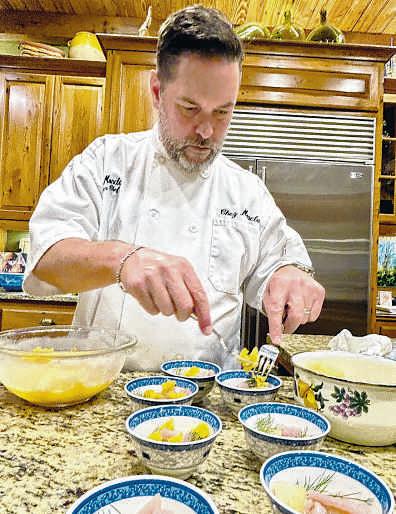
5. Addthe onion, carrots and celery to the stock. Stir in the tomato paste andcook for30minutes over medium heat.
6. Use an immersion blender to blend thestock with vegetables until smooth,and once again pour through acolander to makesure there are no chucks of vegetables. (Alternatelyuse ablender and a second pot, working in batches.)
7. Addthe heavy cream and sherry to the stock and cook on medium heat for20minutes. If a thicker bisque is desired, make acornstarch slurry by combining 1tablespoon cornstarch with 2tablespoonscold water.Stir in the cornstarch slurry,adding
moreuntil desired consistency is reached.
8. Lower heat to simmer then add astick of butter.Once butter melts in, stir and add salt to taste.
9. Divide the lobster meat between serving bowls. Pour the bisque on top, and drizzle with the chili and scallion finishing oils.
Notes:
n Red chili oil can be found in the Asian food section of most grocery stores.
n Squeeze bottles can be found on the kitchen supply aisle of mostgrocery stores.
n Set aside about 2hours cooking timefor this recipe.
n Leftovers freeze well.















BY JOYHOLDEN Staff writer
To honor celebrated Louisiana

Gaines
writerErnest Gaines,the Baton Rouge Area Foundation presents one of the most prestigiousliteraryprizes given to Black American writers, the Ernest J. Gaines Award for Literary Excellence. The award serves to inspireand recognize rising African American fiction writers of excellence at a national level.
The Baton Rouge Area Foundation willgive the 18th annual honor to Essie Chambersfor her novel “Swift River”at6:30 p.m Oct. 21, at the ManshipTheatre at the Shaw Center,100 Lafayette St., Baton Rouge. Community members can attend the event by registering at ernestjgainesaward.org/rsvp.
The book award, initiated by donorsofthe Baton Rouge Area Foundation, comes witha monetary award of $15,000 to support and enablethe writer to focus on their craft.
From SwiftRiver to the MississippiRiver Chambers’ debut novel features teenagerDiamond Newberry as she navigates the summer of 1987 in her hometown of SwiftRiver, Massachusetts. Set in aforgotten mill town, the book acknowledges ahaunted place where industry has died, Chamberssays Diamond is the only Black girl in arural town, and she lives with her White mother.They are both ostracized, harassed and mocked for being “other” in the town. Then, Diamond receives aletter from alost cousin who was close to her father.Through this connection, Diamond learns about the strong Blackwomen who came beforeher,helping establish a rootedness and confidence which shapes her character.Through letters and flashbacks, Chambers

weaves amultigenerational tale of trauma and resilience. She illustrates aplace where people are suffering, struggling and haunted bythe former industry and its remnants, but thetown still has ariver running through it. Chambers says that it’s the right setting for astoryabout a family and agirlwho are haunted by past trauma.
‘The greatest honorofmylife’ Massachusettsnative Chambers hadasuccessful career in television andfilm production,includingproducingthe award-winning
2022 documentary,“Descendant,” but writing anovel was her earliest and mostpersistent dream. She says “Swift River” took 10 years to write andchanged as she changed through the years.
“I had this wonderful creative job,and Ihelped other people tell their stories, but Iwas neglecting my own story,” Chambers said. “I really wrotearound the edges of my life. The story came to me in pieces. Ithink thecharacters were always with me, but it didn’t come together until Icommitted myself to being awriter ” Chambers expresses gratitude

PROVIDED PHOTO
Essie Chambers is the author of ‘Swift River’ and winner of the 2025 ErnestJ.Gaines Award for LiteraryExcellence.
and humility when it comes to being apartofthe distinguished community of Ernest Gaines award winners.
For her,though, the award is really apush to keep going and to keep writing.
“Mr.Gaines had such aprofound impact on me as areader and awriter,sotobepart of his legacy and join this community of writers who Iadmire so deeply,it is the greatest honor of my life,” she said.
“There’ssomething so beautiful aboutbeing honored, not just for the book, but formy promise as awriter,and it feels like an investment in the person I’m going to becomeand the future stories that I’mgoing to tell. Andit’sjust the mostgenerous kind of encouragement and motivation.”
Chambers’ narrative voice is clear and direct in “SwiftRiver,” yet she integrates moments of poetry and fantasy into her prose. There is arichness in the language that imbues the story with depthand substance.
Chambers will visit Baton Rouge andobserve another town that ariver runs through.
The judging panel forthe Ernest J. Gaines Award is comprised of poets, professors, short story writers and novelists. Anthony Grooms, Edward P. Jones, Opal Moore, Francine Prose and Patricia Towers read many submissions this year,but “Swift River” wasthe consensus winner Moore, apoet and retired literature professor from Spelman College in Atlanta, Georgia, says “SwiftRiver” resonated with her because of the three interlocking stories told through letters and flashbacks.
“You have these women talking across time, and that’ssuch a great subject because, no matter what we do, it’svery difficult for manypeople to take their imagination beyond the era that they’re living in,” Moore said. “I felt like that was areally powerful wayto talk about how women find each other —how younger womenfind these stories of older women. Their story seemssoremote until you live with them foramoment.”
Moore also appreciated how the characters in “SwiftRiver” represented the ways Black people came through time, working toward things forupcoming generations, but those sacrifices and stories often aren’tseen by the descendants.
She noted that Chambers captured the important workthat is necessary in figuring out who came before us. Another appeal of “SwiftRiver” was the engaging storytelling. Moore says the storytelling has manydoors forpeople to enter into it —through alove story,a mother/daughter relationship, asearch forracial identity or a journey to discover your heritage. Moore will facilitate the conversation with Chambers at the Ernest J. Gaines Award forLiterary Excellence presentation on Oct. 21 at the Manship Theatre. For moreinformation, visit ernestjgainesaward.org.
Email Joy Holdenatjoy.holden@ theadvocate.com.
On the last Saturday of August, Ibegan my morning with The New York Times, which carried yet another story about the decline of reading across the country Over the past two decades, the share of Americans who read for pleasure fell 40%, as The Times reported.
It’sasobering trend witha lot of potential implications forthe future. Reading has many social benefits, and our connectionswith each other can grow weaker when fewer of us find the common ground that books often provide. But civic engagement wasn’t the first thing Ithought about afterreading The Times’ story Instead, while mulling over the prospect of thoselegionsof nonreaders out there, Iworried about all the fun they’re missing. Fun was topofmind that day because my wife and Iwere planning aweekend drivetothe French Quarter,where our first stop wasBeckham’sBookshop, a longtime Decatur Street destination for those in search of vintage volumes.
I’d first visited Beckham’s in 1990,picking up an 1858 edition of “The Autocrat of the Breakfast Table” by Oliver Wendell Holmes. Steve and Katrina Lacy bought Beckham’sfrom Carey Beckham and Alton Cook last year.Steve


has operated nearby Dauphine Street Books, which sells old and new titles, since 1994.
“I had often thought how wonderful it would be to buy Beckham’s,” Steve told me.“We find that we’redoing pretty well so far.”
On an upper floor of Beckham’s Katrinahas been developing MadameLacy’s Retreat as acommunity gatheringplace. It recently hosted ayoga program, and other plans are in the works. But books have been thestar of Beckham’s since it opened many years ago, andthattradition is continuing with the Lacys
Theshop’stall windows and high ceilings create an open feel that brightens thebrowsing experience, though visitors might have to walk aroundJoni, the shop feline. Ifoundher napping by ahistory shelf, decoratingthe space likeathrow rug.
“Wesay she’sthe real owner,” Steve mentioned. While huntingfor another volumeofVirginia Woolf’s diaries, I foundinstead“TheJourney Not


theArrival Matters,”a memoir by Woolf’s husband, Leonard, about their life together.Myodyssey to find somemedical essays by Oliver Sacks brought another happy accident when Ispotted “The PatientHas the Floor,” acollection of speeches by one of my favorite writers, Alistair Cooke.
Spying acopy of Patrick Leigh Fermor’s “A Time of Gifts” made me feel even luckier I’d loved “A Time to Keep Silence,” his account of visits to European monasteries, and I knew this other Old World travelogue would be just as good. Ialso nabbed “At Homeand Abroad,” a collection of travel pieces by V.S. Pritchett, an English author I’ve cherished foryears.

I’msorry that fewerpeople are reading these days. They really don’tknow what they’re missing. Email Danny Heitman at danny@ dannyheitman.com







By The Associated Press
Today is Sunday,Oct. 12,the 285th day of 2025. There are 80 days left in the year
Todayinhistory:
On Oct. 12, 2002, bombs blamed on al-Qaida-linked militantsdestroyed two nightclubs on the Indonesian island of Bali, killing 202 people, many of whom were foreign tourists.
Also on this date:
In 1492, Christopher Columbus’s first expedition made landfall on what is now San Salvador Islandin the Bahamas.
In 1870, Gen. Robert E. Lee, former overall commander of theConfederate StatesArmy in theCivil War, died in Lexington, Virginia, at age 63.
In 1960, Soviet Premier Nikita Khrushchev protested remarks at theUnited Nations by pounding his shoe on his desk.
In 1968, Mexican track andfield athlete Enriqueta Basiliobecame the first woman to light the Olympic flame at the opening ceremonies of the Mexico City Summer Games. In 1973, President Richard Nixon nominated House Minority Leader Gerald R. Ford of Michigan to succeedSpiro T. Agnew as vice president.
In 1984, British Prime Minister Margaret Thatcher escaped an attempt on her life when an Irish Republican Army bomb exploded at a hotel in Brighton, England,killing five people.
In 2000, the destroyer USSCole was attacked by boat-borne alQaida suicide bombers during a refuelingstop in Yemen’sport city of Aden, killing 17 on board
In 2019, Eliud Kipchoge became the first person to run amarathon in less than two hours,crossing the finish line of the INEOS 1:59 Challenge in Vienna, Austria, witha time of 1:59:40.
Today’sbirthdays: NASCAR Hallof Famer Ned Jarrett is 93. Broadcast journalist Chris Wallace is 78. Singer-songwriter Jane Siberry is 70. Actor Hiroyuki Sanada is 65. Jazz musician Chris Botti is 63.Actor Hugh Jackman is 57. Country musician MartieMaguire (TheChicks) is 56. Actor Kirk Cameron is 55 Olympic gold medal skier Bode Miller is 48. ActorJosh Hutcherson is 33.
Dear Miss Manners: What do you do when the dutyto write thank-younotes overwhelms any genuine sense of gratitude?
In my own upbringing, reciprocity and eagerness to give were prized over the finerpointsofexpressing gratitude, and I confess that my gratitude muscle has suffered as a result.

Martin MISS MANNERS

Iamtrying to strengthen it by practicing writing thankyou cards, startingwithlarge events, such as my wedding and baby shower
Theendeavor has now lasted a couple of years, and Istill have not finished with the thank-yous for either one.
Meanwhile, other holidays, birthdays and events have come and gone, and while Idotry to thank each gift-giver verbally, whether in person or on the phone, writing notes for each
gift just seems liketoo much to be done during an already busy phaseof life. This is alsousually immediately following atime of upheaval due to planning, gift shopping of my own and major life changes.I am already exhausted, and the condition of my home is suffering for it
On top of this, Istill try to give to others what Ican of my time, love, energy and resources, as Iwas raised to do. It seems like there is not time or energy left in the day to write.
Iammost concerned about thetask becomingabitter chore and source of anxiety,crushing any real gratitude. How do you manage thetask so that the expressions are genuine? Or is this adifficultyyou have not encountered?
Gentle Reader: It is clear to Miss
Manners thatyou can, in fact, manage to pena heartfelt and genuine letter. Because you took threeparagraphs to insist that your life is busier and more exhausting thanthose of the people who took the time to give you apresent. Youwill be relievedtohear that agood thank-you letter need only costyou abouthalf that space andenergy
Dear MissManners: I’m afairly new motherofone child. After working hard to clear my work schedule and afford afamily vacation, we’re finally here! The issue is all the other parents. Everytime Igraba cocktail and head to an expansive lawn to toss aballtoour dogorkick aball to my daughter, four or five otherkids descend. Iwould love nothing more than for my daughter to find aplaymate, but it seems thatIjust end up running playtime
Gentle Reader: As soon as the childrenstart descending, look around forparents —orloudly askthe childrenwhere they are. (If the childrenare not oldenough to respond, just get louder.)
Oncethe parents have been located,say to the kids, “You might want to tell your parents thatyou arehere, because I’m notsure howlongwewill stay And we don’twanttoabandon you.”
Thatlastpart, Miss Manners feels certain, will put the parents on high alert—that they should eithercollect their childrenquickly or be prepared to take over playtime.
Send questions to Miss Manners to heremail, dearmissmanners@gmail.com; or through postal mail to Miss Manners, Universal Uclick, 1130 Walnut St., Kansas City, MO 64106.


Dear Heloise: Jane, in Virginia, mentioned thatall the colors are thesame with furniture: gray, whiteand beige! Avery simple and inexpensive way to get pops of color is with throw pillows, colored glass jars, and artwork. Lotsofstores offer these items at great prices instead of your having to pay for asofa or chair in alimited color or print. Plus, the color themes can bechanged this way —Kathy N., in Montgomery,Texas Swab thedoor
Dear Heloise: I’ve discovered a great use forcotton swabs. Iuse them to clean thevery narrow rubber crevices on our refrigerator door.Itworks great in onesweep with alittle vinegar or water Also, Iuse them to clean small moving parts in my single-brew
ADVERTISEMENT
coffee maker —A Reader,via email Raisingaproperpuppy
Dear Heloise: We got anew puppy, and she’ssocute!
Butwewant her to be friendly and not timid or afraid. So, we are socializing her alittle bit every day
We takeher out to meet other dogs and people at the park. Not for too long—maybe an hour at most. —BrittanyB., in Texas Brittany, this is agreat way to introduce your pup to socialization!Kudos to you. —Heloise Sunscreen101
Dear Heloise: With thesun out and more people getting active outdoors, can you give us the411 on sunscreen? —David E. in Kentucky David, I’d be happy to do so! Not using sunscreen can potentially damage your skin and lead to wrinkling, sagging and worse. Be sure to apply asunscreen with an SPF (sun protection factor)of15orhigher about 15 min-
Why you need dental insurance in retirement.
Many Americans arefortunate to have dentalcoverage fortheir entire working life, through employer-providedbenefits. Whenthose benefits end with retirement, payingdental billsout-of-pocketcan come as ashock, leading people to put off or even go without care.
Simply put—without dental insurance, there maybe an importantgap in your healthcare coverage
When you’re comparingplans.
Look forcoverage that helps pay formajor services.Some plans may limit thenumber of procedures —orpay forpreventive care only.
Look forcoverage with no deductibles.Some plans may require you to payhundredsout of pocket beforebenefits are paid.
Shop forcoverage with no annual maximum on cash benefits.Some plans have annual maximums of $1,000.
That’s right. As good as Medicare is, it was never meanttocover everything.That means if you wantprotection, you need to purchaseindividualinsurance.
Previous dental work canwear out. Even if you’ve had quality dental work in the past, you shouldn’t takeyour dental health forgranted. In fact, your odds of havingadental problem only go up as you age.2
Treatmentisexpensive— especially the servicespeopleover 50 often need. Consider these national average costs of treatment. $222 fora checkup $190 fora filling $1,213 fora crown.3 Unexpected bills like this can be areal burden, especially if you’re on afixed income.
utes before you go outside. How much to apply? The average-sized person needs about an ounce (a shot glass size) of sunscreen. Cover your face (avoid your eyes) andbody.Don’t forget your ears, your neck, the backs of your hands, and the topsofyour feet.
Other sun-safety suggestions?
Stay indoors during peak hours (10 a.m.-2 p.m.), wear lip balm, and cover exposed skin as much as possible. Afloppy hat is not a bad idea either —Heloise Sour bottle smells
Dear Heloise: If your baby’sbottle has afoulsmell, try filling it with warm water and 2teaspoons of baking soda, then shake vigorously.Leave it overnight. The next morning, just washasusual. —Bonnie T.,inBeaver Creek, Colorado
Getitinwriting
Dear Heloise: My wife said that women routinely are given high car-repair estimates, which are
saddled with unnecessary repairs, and they have been upsold unknowingly
My hint is to always get awritten estimate before any work is done and makesure that it is signed by you and the shop. If you have any questions, show the estimate to aknowledgeable friend, or get asecond estimate at another shop. —Dave, in Waco, Texas Aquick Latinlesson
Dear Readers: If you’re applying forajob, especially in the medical field, you may come upon the term “pro re nata,” or “PRN.” But what does it mean? It’s Latin, and it translates to “as needed” or “as necessary.”
Youmay also see this term on aprescription bottle, which meanstotake the medicine as needed. Confirm this with your doctor —Heloise Send ahinttoheloise@heloise com.



BY JANRISHER Staff writer
The LouisianaInspired Book Club will celebrate and discuss Paul Prudhomme and his “Louisiana Kitchen” cookbook with a live panel discussion and tasting of his recipes. The event will take place at noon Friday at the Main Library’s large meeting room at 7711 Goodwood Blvd. in Baton Rouge.
Special guests Marcelle Bienvenu and Frankie Bertrand will share their Prudhomme insights anddiscuss Cajun and Creole cuisine andculture, moderated by Louisianaculture editor Jan Risher
Bienvenu is aLouisiana cookbook author and culi-

nary historian, whose beloved classic, “Who’sYour Mama, Are YouCatholic, andCan YouMake A Roux?,” is ago-to for treasured Cajunand Creole dishes —recently reprinted with new photographs and a gorgeous bright pink cover
BY JEFFREY COLLINS Associated Press
BISHOPVILLE, S.C. When J.D.
Stevens flips on the lights in theshedbyhis SouthCarolina home, he feelsthe presence of his dad, who died nearly adecade ago. He also sees hundreds of thousands of buttons. They are sewn onto the original button suit on the mannequin that started it all Nearby is the Chevrolet Chevettecovered in buttons of all colors, big and small. There’s awalk-in outhouse with a toilet covered in buttons and apiano with buttonseverywhere but the keys. There’s abutton-covered hearsenot too farfromthe coffin where white buttons stand out from all the rest, spellingout “BUTTON KING.” Dalton Stevens started on the road to become the Button King one night in 1983 while battling insomnia and, afterretiring, afeelingof worthlessness and withdrawal from the world. He got an epiphany to start sewing buttons onto adenim suit because, as he said,“television went off at two in the morning back then.” Back in the 1980s, one didn’ttrend to the top overnight. Once Stevens finished the original button suit, atiny newspaper in Bishopville wrote astory.Then the local TV station did its own package. Stevens kept sewing and gluing buttons and once he finished covering the entire Chevette there was asecond localTVstory picked up by that fledgling all-news network CNN. National attention grew after he was featured in magazines. One day the phone rang in his Bishopville home. It was “The Tonight Show Starring Johnny Carson.” Carson made it apoint not to see Stevens in 1987 before he walked onto the stage, wearing asuit covered in 16,333 buttons —everywhere but the butt and the back of the thighs. Carson laughed at

Afterward, Bienvenu will be available to sign books, withCavalierHouse Bookson hand to sell them, along with some of Prudhomme’s books as well.

Bertrand, who grew up with Prudhommein St. Landry Parish, and later served as CEOof the Opelousas/St. Landry Chamber of Commerce, knew Prudhommesince childhood.
Bertrand andPrudhomme worked together to organize theHeritage Festival in the early 1990s in St.Landry Parish,inviting guests into
homes and kitchens to cook regionaltreatsand staples. Bertrand offers insights into Prudhomme’searly years and eventual influence on his hometown and state. The Louisiana Inspired Book Club chose“Louisiana Kitchen,” published in 1984, as thefallbook clubselectionbecause of the cookbook’sprofoundimpacton American cuisineand food
culture in general, both nationally andinternationally Whenitcomes to Cajun and Creolefood,there is before Prudhomme’s book and after.
His recipes —particularly fordisheslike blackened redfish, gumbo and jambalaya —brought the bold flavors of Louisiana into kitchensacrossthe country
The chef was born on a farm in Opelousas.Inhis
early career,heworked in kitchensinNew Orleans, including Commander’s Palace, Le Pavillonhotel andMaisonDupuy
Sign up for notices for the Louisiana Inspired Book Club, which selects abooktoreadand discuss quarterly at www.nola.com/ book_club.
Email Jan Risheratjan. risher@theadvocate.com.



thesight.Stevensthen sang alittle ditty while playing his 3,005-buttonguitar
“If you likethe colorofmy clothes, would you give me buttons instead of arose,” Stevens sang with his South Carolina twang. “Buttons can be squareorround. They keepmypants fromfalling down.”
Carson gaveStevens the honor of staying over acommercial break. Then Stevens made thekingoflate night roar with laughter at ajoke about histhreeex-wives.
“Once you make it to the JohnnyCarson show one time, that’sabout asbig as you can get withoutbeing in the movies. That washigh for an old country boy like me,” Stevens toldSouthCarolina Educational Television in an early2000s interview Life was never the same. He was on talkshows hosted by David Letterman, Regis Philbin and Kathie Lee Gifford and Geraldo Rivera Stevens and hisbutton suit made trips to Japan and Canada. The appearances kept rolling in for two decades.
Stevens’ fame lasted long enough for an eponymous website to pop up. It has since disappeared.
Eventually the ButtonKing finished all his folk artpieces andneeded aplace to store them.With hisfamily’shelp he builtashedonhis land and calleditthe “S.C. Button Museum.”
From the start, it’sbeen open to thepublic 24/7. After Stevens diedin2016 his son kept his promisetokeep the museum open.
“It makes me feel good because it’sdaddy’sstuff, you know,” J.D. Stevens said, rememberinga couplewho visited from Pennsylvania and smiled while looking around the small shed Nineyears after theButton Kingdied,people still visit.
J.D. Stevens will greet themifhe’shome. If not, they can just flip on the lights themselves andlookaround. Theguest book shows about adozen visitors over the past month.
It’salmostexactly as the Button King left it —all the way down to the board with nails where he hung 25 buttons at atime to keepcount andplan his artprojects. The buttons aren’t as vibrantas they once were.And theStevens family has added extra buttons to the walls as decoration.But it is mostlythe same.One item is missing though —the secondcasket Stevens made.
He’s buriedinthatone beside hiswife, Ruby,who died eight years beforehim
“He was an entertainer,you know,” J.D. Stevenssaid. “He liked to entertain peopleexceptfor that period where he had withdrawn, but he loved to makepeople laugh and so when he sawsomebody smiled and it was on.”




BobHelbig •Energage
This article is brought toyouviaapartnership between Energage andTheAdvocate
Great workplaces don’t happenbyaccident. They arenurtured and built to bring outthe best in people.Ifyou knowofone,nominate it as a BatonRouge TopWorkplace.
Forthe first time, The Advocate will honoroutstanding workplace cultureinthe region with the TopWorkplaces awards.Any organizationwith 35 or more employees in the region is eligible to compete. Standout companieswill be honoredin early 2026
Anyone can nominate an outstanding companyfor a TopWorkplaces award. The nominationdeadline is Oct. 24. Public, private, non-profit, a school,orevenagovernment agency.Tonominate an employer or formoreinformationonthe awards,justgoto theadvocate. com/nominate
There is no cost to participate. To qualify as aBaton RougeTop
Workplace,employees evaluate their workplaceusing ashort 25-questionsurvey thattakes justa fewminutes to complete Companieswill be surveyed through January
Energage, the Pennsylvaniabasedresearchpartnerfor the project, conducts Top Workplacessurveys formedia in 65 marketsnationwideand surveyed morethan 2million employees at morethan 8,000 organizations in thepastyear.
“Earning aTop Workplaces awardisa celebrationof excellence,”said Eric Rubino, CEOofEnergage. “Itserves as areminder of the vital role apeople-firstworkplace experienceplays in achieving success.
BobHelbig is mediapartnerships director at Energage, aPhiladelphiabasedemployeesurvey firm Energageisthe surveypartner for TopWorkplaces




























































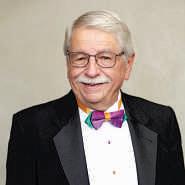














































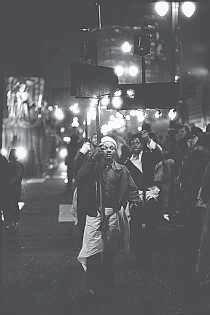






































BY RICH COLLINS Staff writer
Miriam Belblidia loved her palepinkand blue house in New Orleans’ HolyCross neighborhood. But in 2022, after seven years there, she decided she wanted to be closer to the action, alittle farther upriver in Faubourg Marigny At the time, Belblidia’s friends, Thom Smith and Claire Mehling, were renting half of ashotgun doubleinthe Marigny when they learned the place wasgoing up for sale,possibly putting their living situationinjeopardy


Thesolutionthe threefriends foundto solve their twin challenges was once rare but has becomemore common: They pooled their money andbought the North RampartStreet house together,splitting thedown payment and monthly mortgage in half.
With helpfrom theirreal estate agentand title company,the three homebuyers all signed theirnames to the mortgagedocuments,taking shared ownership of the home —and they inked a“prenup” agreement of sorts thatlaid out ground rules that aren’t typicalfor ahome loan. When they closed their loan in May 2022, they were ahead of the curve of what has become anational trend.
BY STEPHANIE RIEGEL Staff writer
New Orleans-based Bisso Towboat Co., afifth-generation family-owned business thatservices ocean-going vessels alongthe Mississippi River,has been purchased by Connecticut-based Moran Towing Corp., the latest of more than half adozen deals in the south Louisiana maritime industryin the past six months. Moran, whichhas afleetroughly
Mississippi River communities for decadestocome,”Moran CEO Ted Tregurthasaid. Bisso has operated for more than acentury,and the salehighlighted the jump in dealmaking in what has long been alegacy of family-
owned businesses operating in this segment of the Louisiana economy. Seven deals have taken place in the localmaritime industry since March, including Bisso and Canal Barge, which both sold to larger firms headquartered out of state. Other transactions have been between in-statecompanies —like therecent purchase of HoumabasedAtlas Marine Services by Baton Rouge-based Loadstar Product Handling Service. And in some cases, locally based companies have been theones doing the buying. In June,Metairie’s MaritimePartners acquireda ma-
In 2024, nearly15% of homebuyers purchased their homewith afriend or relative who wasn’ta romantic partner.Buying this waymeans each buyerpaysonlya percentage of the downpayment and makes it easier to put down the 20% requiredtoavoid private mortgageinsurance, whichcould save hundreds of dollars amonth. Over time, havingmultiplebuyersshare the costs of maintenance, insurance and

Baton Rouge
Patrick Kerr, the president and CEO of Baton Rouge Water, has been tapped to serve as the board chair of the National Association of Water Cos. Kerr a former U.S. Army officer, has previously served as the president of the American Water Works Association and as NAWC’s vice chair
Katherine Clements and Rachael Higginbotham were also named among the newly admitted partners at EisnerAmper
Christopher McFarlain, a former tax auditor for the Louisiana Department of Revenue, also become a partner at EisnerAmper this month. He is based in Lafayette.
New Orleans

Mitchell Ervin has been selected as a new board member for the Greater New Orleans Sports Foundation. After launching his career as an intern with the foundation more than two decades ago, the New Orleans native is now a National Basketball Association official who has officiated more than 400 games over eight seasons.

Jeffrey Thibodeaux has been promoted to area director of operations by Taste Buds Management and Zea Rotisserie & Bar Thibodeaux, a New Orleans native, began his career as dishwasher and went on to work across four restaurants in five cities.


Jones Walker announced two new partners at the law firm’s New Orleans office. Stacey Goff has returned to the firm as a member of the corporate, securities and executive compensation team in the Corporate Practice Group and Katie Lasky has joined the bankruptcy and restructuring team in the litigation practice group.
Corey Jambon, Danielle Keller and Randy LeBeau are among the 31 new partners admitted this month by New York-based accounting firm EisnerAmper
Do you have personnel changes to share or other ideas for our business coverage? Drop us a line at biztips@theadvocate.com

taxes can create significant savings, experts say
“This was an incredible opportunity that fell in our laps,” Smith said. “We didn’t think we could ever afford to buy a historic house with all these great features in the heart of the action. We solved it by having ‘multiple unmarried persons’ on the mortgage, which is a hilarious phrase.”
Setting ground rules
Increasingly this decade, millennial and Gen Z homebuyers have been eschewing the traditional path to equity common for Gen X, boomers and previous generations: a married couple buys a house, paints the picket fence white and lives in it as a traditional family unit.
Instead, young buyers are getting married later, postponing kids and devising novel solutions to increased costs of living and wages that haven’t kept up with inflation
That means they are more open to nontraditional approaches to buying a home, still one of the most proven strategies for building long-term wealth.
In a region of the country where sky-high insurance premiums add to challenges for homebuyers, Belblidia, Smith and Mehling are among those learning the power of pooling resources.
Three years in, the North Rampart Street home ownership experiment is going well, the group says, in no small part due to careful planning and good communication. Smith and Mehling, who got married in 2023, have “semi-regular
meetings” with Belblidia to plan any repairs or discuss problems. They have a shared spreadsheet and an active group text thread to handle day-to-day issues They have referred to their notarized coownership agreement from time to time. It covers big questions: Who’s responsible for maintenance? Who benefits from the increase in value if someone remodels a kitchen? What happens if one owner wants to sell?
“Anybody doing this will want to have everything in writing,” Belblidia said.
Like most owners of century-old New Orleans houses, the trio has had to spend thousands of dollars on upkeep over the last three years, including repairs to plumbing, exterior walls and the home’s foundation. They share responsibility for the property’s exterior and structural repairs but pay for interior renovations individually In some cases, they have decided not to split the cost three ways, but to recoup investments if and when the house is sold.
“We will cross that bridge when we get there,” Mehling said.
Smith, who was initially skeptical about the idea, said there were early challenges to getting the paperwork done because the system is largely designed for single homebuyers or romantic couples. Real estate agent Katie Witry, who has sold several houses to groups of friends, and Crescent Title helped make the deal happen.
Now, the three buyers have fallen into a rhythm that is both comfortable and comes with built-in advantages. They take care of each other’s pets, take turns scheduling and meeting with contractors and still enjoy socializing with one another
“We see each other several times a week, coming and going at the same time, or hanging out in the backyard,” Smith said.
From L.A. to La.
A few miles upriver from the North Rampart Street house, another group of friends is nearly three years into co-ownership of a shotgun double near the corner of Napoleon Avenue and Magazine Street.
Judging by the festive atmosphere during a communal dinner earlier this week, the arrangement is paying off.
As one of the four homeowners chopped ingredients for chicken curry, others showed off the home’s new features, including a stylish new half bathroom, several pieces of restored furniture and a custombuilt pool out back surrounded by tropical foliage. On the kitchen floor, an oversized faux marble bust served as a conversation piece. Three well-behaved dogs enjoyed the commotion from beneath the kitchen island.
As the pandemic was winding down, the two couples Ken and AC Kabukuru, and Brent and Julien Kyle-Rivière decided to leave Los Angeles and make a new home base in New Orleans, using a job offer for Julien Kyle-Rivière as an excuse to start over in a more affordable city
“We always thought it would be a dream to get a place together but the prices in L.A. are high,” AC Kabukuru said. “We chose New Orleans because of its culture.”
The friends selected the Constantinople Street house for its floor plan and near-perfect “walkability score,” meaning it’s close to many restaurants, bars and stores. They
wanted to live close to each other but to have some level of independence and, especially, to have their own kitchens.
“We didn’t even know a double shotgun existed before this,” Ken Kabukuru said. “But this is exactly what we were looking for.”
The only way the deal could work for everybody is if they teamed up to buy the place together paying $595,000. Julien Kyle-Rivière was the first to move to the city, so the others gave him power of attorney
All four contributed to the 20% down payment and, because they were splitting it, were able to cover the entire amount. As a result, they have saved nearly $700 a month in private mortgage insurance payments.
They split the monthly mortgage and share expenses, including the cost of the new gutters and fence and a remodeled backyard.
“It makes it a lot easier to live the dream when you can split it four ways,” AC Kabukuru said. What they didn’t do was sign any extra paperwork.
“We just put our names on the title,” Kabukuru said. “It’s not an inexpensive house, so the mortgage is real. If someone was not able to pay, it would be a problem, but we’ve known each other for so long that we trust each other.”
Now the friends joke about adding a passageway in the wall that separates their kitchens so it will be easier to share ingredients when they’re cooking on their own.
Kabukuru said that, overall, there have been far more pros than cons.
“It’s been smooth sailing so far,” she said.
Email Rich Collins at rich. collins@theadvocate.com.
rine transport company based in Seattle. A month later, Host, which relocated its corporate headquarters from Virginia to Avondale Global Gateway in 2023, purchased a West Coast shipping agency and port operations firm to add to its growing presence at the former shipyard site.
“There is a lot going on in industrial services, and especially in the marine and logistics sectors,” said Gay LeBreton, managing director of Chaffe & Associates, a local investment banking firm that tracks mergers and acquisitions.
While each deal is unique, LeBreton said a couple of common factors are behind much of the recent activity One is a growing petrochemical sector across south Louisiana, which is fueling interest in maritime transport and logistics companies connected to it.
The other is pent-up demand from investors who held on to their cash in the early months of President Donald Trump’s administration and are now looking for deals.
“There is a lot of dry powder out there,” LeBreton said. “Investment funds that have been held, or not deployed as quickly as they usually are, need to get out in the market.” Legacy business
Like the Canal Barge sale the Bisso deal marks the end of an era in a local maritime industry that once was home to global powerhouses like Lykes Bros. Steamship Co., International Shipholding Corp., Transoceanic Shipping and

Tidewater. Since the 1990s, the shipping companies have gradually sold, gone out of business or moved away Until recently, however, the tug and barge operators that serviced the massive oceangoing vessels were still based in New Orleans.
Bisso Towboat was among them and is the oldest continuously operating tugboat company on the Mississippi. It was founded in 1890 in New Orleans by Capt Joseph Bisso, great-great-grandfather of the company’s current president, Scott Slatten. At the time of the sale, the company had a fleet of 10 “tractor tugs,” super-powerful tugboats capable of helping massive ships maneuver on the swift-moving river While the sale is the end of local ownership of the company, it
doesn’t mean the loss of jobs or towboat activity along the lower Mississippi. Slatten said in a prepared statement that selling his family’s company was the best way to ensure “a continuous investment in the long-term health and growth of the business.”
He did not return calls seeking comment.
Like Bisso, Moran is a familyowned business with roots dating back to the 19th century It has a fleet of more than 100 barges and towboats that service 17 ports along the East and Gulf Coast and seven liquefied natural gas terminals. It also has an environmental and industrial services division and does marine construction.
Tregurtha said Bisso was a “perfect complement” to the company’s
existing operations in New Orleans and “allows us to advance to a far more modern combined fleet in New Orleans more rapidly than just adding one tug at a time.” New Orleans as a logistics hub
The recent spate of M&A activity in the local maritime sector is part of a larger national trend. In the early months of the Trump administration, deal volume was down due to uncertainty around tariffs, trade and the effects of immigration on the national economy, national reports show While it’s still off about 10% compared with last year at this time, LeBreton said local activity is picking up.
“Now that they have passed the Big Beautiful Bill, there is a tax cut coming and a lower effective cost of capital and people are looking at that,” said LeBreton, who predicts deal volume will continue to increase through the first half of 2026. “Our firm has been incredibly busy.”
Deals in the manufacturing and industrial sector, including maritime and energy, are particularly attractive, according to a report by PMCF, a national investment banking firm.
“Across capital-intensive sectors like industrials, oil and gas, and chemicals buyers are focusing on transactions that offer geographic expansion, product diversification, and cost efficiencies,” the report says. David DeLaureal, managing partner of private equity firm Carr’s Hill Partners, said New Orleans’ location and transportation infrastructure create fertile ground for growth in industrial subsectors
such as maritime logistics, energy services and transportation.
In July his firm purchased a majority stake in Freedom Intermodal, a local company that provides tank and rail services for bulk liquids customers. The deal, though different in many respects from the sale of Bisso or Canal Barge, was driven by some of the same factors that made both of the legacy companies attractive targets.
“New Orleans is only one of just two cities in the U.S. that all six Class 1 railroads connect to, with Chicago being the other,” he said. “When you think of that in the context of our existing port activity and the new port activity coming online, there is an opportunity to play a role in critical supply chains.”
LeBreton also sees opportunities in emerging sectors. One of the deals this year that her firm tracked was the acquisition of Gulf Craft, a Franklin shipyard, by Saronic. The Texas-based startup plans to manufacture autonomous vessels for military and commercial clients at the site, creating hundreds of jobs in the process.
“I think there is an interesting trend to watch in the defense and maritime industries in Louisiana, with transactions like Saronic and some of our traditional companies that are making unmanned vessels and drones,” she said. “I think that is going to change the nature of what our shipyards are doing and reverberate back to our suppliers.”
Email Stephanie Riegel at stephanie.riegel@theadvocate. com.
BY JONAH MEADOWS Staff writer
When restaurateurs need to resupply,they call on companies like S&W Foods. The familyowned food service distribution company counts local resta urants, regional coffee shop chains and public school districts among its 1,000clients
Second-generation owner Paul Spalitta has led the 47-year-old Tangipahoa Parish business through two decades of growth— morethantripling its revenue to $80millionduringthattimeand expanding its clientelebeyond southLouisiana along theGulf Coast into Florida.
Despite amassive drop in business during the height of the coronavirus pandemic,Spalitta managed to broaden S&W’s customer base, in part, by buying his employees’ lunches from local restaurants andthenpromoting them on social media.
More recently,heoversaw S&W’s$25 million move into a Hammond facility five times the size of prior headquarters. Today, he runs the company with his two daughters. In this week’sTalking Business, Spalitta explains how he’sguided the 125-employee business’sgrowth while staving off competition from “Goliaths” in the industry
This conversation has been edited for brevity and clarity
What led you to realize you need to expand, and then, what were the challenges?
We really started scaling up the company back in 2016-17. Almost daily,myoperations manager would come into my office, “We

good food is agiven in arestaurant—you have to have that thething that you have to understandwhenyou open arestaurant: It’sabusiness. Iremember Iusedtoride on trucks making deliveries, and someofthe things that Isaw years agocertainly would never fly today,and so Ithink the level of professionalismofthe independent operators has certainly increased.
How much do you think theCOVID pandemic changed theindustry?
Alot of restaurants scaled back theirmenus, with not as diverse of aproduct offering as theydid before. Alot scaled back their hours, and those things have stuck.
management team. So Iquickly realized that Igot to have some help, andsoI started hiring people to help me with that. And throughoutthe years, we have built atremendous leadership team.
I’m very blessed that Ihave strong people around me.Fortunately,I’ve gotpeople alot smarter than me around me, and that’s what Ineed. Ioften say it, but if I’m the smartest guy in the room, we’re allintrouble
What do you think is differentabout working with family members, being their boss or having them be your boss?
won’thave enough space at the warehouse.” He said,“You’ve got to slow down.” I’m like,“We’renot slowing down. Figure it out.” Iknew we had to do something, so back around 2018-19, we found some property and got allthe plans done for abrand-new facility.Bythe time we got allthat done, it was mid-2020. Iwas anticipating acostofabout $15million. Thecontractor comes back and says, “Oh, this is gonna be $27 million.” We couldn’tdothat, so I tabledit.
Overthe next year,abig retail distribution center in Hammond went out of business, andwe started negotiating with them. Thefacilitythat was 21/2 times the size of what Iwas going to build waymore space than we needed —but Iknew we would figure it out. And that’swhat areal focus is now: How do we continue to push forward and grow thebusinessto use the capacitywehave here?
How do you see your business changing in
the coming years? As part of this new facilityand thenew capacity that we have, we’relooking at increasing our presence withnational chains
To do that, there are certain requirements and one of the ones that most national chains require is athird-party audit —you have to have someone come in andinspect your facilitytomakesure that it’soperating in asafe, food safety mannerand your business practices are clean and sanitary. We are very excited and pleased that we recentlywereaccredited by theAmerican Institute of Bakers, whichisgoing to allowusto do business with the bigger national chains and to rapidly scale andgrow
Separately fromhow your businesshas changed, how has the industryatlarge evolved over the years? So many times I’ve seen people open restaurants because they think they makeagreat gumbo or barbecue or whatever it is. While
Ithink operatorsrealize,“Ican do this, and Idon’thave to work 90 hours aweek,” andsothey certainly realize that quality of life is important. Andthe negative side of that is the fact thata lotof their employees realized the same thing, and it’sbecome arealchallenge in the restaurant industry
Employeesare achallengeeverywhere, but it’s an entry-level employeejob for most of them, andmaintaining proper staffing levels is achallenge. Sometimes thewait timesare longer,and you don’tget quitethe serviceyou usedtoget. Ithink that’spart of thepermanent change.
Do you find yourself working 90 hours aweek? How do you balance business responsibilities withneeding time and space for yourself?
Well, the good thing about our business is thatit’sfive days a week, it’s Monday through Friday So Iget the weekends off, and I enjoy and cherish that time off with my family Back in 2006, basically my mother,myfatherand myself ran thecompany.Whentheyretired, there just walked out66% of the
I’m blessed to have two of my daughters involved in the company with me,grooming them to take over this business in the future. They,like myself, grew up around thebusiness.Our family vacations were plannedaround businesstrips wherewewould go to conventionsand things like that.
It’salot of fun and good times, but it also hasits challenging moments. Sometimes family members don’tsee eyetoeye, andthat presents challenges, but you work through it.
Ithink there’sanadvantage to being afamily business andanindependent company because most of ourcompetitors are big national companies, and so we compete against giants.
We’redefinitelythe David in this Goliath story —and whatour customers like is the fact thatwe are muchmore nimble andflexible,weprovide outstanding customer service. And most of my customers are friends of mine, people thatI’ve been knowing for many yearsand just have agreat time doing business with. EmailJonah Meadows at Jonah.Meadows@theadvocate. com.


uled to open in 2028 if it overcomes permitting hurdles.
BY ANTHONY McAULEY Staff writer
The Port of New Orleans and the Louisiana Department of Transportation and Development have signed an agreement to advance the long-discussed St. Bernard Transportation Corridor — a proposed elevated highway that would link the planned Louisiana International Terminal in Violet to the interstate system.
The project, expected to cost around $1 billion, is seen as critical to handling the thousands of trucks that will serve the new container terminal, which is sched-
Port and state officials say the new road would also improve local traffic flow and provide a hurricane evacuation route.
“This project addresses both the economic and safety needs of our state,” said DOTD Secretary Glenn Ledet, calling it a “strategic link between our international trade system and our communities.”
The agreement comes five months after the New Orleans Regional Planning Commission released its long-awaited feasibility study outlining several potential routes, all involving an elevated expressway over the Central Wetlands. The most favored option would connect directly from the Violet terminal to Paris Road and
onto the interstate.

Port NOLA President and CEO Beth Branch said the partnership with DOTD marks “an important milestone” in moving both the terminal and corridor forward “with one unified vision for our region’s future.” Still, the road — like the multibillion-dollar terminal project it would serve — remains controversial. The new terminal has long been considered crucial if New Orleans wants to continue to compete for international container ship business as vessels grow ever larger. Advocates also have said the facility is

needed to attract new manufacturing and distribution investment to the region.

Many St. Bernard Parish residents and leaders, however, continue to oppose the terminal’s location, warning it will bring truck congestion, noise and wetlands destruction. St. Bernard Parish President Louis Pomes has said he is “firmly opposed” to the terminal but wants a say in which road alternative is chosen if it moves ahead. “If we lose that fight, we refuse to leave our people exposed,” he said in May The terminal itself is still await-
ing key federal approval. The U.S Army Corps of Engineers held a public hearing in May as part of its environmental review under the Clean Water and Rivers and Harbors acts, taking written comments through early June The Corps is now reviewing those submissions and could issue a decision later this year, according to Port NOLA officials. Until the Corps signs off, construction on the terminal — and any related road work — cannot begin. Port officials plan to seek a private partner to finance and operate the elevated road as a toll facility, with DOTD providing technical support and oversight of required federal environmental studies. Email Anthony McAuley tmcauley@theadvocate.com.




BY CAROLINE PETROW-COHEN Los Angeles Times
Every year, Ventura County, Cali-
fornia, resident Carlos Soto buys a Liverpool Football Club jersey for his son to celebrate the start of the soccer season. This year it was delivered with an additional bill of $107.
“The UPS guy said he couldn’t release it unless I paid more,” Soto said. “Until this tariff thing started, I’ve never, ever had a bill on top of my purchase.”
Soto declined the payment and requested a refund for the jersey, which he bought from the team’s official website for around $150.
Since President Donald Trump reversed a decades-old tariff policy in August known as de minimis, online shoppers like Soto are sometimes getting hit with high, unexpected extra charges.
De minimis used to allow goods valued at less than $800 to enter the country duty-free. The tariff exception applied to more than 1.3 billion packages sent to the U.S. from overseas in 2024, according to U.S. Customs and Border Protection.
Social media is full of reports of individuals struggling with surprise bills for their deliveries. On Facebook and elsewhere, buyers are venting about hundreds of dollars due on mouse pads, makeup and bridesmaid dresses. One person on Reddit faced a $4,700 fee on a specialized desk chair from Bulgaria.
While the new fees are often already baked into product prices, some goods land in America without the tariffs being paid. That’s when the person receiving the package is expected to fork over the difference.
Package delivery companies have been scrambling to educate consumers about the new tariff regime, but still, some are surprised. UPS, FedEx and DHL have each posted frequently asked questions and resources online to support customers who may owe tariffs on their items. Large numbers of customers are calling with complaints

“It’s
kind of awkward how the fees are collected. There’s not a lot of clarity on who’s collecting them and where
they’re going.”
DAVID HERR, of Washington, D.C.
or confusion when presented with unexpected bills — UPS said it is working through a backlog of brokerage-related issues.
“Our brokerage services are designed to ensure shipments comply with regulations (and) pay necessary duties and taxes,” UPS spokesperson Jim Mayer said. “If the shipper or receiver have not paid these costs, UPS generates a bill so the shipment can be released by Customs and Border Protection.”
Mark Hartlidge, a small package compliance manager at UPS, called the changes this year a “rollercoaster ride” in one webinar hosted for customers.
“If you import anything to the United States, you most likely have been impacted,” he said in July “These changes can be very difficult to understand.”
While large companies and online retailers have the staff and infrastructure in place to make the transition smoothly, smaller businesses that export directly to the U.S. are sometimes failing to inform consumers about the extra costs and when they are due.
Washington, D.C., resident David Herr, who restores classic cars, recently ordered an auto part from Belgium for about $200.
“I knew I was going to have to pay some import fee, but I had no idea what it was going to be,” Herr said. “I didn’t know if that was included in the price, or if that was going to be collected by customs or somebody else.”
When Herr’s package arrived via UPS, the delivery driver presented him with a hefty charge of $493.
“It’s kind of awkward how the fees are collected,” he said.




“There’s not a lot of clarity on who’s collecting them and where they’re going.”
The popular fast fashion website Shein, which is based in Singapore, advertises a guarantee that the price at checkout is the final price for the product.
“There’s lots of chatter about tariffs, but here’s why you don’t need to worry about paying anything extra after checkout,” the Shein website says.
Temu, another low-cost online retailer that previously relied on de minimis, states on its website that for its customers, there are “no import charges for all local warehouse items and no extra charges upon delivery.”
De minimis, which is Latin for something of little importance, dates to 1938 when Congress passed the exception to boost trade and save the time of inspecting and calculating taxes on every package.
Lawmakers increased the dutyfree threshold from $1 to $5 in 1990
Since President Donald Trump reversed a decadesold tariff rule called de minimis in August allowing shoppers to buy goods valued at less than $800 to enter the country duty free, some package delivery companies have been having to collect the balance at the door
and again to $200 in 1993. Under the most recent threshold of $800, the number of packages entering the U.S. duty-free had skyrocketed.
Trump has called the rule a “scam” that weakens American businesses and allows dangerous goods to enter the country without oversight. Packages that claim the exemption are not inspected as thoroughly by U.S Customs personnel.
Trump ended the loophole for goods sent from China in May before eliminating the practice for goods from all other nations in August Documents and gifts under $100 are still exempt from import taxes. Soto in Thousand Oaks decided to search for a Liverpool jersey in California. But he’s still waiting for the refund on the jersey he sent back.
“When it comes to politics and government, I’ve always kind of turned away from it,” he said. “But this time it actually hurt my pocket.”

Ibelong to acommunityof writers whose mission is to help others manage their money, avoid unscrupulous financialprofessionals, protect themselves from scams and save enough to retire with as little budgeting stress as possible.
Amember of this cohort,Jonathan Clements —aformer personal finance columnist for The Wall Street Journal and founder of HumbleDollar.com —died Sept. 21 ofcancer at the ageof62. Although alongtime reader of his writing, Imet Clementsonly once, two years ago, at a“Bogleheads” conferenceinMaryland Iwas invited to speak on apanel with my husband and two youngadult daughters on how to make investing afamilyaffair
Clements, who wasalsospeaking at the conference, was kind, funny,engaging, and he spoke withasimplicity about investing that Iadmired. We weretwo of a kind.
Bogleheads arefollowers of John C. “Jack” Bogle, who founded the Vanguard Group 50 years ago and is recognized as the father of the index fund.This simple, low-cost, buy-and-hold investment strategy has helped many regular investors achieve financial success, some even be-
Fool’sTake: Apfat dividend yield


comingmillionaires. Clements wasone ofthe leading and early advocates for thistype of investing, which is just right for those of uswho live alife of frugality ABogle bobblehead sits on my bookshelf likeatalisman —a giveaway forthe book “The Bogleheads’ Guide to Investing.” (Fulldisclosure: Iown Vanguard mutual funds in my401(k) plan.)
In theforward to “How to Retire,” abook Ireviewed last year, Clements wrote: “When Istarted thinking about retirementinmy 20s andearly 30s, Iviewed it as a simple financial endeavor: Save like crazy for three or four decades, slap a4%withdrawal rate on theaccumulated savings, and then head off fora life of fun, fun, fun. Ah, the embarrassingignorance ofyouth.”
The cancer —diagnosed in May 2024 —would upend his best-laid plans. Buthecandidly shared histhoughtsondealingwith the realization that hewouldn’tget to
this big drugmaker than meets the eye.
spend much of themoney he had saved and invested.
“What if you were toldyou had ayear to live?” he wrote in acolumnfor The Washington Post in August 2024. “Life coaches sometimes pose questions like this to help folks figure out what’s truly important to them.”
Iread that and thought: “What would Ido?”
Would Ispend down all mysavings to squeeze in all the things I had promised myself Iwould do once Iretired? Could Ifinally conquer my “spendphobia?”
Iamgetting better at treating myself to someluxury items, but not without fear of having less funds should Ineed long-term care.
Iadmire how Clementsdecided to share his journey with readers. He gave us, me, aroad map to accepting what can’tbechanged.
Near the end of his life, Clements didn’tdothings much differently.Hechose not to try to cram 20 years or more of bigticket things on his bucket list into the16months he had after his diagnosis.
He and his wife, Elaine, decided to go forward withseveral trips, but mostly he planned to “squeeze as much happiness” out of the days thedays he had left, Cle-
ments saidlast year on apodcast with Christine Benz, director of personal finance andretirement planning for Morningstar
“I like the way Ispend every day,” he said. “Life is full of small pleasures. That first cup of coffee, exercising, going out to lunch with friends, working, writing and editing that Ido, sitting down in the eveningand having aglass of wine with Elaine. That’swhat makes thedays enjoyable forme. Andagain,I’m not inclined to change that at this late stage.”
Benzpressed him gently on purchasing business-class tickets for his air travel
“Even though you realized you should splurge, you pulled back because of the expense,” she said.
“Can you talkabout adecision like that, how you’re marrying your thrift with your desire to really make sure that you enjoy the time that you have?”
He stayed true to his nature, weighing the costs.
On one flight to London, he upgraded from premium economy to aflatbed foranextra $1,064.
“The price wasright,” he said.
Buthebalked at doing the samefor atrip to Paris. The cost: $3,300.
“Yeah, Ican’tget over that hurdle, unfortunately,” he told Benz.
“The price is not right.”
As he explained, his shortened lifeexpectancy didn’tderail his penny-pinching ways.
“The reason Ihave ahealthy portfolio today is not because I wasabrilliant investor,” he said.
“I’ve spent my entire lifeasan indexer.The reason Ihave a healthy portfolio today is because Ihave historically been agreat saver,the No.1financial attribute forfinancial success.”
He wasunapologetic about his frugality without judging others whodecide they have saved to afford comfort when they thought it wasright. Money can buy happiness, but so can saving.
“I have aseven-figure portfolio that wassupposed to pay formy retirement, but will instead help pay forthe retirement of others,” he wrote in the column forThe Post. “I could, of course, go on a glorious spending spree —firstclass travel, luxury hotels, fine art. But after alifetime of thrift, that sort of spending would make me uncomfortable, plus I’dbe taking money from Elaine and my twochildren, and whywould I want to do that?”
Email Michelle Singletary at michelle.singletary@washpost. com.


Pfizer’s(NYSE: PFE)sales of COVID-19 products are at only afraction of their levels from afew years ago. Meanwhile, the company faces the loss of patent exclusivityfor many drugs —including Inlyta, Xeljanz, Eliquis, Xtandi, the Vyndaqel brand family,and Mektovi —over the next three years.
Pfizer may seem like apoor investment, despite its recently very low forward-looking priceto-earnings ratio below 9; however, there’sabetter story to
Pfizer’ssales for the products losing exclusivity won’t dryup overnight.More important, the company has multiple products thatshould generate strong growth, including bladder cancerdrug Padcev,multiple myeloma drug Elrexfio and respiratory syncytial virusvaccine Abrysvo.
Anddon’tforget Pfizer’spipeline:Itfeatures 108 candidates, 28 of which are in phase3latestage testing. Another four await regulatory approvals. It’s also growing by acquisition, recently aiming to buy Metsera, acompany that has four weightloss drug candidates.
Finally,Pfizer’sdividend yield —recently around 7.1% —helps
boostthe stock’s total return significantly.While Pfizer does face some challenges, its dividend can compensate long-term investors for those risks. (The Motley Fool owns shares of and recommends Pfizer.)
Ask the Fool: Deflation dangers
What, exactly,isdeflation? —B.S., Draper,Utah It’sthe oppositeofinflation,and it’s what you call an economic environment where prices have been falling. That means your income will buy you more goods and services,but it’s not all positive —and deflation can be worse than inflation.
Deflation generally occurs when demand falls and supply
increases.Supply increases when productioncosts drop, often due to technological advances.Demandcan fall when consumers areworried about theeconomy andchoose to spend less andsavemore; overall pessimism can also lead to lessspending. Deflation is dangerous because when prices arefalling, consumers may put offpurchases, hoping for even lower prices, which causes the economy to slow down. Aslowing economy can lead to joblosses and rising unemployment, and when companies have less moneycoming in, they’re less likely to invest in further growth. Wages can be reduced as well, and businesses and people earning less money can have trouble paying off
their debts. All this could turn into avicious cycle—and asevere recession.
Deflation-fighting movesinclude injecting more money into the economy (whichcan spur inflation) andlowering interest rates. What are“catastrophe bonds”? They don’tsound likesomething I’dwant to buy.— E.G.,Washington, Pennsylvania Oftenreferredtoas“cat bonds,” they’re bonds sold by insurance companies to help themcover the costs of catastrophessuchashurricanes or earthquakes. These bonds offer relatively high yields anddiversificationfor your portfolio, but youcould lose your entire principalifa predefined event occurs within the (typically multiyear) life of the bond.

BY JONAH MEADOWS Staff writer
From its shipyard just past the floodwall in New Orleans East, Textron Systems designs, builds and tests the latest in hovercraft technology
Workers there take in 40-footlong sheets of raw aluminum, cut them into components build up subassemblies and put together watertight hulls before flipping them over and adding the modules on top The whole process takes about two years before the hovercraft head outside and undergo the rigorous set of trials required by their U.S. Navy purchaser.
Over the past five years, Textron has completed 15 next-generation hovercraft — called Ship-to-Shore Connectors — with plans to build another 54 at its 47-acre Chef Menteur Highway plant The company also operates in Slidell and at the Michoud Assembly Facility
The division of Rhode Islandbased Textron Inc., a publicly traded multi-industry conglomerate with nearly $14 billion in annual revenue, also produces armored personnel carriers, unmanned vehicles and various weapons systems. But the focus for the more than 600 workers at its New Orleans shipyard is building the high-tech, air-cushioned amphibious landing crafts at a rate of four per year
The Textron plant’s location outside the levee protection system in Bayou Sauvage provides distinct advantages — the ability to easily “fly” the amphibious military vehicles to Lake Pontchartrain to conduct simulated missions or out onto the Gulf for delivery to the Naval Surface Warfare Center in Panama City Florida.
The environment also comes with some hazards, including storms and flooding.
Then there’s the threat of alligator intrusion. Gators can regularly be found sunning themselves outside the plant, according to Ryan Schaffernocker, senior vice presi-


dent of marine systems.
One such reptilian trespasser traipsed into the shipyard late one Sunday last year after most workers had gone home.
“We caught him on security camera walking into one of our buildings,” Schaffernocker said.
“Our morning shift came in on Monday and started working and hearing that hissing sound that they make when they feel threatened.”
The occasional surprise alligator is a small price to pay for direct water access, engineering tal-

Beyond isn’taplace —it’samindset. Andit’sabelief that haspowered us forover80years.Weare Jones Walker LLP,afirm driven by an entrepreneurialspirit, a deepsense of community, andafierce determination to deliver exceptionalservice andvalue forour clients.
Since1937, our firm hasbeencommitted to workingwith communityleaders to develop business opportunities across thestate.Weare steadfastincontinuingour dedicationto go beyond in advising clientsand supporting initiativesand organizationsthatmake Louisiana abetterplace to live andwork.
WilliamH.Hines
Managing Partner bhines@joneswalker.com 504.582.8000
201St. CharlesAvenue NewOrleans,LA70170-5100 joneswalker.com
Attorney Advertising. No representation is made that thequality of legal services to be performedisgreater than thequality of legalservices performedbyother attorneys. LA-25-19274
ent and a supply of skilled tradespeople like shipfitters, machinists, electricians and welders, of which there are 100 working at the New Orleans plant.
The new generation of hovercraft replaces the Landing Craft Air Cushion, the decades-old model of amphibious vehicles — also made in Louisiana by Textron — used by the Navy to deliver Marines and their equipment to shore.
Since 2012, Textron has received more than $2 billion in government contracts to develop and build the next-generation hovercraft. Its most recent contract, awarded in June, called for three craft at a cost of $118 million each, not including the cost of components like the engines, skirt and other composites that the government provides prior to assembly
What does that buy? A 92-footlong vessel capable of carrying 74 tons, enough for an M-1A1 Abrams tank equipped with a mine plow, the heaviest cargo the Marines ever need to land. An SSC can also carry up to 150 fully
equipped troops when it has a personnel transport module installed.
“What’s great about having a hovercraft is you can access over 70% of the world’s coastlines, because you’re flying,” Schaffernocker said. “You’re flying a very small amount over the surface of the water You go right up on the beach, drop your ramps, offload your cargo, and then go back to the ship for another load. You don’t have to worry about things like coral reefs or obstacles.”
That versatility is especially valuable for logistics in humanitarian assistance, disaster response or resupply missions.
While the SSC comes equipped with mounting points for weapons, its primary role is a noncombat one.
Schaffernocker said Textron designers swapped in a more corrosion-resistant aluminum composite, as well as a new electronic flight control system to address one of the biggest problems with the previous generation of hovercraft: training pilots to operate the craft.
“There was a very high fail-out rate, so the new fly-by-wire computer system takes a lot of the guesswork and a lot of the challenges that came along with training those sailors,” he said “Essentially, a computer does a lot of the work for you.”
Future versions of the hovercraft will likely have the ability to pilot themselves, although selfdriving is not yet a requirement of the Navy’s hovercraft procurement program, Schaffernocker said.
“We have a lot of engineering background, a lot of heritage, a lot of intellectual property around what it takes to uncrew a vehicle,” he said. “I certainly see that as part of the future for the program.”
Email Jonah Meadows at Jonah.Meadows@theadvocate. com.
Drivingregionaleconomicgrowththrough legalknowledge,strategic guidance, andindustry-focusedpartnerships.
Ourfirm is optimisticabout Louisiana’seconomicfuture, particularly in oiland gas, sustainableenergy,digital healthcare,and technology.As thestate advances in energy transition andinnovation, businesses must navigate evolving legal landscapes.Our affiliate, AvidentAdvisors,supportsthistransformation by providingstrategic site selection andinvestment guidanceacrosskey sectors, includingcarboncapture, ports, sustainableenergy, andadvanced manufacturing. With strong momentum andexpanding opportunities, Louisiana is poised forsignificanteconomicgrowth—and we areproud to help lead theway forward.






































































•NMLS684734
•Beth.Holden@hancockwhitney.com
•NMLS699394
BEECHAM
HANCOCKWHITNEY
225-248-7428 •Nathaniel.Beecham@hancockwhitney.com
HancockWhitney.com/Nate-Beecham •NMLS115300
225-603-2505 •Jared.Gary@hancockwhitney.com
HancockWhitney.com/jared-gary •NMLS88626
TIMDUBNANSKY
HANCOCKWHITNEY
225-252-6976 •Tim.dubnansky@hancockwhitney.com
hancockwhitney.com/tim-dubnansky •NMLS82027


JUDE BRIDWELL HANCOCK WHITNEY
225-603-1777 •Jude.Bridwell@hancockwhitney.com hancockwhitney.com/jude-bridwell •NMLS 92661
JEREMYWEIMER
HANCOCK WHITNEY 225-978-2592 •Jeremy.Weimer@hancockwhitney.com hancockwhitney.com/jeremy-weimer •NMLS 175288
BILL HOLT
HANCOCK WHITNEY 225-229-8783 •Bill.Holt@Hancockwhitney.com hancockwhitney.com/bill-holt •NMLS 148394
ANGELLEWIS
HANCOCK WHITNEY 225-413-6094 •Angel.Lewis@hancockwhitney.com hancockwhitney.com/angel-lewis•NMLS 700876
MICHAELHEBERT
HANCOCK WHITNEY 225-715-1133 •Michael.Hebert@hancockwhitney.com hancockwhitney.com/michael-hebert •NMLS 79769





ANYONE knowingthe whereabouts of Marrion Jerome Daniel,orhis/her relativesordescendants please contactEthel Clay,Attorney at Law, (225) 906-0435. 162391-10/11-12-13-3t $97.00







tural)zoningdistrict, witha newprivate ac‐cessand utilityservi‐tude. (Applicants: Brady & Lauren Wilson,for Gre‐goryScott Wilson) Zoning Commission PD25-04-D& Z25-05 PlannedUnitDevelop‐ment

















































































































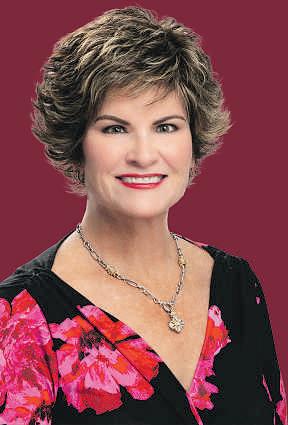


Yes, knowledge is power, and thechoice is yours. But you MUST ACTNOW to put your estate plan in place. It all starts by attending one of LauraPoche’s free educational eventswhich makes it clear that regardless of your networth,ifyou want to preserveyourhard-earned assetsorhavepeople in your life you need to protectorhavecauses that youwanttopromote, EVERY PERSON NEEDSALEGAL ESTATE PLAN. Let LauraPoche and her professional and knowledgeable staffmakethis process as easyaspossible so youcan livewith PEACEOFMIND.
BATONROUGE
Monday,October20 Poche LawOffice
4960 Bluebonnet,Ste.C 2:00pm -4:30pm REFRESHMENTSPROVIDED AFTER
BATONROUGE
Tuesday,October21
Mestizo’s
2323 SAcadian Thruway 11:00am -1:30pm LUNCHPROVIDED AFTER
BATONROUGE
Wednesday,October22 Poche LawOffice
4960 Bluebonnet,Ste.C 5:30pm -8:00pm DINNER PROVIDED AFTER
BATONROUGE
Thursday,October23 Poche LawOffice 4960 Bluebonnet,Ste.C 9:30am -12:00pm LUNCHPROVIDED AFTER


• Howcan Ikeep the governmentout of my estate settlement?
• What arethe twobiggest andmostexpensivemistakesfamiliesmakewhen trying to avoidnursing home poverty?
• Howcan Ikeep my not-quite perfect son-in-law and my over-controlling daughter-in-law from having influenceovermyestatesettlement?
• Howcan my family avoid estate tax, and other taxestheymightfacewhen Ipass away?
• HowdoIstart the five-year look back period fornursinghomeswithout having to giveeverything away to my family whileIamalive?
• Whydomostlawyerslove Probate, and want my estate to go through it?
• Should IhaveaWill or Trust(or both)?
• Canmypatchwork quiltofWills,Powers of Attorney, Living Wills, and Beneficiary Designations actually be atime bomb waiting to explode?
• HowdoIkeep my estate plan up-to-datewithout it costing afortune when my life circumstances changeorwhen the law changes?
• HowdoIensurethatmy estate won’tincur legal expensewhen Idie,preserving 100% of my assetsfor my family?

If youhaveeverwantedtoeliminateworry becauseyou don’t havea program in place to protectyourestateand family,without aslewof untimely legaland taxproblems,thenthis will be one of the most important workshops youeverattend.I am going to showyou howtobulletproof what youhavetoday, and whatyou leaveyourkids tomorrow.You’llbeable to take advantageofmyestateplanninglegalstrategieswithout youoryour lovedoneshavingtodeal with Succession Courts,long estate settlement delays,Medicaid liens,nursing home poverty, and death tax. But before Ido that, letmetell youastory of howwehelped Mary.
MARY’S STORY
“Asacouple with an only child, we thoughtaWill wasall we needed. WRONG! My husband died, and Ihad to go through Probate-anightmare, andvery costly.Italsotook over9 months.I didn’t want ourchild to go through that, so Igaveher an ad to aPoche’Law Firmworkshop,and sheand herhusband were impressed. They had Lauraset up aparticular kindofTrust that took care of their estate planning, butwhat aboutme? Idecided to go to aworkshop,and made my appointment.Lauraansweredall of my questions, andevengot my financial advisor in on aconferencecall. Icould nothave been morepleasedand relieved that my estate plan is nowinorder.Kudos to Lauraand her professional staff. Ihighly recommend her forall estate planningneeds.”
Mary,Baton Rouge, LA
Workshopsare open to FIRST-TIMEATTENDEES ONLYand aregearedtowards people whowant or need your legal estate plan in placequickly Pleasehaveyourpersonal calendarhandy at the workshop so youcan choose to startyourplan NOW! If married, both spouses mustattend a workshop to ensurethat alldecision-makers are involved in your family’scoordinated plan
All people who attend willreceiveaFREE copy of theupdated2nd edition of LauraPoche’s Book, “Estate Planning AdvicebyaWoman forLouisiana Women: AGuide forBothMen and Women About Wills,Trusts,Probate, Powers of Attorney, Medicaid, Living Willsand Taxes.”





BY MARGARET DeLANEY
Staff writer
When Adam started kindergarten, histeacher could tell he was behind The other kids could color inside the lines. The other kidscould identify red objects. Adam could not.
“He was my first child,” said Adam’s mother,Missy Ward.“I had no one to compare him to.”
Then,Adam started having bathroom accidents. He started falling.
After the liver transplant in February 1995, Amanda tested positive for Niemann Pick Disease type C, arare, inherited genetic disease that affects the body’sability to transport andprocess cholesterol and other fatty substances inside the cell.
“It’sbeen special to tell our family’sstory. We hope itcan help others heal and know that they’re not alone.”
MISSy WARD
“He would trip over in the mall,” Ward said.“Likeamarionette —withoutthe strings, thepuppet just falls. It would be like that.”
At the same time, the newest addition to the Ward family,Amanda,was in and out of the hospital.
Amanda was born withcystic fibrosis and an enlarged liver,a condition that required her to have aliver transplant when she was 4monthsold.
Niemann PickCis progressive andneurodegenerative, presenting as delayed child milestones andlossof muscle quickly.Other symptomsinclude clumsiness, learning difficulties,difficultyswallowing, slurred speech and seizures.
At 6, after ayear and a half of symptoms, frustration and developmental declines,Adam was also diagnosed withNiemann Pick C.
“Each child is different,” saidDr. Hans Andersson, apediatric professor and director of the HaywardGenetics Center at Tulane University in New Orleans.
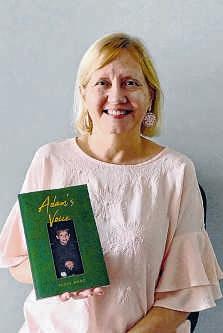
BY SHANTELL GOMEZ Contributing writer
Around age 40, most adults notice the need to hold aphone or book alittle farther away to read.
Vision changes, which happen to almost everyone during midlife, mayfeel like another sign of aging, but the good news is that there are more options than ever to keep eyes healthy and sight sharp.
Dr.Erica Lukasko, an optometrist who treats patients daily at her practice in Lafayette, is also experiencing these same changes herself.
“Now that I’m wellinto my 40s,” Lukasko said, “I’m notjust speaking fromknowledge —I’m speaking from experience. Iget to try the treatments on myself and recommendwhattruly works.”
Vision changesafter 40
The most commonchange is presbyopia, which occurs when the lens in the eye loses flexibility, making it harder to focusonobjectsupclose.That’swhenreading glasses —orprogressive lenses,ifswitching between different distances is needed —comeinto play.
Over-the-counter readers may work for some people, but Lukasko warns they aren’talways the best solution.
“Theydon’t account fordifferences between your eyes, andif you’re not looking through the optical centerofthe lens, they can actually create eyestrain, Lukasko said.
Progressive lenses, or no-line bifocals, area good choice for those who frequently switchbetween near and far tasks, andthere are even office versions designed specifically forheavyscreen time.
Contact lenses are also an option —even if correction is only needed up close. Multifocal contacts or monovision, where one eye is correctedfor distance and the otherfor near vision, canprovide freedom from glasses. In addition, prescription drops, including Qlosi and Vuity, are now available that can improve near visionfor several hours aday Dryeyesinahumid climate Eveninthe humidityofsouth Louisiana,dry eyes arecommon —especially in midlife. Factors like ceiling fans, air conditioning andallergy medications can all contribute.
Symptoms include scratchiness, burning, redness, watering or blurry vision. Fortunately, there areplenty of ways to manage this condition:
n Fish oil(Omega-3s): About 2,000 milligrams aday helpsimprove theoily layeroftears, preventing them from evaporating tooquickly




BY KAYLA YUP
The Philadelphia Inquirer (TNS) Philadelphia’spioneering cancer scientist, Carl June, hasbeen honoredwith two awardsinthe last month for his seminal work engineering the body’simmune system to fight cancer June has spent decadesresearching CAR-T,animmunotherapy in which regular immune cells are geneticallymodified to becomecancer-killing super soldiers. And he says his lab’swork is far from finished.

The University of Pennsylvania scientist was chosen last week for the inaugural Broermann Medical Innovation Award for his decades of research on chimeric antigen receptor (CAR) Tcell therapy, known as CAR-T.Toutedas“a living drug,” the therapy has revolutionized treatmentfor blood cancers, saving tens of thousands of lives since its first use in a2010 clinical trial June co-led atPenn. The treatment used in that trial, Kymriah, was developed in June’s lab and ultimately became the first CAR-T cell therapy togain FDAapproval in2017.
He will share the award, worth more than $1 million, withColumbia University scientist Michel Sadelain, who worked on a similar technique at the Memorial Sloan Kettering Cancer Center Since June’sclinical success, several other CAR-T products have been approved, and more than 1,000 trials have been
“Wecan catch problems like glaucoma, cataracts and macular degeneration early We can also detect signs of systemic issues likehigh blood pressure, diabetes or thyroid disease —sometimes before other symptoms appear.”
DR. ERICA LUKASKO
Continued from page 1X
n Warm compresses: Applyingawarm compress for 10 minutes daily keeps eyelid glands functioning properly
n Artificial tears: Choose preservative-free drops andskip formulas that claim to “get the redout.”
n Prescription drops: For stubborn cases, stronger treatments are available through an ophthalmologist or optometrist.
Simple daily steps make adifference in long-term eye health:
n Eat dark leafy greens, rich in antioxidants like lutein.
n Wear sunglasses —UVrays damage eyes just like theydamageskin.
n Avoid smoking, which raises the risk of macular degeneration and cataracts.
n Follow the 20/20/20 rule for screen breaks: Every 20 minutes, look 20 feetawayfor 20 seconds.
n Use adequate lighting.
n Get enough sleep —rest is vital for healthy eyes.
Eyeexams matter
After40, acomprehensive eye exam once ayear is key— even when vision seems fine.
“Wecan catch problemslike glaucoma, cataracts and macular degeneration early,” Lukasko said. “Wecan also detect signs of systemic issues like high blood pressure, diabetes or thyroid disease —sometimes before other symptoms appear.”
Certain symptoms call for immediate attention. Flashes of light, new floaters, or a“curtain” or shadow in vision can signal retinal problems. Sudden vision loss or eye pain alsorequires urgent care. Eyes will change with age, but that doesn’tmean living with poor vision or constant discomfort.
“I never want someone leavingtheir exam feeling like their vision is just falling apart,” Lukasko said. “I want them to leave educated and excited about their plan of action.”
launchedaround theworld. Interestincell andgenetherapies has also exploded throughout Philadelphia, turning thecity into a biotech hub thatsomehave nicknamed“Cellicon Valley.”
The Penn scientist has collected anumber ofprestigious honors over theyears, including a2023 Breakthrough Prize and, earlier this month, a2025 BalzanPrize forGeneand Gene-Modified Cell Therapy
While most of these recognize June’searlysuccesses in developingCAR-T,his labhas continued making advancesinthe lab and clinic.
Their recent efforts have involved optimizing the therapy and expandingits uses to other cancers anddiseases.
TheInquirer spoke with June, whohas been at Penn since 1999, to learn more about his lab’slatest research andthe future of CAR-T
Thefollowingconversation has been edited for length and clarity
What hasyour lab been up to recently?
What we’re focusing on in my lab is figuring out what it will take to cure solid cancers. There’s still alot of work needed in blood cancers, but Ithink that’smore of an engineering problem. It’sgetting theright targets.
I’m confident thatT cells can kill every blood cancer if they’re properly targeted. We may need to combine it with other things, but we’re not anywhere close to thatfor solid cancers like pancreatic cancer.Weknow in principle what we can do to tackle solid cancers, but we still need a lotof science to be uncovered to
Continued from page1X
“Bothin theseverityand the time their symptomsappear.”
Adam,who was fiveyears older than hissister,declined rapidly after his diagnosis.Henever progressed in hisspeech or motor skills. He lost his abilitytoride a bike and to eat food that he liked.
“At thetime, there wasnothing,”
Ward said.“No treatment.Nocure. When our kids werediagnosed, there was onlyone known case in Louisiana.”
As Amandagot better, hitting childhoodbenchmarks, Adamgot worse
He was soon confined to awheelchairand fed through atube.
Four years after his diagnosis, Adamdied in June 2000. He was 10.
“Hewas just goofy,” Ward said.
“Hewould just laugh and play at all kinds ofthings.”
Shortly after his death, however Amanda begantomirror her brother’spattern of decline.
At 5years old, Amanda started to lose her fallreflex —just like Adam.
“Her falling was precipitated by laughter,” Ward said. “But everything wasfunny to Amanda.Our living room —our house —for years wascovered in blankets and beanbagstocatch her fall if she laughed too hardatsomething.”
Amanda hada grand malseizure in 2004 and never regainedher ability to smileortolaugh. And, in December 2004, she died at 10 years old —just like Adam.
Afuturefullofgenetics
When Adam and Amanda were diagnosed, gettingthe genetic test results took several weeks. There was only one laboratory in the country that was running the genetic testsnecessary to diagnose their rare disease.
Now,genetic diagnosis takes a few days.
Technology and awareness for rare diseases have come along way in thepast 20 years.
Back then, Andersson treated both Adam and Amanda for Niemann Pick CatTulane. He diagnosed Adam usinga skin biopsy, andhe helped treat Amanda after herdiagnosis Although technology is improving, and more people are dedicated to finding treatment options for patients,there is no cure forNiemann PickC
However,the Federal Drug Administrationhas approved arimoclomol, or Miplyffa, in combination with the enzyme inhibitor miglustat to treat neurological symptoms associated with Niemann Pick Cinadults and children 2years of age andolder
make it reproducible.
We just had apaper published afew weeks ago where we used CAR-T cells for pancreatic cancer,and we found out that the CAR-T cells in the patients were completely exhausted within two weeks.
They just stopped working. That doesn’thappen in blood cancer,sowe’re studying themechanismsofwhat makes that happen andwhat we can do to overcome that.
That involves thingslike either genetic editing the Tcells to knock out the molecules that allow exhaustion to happen, or overexpressing other molecules. That’sa very large area of research in mylab.
Youfound that these cells were only active for two weeks. How long are they usually active in blood cancers?
The first patient that we treated still has active CAR-T cells 10 years later.Sowecall them aliving drug. And then Emily Whitehead, who’sa junior now at Penn, was7 years old basically when we treated her,and she still has CAR Tcells.
With blood cancer,asubset of patientshave them pretty much indefinitely,and we haven’tseen that in solid cancer
This summer,your labalso published research on enhancing CAR-Tcells for lymphoma. Can you talk about that work?
In 2017, we made in mice CARTcells that we called “armored.” They secreted the cytokine interleukin 18 (IL18), which we showed, in mouse tumor models, madeitmuch morepotent. So then we started the trial in humans, and our first patientshad complete responses. It was shock-
ing. The Tcells were basically 100 times more potent than what is currently FDA-approved.
How does IL18 boost the fighting abilities of these CAR-Tcells?
Oneofthe answers, forsure, is it activates the innate immune system,sothings like natural killer cells andmonocytes.
We also think it can act as a growthfactor forthe CAR-T cells themselves. So it may have more than one mechanism of action.
We still have ongoing trials looking at that here at Penn.
Are there other ways your lab is enhancing CAR-Tcells?
We’reusing screening strategies like CRISPR and base editing to screen fortargets. We’ve identified manythat right now are being tested in mice as ways to enhance the function of the T cells in asolid tumor
We have onepostdoc whocould knock out 20 genes at one time. It’samazing. That’sgoing to be an ongoing project, identifying ways to either prevent or slow down this exhaustion in solid tumors.
In June, astartup you cofounded to treat autoimmune diseaseswith CAR-Twas acquired by AbbVie for$2.1 billion. Can you talk about uses forCAR-Toutside of cancer?
Autoimmunity was ahuge surprise. Everyone was afraid that maybe there would be too many side effects with CAR cells in patientswith autoimmunity.But two German professors, George Schettand Andreas Mackensen, did very carefulstudies in Germanyover several years. They treated 15 patients with three differentautoimmune diseases, and found a100% response

rate. It wasextraordinary.They published it initially on one patient, aVietnamese womanwho has now been in remission for three years. She had lupus and got asingle infusion of the CARs. They also treated scleroderma and myositis, these horrible autoimmune diseases.
Ijust taught acourse two days ago at Penn, where we looked on the government data website clinicaltrials.gov and there were 140 trials now in the world treating autoimmune disease with CAR cells.
There are manymore patients with autoimmune disease than there are cancer.And this is something we are looking at through both academic trials here at Penn and in the biotech/pharma industry
Are there anyapplications of CAR-Tfrom other groups that youreally admire or that you find most promising?
Probably the mostdisappointing thing is how long it takes to go from preclinical experiments in animals to human results. It just takes too long. It’s ageneral problem we have.
But there’sexciting work with natural killer cells. And people at MD Anderson (in Texas) have been using umbilical cord blood, that would normally be thrown away when babies are born, to grow CAR cells.
That’sexciting. It’s another approach rather than starting with peripheral blood from acancer patient. And the advances with lipid nanoparticles and in vivo viral delivery have happened much faster than Ithought it would.
I’mjust astonished at how fast the field is moving forward.

theirchildren Adam andAmanda during their brieflives.Theyalso watched theirmiddlechild,their daughter Chelsea, grow up and becomea neonatal intensive care unit nurse.
“Wehave to remember our whole family,” Ward said. “And thepeople we meet every year,the families we speak to every year, they are our family too.”
After Adam’s death, Ward started anew venture: looking through the eyes of her son whobecame nonverbal.
Ward began writing.


“It’s not acure,”Andersson said. “But it may slow theprocess.” Andersson, as the director of HaywardGenetics Center and the Karen Gore Chair forHumanGeneticsatTulane,has seen almost all of the patients in thestate with rare disorders. If Louisianadoctors find abnormal resultsinnewborn screenings —which now test for approximately 30different diseases and conditions,including cystic fibrosis —children will likely be sent to Andersson. Andersson sees over 500 patients in thestate each year for genetic disorders.
“This state is massively underresourced,” Andersson said. “We only have seven clinical geneticists andtwo biochemical geneticists who handle this type of disease. Many patients are notreferred or seen.”
In his career,hehas seen monumentalshiftsinthe field of genetics.
“Wecan nowdiagnose children who are at risk even if they don’t have symptoms,” Andersson said. “Andwedon’t have to do invasive
biopsies; we can just take asample of saliva or blood to do full genome sequencing.” Andersson said he and his team at Tulane are part of acollective sharing in genetics research who are discovering diseases no one knew existed before exomeor whole genome sequencing.
“Wedidn’tknow what we were looking for,”Andersson said. “But nowwehave apopulation of 100 with thesamemarkers. That is a disease. Thereare many of those cases in the last decade.”
The Ward family attends the National Niemann PickDiseaseFoundation conference each year,providing care for people and children diagnosed with the samecondition that Adam and Amanda had while parents, caregivers and doctors meet in conferencerooms about thelatest on the disease.
“We’restill fightingfor acure,” Ward said. “We’ve made alot of progress in this disease.The wheelchair comes in alot later than previous years and cases.”
Ward and her husband, Jim have lived in the samehouse in Metairie for 37 years. They watched, laughedand criedwith
And writing and writing. Soon,she hadstoriesofwhat Adam mayhavebeenthinking. Whathemight of said when he wasinthe delivery room meeting Amanda for the first time. When he was in that kindergarten class. When he tried to sing Elton John’s “Crocodile Rock.” What would he say to his sister who was also suffering?
“I always wondered what was going on in his brain. What did he think of all of this?” Ward said. “It must have been so incredibly frustratingthathecouldn’t say what he wanted to say.”
Ward’shusband would often read the words she wrote fortheir son.
“We’ve gotta get this published,” Jim Ward said to her one evening. In 2024, 20 years after the death of their second child to Niemann Pick C, Missy Ward started to write again. She also edited and designed amemoir about Adam
The Wards found Christian Faith Publishing and, in May,“Adam’s Voice was set, bound and in their hands.
“It’sbeen special to tell our family’s story,” MissyWardsaid. “We hope it can help othersheal and know that they’re not alone.”
“Adam’sVoice”byMissy Ward is available on online book stores including Barnes& Noble, Amazon, Kindle and more.
Email Margaret DeLaney at margaret.delaney@theadvocate. com.
WE WANT TO HEAR FROM YOU
TheLouisiana Health section is focused on providing in-depth, personal accounts of health in the state.This section looks at medical innovations, health discoveries, state and national health statistics and re-examining tried and true methods on ways to livewell.
Health editions will also profile people whoare advancing health forthe state of Louisiana.
Do youhavea health story? We want to hear fromyou. Email margaret.delaney@ theadvocate.com to submit health questions, stories and more.
BRO
What is “fibermaxxing,” and should youtry it?
Fiberisnotparticularlyexcitingtotalk about,anditrarelytrendsintheway weseewithketo,intermittentfasting orcollagencoffee.Allofasudden,though, fiberishavingamoment,atleastonsocial media.TikTokusersare“fibermaxxing.”
Thisfiber-richdiettrendfocuses ongraduallyincreasingfiberintaketo decreaseuncomfortabledigestiveside effects,suchasbloating,andlowerthe riskofcertaincancers,includingcolorectal cancer.Videosofinfluencerscramming chiaseedsintojars,loadingbeansonto saladsandsharingdetailsabouthowtheir digestionhasimprovedareallpartofthe “fibermaxxing”movement
Andyouknow,I’mhereforit.TheU.S. DepartmentofAgriculturerecommends thatyougetabout14gramsoffiberper 1,000caloriesconsumed.Thattranslatesto about25gramsoffiberperdayformost womenand35gramsformen.Mostofus fallshortonfiber,averagingjustaround15 gramsdaily,soifTikTokiswhatittakesto spotlightthisunderappreciatednutrient,I’ll takeit.
BeyondtheBasics
You’velikelyheardtheusualnarratives: Fiberhelpswithdigestion,lowers cholesterol,supportshearthealthandhelps withweightloss.Alltrue—butforthose alreadynutrition-savvy,thesebasicsdon’t exactlystopyouinyourtracks.Here’swhere thingsgetmoreinteresting:Fiberisn’tjust aboutanumberonanutritionlabel;It’s aboutwhatelsecomesalongwithit. Takeraspberries,forexample.Onecup hasabout8gramsoffiber(nearlyathird ofawoman’sdailyneeds)forjust65 calories.Alongsidethatfiber,we’realso gettingvitaminC,antioxidants,waterand volumethatfillsourplateandourbelly. Compareraspberriestoafiber-fortified icecreamorcookiethatalsotouts8 gramsoffiber.Thenumbersmatch,but it’snotquitethesamepackagedeal.

Chicoryroot(inulin)isoneofthemore commonisolatedfibersonthemarket.It’s naturallypresentinvegetablesandgrains andcanbeextractedfromfoodorcreated synthetically.Becauseit’ssuchafinewhite powder,foodmakerscaneasilyincorporate chicoryrootintobars,shakesanddesserts —cuttingcalorieswhileboostingthefiber count.Theproblem?Itmakesless-healthy foodsseemmorevirtuousbysplashing “withfiber”onthelabel.
Isolatedfibershavevalue:They’re prebioticsthatfeedgoodgutbacteria, whichproducecompoundsthatsupport immunity,lowerinflammationandmay evenbenefitmood.Butwhentheyshowup inacookieorcandybar,it’snotthesameas gettingfiberfrombeans,berriesorbroccoli.
Solublevs.Insoluble: TheOriginalFiberDuo Wholefoodsnaturallycontaintwomain typesoffiber:
Solublefiberdissolvesinwaterand formsagel-likesubstanceinthegutthat helpsusfeelfullerlonger,regulatesblood sugarandlowerscholesterol.It’sfoundin foodslikeoats,beans,lentils,apples,citrus fruits,chiaseedsandflaxseeds.
Insolublefiberdoesnotdissolve;itadds bulkandhelpsmovefoodthroughthe digestivesystemtosupportregularbowel movements,preventconstipationandkeep thedigestivetracthealthy.It’sfoundin wholewheat,brownriceandtheskinsof fruitsandvegetables
Mostplantfoodscontainamixofboth Together,theymakewhole-foodfiberfar moreeffectivethanisolatedadd-ins.
BacktoFibermaxxing Here’saquickrefresher: Guthealthandregularity:Addsbulk, keepsthingsmovingandfuelsamore diversemicrobiome,whichresearchties tobetterimmunityandevenimproved mentalhealth.
MollyKimball,RD,CSSD,isaregistereddietitian withOchsnerHealthandfounderofOchsnersEatFit nonprofitinitiative.Formorewellnesscontent,tuneinto Molly’spodcast,FUELEDWellness+Nutrition,andfollow @MollykimballRDand@EatFitOchsneronsocialmedia. Emailnutrition@ochsner.orgtoconnectwithMollyor scheduleaconsultwithherteam.

Metabolicperks:Slowstheabsorption ofsugar,stabilizesbloodsugar(andenergy), reducescholesterolabsorption.
Weightsupport:Filling,lowerincalories andkeepshungerhormonesbalanced. Theseclaimsaren’tnew—butthe approachis.Insteadofrestriction, fibermaxxingfocusesonaddingmore plantsandwholefoods,versuscutting somethingout
ProceedWithCaution
Takeitslowly:Morefiberisn’talways better,especiallyallatonce.Suddenly doublingortriplingyourintakecanbackfire (literally)withgas,bloatingorconstipation
Fluidsarekey:Waterhelpssolublefiber formthegel-likeconsistencymentioned above.Wateralsohelpsinsolublefiber supportregularity.
Timingforsupplements:Taking mineralsupplementsoramulti-type ofsupplements(particularlythose thatcontainmineralslikeiron,calcium, zinc)withhigh-fibermealscanreduce absorptionofthoseminerals.Ideally,space mineral-containingsupplementsandfiberrichmealsatleasttwotothreehoursapart. Isitrightforyou?Whilefibermaxxing canbesafeformostpeople,anyonewith conditionslikeirritablebowelsyndrome (IBS),inflammatoryboweldiseaseora historyofbowelsurgeryshouldcheck withahealthcareprofessionalfor personalizedguidance.
TheBottomLine
Fibermaxxingmightsoundlikejust anotherhashtag,buttheconceptissolid: mostofusneedmorefiber,andwe’renot gettingenough.
Justremember,it’snotjustabouttallying grams.You’llalwaysgetmorewhenfiber comesfromrealfoodthatalsodelivers vitamins,minerals,antioxidantsand hydration.Soyes,goaheadandmaxxyour fiber—butdoitwithwholefoodsfirst.
BY THENUMBERS
Admissions into neonatal intensivecare unitshaveincreased among livebirths across the U.S.,withthe national average increasing by 13% from 2016 to 2023. NICUswere established in the U.S. in 1960 as specialized medical facilities that provide intensivecarefor newborns, particularly those bornpretermorwith medical complications.
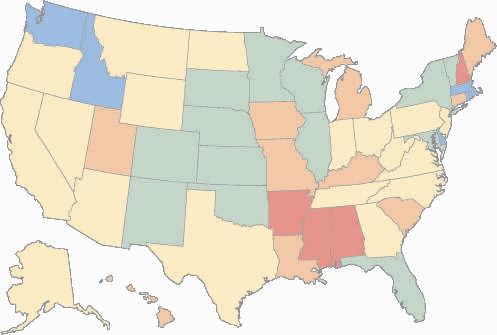

According to datareleased in 2025 from the Centers for Disease Control and Prevention, the percentageofinfants admitted to aNICU in the U.S. rose from 8.7% in 2016 to 9.8% in 2023.
In Louisiana, NICU admissions from live birthsincreased from 9.3% in 2016 to 11.2% in 2023 —that’sa 20% increase, CDCdata said.
Compared to other states, Louisiana’s admission ratesintoNICUs after births hasincreased.The state went from the 16th-highest percentageofNICU admissions in 2016 to the 9th-highest percentageofNICU admissions in 2023. These states had the highest increases in neonatal intensivecare admissions from 2016 to 2023, in descending order:
n Mississippi with a 37% increase, from 7.3% in 2016 to 10% in 2023; n NewHampshire with a 34% increase, from 7% in 2016 to 9.4% in 2023; n Alabama with a 32% increase, from 8.1% in 2016 to 10.7% in 2023; n Arkansas with a 31%increase, from 8.4% in 2016 to 11% in 2023; n Connecticut with a 27% increase, from 7.9% in 2016 to 10% in 2023; n Maine with a 27% increase, from 7.7% in 2016 to 9.8% in 2023; n and Missouri with a 27% increase, from 8.3% in 2016 to 10.5% in 2023. On the opposite side of the scale, these five states had adecrease in neonatal intensivecare admissions from 2016 to 2023 including,indescending order: n Rhode Island with a 31% decrease, from 6.7% in 2016 to 4.6% in 2023; n Massachusetts with an 8% decrease, from 10.2% in 2016 to 9.4% in 2023; n Delaware with a 3% decrease, from 14.7% in 2016 to 14.2% in 2023; n Idaho with a 1% decrease, from 10.6% in 2016 to 10.5% in 2023; n and Washington with a 1% decrease, from 8.4% in 2016 to 8.3% in 2023.
Mayo Clinic News Network (TNS) ROCHESTER, Minn. Mayo Clinic researchers havedevelopedartificial intelligence tools that help identify which children with asthma face the
risk of serious asthma exacerbationand acute respiratory infections. The study,published in the Journal of Allergy and Clinical Immunology,found the tools can detect those risks as early asage 3. The work is part of Mayo Clinic’s precure strategicpriority,which aims to predict and prevent serious diseasesbefore they advance. Through innovative technologies andpopulation-based studies, precure is designed to bring prevention-focusedcare directly to pa-
tients sooner. Toll of childhood asthma
Asthma affectsnearly 6million U.S. childrenand isa leading cause of missed school, emergency visits and hospital stays, according to theCenters forDiseaseControl and Prevention. Respiratory infections are the most common trigger of asthma attacks,but symptoms vary widely and change over time That makes it hard for clinicians to know which children are most vulnerable, agap these AI toolsare designedtohelp address. “Thisstudy takesusa stepcloser to precisionmedicine in childhood asthma, where care shifts from reactive care for advanced severe
asthmatopreventionand early detection of high-risk patients,” says Young Juhn, M.D., M.P.H., professorofpediatrics at MayoClinic and senior author of the study.Dr. Juhn directs several Mayo Clinic research programs,includingthe AI Program of Mayo Clinic Children’s, the PrecisionPopulation ScienceLab andthe HOUSES socioeconomic health program. NewAItools forearly detection
For the study,researchersexamined electronic health recordsfrom morethan 22,000 children born between 1997 and 2016 in southeastern Minnesota.Tointerpret thedata at scale, they developed multiple artificial intelligence tools
that use machinelearning andnatural language processing to extract details from doctors’ notes. The tools captured information such as symptoms and family history,allowing theteam to apply two diagnostic checklists for asthmain youngchildren: thePredetermined AsthmaCriteria and the Asthma Predictive Index. The checklists are how clinicians assess signs such as recurring wheezing, coughs or allergic conditions. Children who met the criteria on both lists formed a distinct subgroup at higher risk for serious complications.
Asthma risk revealed by age3 Whenresearchers compared this subgroup with other children
in thestudy,the differences were clear.Byage 3, the subgroup members wereexperiencing pneumonia more than twice as often and influenzanearly threetimes as often. They also had the highest rates of asthma attacksrequiring steroids, emergencyvisits or hospitalization. Respiratory syncytial virus (RSV) infection was also more common in this group during their first three years of life. Children in this subgroup were more likely to have afamily history of asthma,eczema, allergic rhinitis or food allergies. Further, their laboratory tests fromaprevious study showed signs of allergic inflammation as well as impaired lung function.




OchsnerChildren’swasnamedthe#1children’shospitalinLouisianaand rankedamongthenation’sbestinpediatricCardiology&HeartSurgery andGastroenterology&GISurgerybyU.S.News&WorldReportforthe 5thyearinarow.ButtherealprizeisseeingkidslikeWells,IslaandLawson healthyandhappy
Meetyourexpertcareteamatochsner.org/childrens



NewOrleans couple to spread culturetothe restofthe world
BY JENNA ROSS Staff writer
From the beginning, the couple behind NewOrleans’ Nous Foundation has joked thatthey’re bringing French back to the French Quarter. And when thedustclears, the nonprofit’s chic newheadquarters on ToulouseStreet will feature French music, Frenchletters and apetite French bookstore.
But the foundation’sambitions are bigger than the Quarter —bigger than New Orleans or even Louisiana.
The NewOrleansFoundation for Francophone Cultures, known as Nous, supports the revitalization of Louisiana’s heritagecultures,focusing on Cajun, Creole andIndigenous communities. Its small staff curates exhibits, produces films, publishes books and records albums through the independent label, Nous.
In 2024, Nousfocused on HaitiLouisiana. In 2025, the theme was “Musique(s).”And, in its newseason, titled “L’Amérique selon la Louisiane,” or “Louisiana’sAmerica,” founders Scott Tilton andRudy Bazenet are making thecase that Louisiana containsthe keytothe United States. By looking at Louisiana, one can more clearly see the country
“What Ilike is the idea of reversing the narrative in Louisiana that we’re always viewed as almost an oddity,assomethingonthe periphery of this country,” said Tilton “You can see the imprintofour cultureeverywhere, from architecture to music to cuisine.”
“It’shad an indelible impact all over the country,” headded
The season, announced in September,istimed to the 250th anniversary of the Declaration of Independence, but it doesn’t feel dusty.Francophone culture“doesn’tjusthave to be adocumentarywith arocking chair,going on about the good old days,” Tilton, 33, said with asmile Anew space
The Nous Foundation, Frenchfor “we,” captures —and creates what’shappeningnow.This season is its biggest yet.

After hosting years of events at the BK Historic House and Gardens, this year theNous Foundation moved intoanold shoe shop in theheart of theFrenchQuarter,owned by the Historic New Orleans Collection.Renderings of the refreshed space, settoreopen in November, show arches clad in handsome cypress wood, a petite gallery for exhibitions and aworkspaceopen to thepublic via aglasswall.
Theduo made astrong case for themany things it could accomplish in 700 square feet, said Heather Hodges, director of institutional advancement for HNOC, which uses its collection to tell thestoryofNew Orleans.
“Whatwedon’t do —and what they do —isprovide aclearly marked door and point of entry into theFrancophone heritage,” she said. Over and over,Nous has shown thediversityofthatFrancophone heritageinboth their programs and their grantmaking.
When,lastyear, they recorded an album titled “Musique(s),” aproject backed by the Library of Congress, they included not only French folk musicbut also reached outtothe
Baby Dolls, Hodgessaid. The Baby Dolls,astalwart of Black Mardi Gras celebrations,resurrected and recorded old Creole songs, now preserved on the album.
In September,Nousbrought anotheract on the “Musique(s)” album, theduo SweetCrude,toNew York to perform for theUnited Nations General Assembly
‘Withcareand heart’
The Nous Foundation launched in Parisin2020, whereTilton andBazenet had met at aparty. They’ve been marriedsince 2021.
Tilton, who grew up hearing his family speak French in New Orleans,was studying international relations there. Bazenet, whogrew up in France, was working for the French Foreign Service. Just weeks aftermeeting, the pair began workingonaprojectsomedoubted could be done —have the L’Organisation Internationale de la Francophonie recognizeLouisiana as amember.
It wasn’tunheard of: The OIF gathersmore than 90 French-speaking countriesand regions. In addition to Canada, it recognizes Quebec and
ä See LOUISIANA, page 2Y


Four years ago, Iorganized a six-daywhitewater rafting trip with 17 women. It wasthe kind of week thatfills the soul —long days paddling, sharedmealsunderthe stars andlaughter echoing offcanyonwalls, again and again. We hadincredible guides who cooked gourmet food. They also setupour cotsand sleeping bags each evening on anew beach on the SalmonRiverinIdaho. The nights were cool. Iremember lying there in my long johnpajamas, looking up at the stars in some of the biggest skies I’ve ever seen. Iwas snuggled in a sleeping bag andthinking how the cool airfeltlike it does in the best hotelroom, but no hotelhad ever offered anight view like that. The whole trip was one of those rare experiencessoperfect that we didn’tbelieve it was right to try to do it again. It will live in our headsasmagic from here on out.
An adventure like that either fractures friendships or binds themdeeper.For us, it was the latter
Back then, before we headed home, we allsaidwewould gather again soon.
“Soon”turnedinto four years. Life hasa way of doing that, doesn’tit?
Jobs, moves, kids, broken bones, career changes, caring for others, illnessesand the steady march of obligations wedge themselvesbetween good intentions andreality
But last week,one of my friends invitedustoacamp on Cypremort Point. Thanks to her, we found ourway back to eachother andtothe water.
Granted, the whole group wasn’table to be there, but those of us who gathereddidn’tmiss abeat. We told the stories of the last four years of our lives. We laughed. We cried. We ate allthe good things. Being with oldfriends is restorative. We appreciated the chance to discuss the newlinesonour faces. We acknowledgedthe changes in us —some of them visible, some invisible.Childrengrown, jobs lost andfound, relationships shifting. But in this kind of company,the yearsdon’t feelsoheavy.They feellike part of the story
Eventhough the time together was shorterand the water tamer, the joyofbeing together wasjust as strong —maybe stronger
One of the quiet gifts of old friends is thatthey don’texpect youtobeanyone but who youare Theyknowthe version of you who stayeduplate square dancing on asandbar. They’ve seen yousoggy,sunburnedwith hair thathadn’tbeen washed in five days —and they loved you just the same.
ä See RISHER, page 2Y

LSU graduate returns to department to help benefit Louisiana environment
BY LAUREN CHERAMIE Staff writer
Janice Pearson graduated from LSU with a bachelor’s degree in natural resources and ecology management with a minor in oceanography and coastal sciences. Now, she’s turning her passion into purpose as she steps into a role with LSU’s School of Renewable Natural Resources as a wildlife research technician.
For three years, Pearson was a student worker who assisted with waterfowl studies and wildlife distribution research at the Reproductive Biology Center at the LSU AgCenter’s Central Research Station. Today she works with that same department to visit state wildlife management areas to conduct field work and collect data on Black-bellied whistling ducks, wood ducks and mottled ducks.
One of the most rewarding parts of her job is working with the next generation of conservationists.
What solutions does your research with the LSU AgCenter work toward solving?
On my various projects that I assist on, we’re working toward research for waterfowl conservation. We work hand in hand with the Louisiana Department of Wildlife and Fisheries.
One project I’ve been working on has to do with movement ecology, studying the movements of various species that migrate down here in the winter We’re looking at their sanctuary use and also taking autonomous recording units, ARUs, to analyze for gunshots in the area.
We’re taking that data and overlapping it with transmitter data to put transmitters on the backs of northern pintails. The data gives us a better idea of how we can manage the species so that we’re not risking them not returning. Or
it gives us a better opportunity to do more studies on survival rates or population data.
Why is Louisiana an important place for this research to happen?
Louisiana is a critical point, especially in the winter, for waterfowl As birds are migrating south, most duck and waterfowl species converge at the base of the Mississippi River that feeds into the Gulf in the winter, and that’s where they winter
You see more species of waterfowl here than you do anywhere else in the United States that converge all at once. That’s what makes Louisiana super special.
For a hunter, you can go duck hunting and kill six or seven different species in one hunt. For research purposes, that gives other researchers the opportunity to come and start studies in Louisiana to get a better idea of these birds.
How do you catch and band birds safely?
The primary technique we use is called rocket netting. Basically, we use rockets that shoot nets out over the birds, and then it safely holds the birds.
We go out and take the birds out of the nets and put them in a crate. Then we age, sex and band them. We have a lot of safety protocols in place for rockets, and we take that very seriously, but it’s one of the best tactics to get as many birds possible. They also use walk-in traps that are similar to a snare, but it does not tighten. It doesn’t harm the bird, and it’s a little bit safer than rocket netting. Banding is important for us because it can tell us where that duck is, how long the duck survived and the age of the duck. We can use those things for survival rates That also gives us an idea of their movement Then, we have a universal data sheet that we upload the data to so that we can track all of the birds that we band.
What’s the most rewarding part of working with waterfowl?
Getting hands-on experiences and learning about the species itself is rewarding. Being able to actually be a part of the solution
We’re looking for La.
BY JOY HOLDEN Staff writer
The Louisiana Master Naturalist Association educates Louisiana citizens about the state’s flora and fauna, as well as other as-
pects of the environment and ecosystems. Individuals go through training, and, once certified, the Louisiana Master Naturalists are required to use their talents to educate others or assist programs that

and making contacts in the waterfowl world professionally is rewarding. Seeing the birds converge is just a beautiful thing. It’s pretty amazing. With black bellies, they used to never be here. So seeing them now is just incredible, plus learning about them In my time assisting in research with LSU, I have been able to teach undergrad students how to band, and I’m teaching them the ropes. That was really rewarding to see them get excited about it, because that helps the whole conservation community
When they’re out there in the field, refueling that passion for them to stay in the field, it’s really rewarding because we need people in our field who want to work toward saving what we have.
Email Lauren Cheramie at lauren.cheramie@theadvocate. com.
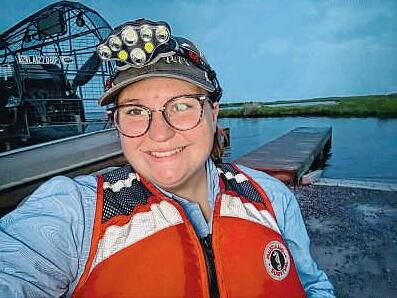
promote and protect the state’s natural heritage. Are you a Louisiana Master Naturalist, or do you know an exemplary Louisiana Master Naturalist? Email the Louisiana Inspired team, joy.holden@
theadvocate.com or jan. risher@theadvocate.com, with your name and contact information.
Email Joy Holden at joy holden@theadvocate. com.
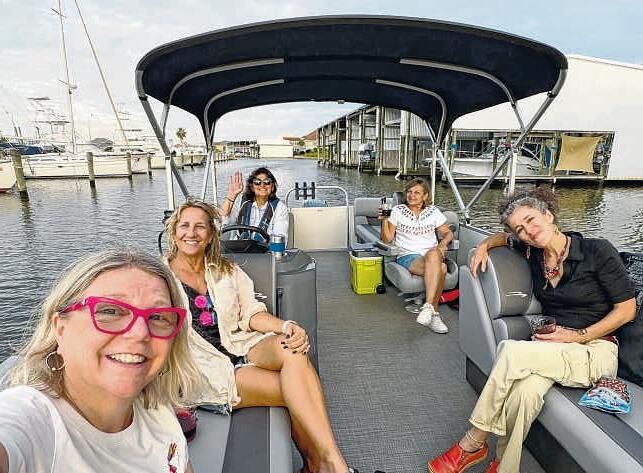
Continued from page 1y
a soul. Four years melted away In the end, that’s the gift friendship brings it’s a reminder that time ebbs and flows, but also that love holds the course.
Email Jan Risher at jan. risher@theadvocate.com.
Continued from page 1y
New Brunswick. Over two years, Tilton and Bazenet sent hundreds of emails, lobbying for Louisiana to join the Francophonie. In 2018, it did.
The couple saw an opportunity to be of use They loved living in Paris, “but Paris doesn’t need anyone,” Tilton joked. In New Orleans, “you feel like you can make a difference.”
More than a century after French was banned from Louisiana classrooms, the numbers are bleak. There are perhaps 120,000 French speakers in the state, some data suggests, down from about 1 million just 60 years ago. Of those, perhaps 20,000 speak Cajun French, others traditional French.
Even a decade ago people who cared about French language and culture in Louisiana were “really worried,” said Evelyne Bornier, a professor of French at Auburn University
But in the past five years, she says they have really seen a strong revival of the Francophone culture. The revival is in part due to organizations across the state, including the Nous Foundation, said Bornier, author of “Parcours Louisianais,” a collection of Louisiana literature in French, from the 1680s to 1900.
“The amount of things they have done in such little time is nothing short of a miracle,” she said of the Nous Foundation. “They’re not just preserving the culture. They’re building something new and meaningful with care and scholarship and heart.”
At a time of shrinking resources, the Nous Foundation is growing.
The nonprofit raised $300,000 in fiscal year 2025, which wrapped up in June. It received 56% of the grant funding for which it applied, about twice the national average. But during a conversation in September, Tilton focused
on another number: 50. As in, the foundation’s operations in 2025 supported some 50 artists, musicians and creatives across the state. For a long time, “our cultures have been exploited, to a certain degree, for tourism purposes,” Tilton said. But that commodification often doesn’t lead to artists getting paid. Policies can help revive Francophone cultures, he continued.
“I think we, as a movement, focused on the policy side of this for a very long time, and it may have escaped us that there was this real importance to actually getting funds into the hands of artists, into the hands of musicians, into the hands of creatives,” he said.
To that end, Nous has launched a cultural accelerator program, Le Lab, to boost projects and start-ups with a hand in heritage culture. The program has raised some $235,000 to support 12 projects, a few of which have turned into nonprofits and businesses.
Next month, with the help of Le Lab, Mélange Dance Company will remount “Love Letters of World War II,” this time interweaving the story of how Louisiana’s Frenchspeaking Cajuns helped win the war It’s a beautiful show said Monica Ordoñez, the dance company’s artistic director, that reveals “how powerful we are if we join forces and preserve our culture.” The show is also costly to produce, said Ordoñez, who works as a paralegal. The nonprofit dance company pays the show’s 21 dancers for their rehearsal and performance time. It pays a live band, too.
“We hope we can break even,” she said. Already, though, the partnership with the Nous Foundation is paying off Bazenet and Tilton are helping the dance company connect with partners and possibilities, Ordoñez said.
“They’ve been selfless with their support,” she added.
Proposesomeone whomakes a difference
BY JANRISHER Staff writer
Louisiana Inspired is allabout shining alight on people and organizations who are working toward solutions in Louisiana neighborhoods, communities, towns, cities and throughout the state it’swork that takes extra effort by specialpeople, demonstrating the goodstuff of the human spirit.
We are announcing the 2025 Inspirit Awards. Webster says inspirit implies instilling life, energy,courage or vigorinto something.
We are looking for people who do just that —and to do so, we need you! By Nov.12, you can nominate thepeopleyou know or have watched make apositive difference in the lives of others at www.nola.com/site/forms/the_inspirit_award/.
We encourage nominations of peopleofall ages —those who systematically go about doing their best to make the world a better place.
We want generalists who do all sorts of things. We want those who are single-mindedlydevoted to one issue. We wantthe young and the old, people in cities and those in rural communities across Louisiana. We want people in schools, including students and teachers. We are looking for people who started trying to solve aproblem this year and those who have been workingatitfor years
We want to learn about business people who have made apositive difference in the lives of their employees or the world at large
We want to learn about teachers who developed an innovative ap-
proach to solvinga problem. We want to learn about musicians and artists of all kinds, nonprofit executives and volunteers—and unsung heroes and heroines who don’tfitinto any of those categories.
The Inspirit award winners from 2024 were:
n Julie Rabalais, of Lafayette, thefounder of For theBirds Acadiana,anonprofit bird rescue and rehab organization.
n Darryl Durham, of New Orleans, founder and director of Anna’s Place Nola, anonprofit that focuses on breaking thecycle of trauma for economically disadvantagedyouthinNew Orleans.
n Jennifer Richardson,ofBaton Rouge,organizer of Keep Tiger Town Beautiful, agroup of volunteers committed to cleaning up litter in Baton Rouge.
n Kathleen Cannino, of Covington, leader of astatewide campaign to get cameras in special ed classrooms.
n Rashida Ferdinand,ofNew Orleans, founder of anonprofit that runsapark, local market, food pantry and economic development initiativeinthe Lower 9th Ward.
n Libbie Sonnier,ofNew Orleans, CEO of Louisiana Policy Institute for Children.
n Warren Perrin, of Acadiana, advocateand activist for Cajun and Creolerecognitionand representation.
Thenomination process: n Focuses on peoplewho are working toward solutions in their workplaces, schools, neighborhoods, communities and state
n Seeks stories of impact shared by nominators
n Lifts up detailsofpersonal stories that inspire change Awardrecipients will be announcedinthe Dec. 21 editionof Louisiana Inspired.
Email Jan Risher at jan.risher@ theadvocate.com
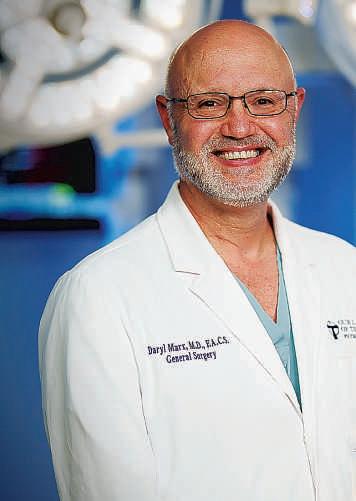

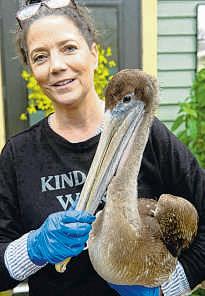


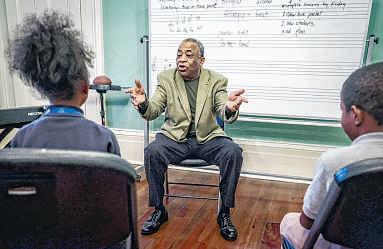


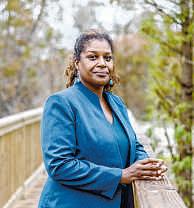































BY RICHA KARMARKAR
Contributing writer
Law school’s notorious stress takes a toll on even the most determined students. But for a group of 20-somethings at New York University School of Law, an ancient tradition offers a framework for handling the pressure.
“Many parts of Hinduism are so well-suited to being able to handle such a high-stress profession,” said Roshni Yaradi, the co-chair of the new Hindu Law Students Association. “Like, many times, you’re handling literal life and death.
“Practices of Hinduism — including yoga, meditation, breath work things that are so fundamental to the faith, are very stress-relieving and focusing techniques that I think any practicing lawyer should utilize.” Yaradi and six other students, all of Indian origin, are the first members of the only Hindu affinity group at any law school in the nation. HLSA was conceptualized by twin sisters Tanya and Megha Bansal three years ago, but officially started last spring, after taking time to gain traction and the necessary approval signatures.
“If every other religious group has an organization at NYU Law, why don’t we?” thought Rachita Bommakanti, a fellow second-year student and Yaradi’s co-chair Indian students are the secondhighest population of international students at NYU, after those from China, with more than 4,700 undergraduate and graduate students coming from India to study at NYU in the 2023-2024 academic school year

“I think it’s a little bit of a reclamation project for us,” said Bommakanti, who hopes the HLSA will help grad-school-age Hindus, from India or the U.S., reconnect with their faith — and its resources for succeeding in the legal profession while studying in the city
In their younger years, Yaradi and Bommakanti, both from the DC-Maryland-Virginia area, felt reluctant to join existing Hindu student groups: partially due to what they said was a less developed relationship with their own faith, and partially due to the “very real insecurity” of being a proud, visible Hindu in the country which is the reason, they say, most young Hindu Americans identify with the cultural, but not necessarily the religious, aspects of Hinduism.
(“Diwali parties without the puja
(prayer ritual),” Yaradi offered by way of example.)
The co-chairs also felt that not enough spaces emphasized the diversity of perspectives in Hinduism, often because they were tied to a specific Hindu sect or lineage
“It was, like, really rigid, or there was less room for dissent,” said Bommakanti, who describes herself as being drawn more to the philosophy of Hinduism than to its ritualistic aspects. “Which is funny right? Because the whole point is that we are dissenting individuals.”
In these young women’s eyes, HLSA is not meant to be the largest Hindu student organization in the nation, but a specially meaningful one, in which anyone feels welcome to discuss their differing opinions, values, practices and experiences with the Hindu faith.
But the real project, they say, is changing the perception of what Hinduism can be for a young American. “You can be a Hindu and be cool,” said Yaradi. “You can be a Hindu and interpret it in a way that you eat meat, and you can interpret it in a way that you don’t eat meat. You can interpret it in a way that you do or don’t drink.”
Bommakanti continued “Whatever impediment people feel to exercising Hinduism that is caused by this idea that, like, ‘I’m going to be weird,’ or ‘I’m not going to be normal,’ I want to abolish that.
“All it takes is just to see one person being cool and a proud Hindu, and then you’re like, ‘Oh, well, maybe I can do that too,’” she said.
The group of about 30 students most of them part of the one-year Masters of Law program, with a few in the full three-year JD program — has thus far held a yoga class at SoHo’s Broome Street Ganesha Temple and a discussion about Indic spirituality with New School professor Gabrielle Williams.
But the Hindu perspective is not limited to yoga practice and “golden lattes.” The Bhagavad Gita the sacred Hindu text detailing Lord Krishna’s advice to warrior prince Arjuna in the midst of the Mahabharata war — has been a guiding light for these students studying the way of the law Particularly, they say, a verse in Chapter Two in which Arjuna is preoccupied with the possible results of the war, rather than his dharma, or duty in the present.
HLSA hopes to start weekly group Gita readings as members progress through demanding coursework and exams, as well as their future cases as attorneys.
“Krishna tells Arjuna to focus on what you do and do it to the best of your ability, and then, like, leave it there,” said Yaradi, “and what is meant to happen is going to happen. That is an incredibly valuable perspective, to just have faith that things will work out, while also prioritizing doing your duty, which is to work hard.”
“So much of the law is about the fruit of your action, right?” added Bommakanti. “And the attachment to that fruit, I feel like, is ultimately what leads people to burnout and dissatisfaction. It’s such a simple principle, but such an enduring one.”
For their own dharma, the students hope creating this club will open the doors for other students to take the initiative at their universities — no matter their own journey with Hinduism. And hopefully they say, being more “openly Hindu” will inspire existing Hindu lawyers and other professionals to share how their faith intersects with their job.
“Hinduism is so beautiful because if you want to do the work — if you want to read, if you want to think, if you want to have conversations — you don’t have to be old to be learned,” said Bommakanti. “I don’t have to be like, some monk or something, to chair this organization. I can just be someone who’s looking for answers.”
The group kicked off the school year last week with a welcome picnic, and the co-chairs say they hope to soon host Hindu traditional dance workshops, trips to Queens temples and holiday celebrations, making sure, Yaradi said, to “tie the religious and cultural aspects of Hinduism back together.”
BY EMILY SENKOSKY
Contributing writer
Editor’s note: This story, created by Emily Senkosky for Grist is part of the Solutions Story Tracker from the Solutions Journalism Network, a nonprofit organization dedicated to rigorous reporting about responses to social problems. Louisiana Inspired features solutions journalism stories that provide tangible evidence that positive change is happening in other places and in our own communities — solutions that can be adopted around the world. Earlier this summer, the Banana Lake Fire erupted near Plains, Montana, engulfing over 850 acres in flames within a day The “total suppression” response from firefighting officials included deploying at least 17 engines, two helicopters, and three bulldozers, as well as highly trained fire crews. But another newer piece of technology was also at play as firefighters worked to contain the blaze: drones.
Banana Lake was one of several early-season fires in the state this year As of this writing, there are over 20,000 acres burning across seven key wildfires in Montana, at varying levels of containment. And increasingly hot and dry conditions throughout the American West are making fire an ever more fickle foe As a new era with the natural disaster commences, both fire practitioners and researchers across the West are bolstering their arsenal with cutting-edge tools. Drones now fly above firefighters, private satellite companies monitor fire and smoke from above, and AI machine-learning models are helping to advance fire research. While these new innovations are not panaceas, ground operations crews and scientists are optimistic about the ways modern technology can help fight fire smarter, not harder.
Since 2018, drones sometimes referred to as unmanned aerial systems, or UAS have been flying under the radar as a new instrument for the United States Forest Service in the fight against wildfire. Thanks in large part to Dirk Giles, who launched and leads the agency’s UAS program, the number of drones deployed each year by the Forest Service has jumped from 734 flights in 2019 to over 17,000 in 2024.
“The program has really hit a new stride in the past three years,” said Giles “We are seeing UAS supplementing fire crews across all phases of response.”
“This UAS program is now being recognized as prolific,” said Ry Phipps, a division supervisor in Region 1 of the Forest Service, which includes Montana. “There was a time we wouldn’t have even thought to try and order a drone
for operations. They have become a fantastic tool that is changing the game.”
According to Phipps, drones are increasingly seen as a force multiplier by Forest Service employees. Drones equipped with infrared sensors can help detect lingering hot spots, pinpointing areas at risk for reigniting. Previously, firefighters had to meticulously hand-check burn scars, which could take days at a time and a ton of manpower depending on the size of the area With supervisors like Phipps reading a thermal map on a screen fed by drone data, firefighters with boots on the ground can be dispatched more safely and efficiently only going to spots that have high heat signatures.
“It saves a lot of time and risk for crews,” said Phipps.
For helicopter pilots, who help control wildfires by dropping water or fire retardant to suppress flames and creating fire lines for ground crews to control blazes, drones can also assist. Preprogrammed flight trajectories in combination with infrared sensors allow UAS to fly through heavy smoke or at night
This mitigates the need for “low and slow” reconnaissance missions, which require pilots to fly close to the ground in tricky terrain and low visibility According to Giles, these missions are some of the most dangerous for wildland fire pilots.
As their name would suggest, unmanned aerial systems offer a way to do surveillance without putting pilots in danger — which means that UAS can unlock new abilities for fire crews in extreme conditions.
“Basically, you can fly drones so that nobody gets hurt,” said Phipps.
“You can replace a drone. You can’t replace a person.”
Although Giles, Phipps, and others believe that drones show great promise especially in shifting risk from firefighters to a machine the size of a small cooler they’re far from being a silver bullet. The machines have limited battery life and can only complete flights of about 15 minutes on average, meaning that deployments must be carefully planned. And since drones are still being studied in various fire management applications, manpower is still needed to check the “ground truth” of information that UAS provide.
Another limitation is simply availability According to Phipps, there aren’t as many drones as there is demand for them
Ironically, there’s also an emerging risk from privately owned drones getting in the way of official operations If hobby drones are in the airspace near a wildfire, it’s also a no-go for land management agencies to fly During a wildfire
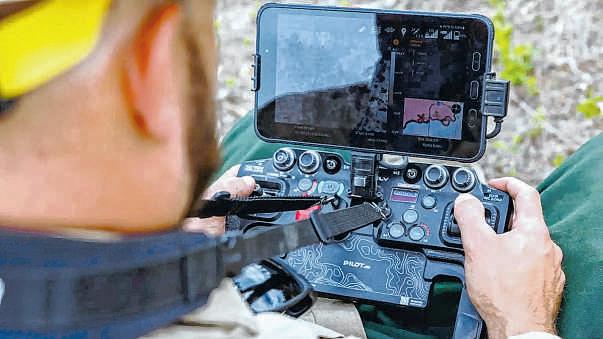
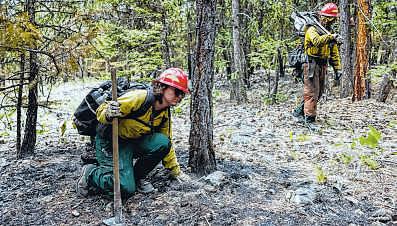
Grayback Forestry firefighters working on the Banana Lake Fire walk through the forest in a line and kneel down to feel for hotspots with their hands. Although the wildfire already burned through the area, small fires can burn underground or in tree root systems. Ground crews work in conjunction with drone pilots, who can detect hotspots using thermal imagery.
in Montana in 2022, aerial crew operations came to a standstill as an unapproved drone buzzed right into an area with a temporary flight restriction. Officials were able to locate the drone’s owner in just about 15 minutes — but that’s precious time when a fire is raging. And just two weeks ago during a wildfire near Provo, Utah, fire operations were shut down by multiple drone incursions, impeding fire management on a high-profile fire near a densely populated community While UAS are becoming more critical in fire operations, officials must also work on educating civilians to ensure unauthorized drones don’t prevent them from flying their own. Another area of fire management that drones have shown
shown some promise in is lighting and managing controlled burns — intentional blazes set to clear dry brush and other fuels.
Fire management’s history of suppression disrupted the natural fire cycles that Indigenous communities once stewarded cycles that many ecologists now champion. As colonization spread across the West and settlers sought to control land and resources, racist assimilation programs criminalized all manner of Indigenous customs. Prescribed burning was one of them.
But as the consequences of this more aggressive, reactive approach to fire management have become apparent, Western science has increasingly caught on to the effectiveness of routine controlled
burning One recent Stanford-led study revealed that prescribed burns can reduce the severity of subsequent wildfires by an average of 16 percent and net smoke pollution by 14 percent. Fire professionals have also recognized their potential, with applications growing year over year
Enter another new breed of drones: UAS that can be equipped to carry “dragon eggs,” pingpong ball-sized clusters of a flammable potassium concoction that ignite on impact. This innovation helped the Forest Service burn around 189,000 acres in 2024 to reduce built-up fuels. While the use of prescribed burns is on the rise, in Montana and elsewhere, concerns remain about public safety risks, both from air pollution and the possibility of blazes getting out of control. Technology is helping to address those kinds of questions, too. Researchers in Montana are looking to clear some of the lingering haze of safety concerns around prescribed burns through a National Science Foundation-funded project titled SMART FIRES. (The project’s title is an acronym for Sensors, Machine Learning, and Artificial Intelligence in Real Time Fire Science.) The group, specializing in fields from atmospheric chemistry to public health, will use the grant to conduct five years of study and fieldwork aimed at unpacking the environmental and social dynamics needed to scale prescribed burns as a preventative measure for wildfire The suite of custom gadgets that the project is utilizing includes some proprietary UAS.
SUNDAY, OctOber 12, 2025












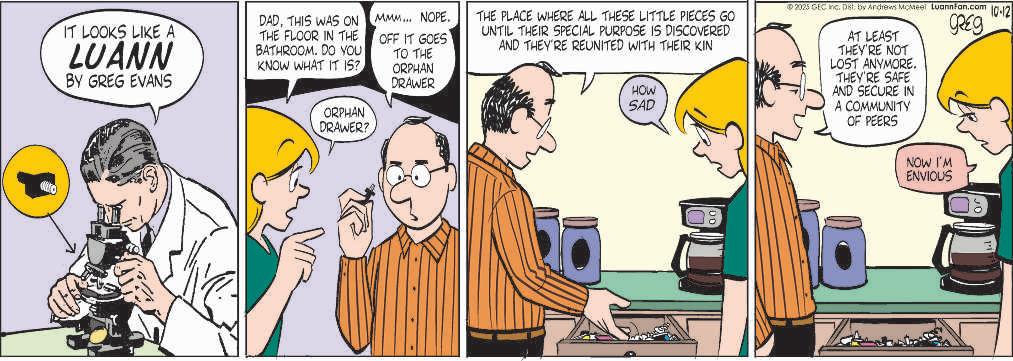

















directions: Make a 2- to 7-letter word from the letters in each row Add points of each word, using scoring directions at right. Finally, 7-letter words get 50-point bonus. “Blanks” used as any letter have no point value All the words are in the Official SCRABBLE® Players Dictionary, 5th Edition.
instructions: 1. Words must be of four or more letters. 2. Words that acquire four letters by the addition of “s,” such as “bats” or “dies,” are not allowed. 3. Additional words made by adding a “d” or an “s” may not be used. 4. Proper nouns, slang words, or vulgar or sexually explicit words are not allowed.
todAY's Word — serenAded: seh-rihNAY-did: Performed vocally or instrumentally, especially outdoors to court a love interest.
Average mark 37 words Time limit 60 minutes Can you find 59 or more words in SERENADED?


instructions: 1 -Each rowand each column must contain thenumbers 1through4 (easy) or 1through6 (challenging) without repeating 2 -The numbers within the heavily outlinedboxes, called cages, must combine using thegiven operation (inany order)toproduce the target numbersinthe top-left corners. 3 -Freebies: Fillinthe single-boxcages withthe numberinthe top-left corner
instructions: Sudoku is anumber-placing puzzle based on a 9x9 gridwith several given numbers. The object is to placethe numbers 1to 9in theempty squares so that each row,each column and each 3x3 boxcontains the same number only once. The difficultylevel of the Conceptis Sudoku increases from Monday to Sunday
directions: Complete thegridso that numbers 1–132 connect horizontally, vertically or diagonally

Edited by Rich Norris and Joyce Nichols Lewis
goren Bridge
Today’s deal is from a youth competition in Europe. South was Marius Austad, from Norway. His jump to six diamonds, with no club control, was a big gamble. He was bluffing that he did have a club control. Even if West led a club, he might shift to a spade at trick two. Given Austad’s strong spades there would probably be nothing in dummy that would inhibit a spade shift. North raised to seven, reasoning that if partner could jump to six missing two aces, she could bid one more. Whew!
Take this Super Quiz to a Ph.D. Score 1 point for each correct answer on the Freshman Level,

Tannah Hirsch welcomes readers’ responses sent in care of this newspaper or to Tribune Content Agency inc., 2225 Kenmore Ave., Suite 114, Buffalo, Ny 14207. E-mail responses may be sent to gorenbridge@ aol.com. © 2025 Tribune Content Agency
Austad won the opening club lead with dummy’s ace and cashed the ace of hearts to discard his remaining club The trumps were likely to be breaking poorly after the pre-empt, so Austad led the 10 of diamonds at trick two and ran it So far, so good He could draw the trumps now, but he would then need a 3-3 spade split He reasoned that if the spades were 3-3, it would be safe to cash the high ones now An opponent who was short in spades might also be out of trumps. That is exactly what happened, so Austad was able to safely ruff his last spade with dummy’s remaining trump. He ruffed a heart back to his hand, drew trumps, and claimed. An exciting deal!
LIBRA (Sept. 23-Oct. 23) It’s your choice; follow your heart and satisfy your soul Strive for perfection and engage in what’s real, tangible and withinyourbudget.Walkawayfrom drama and indulgent behavior
SCORPIO (Oct 24-Nov 22) Speak up; share your thoughts, emotions and intentions with someone special. Put your strengths on display, and don’t hesitate to lead the way. A partnership shows promise.
SAGITTARIUS (Nov. 23-Dec. 21) Don’t count on anyone but yourself. If you want to change, it’s up to you to put your goals into practice. Trust your instincts and turn your desire into a
lucrative affair. Let your actions be your voice.
CAPRICORN (Dec. 22-Jan. 19) Refuse to let what others do or say mislead you. It’s up to you to manifest opportunities and complete missions that can effectively showcase what you have to offer AQUARIUS (Jan. 20-Feb. 19) Exhaust your creative imagination, and you’ll come up with a plan that surpasses your expectations. Connect with people who appreciate what you do and can help further your interests. PISCES (Feb. 20-March 20) You’ll need an outlet for your thoughts. Attend
an event that promotes a platform and encourages conversations that can transform how you move forward. A little flirting will go a long way and could have long-term effects. ARIES (March 21-April 19) Be honest with yourself. It’s easy to conjure up scenarios that can lead to emotional mayhem. Engaging in a creative project or spending time with someone close to you is encouraged TAURUS (April 20-May 20) Make room toaccommodatesomethingorsomeone who matters to you. A kind gesture will help build strong ties. Making some home improvements
or hosting an event will put you in the spotlight. GEMINI (May 21-June 20) You’ll engage everyone around you with your effervescent personality, constant activity and diverse way of dealing with people and situations. Reach out to someone from your past and catch up. CANCER (June 21-July 22) Your unique inputandthoughtfulnesswillprompt those you encounter to contribute interesting alternatives. Don’t hesitate to commit if you feel strongly about someone or something. LEO (July 23-Aug. 22) An open mind will help you understand the reac-
tions of others. Charm and positive affirmation will help you navigate your way past any obstacles in your path. VIRGO (Aug. 23-Sept. 22) Participate in something that resonates with you, and you’ll make connections with people who share your beliefs. Move forward with an open heart and mind and share what you have to offer
The horoscope, an entertainment feature, is not based on scientific fact. © 2025 by NEA, inc., dist. By Andrews McMeel Syndication
1. Cat. 2. Mice. 3. Mockingbird. 4. Lion
5. Penguins. 6. Caterpillar.7.Stallion or Swan. 8. Flies. 9. Duckling. 10. Bird. 11.Fish. 12. Bees. 13. Elephants.14. Hound.15. Dog
SCORING: 24 to 30 points —congratulations, doctor; 18 to 23 points—honorsgraduate; 13 to 17 points —you’replenty smart, but no grind; 5to12points —you really shouldhit the booksharder;1point to 4points —enroll in remedial courses immediately; 0points who reads thequestions to you?
Saturday's Cryptoquote: October was alwaysthe least dependable of months .fullofghosts and shadows. —Joy Fielding



